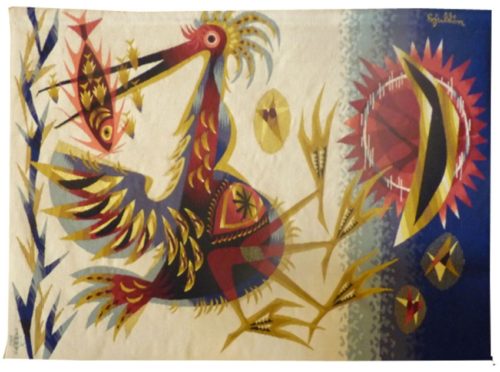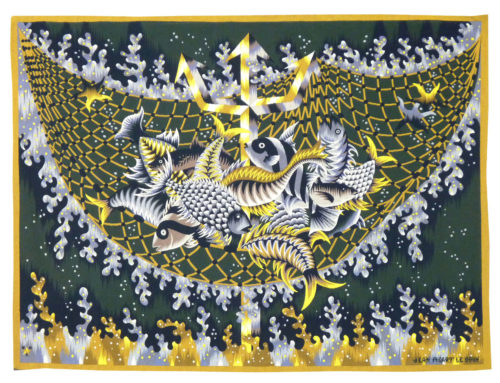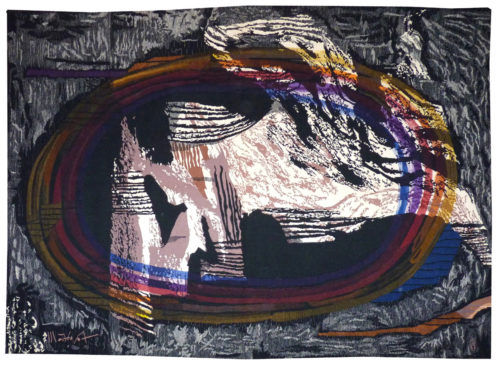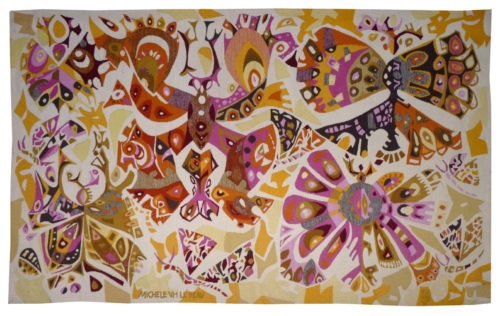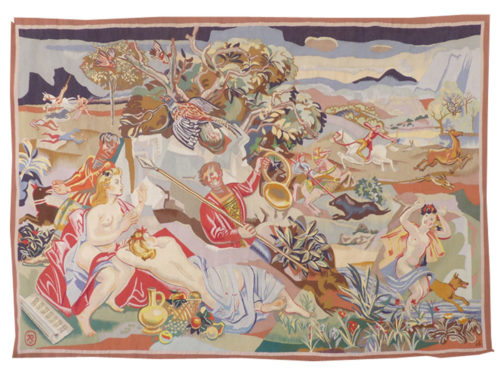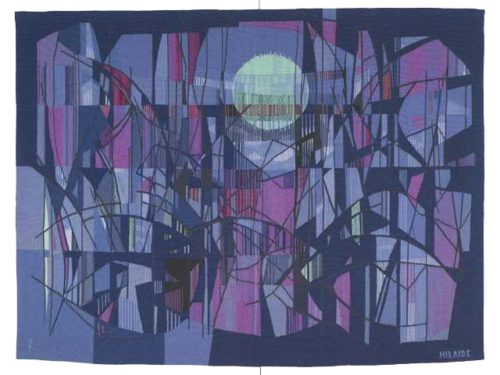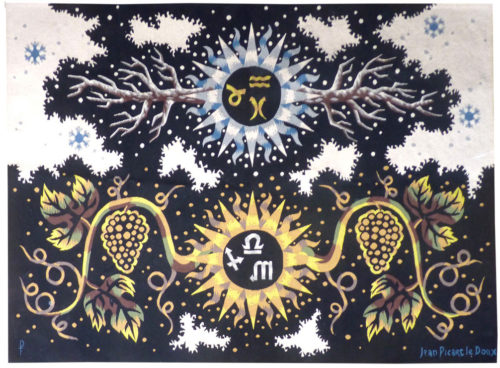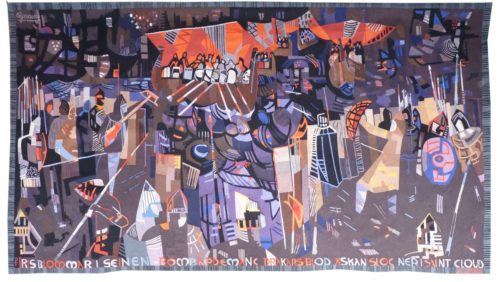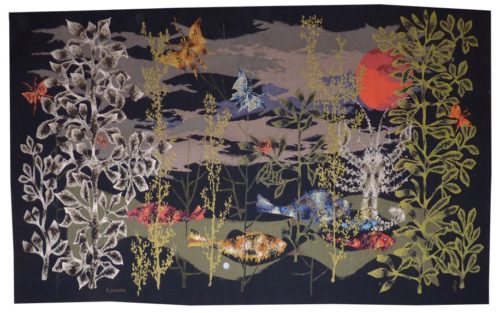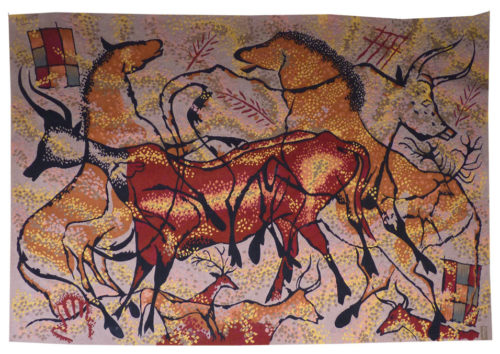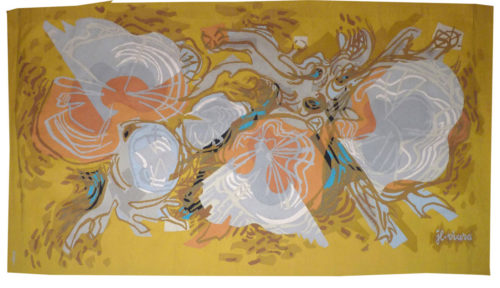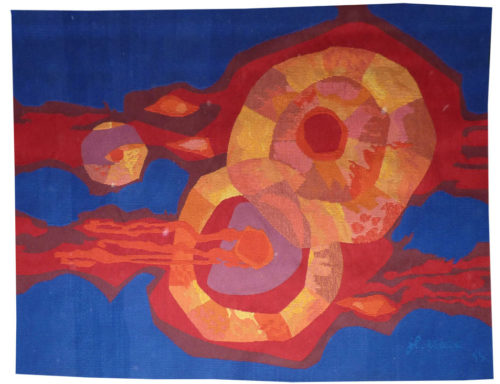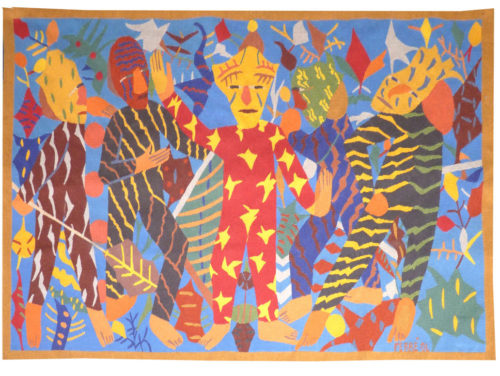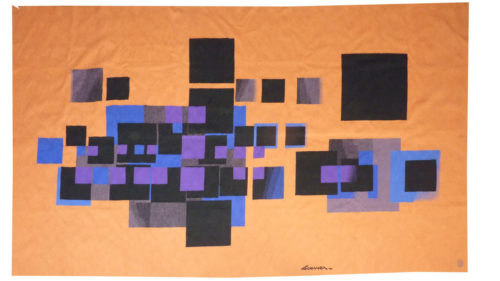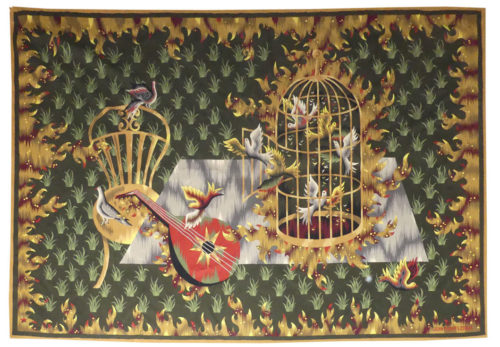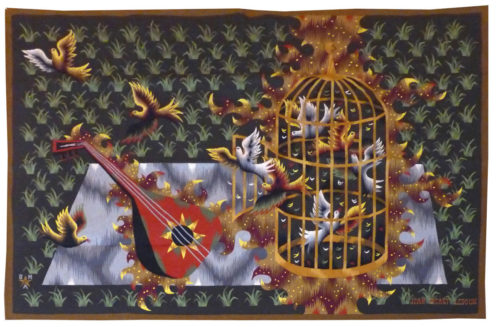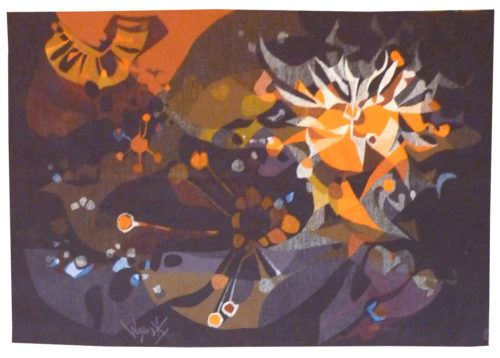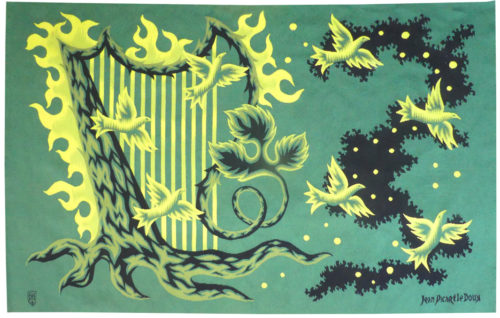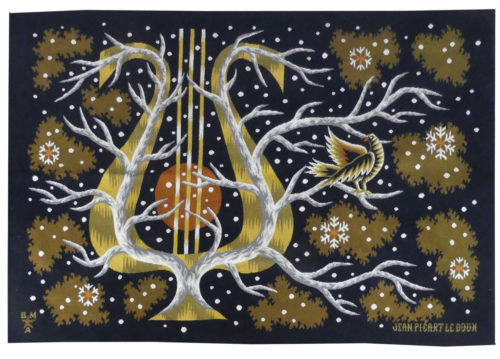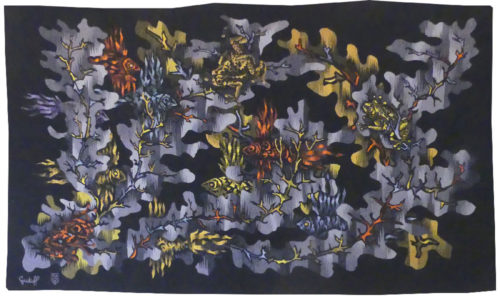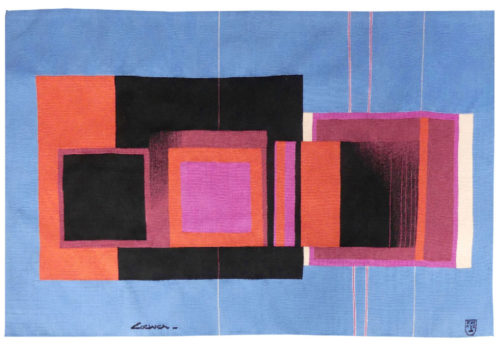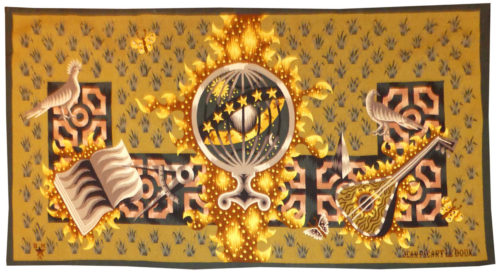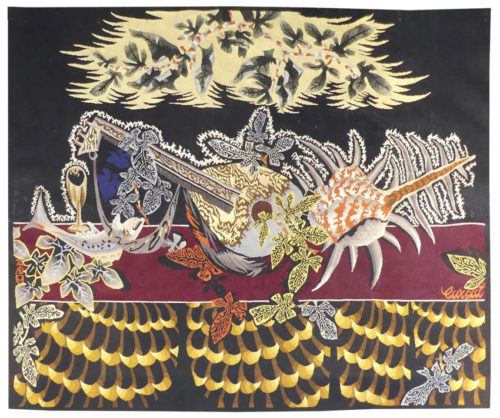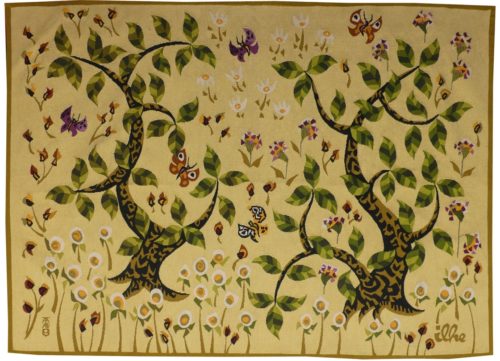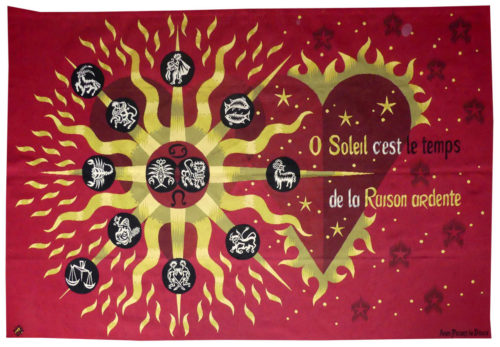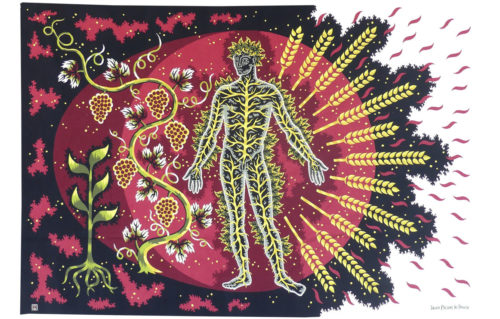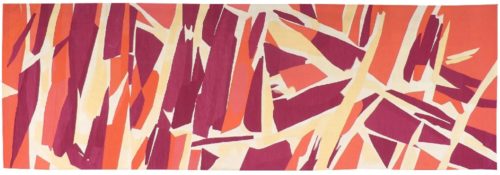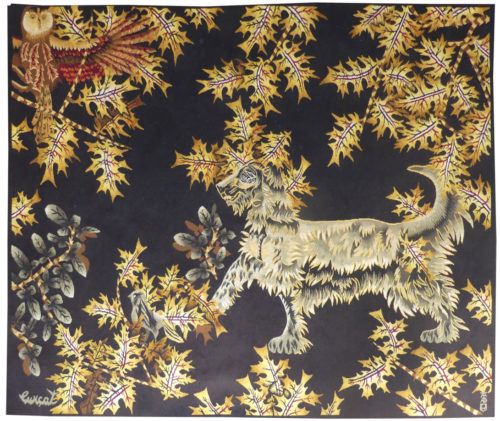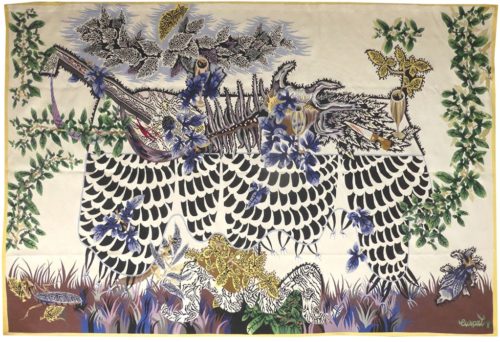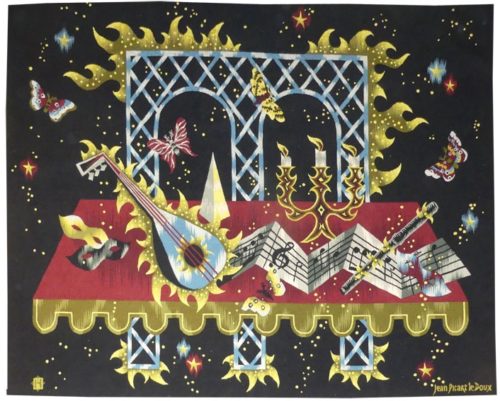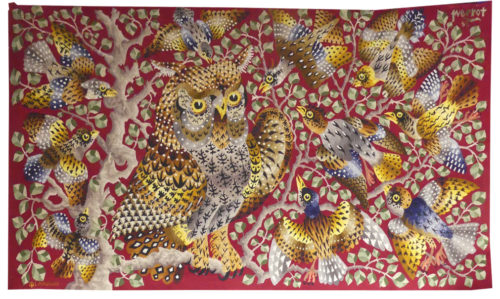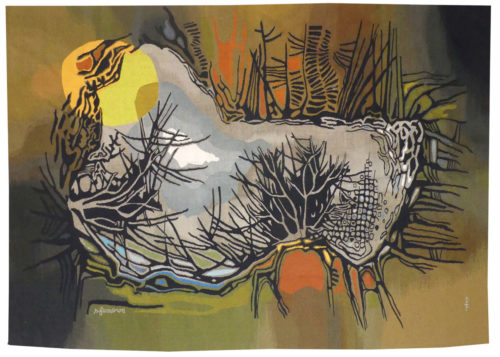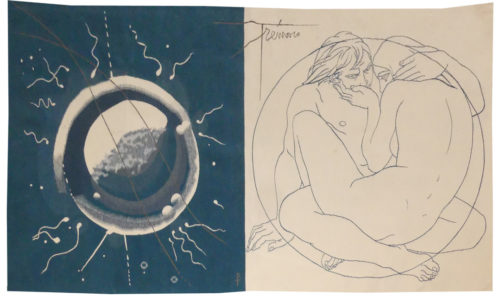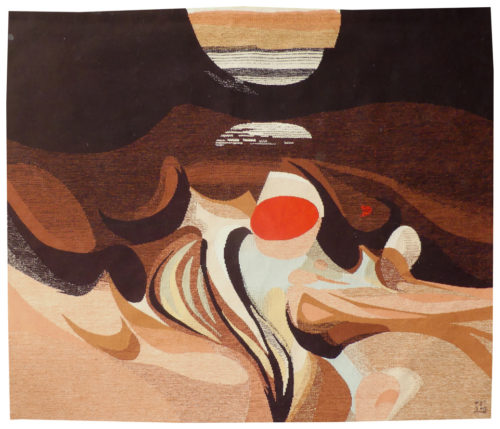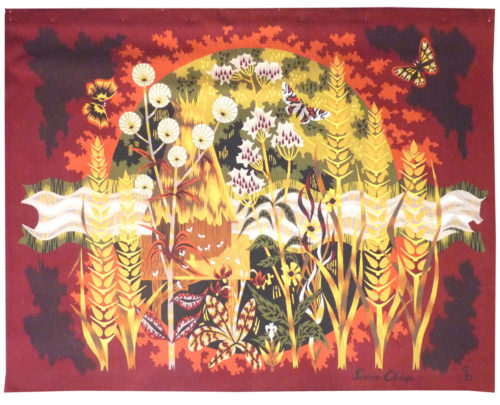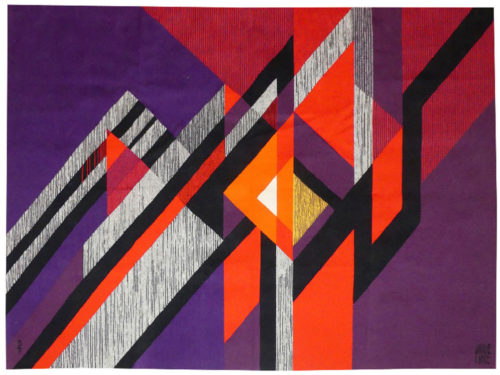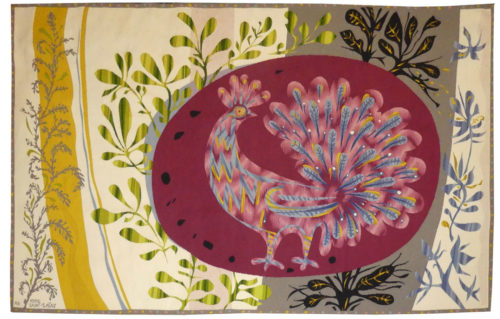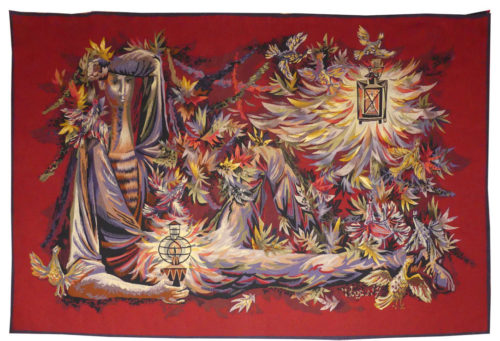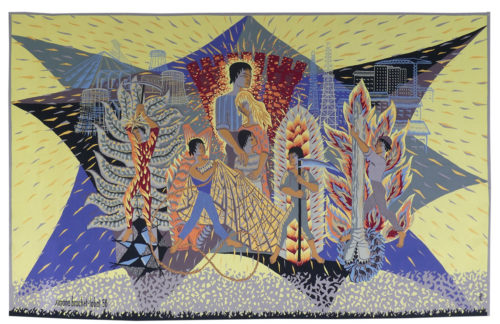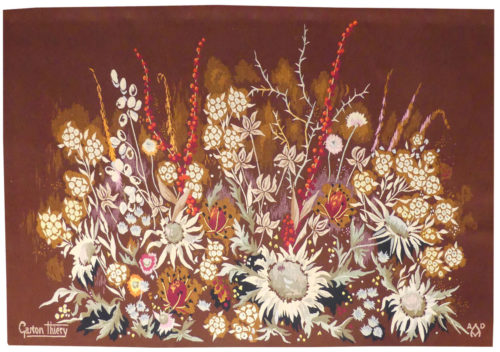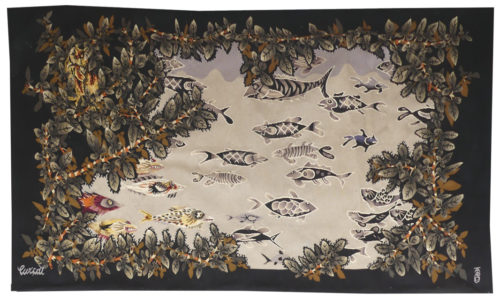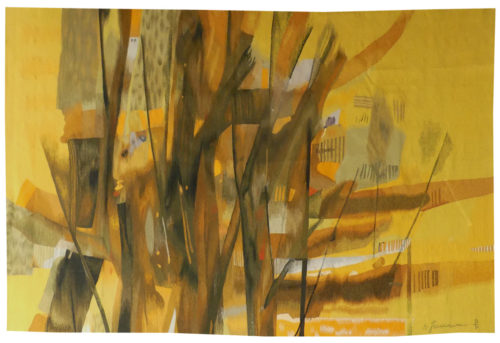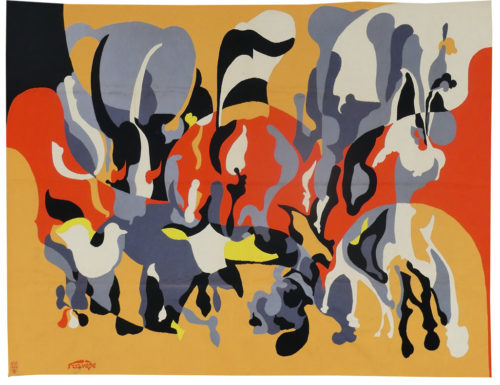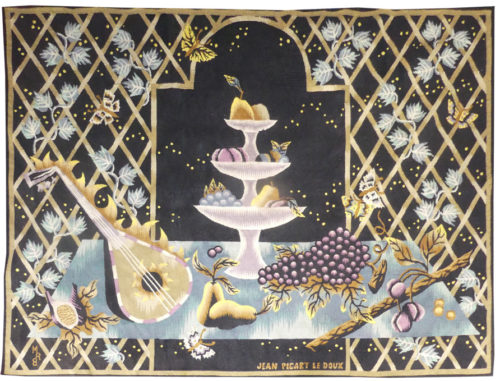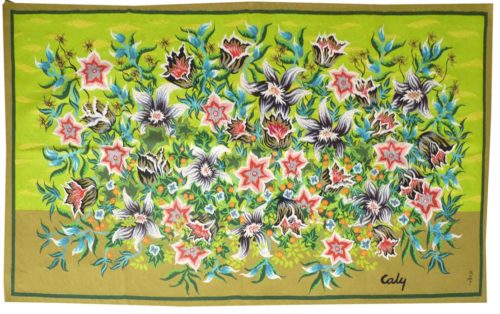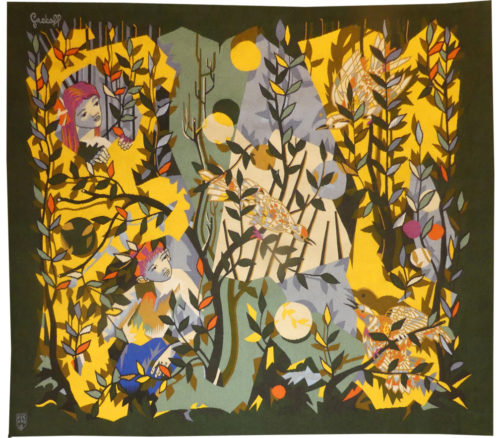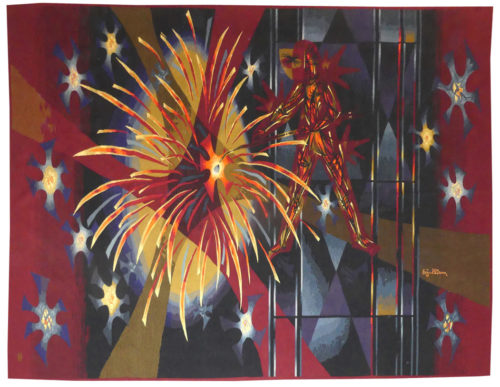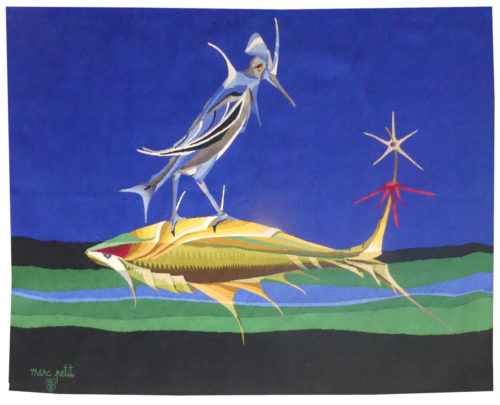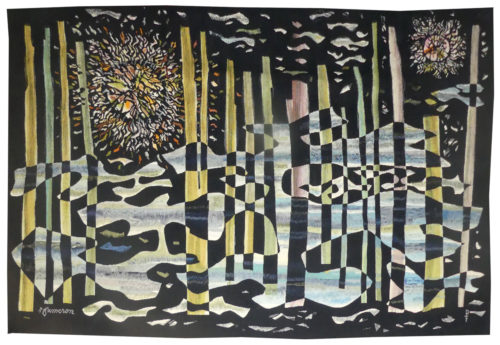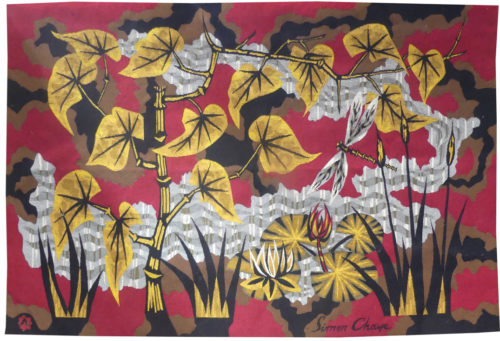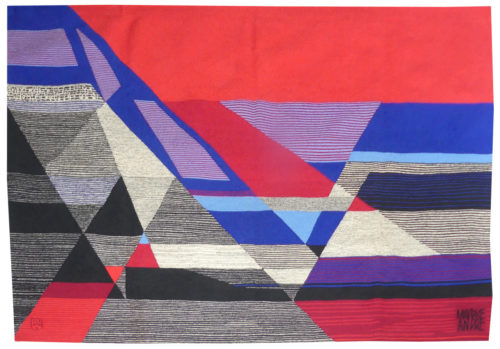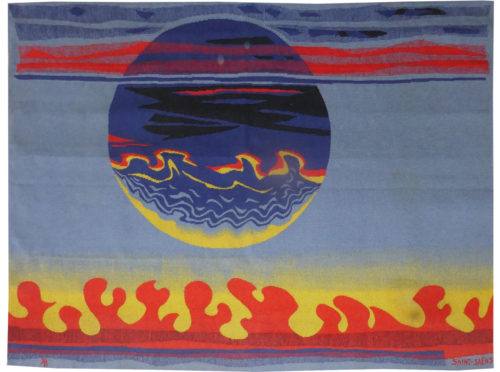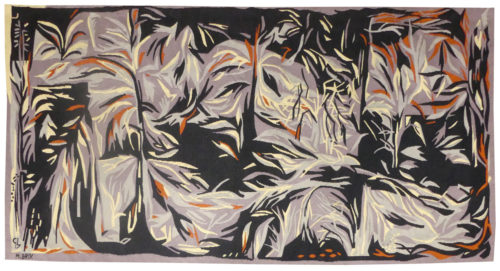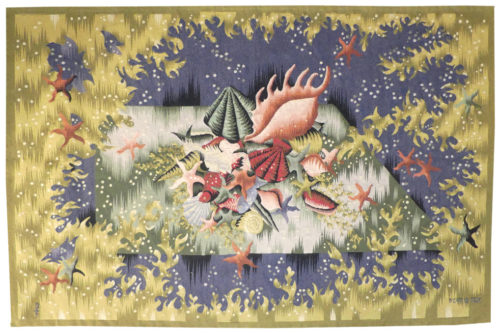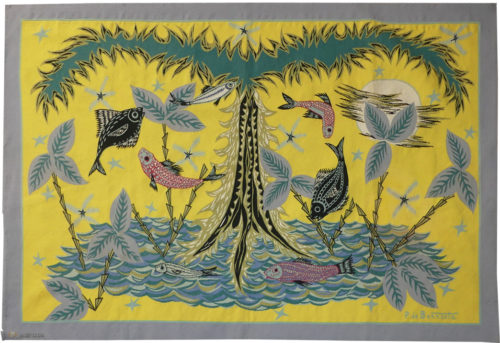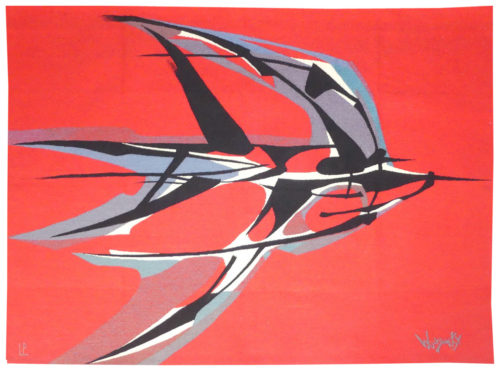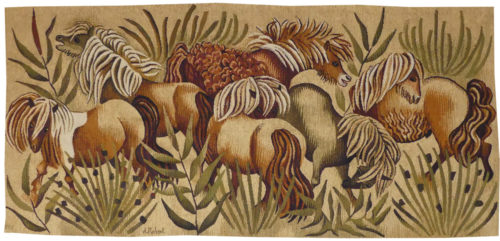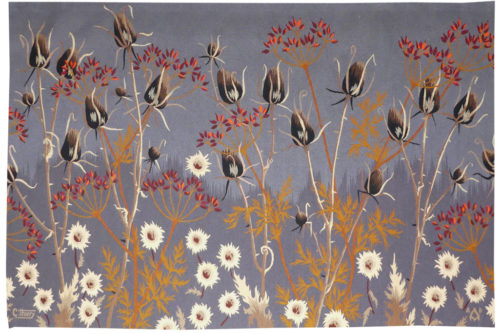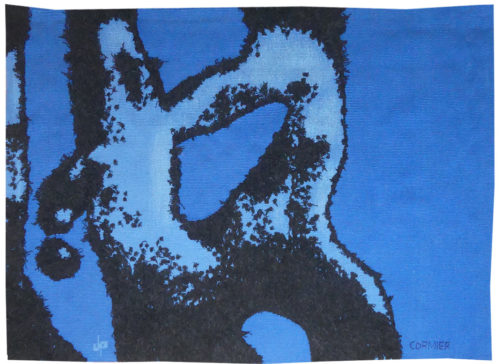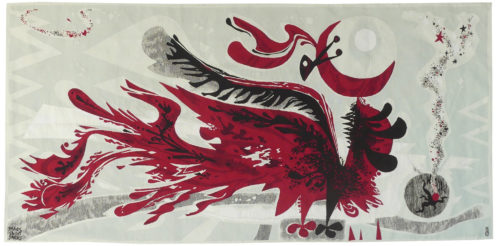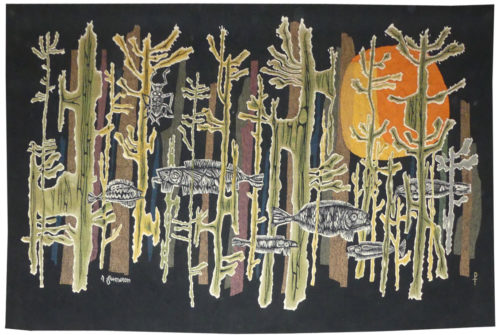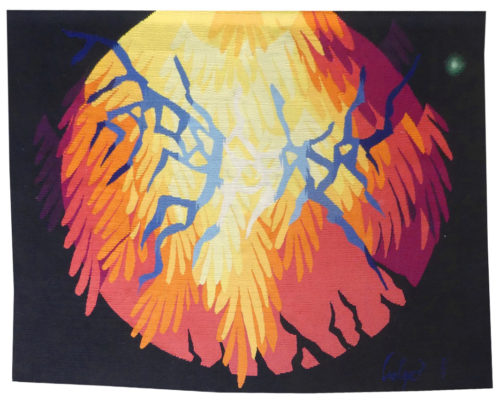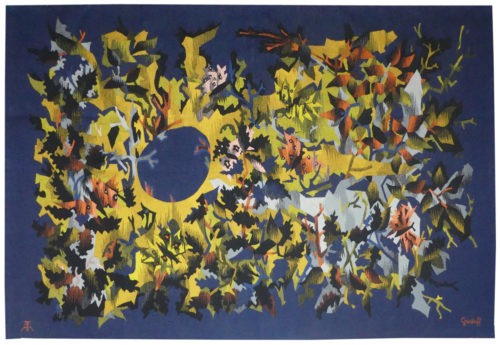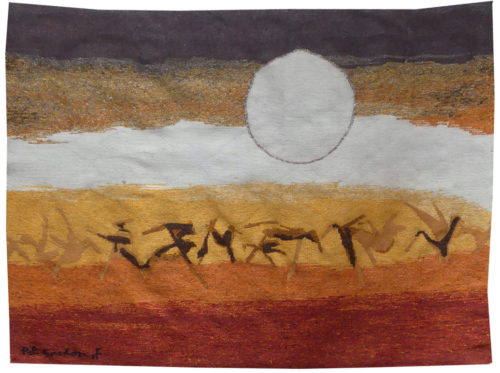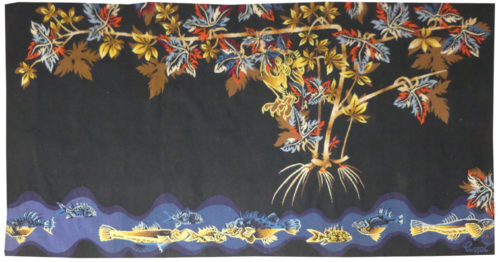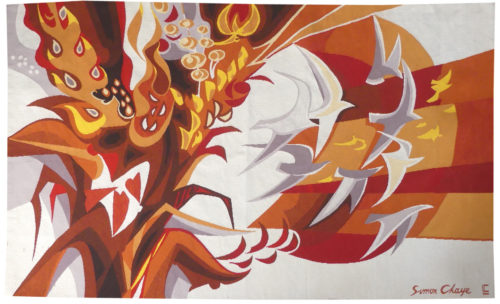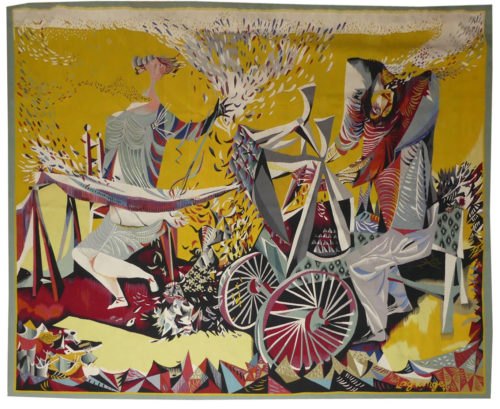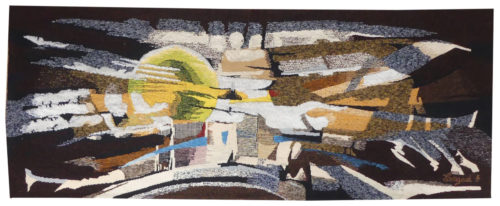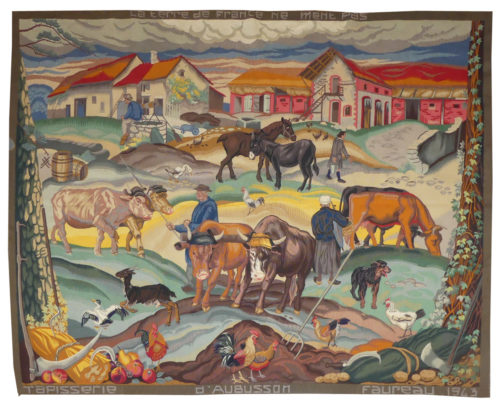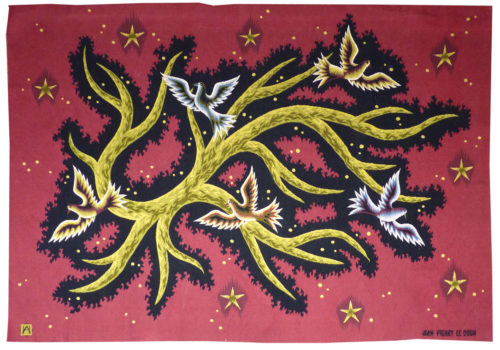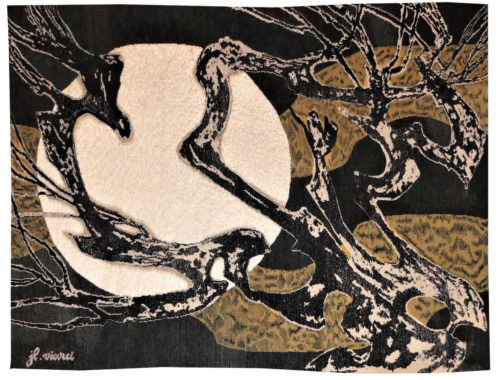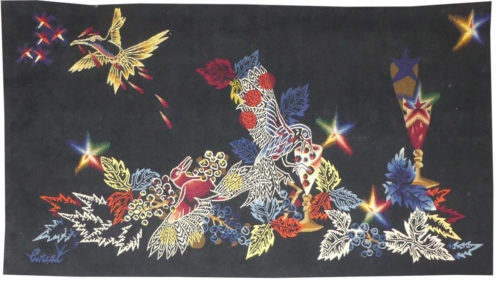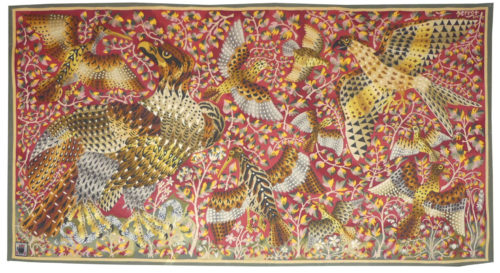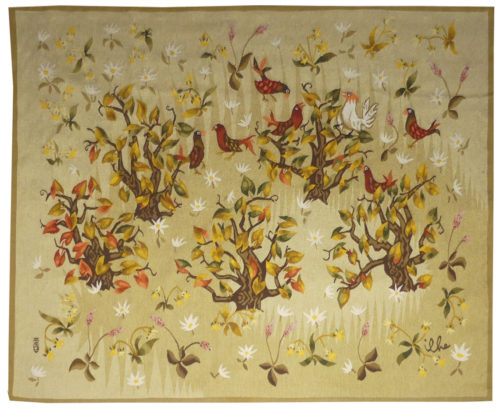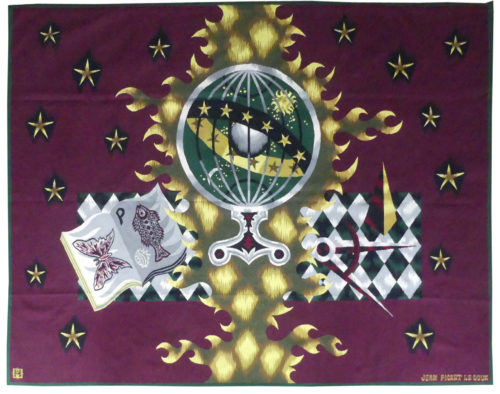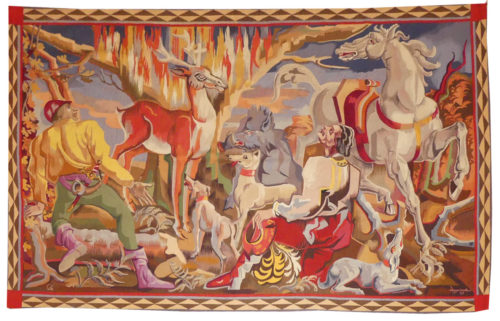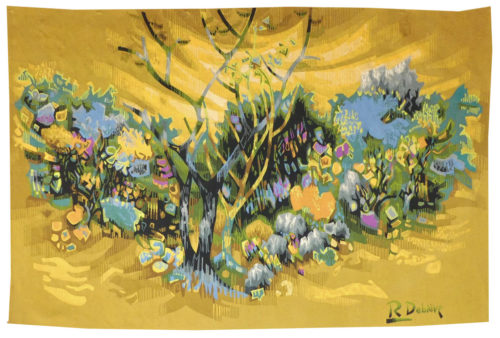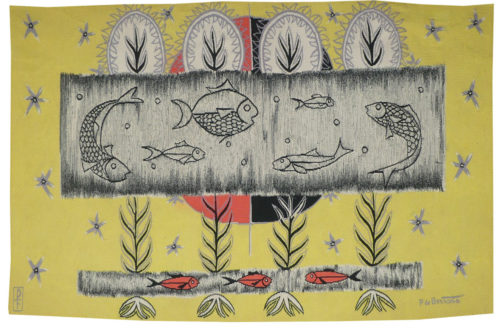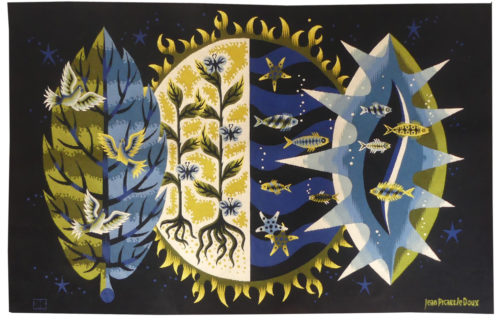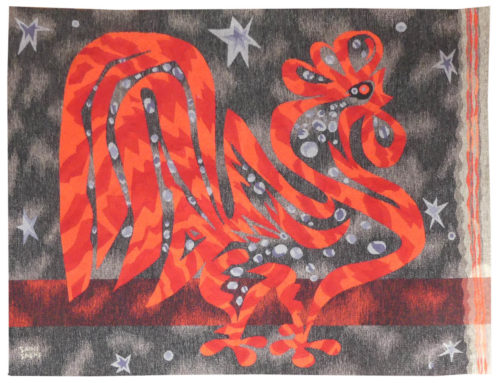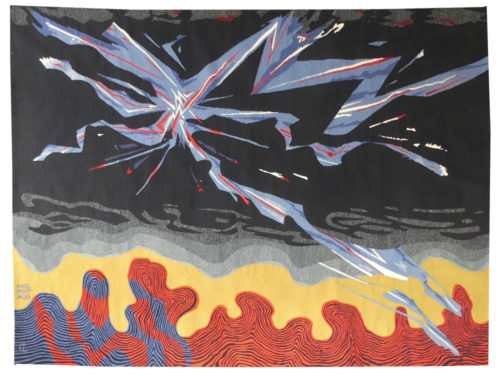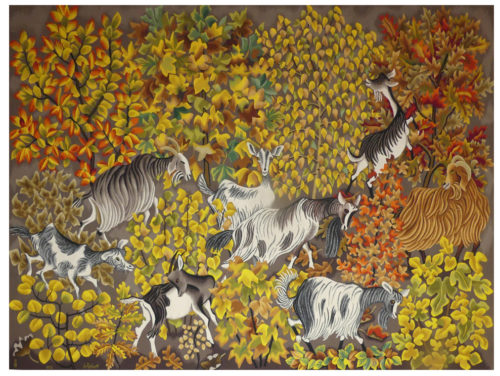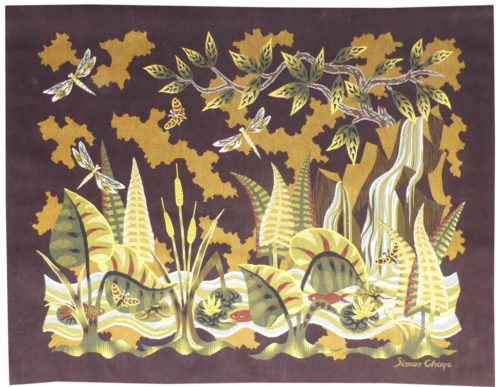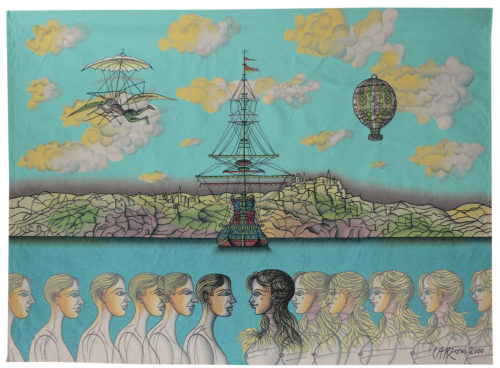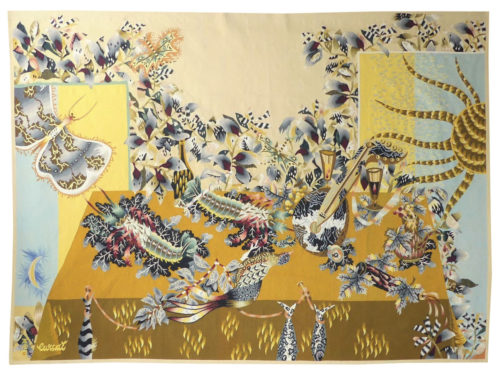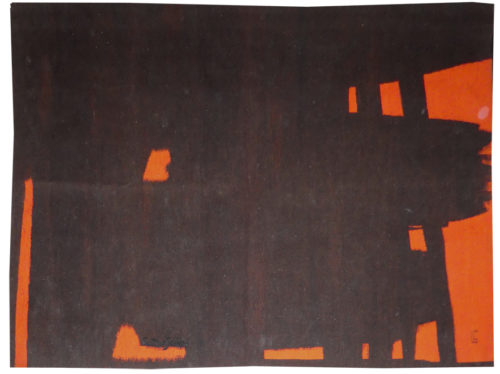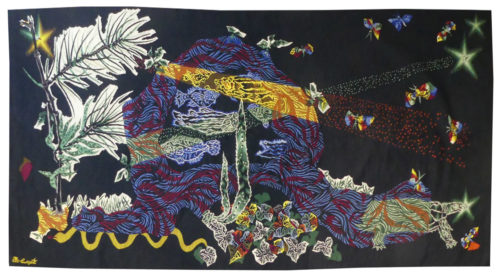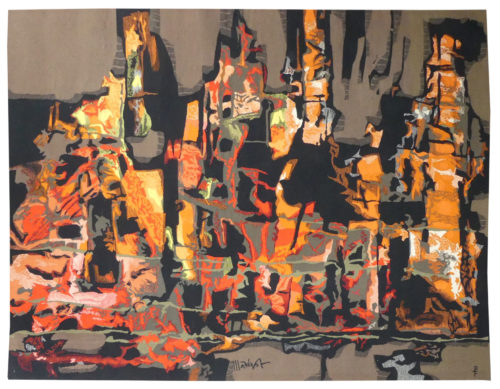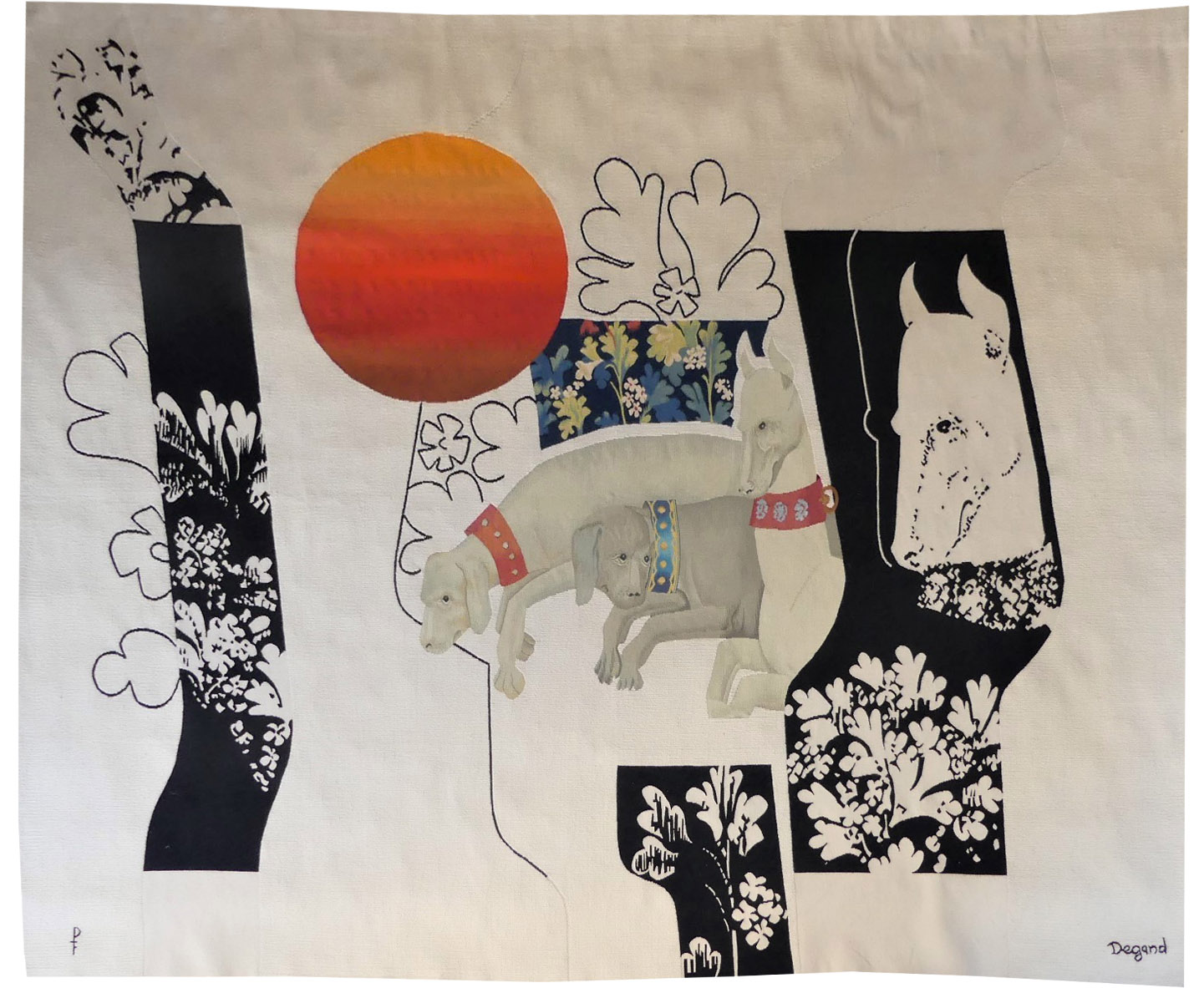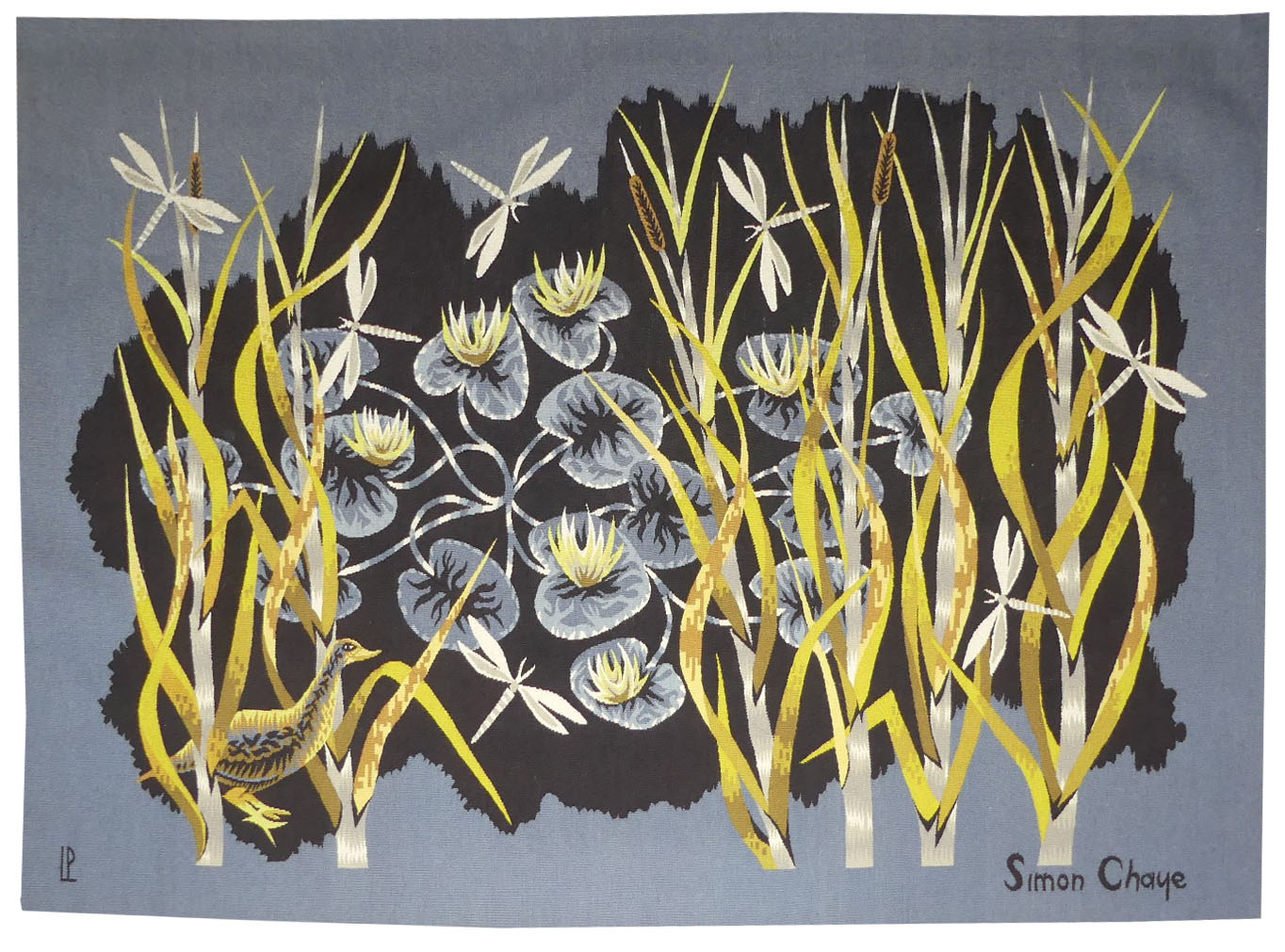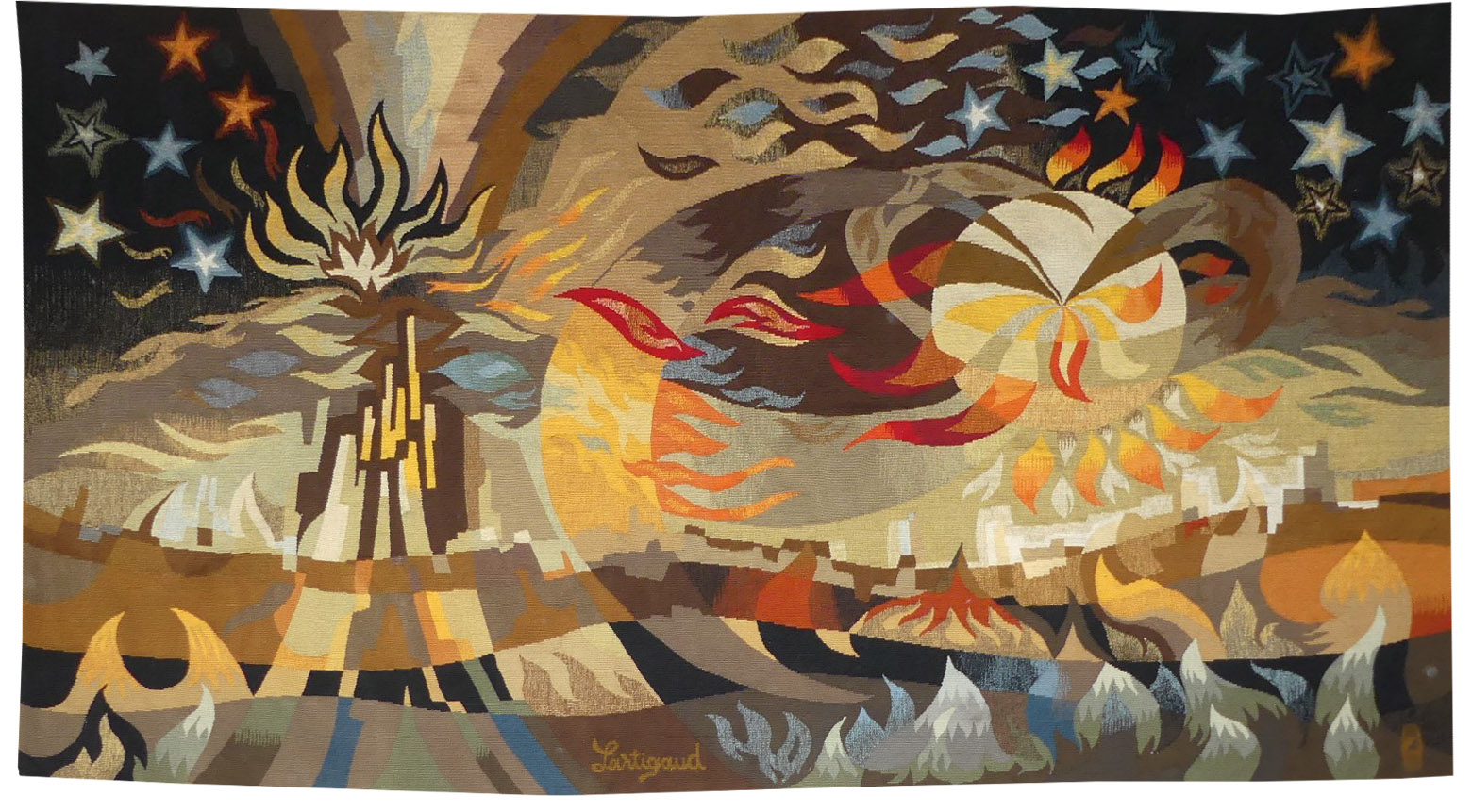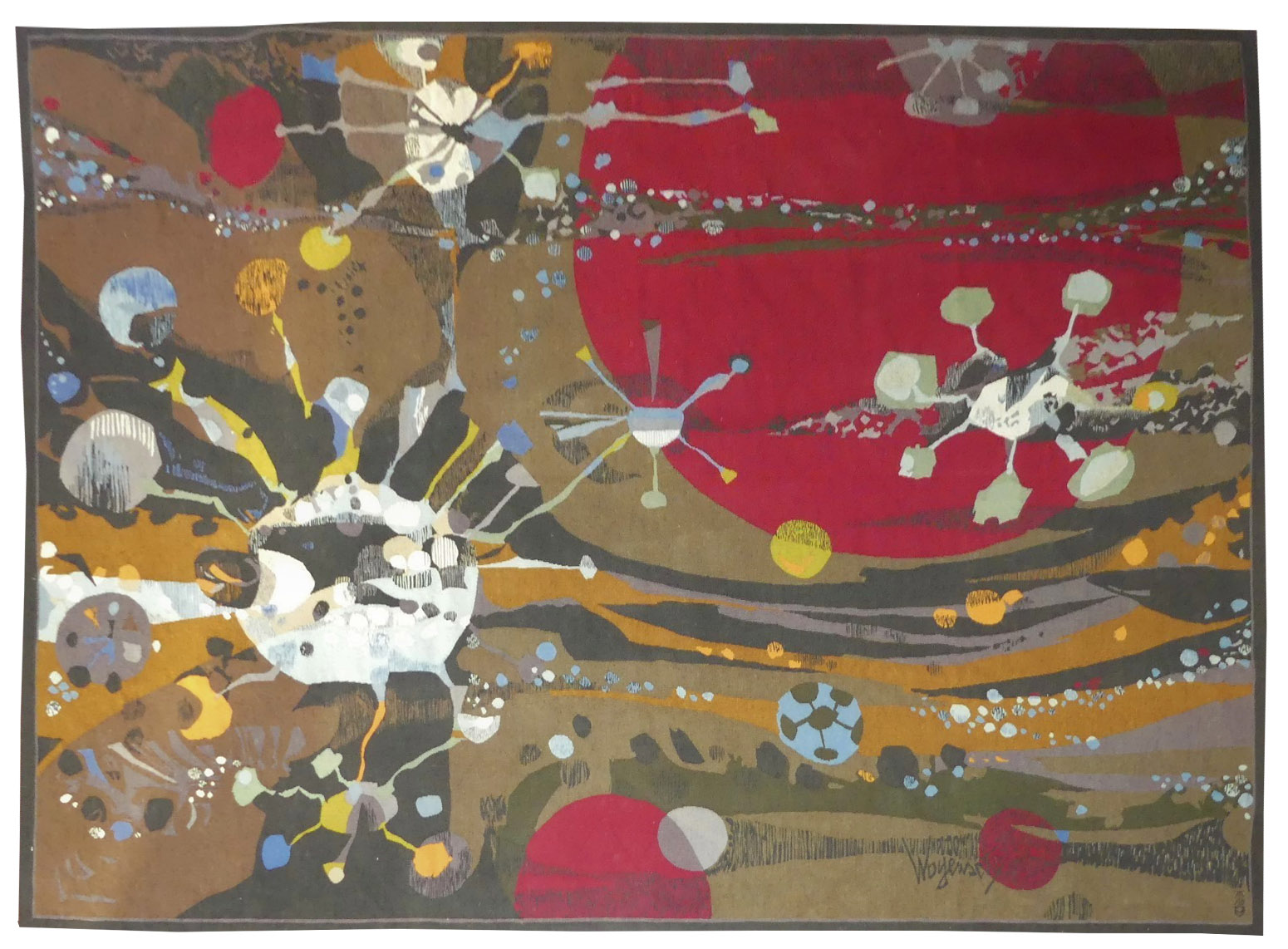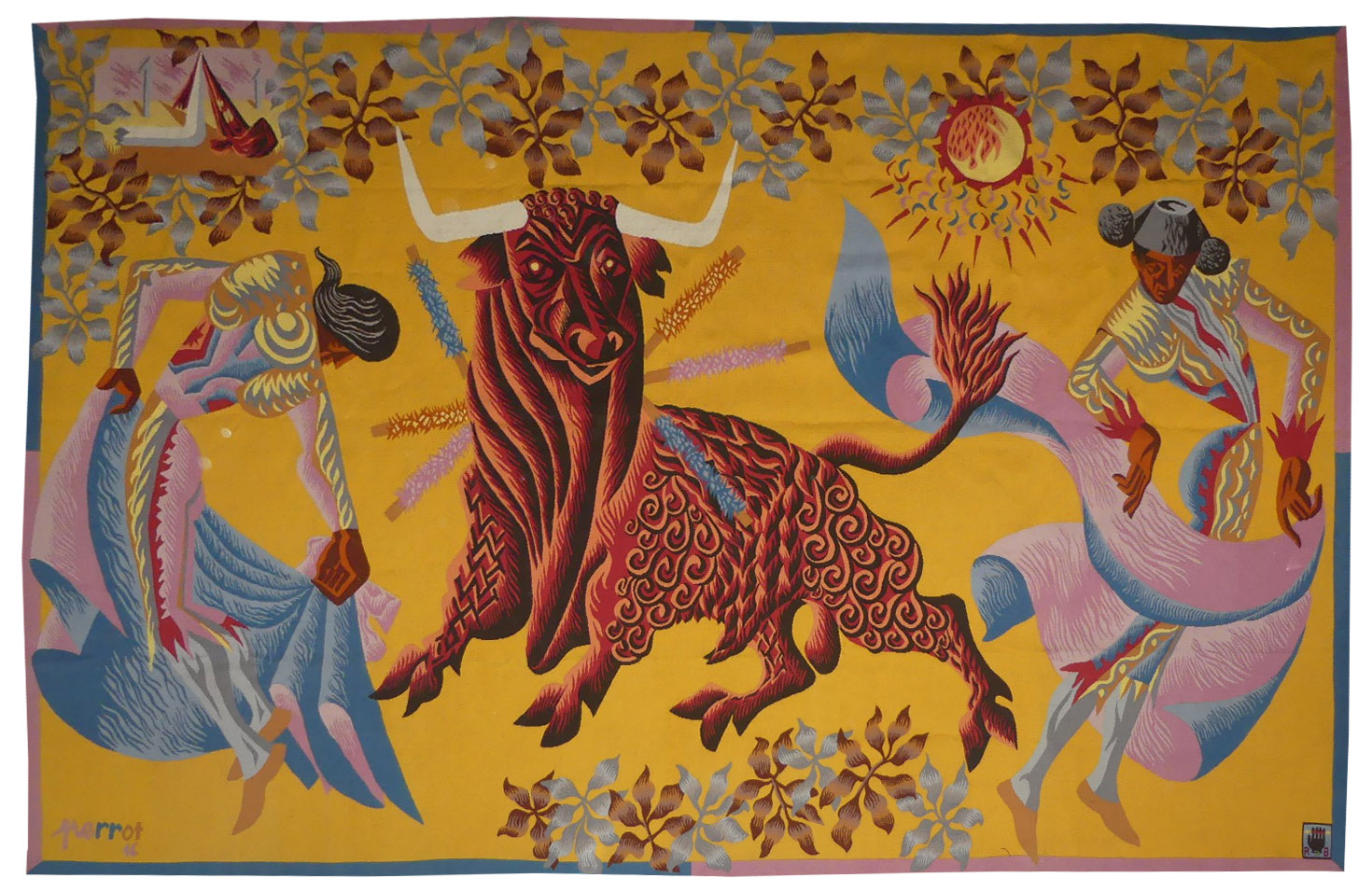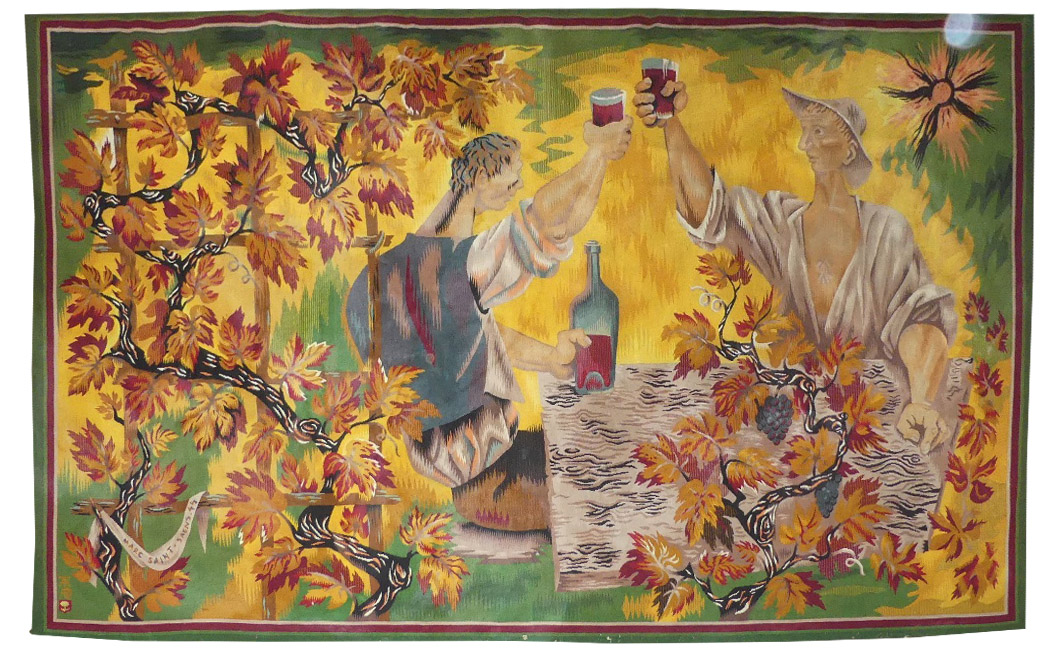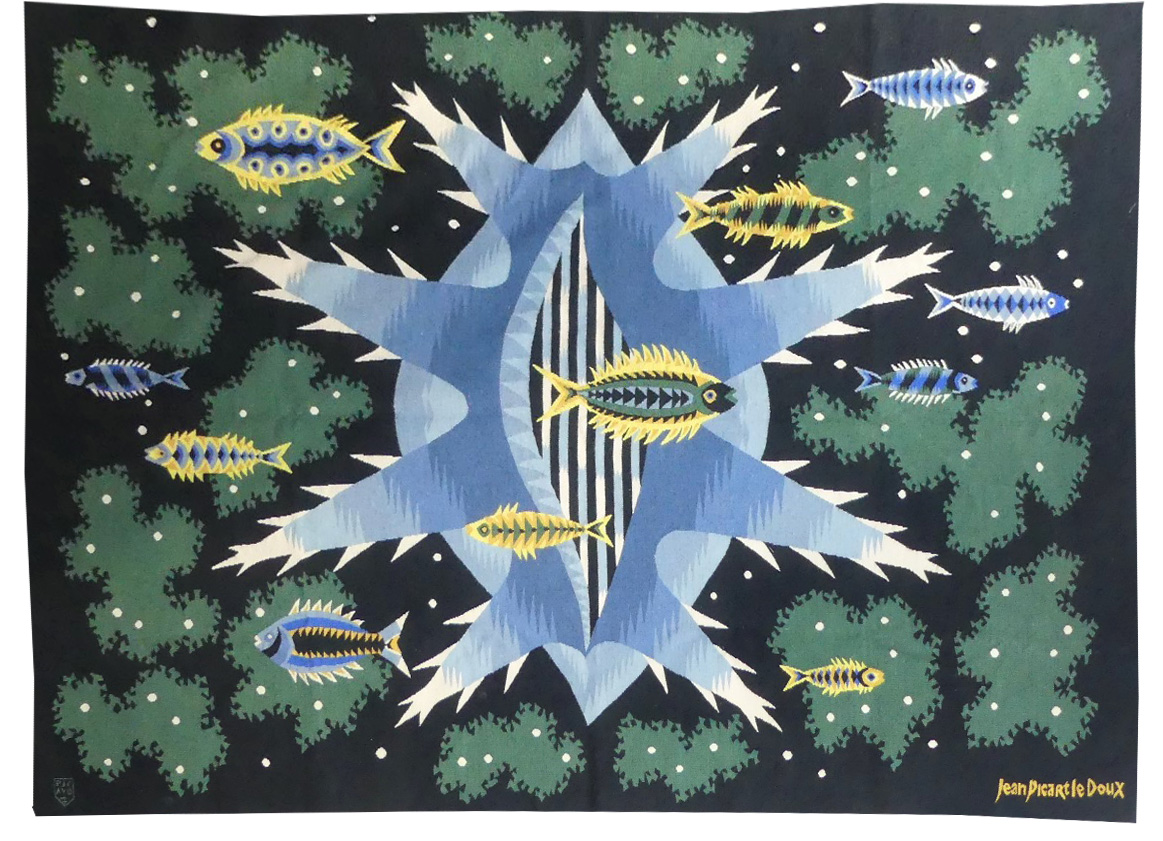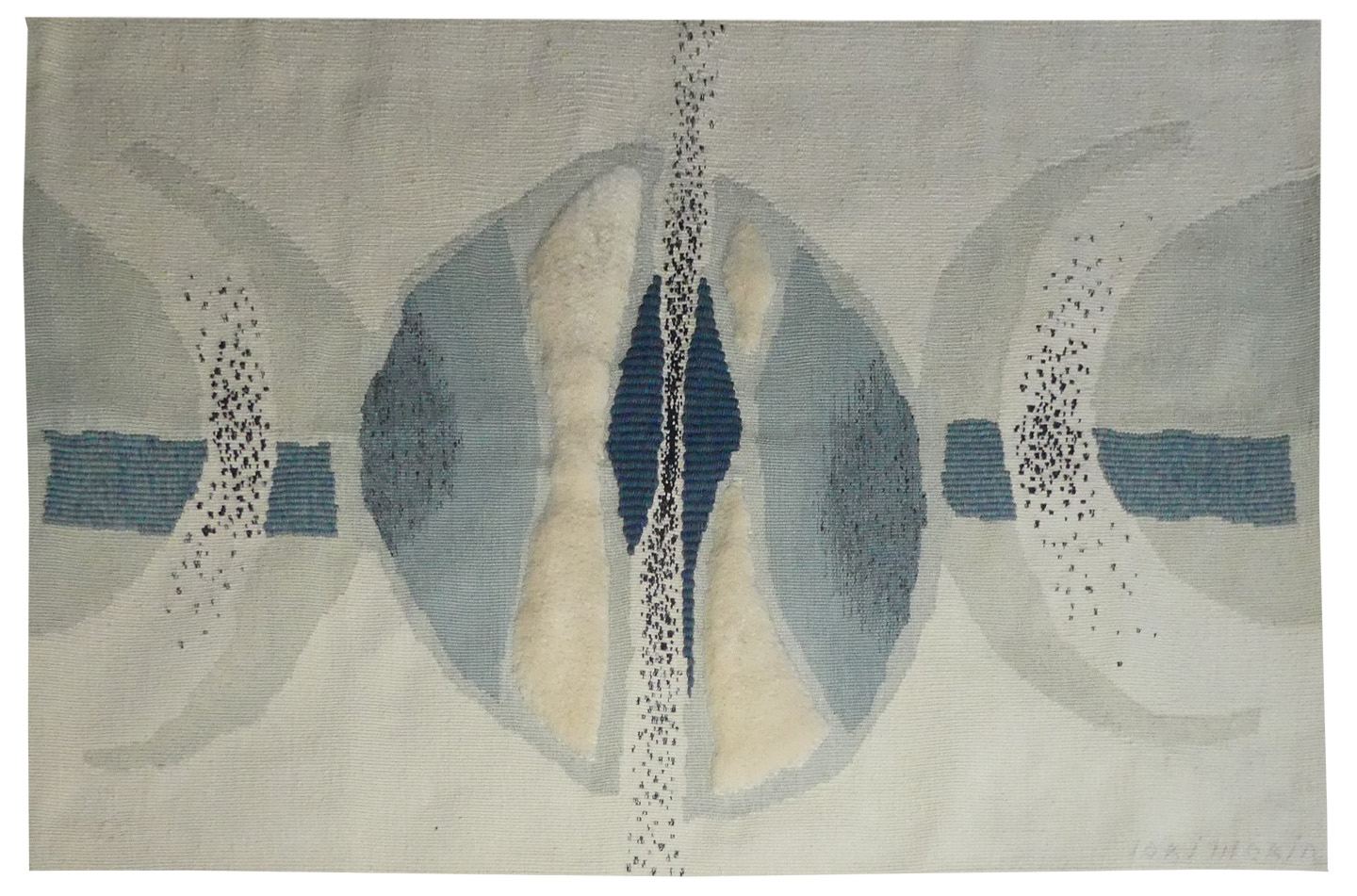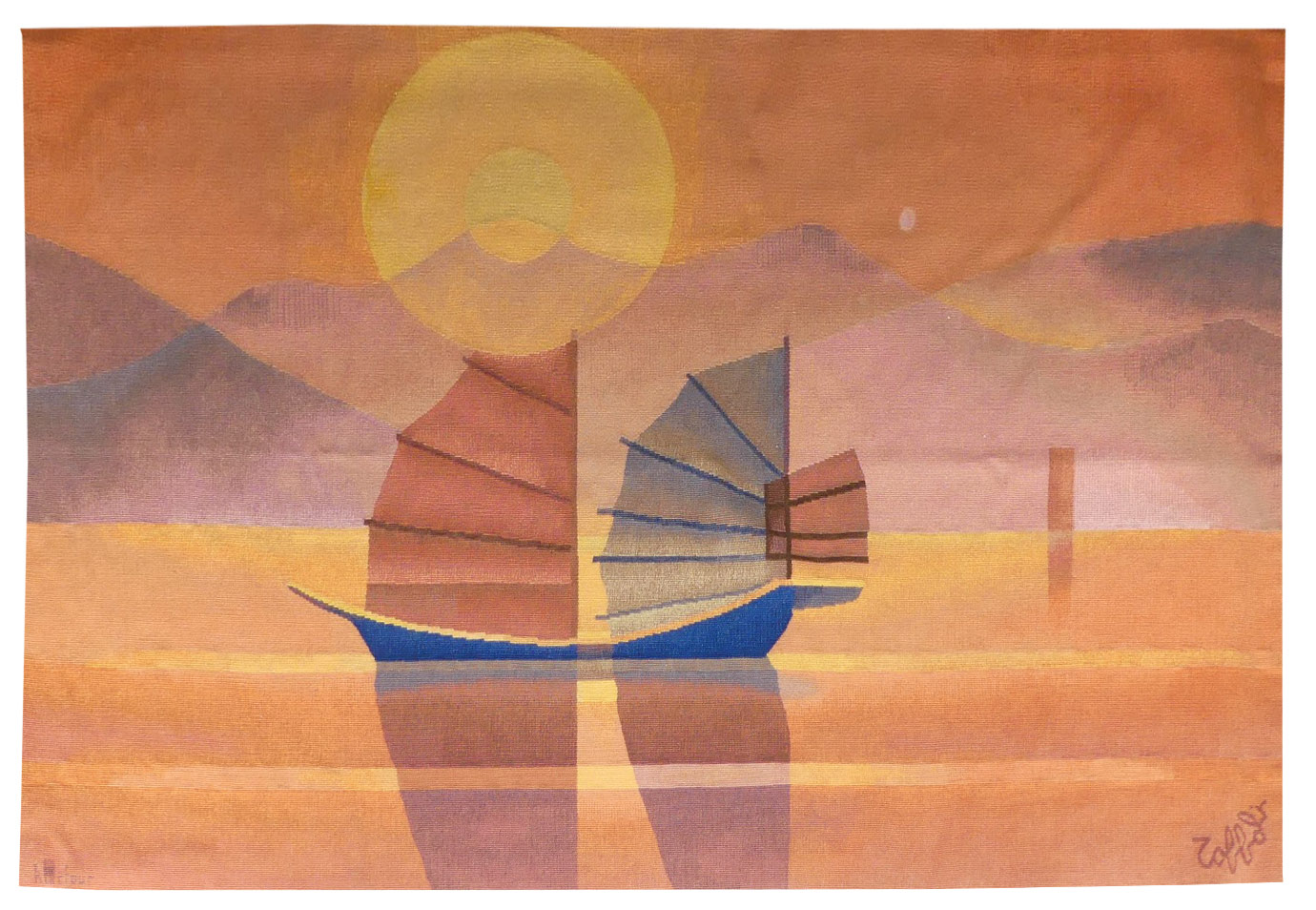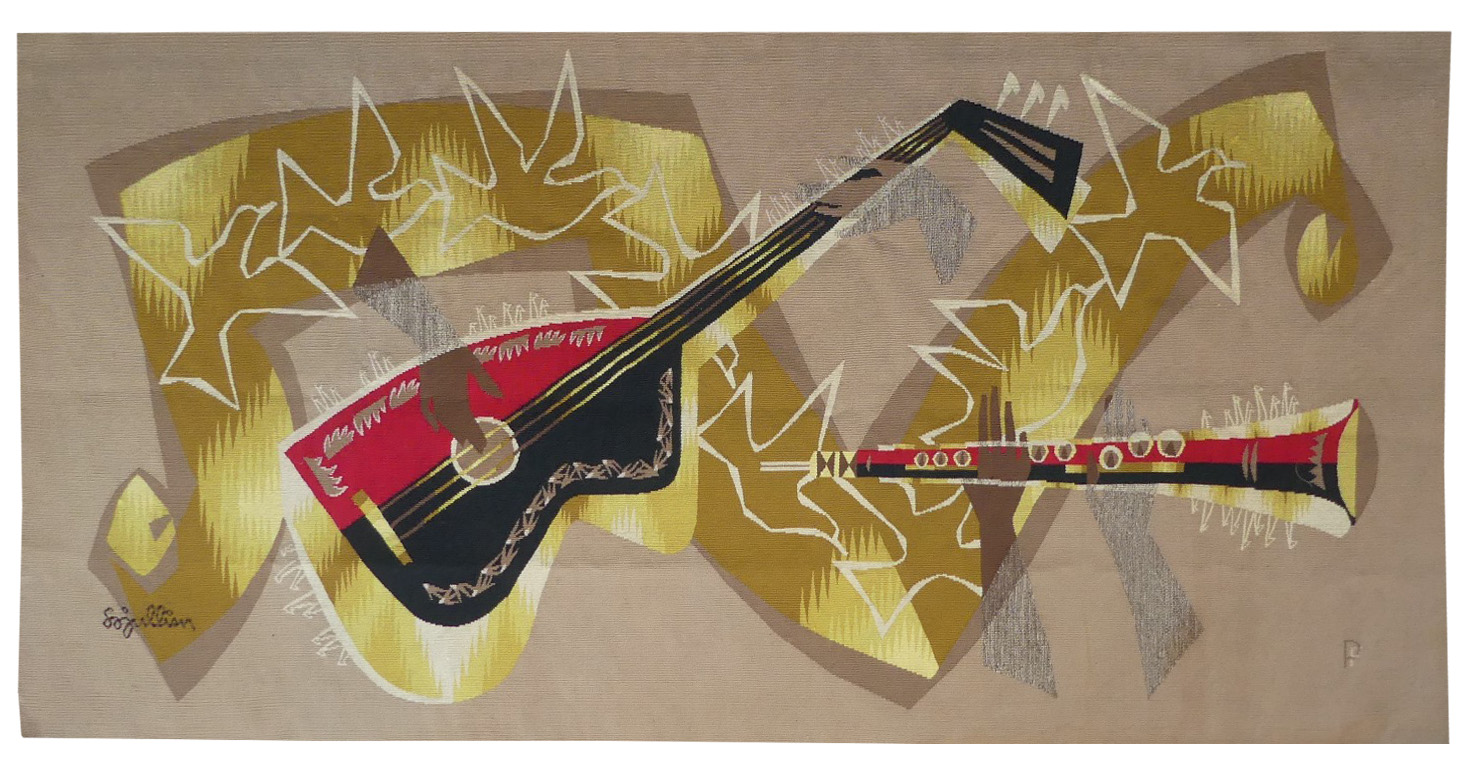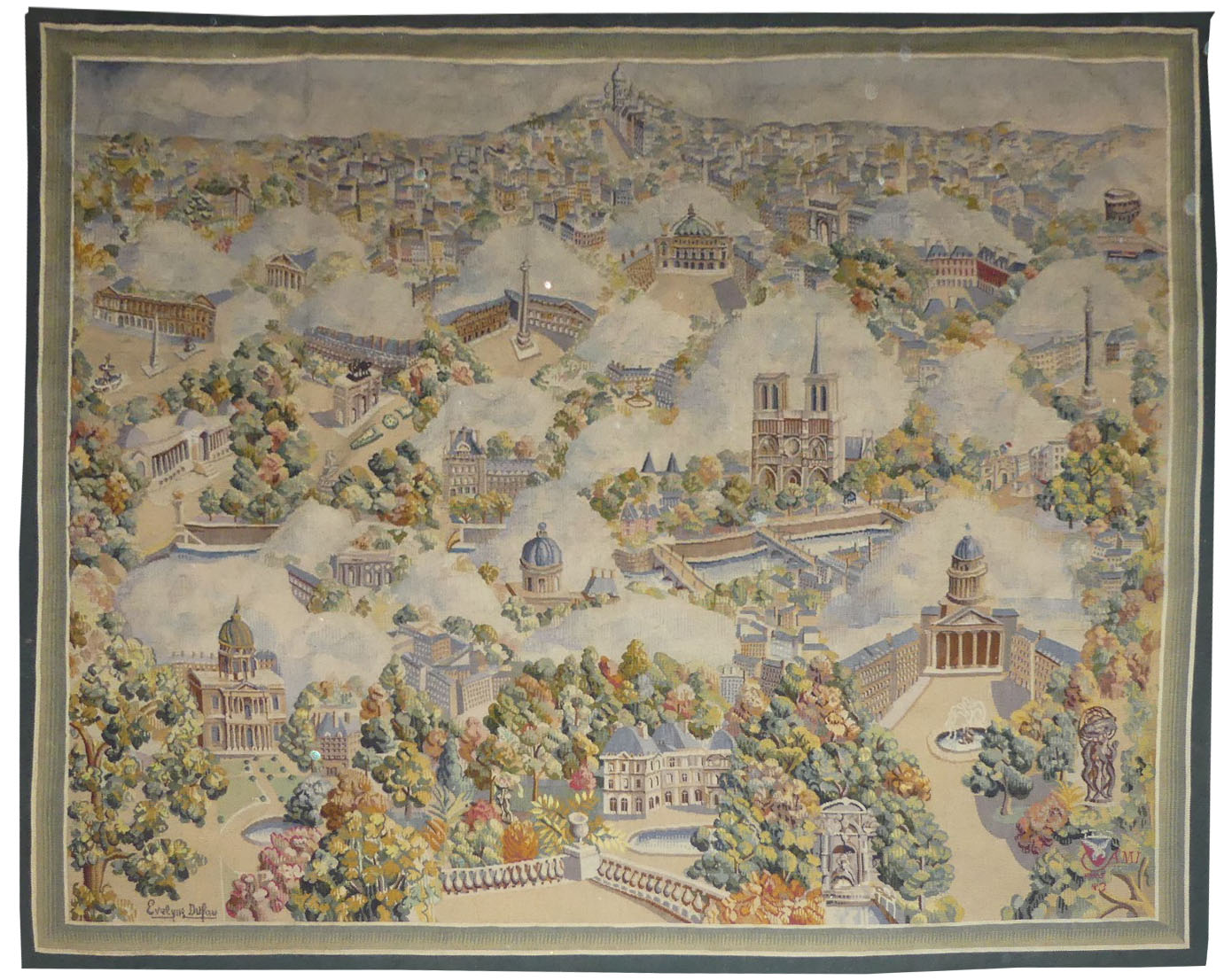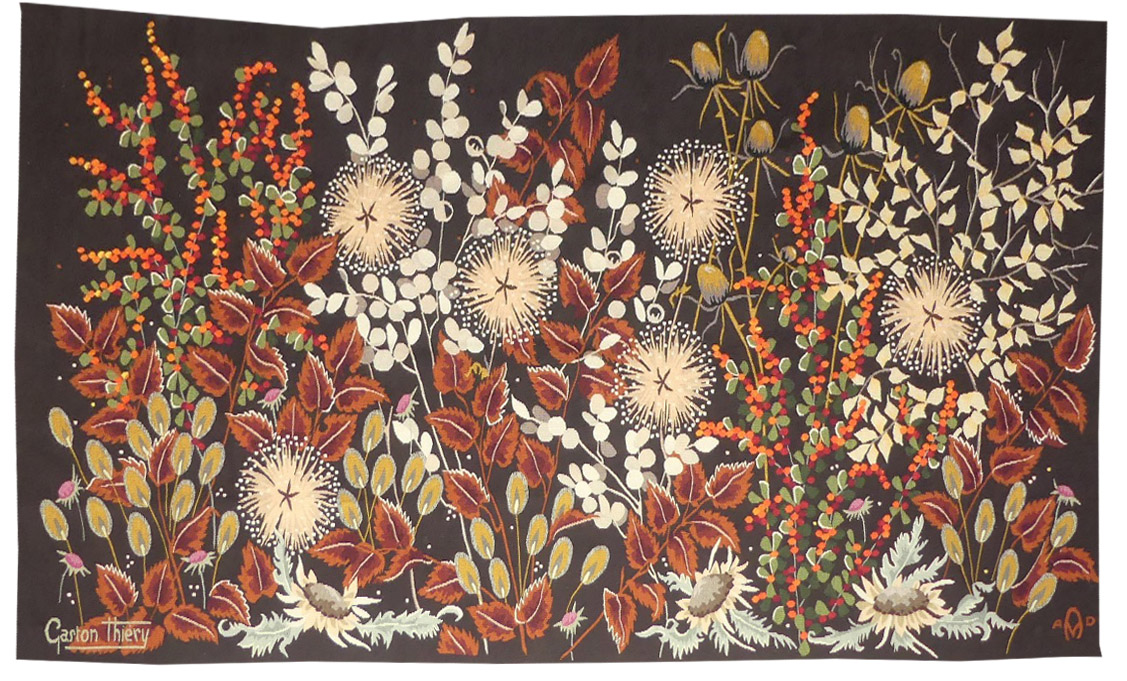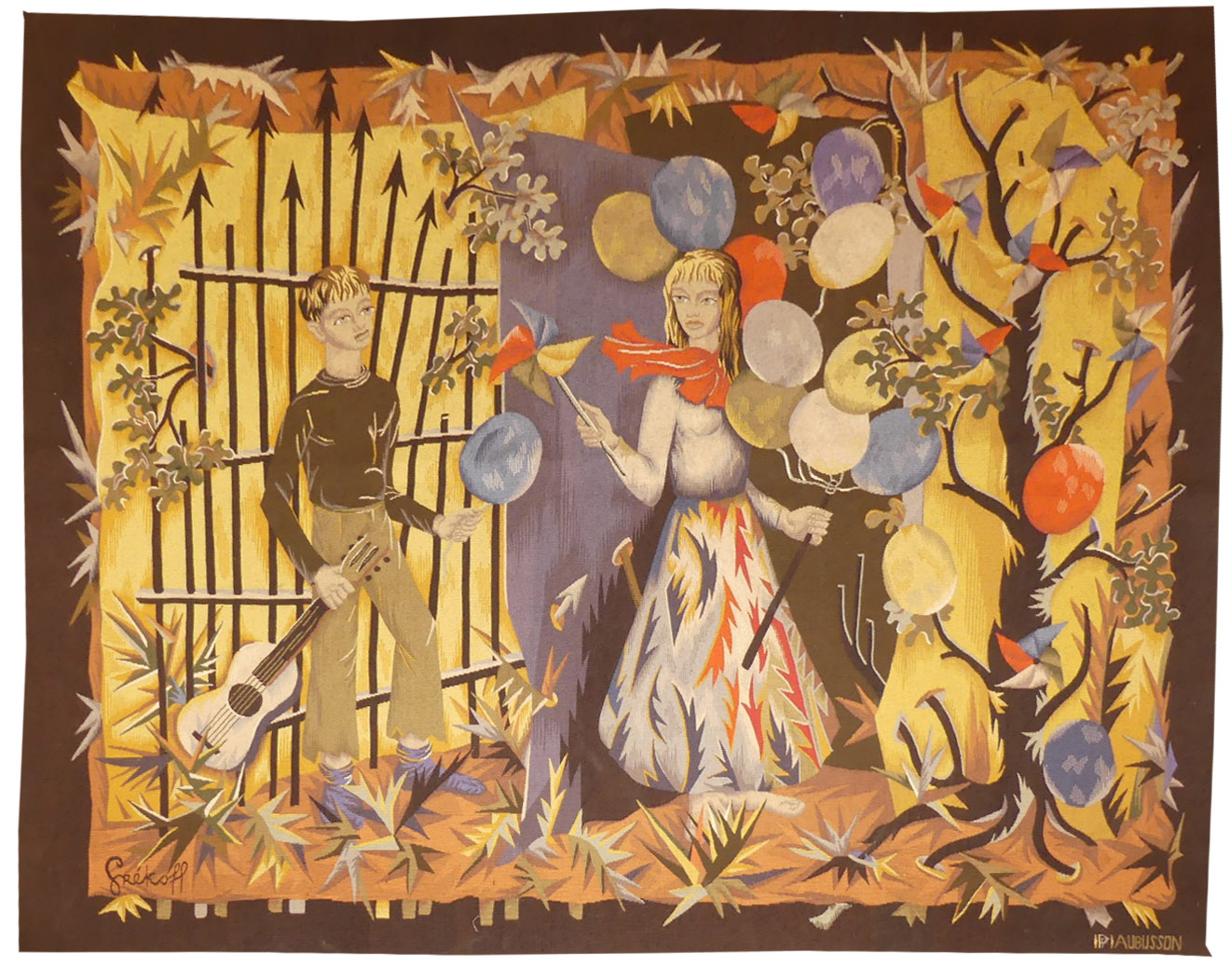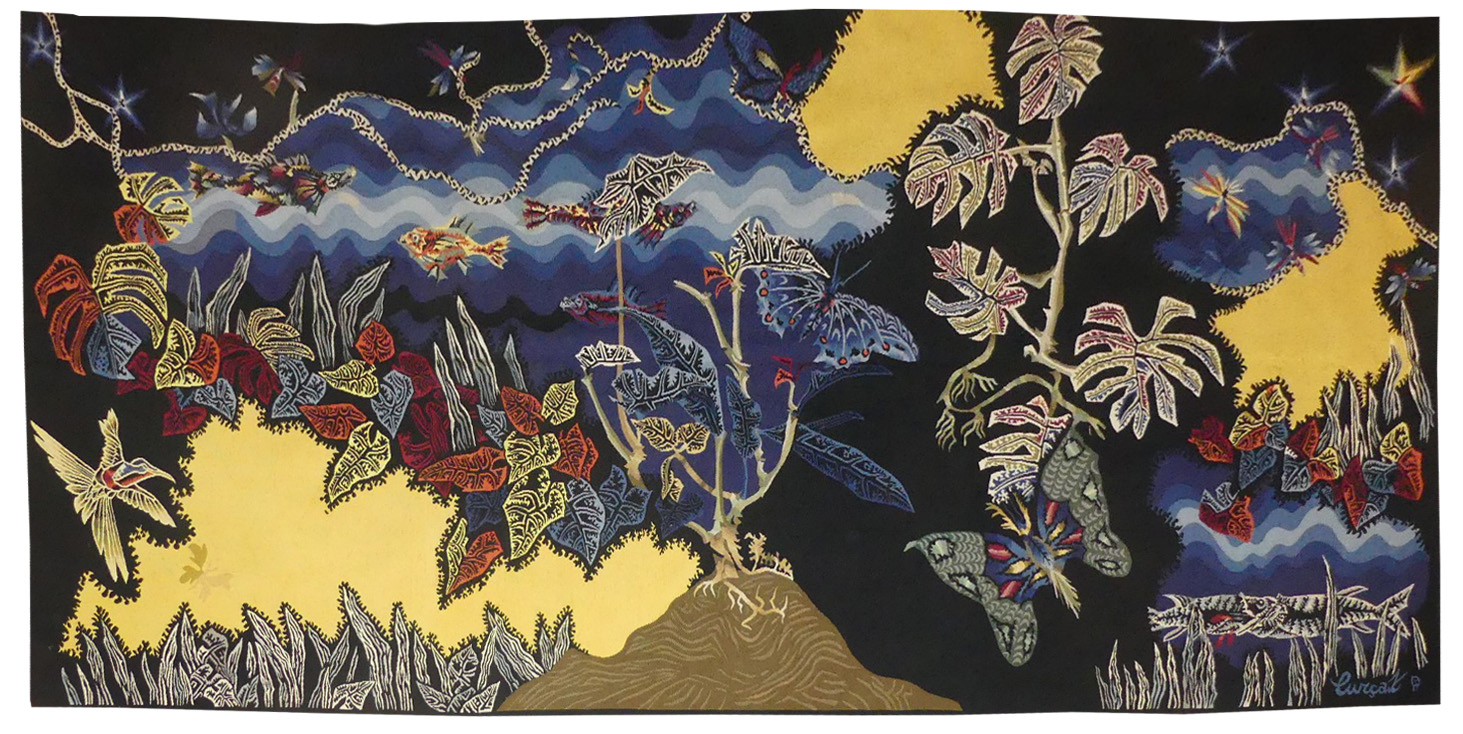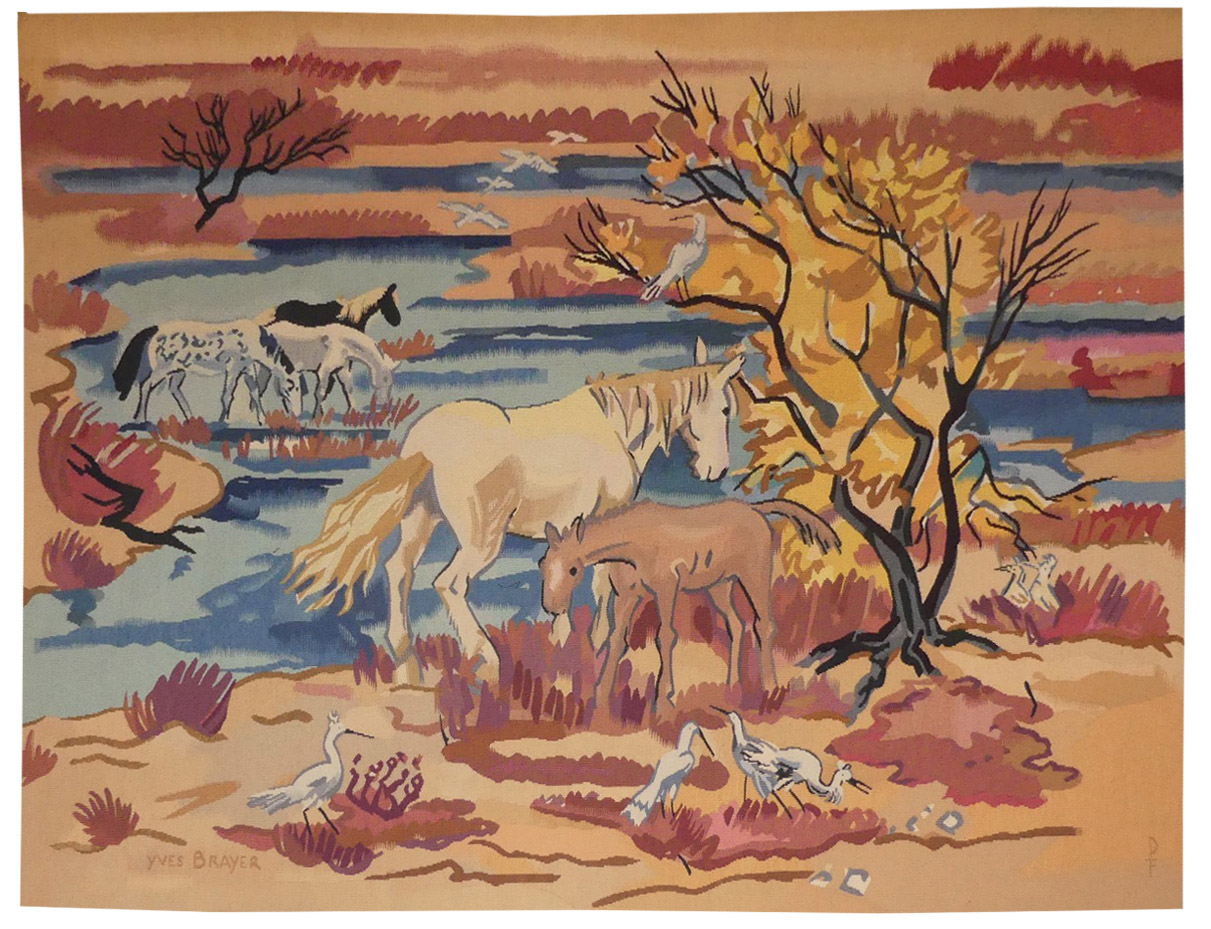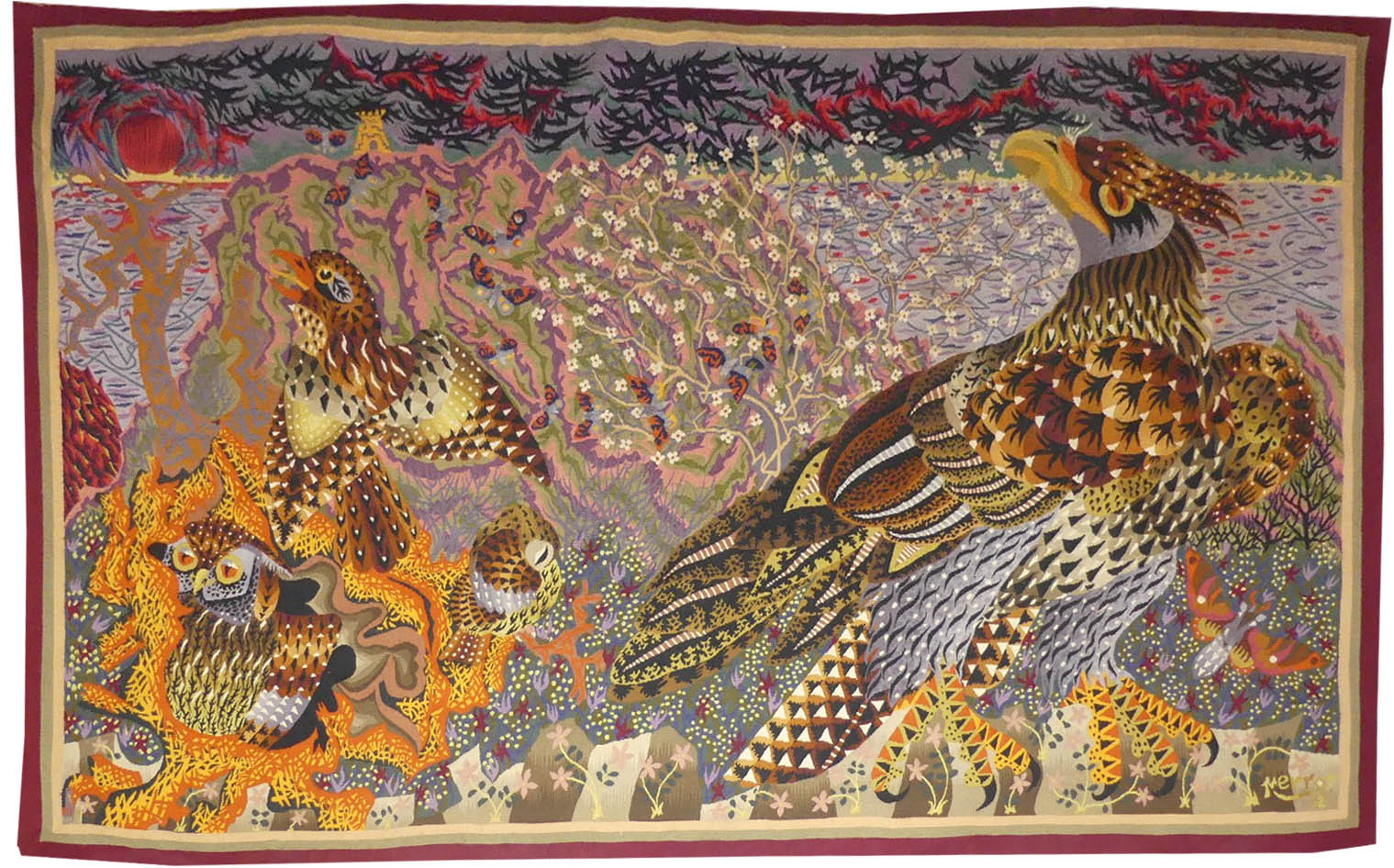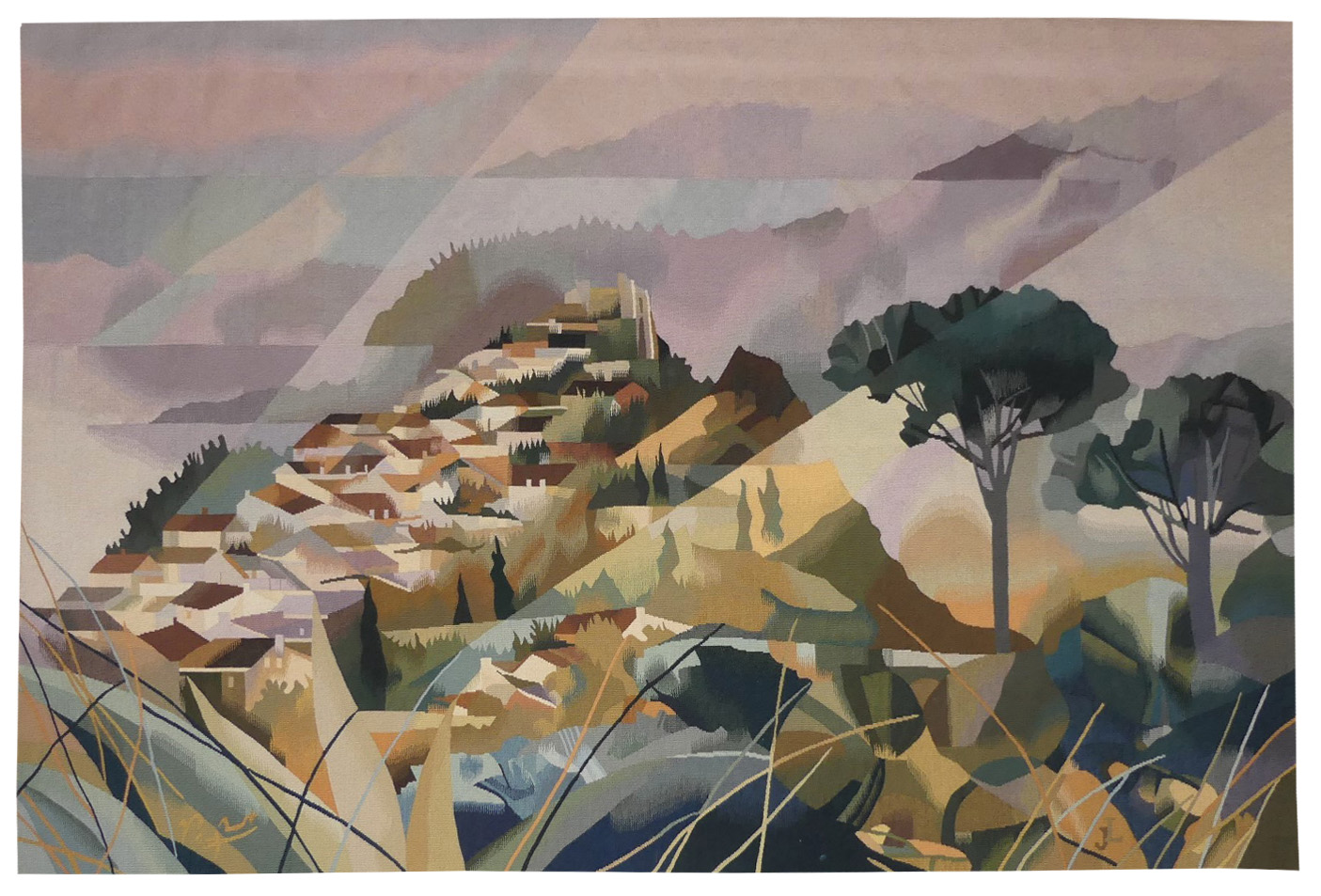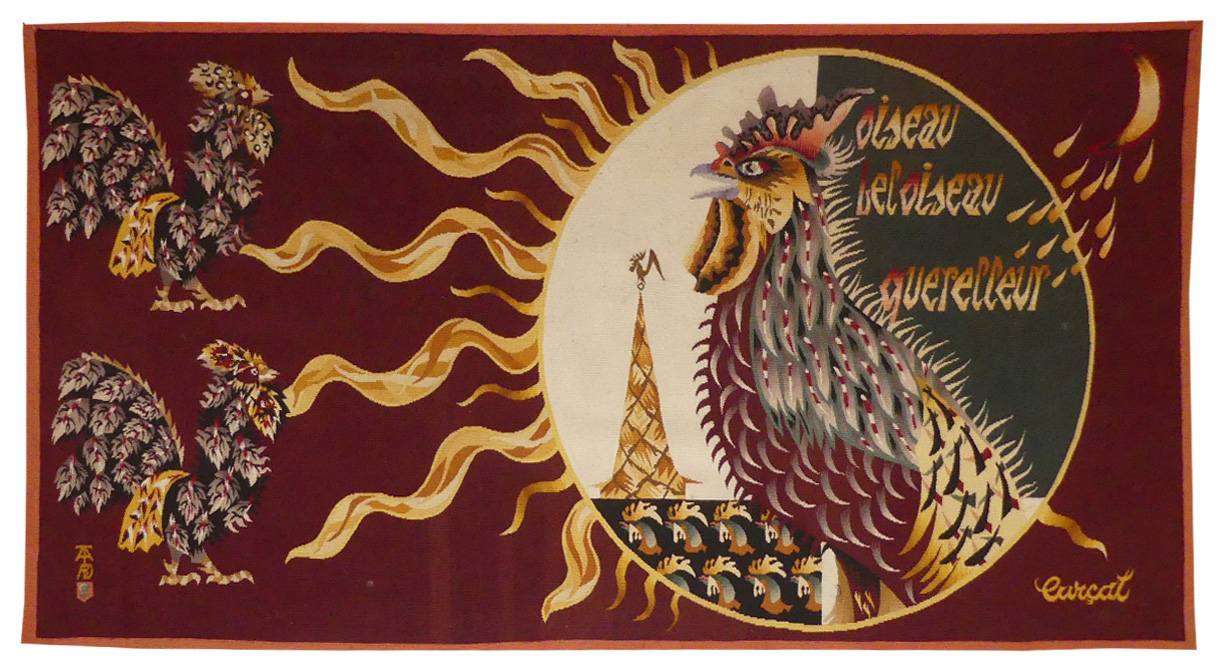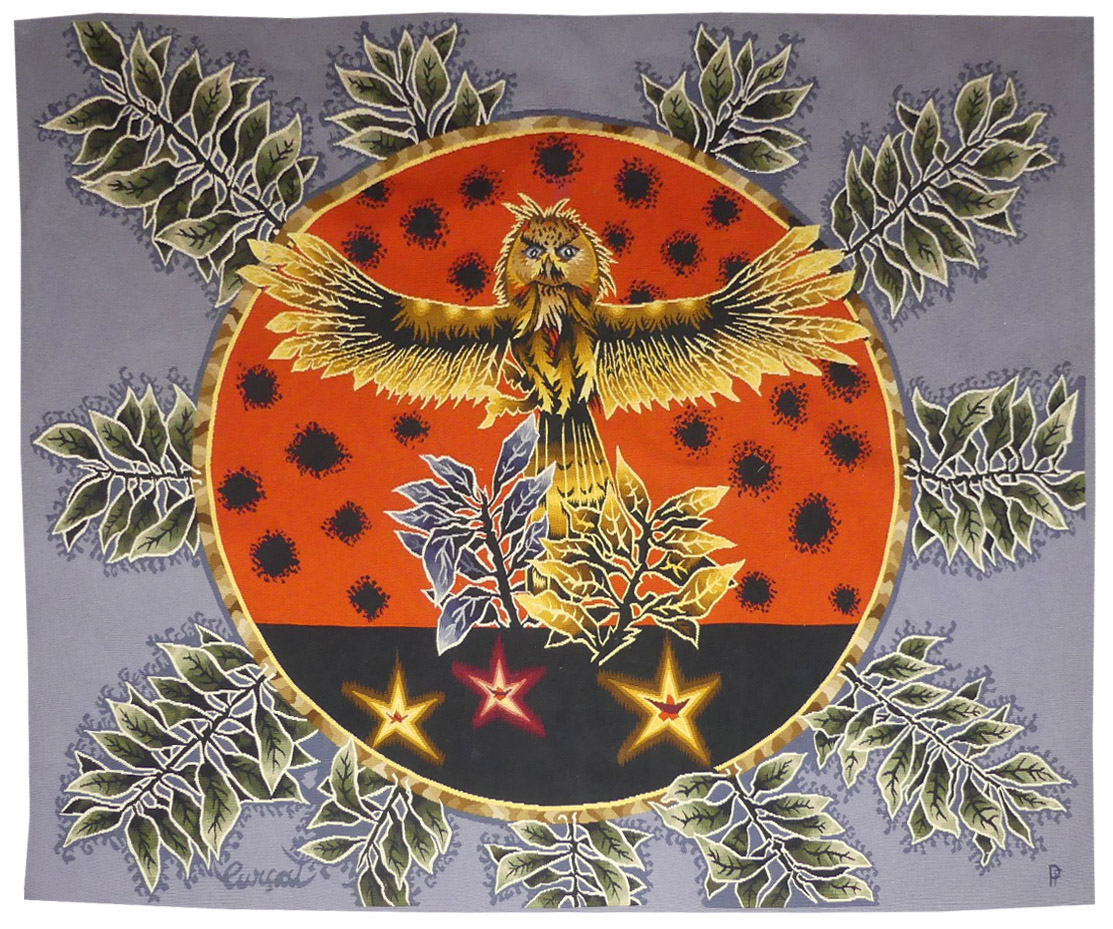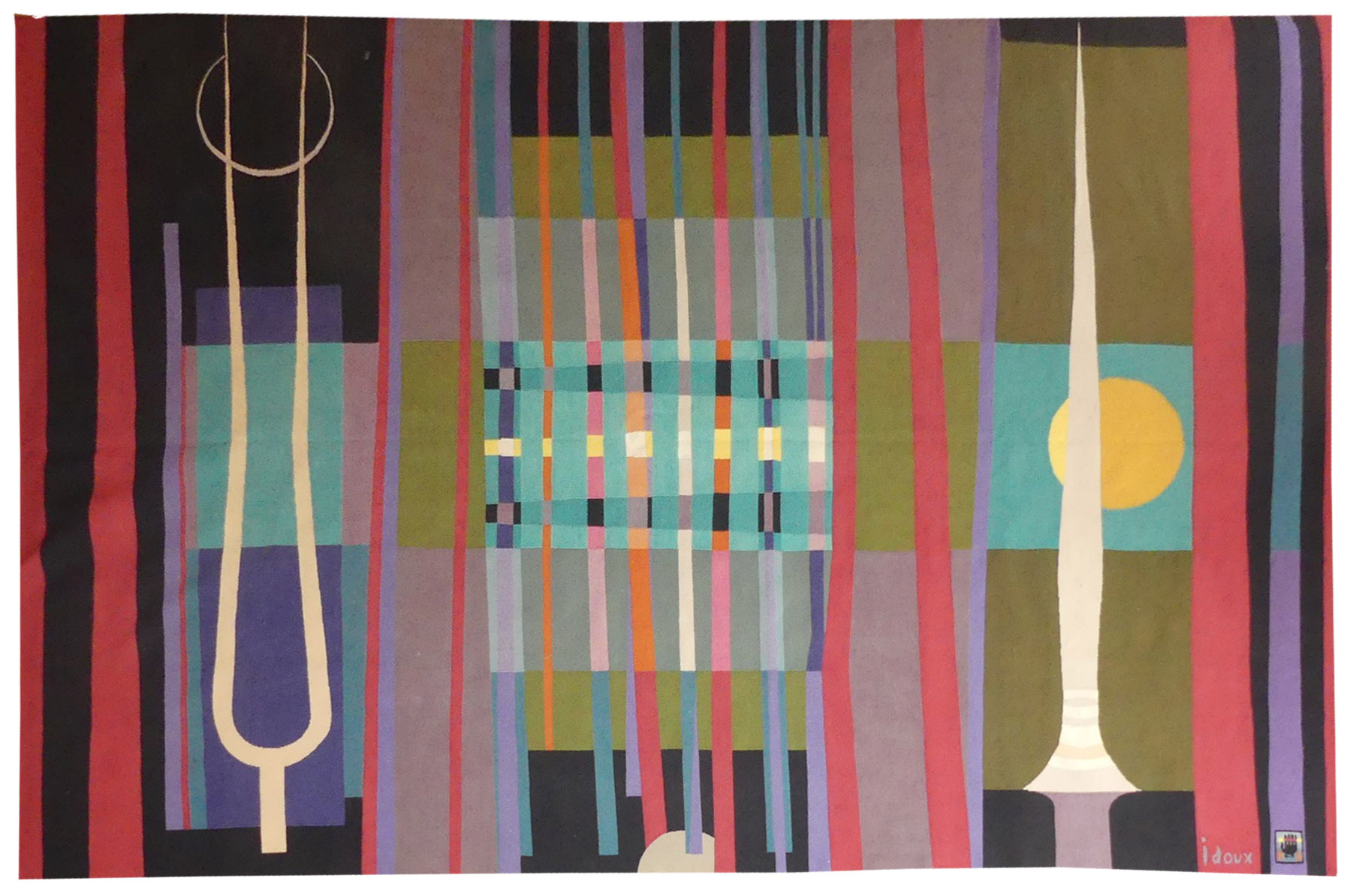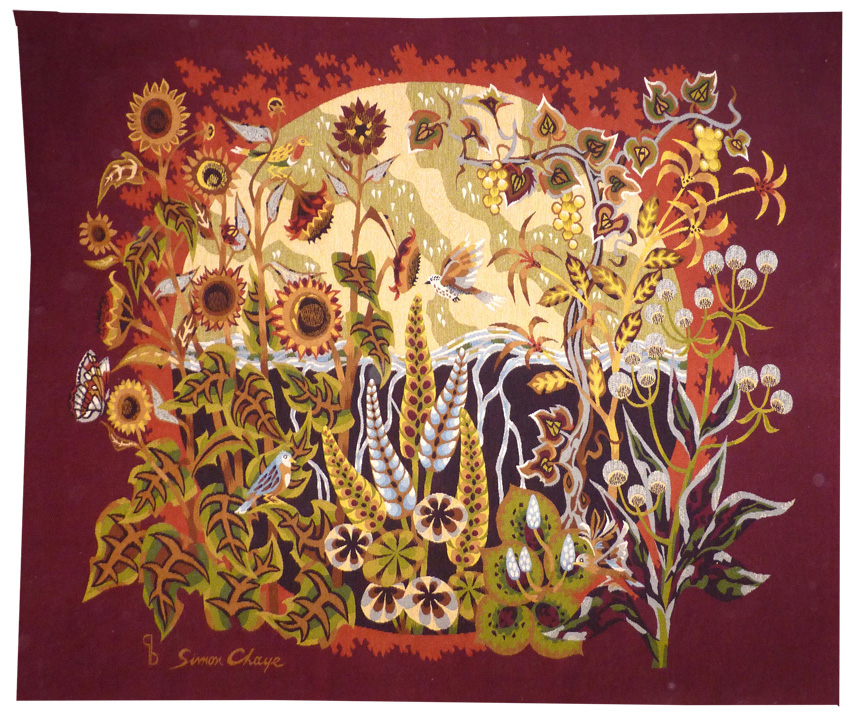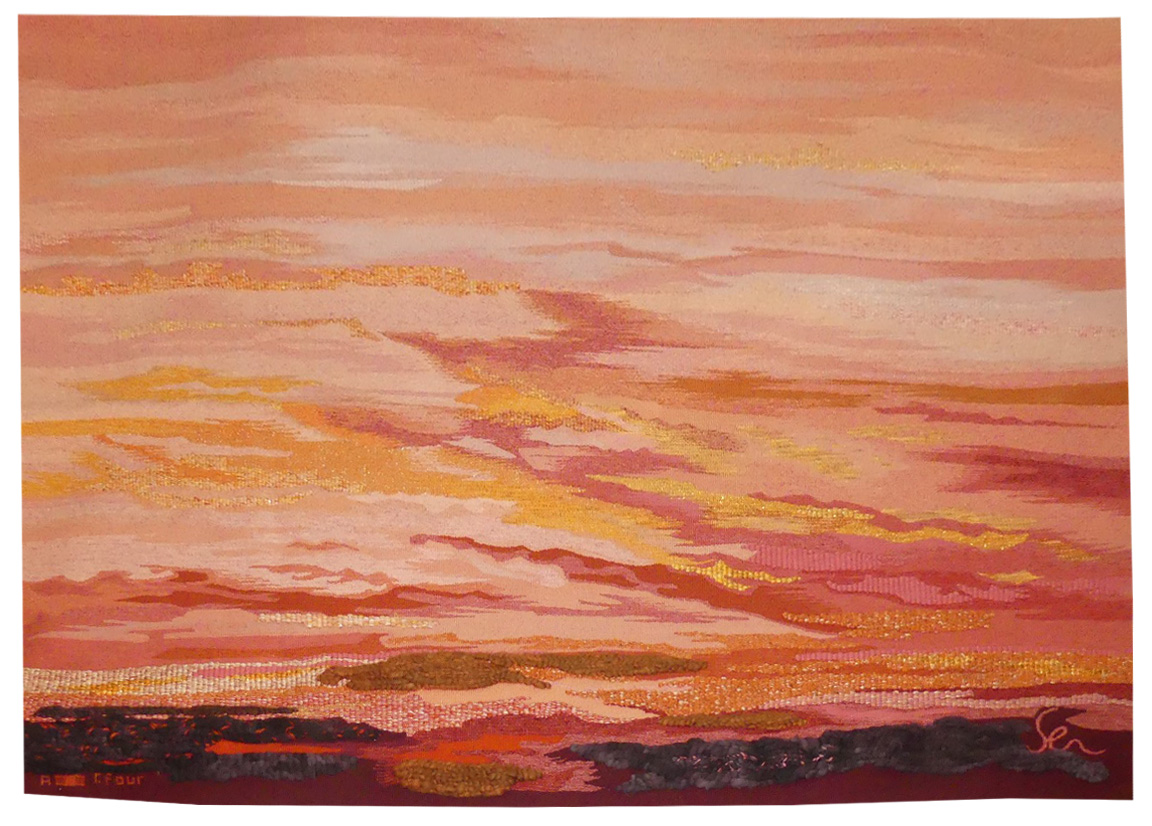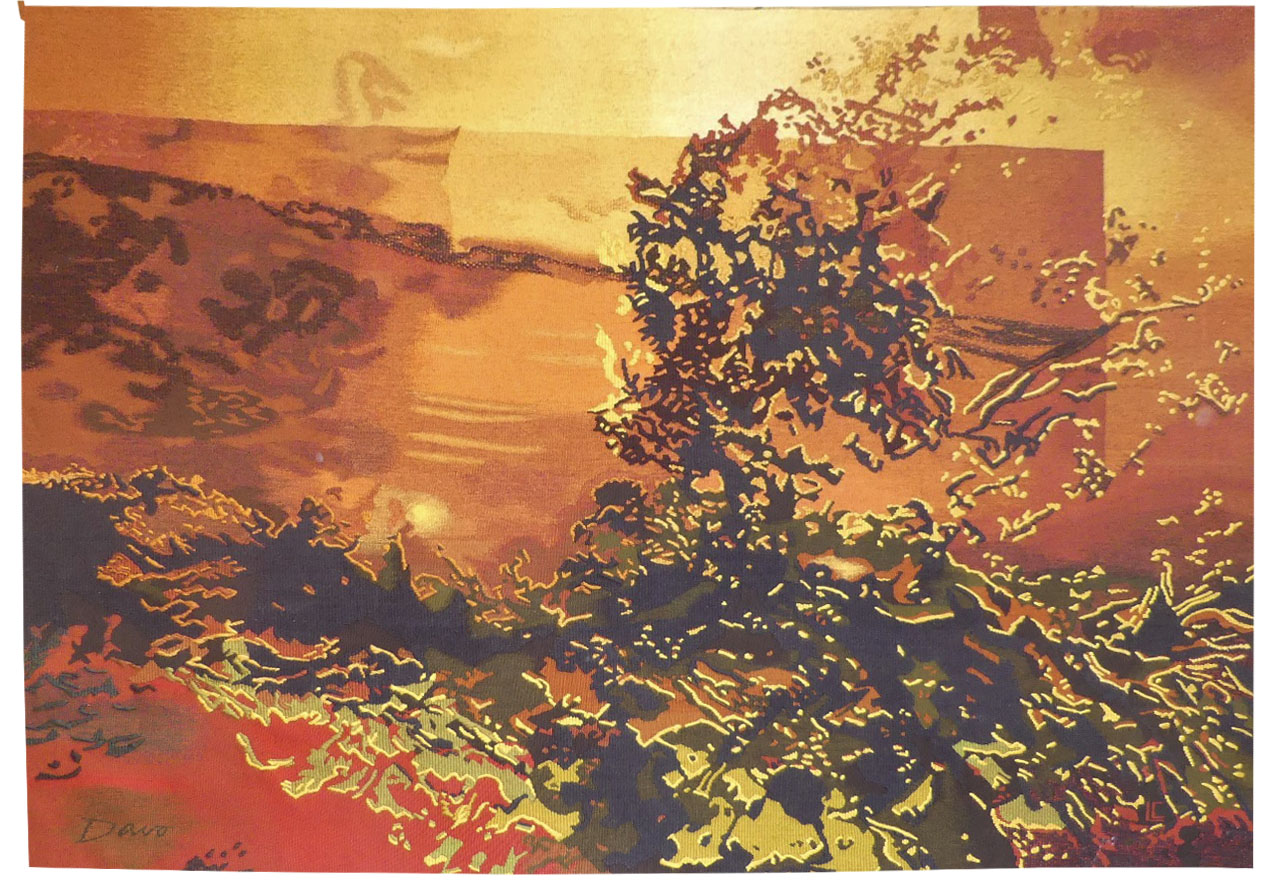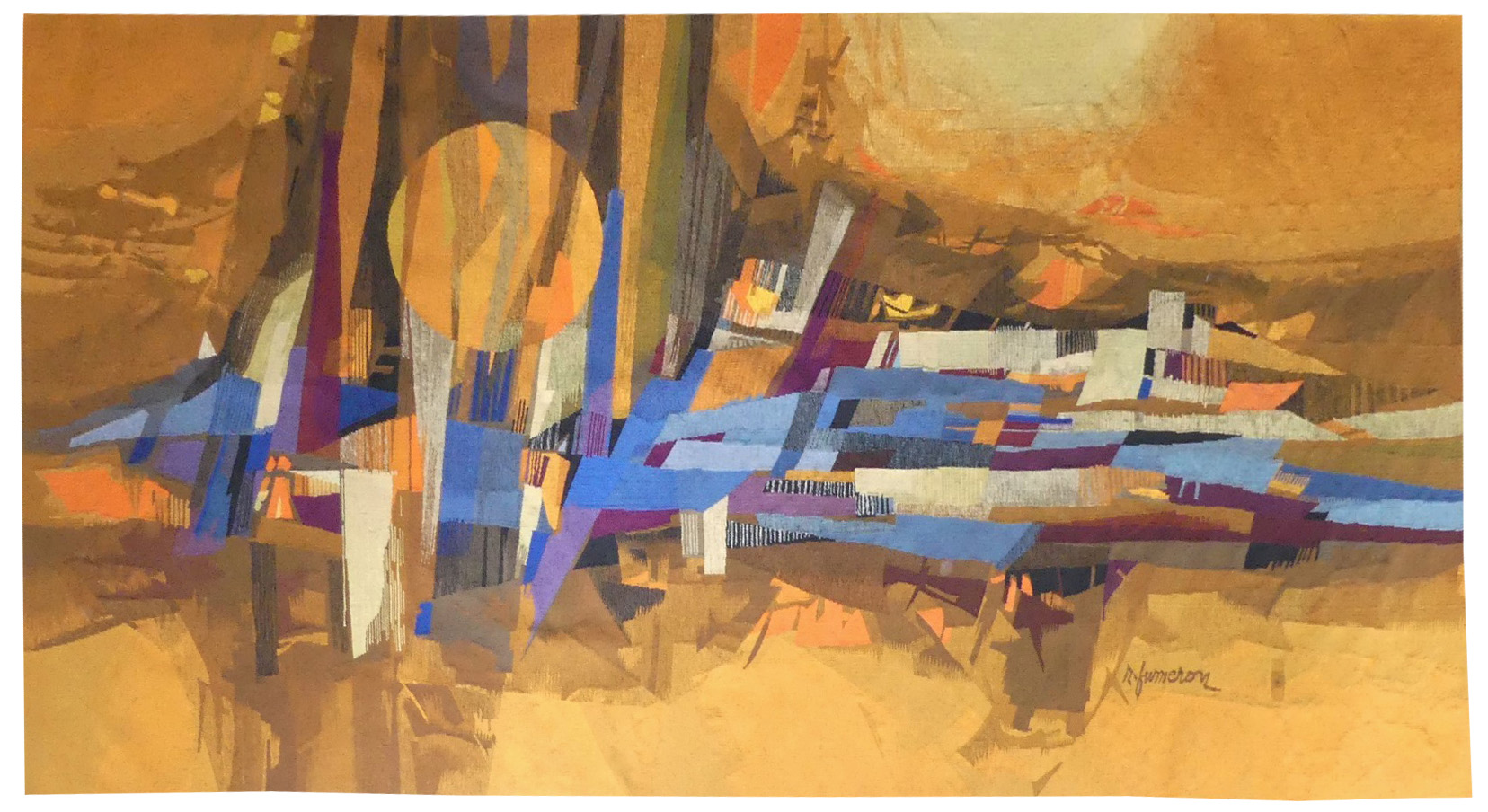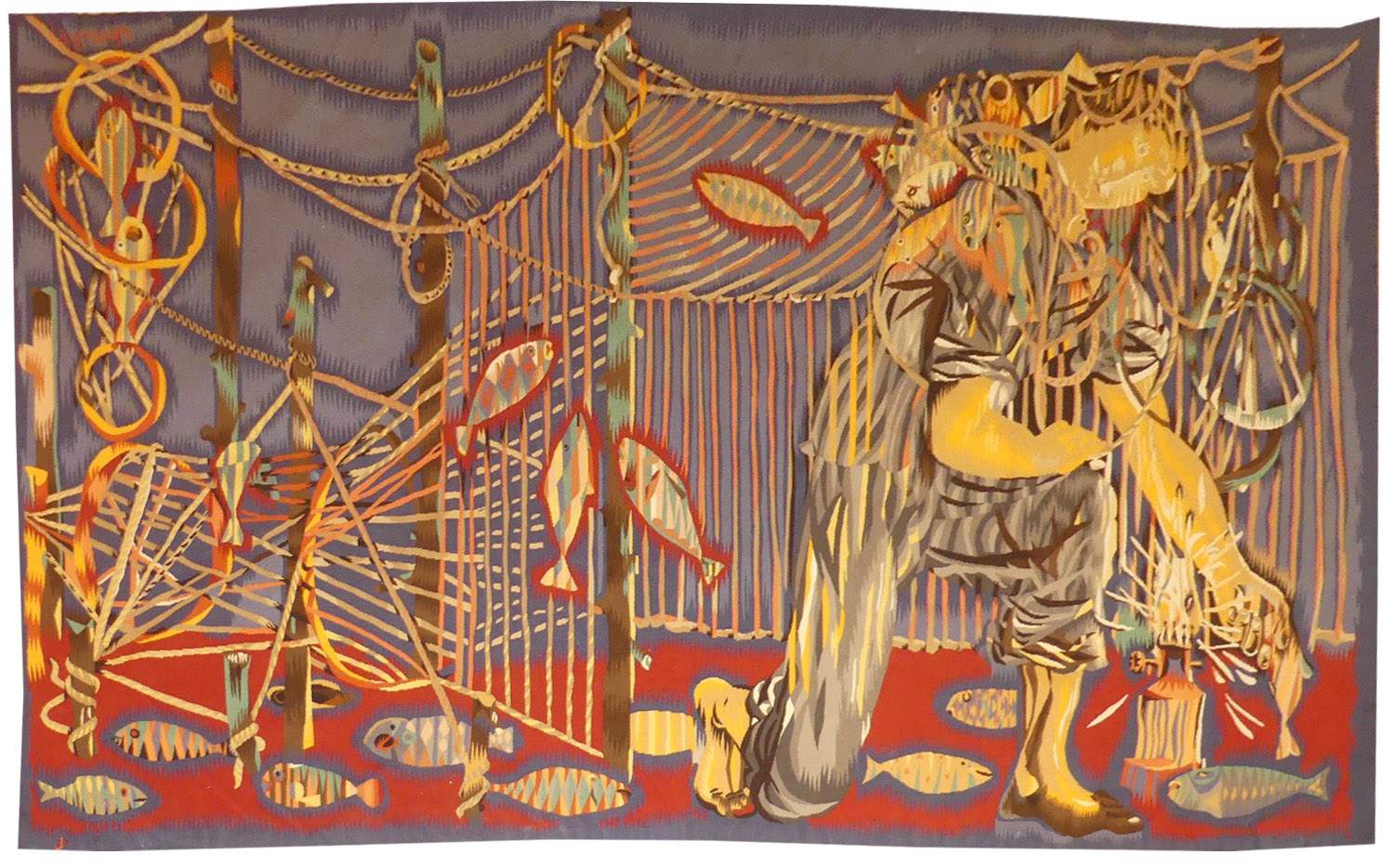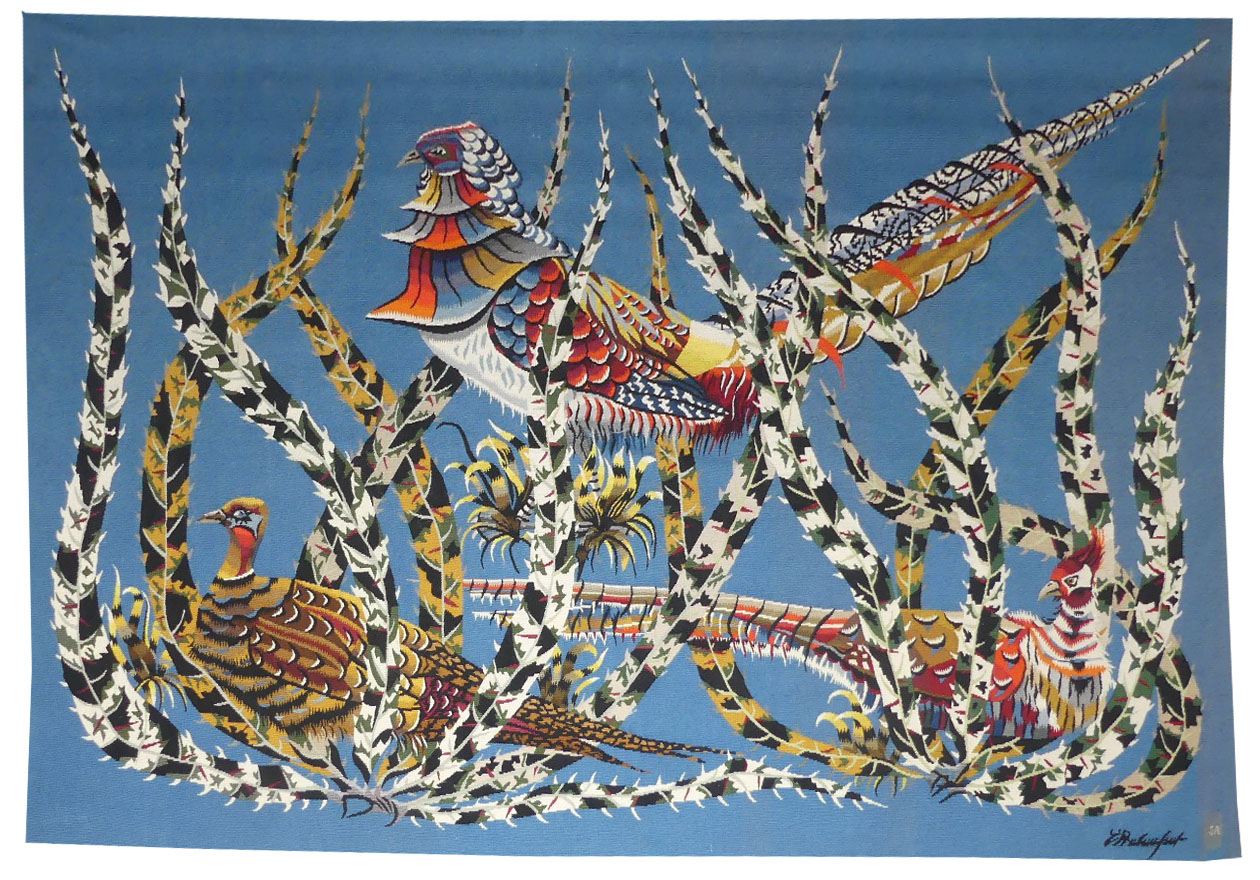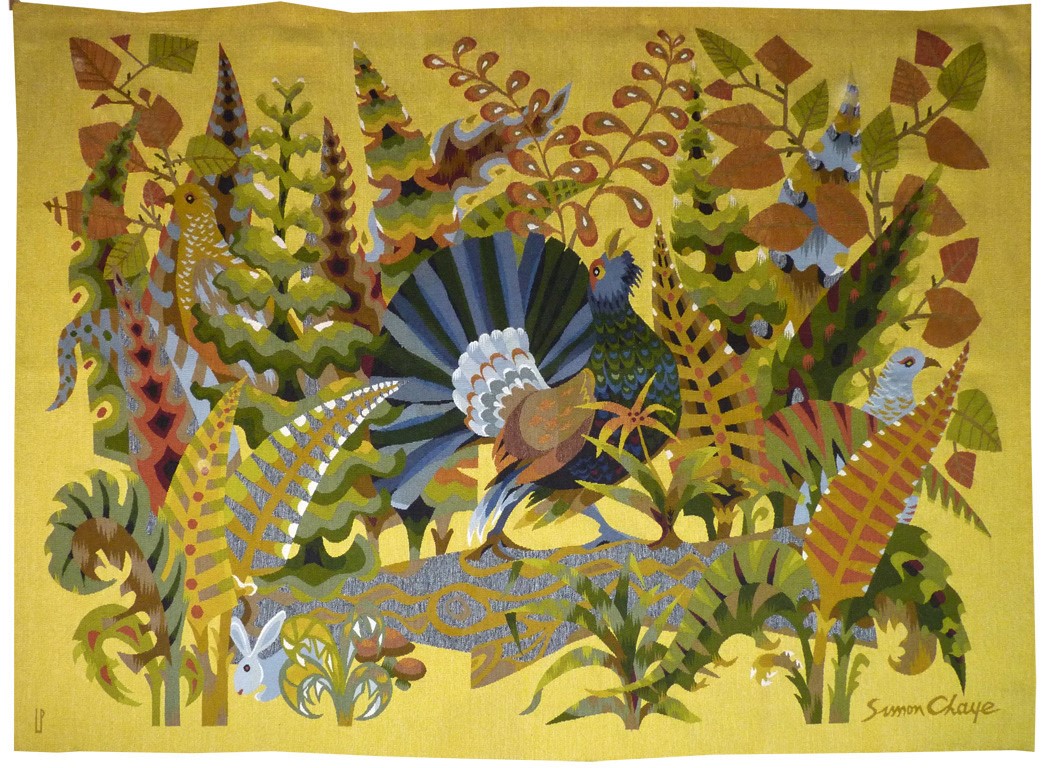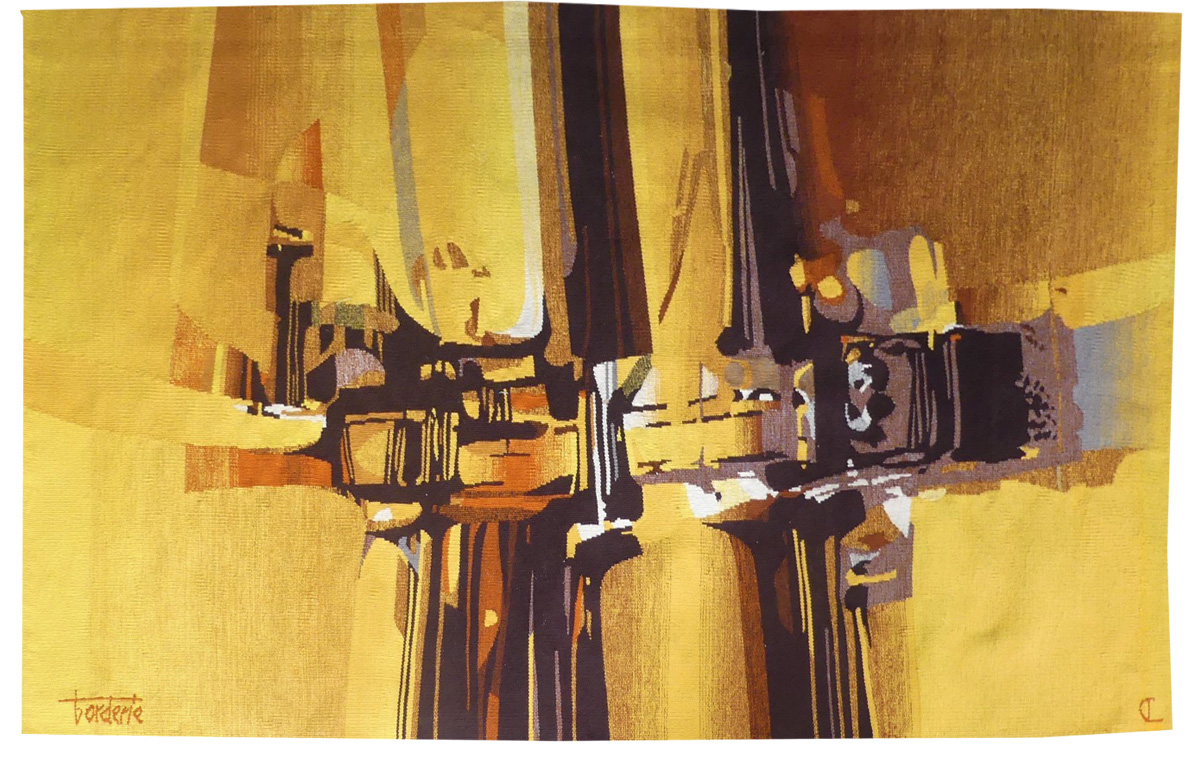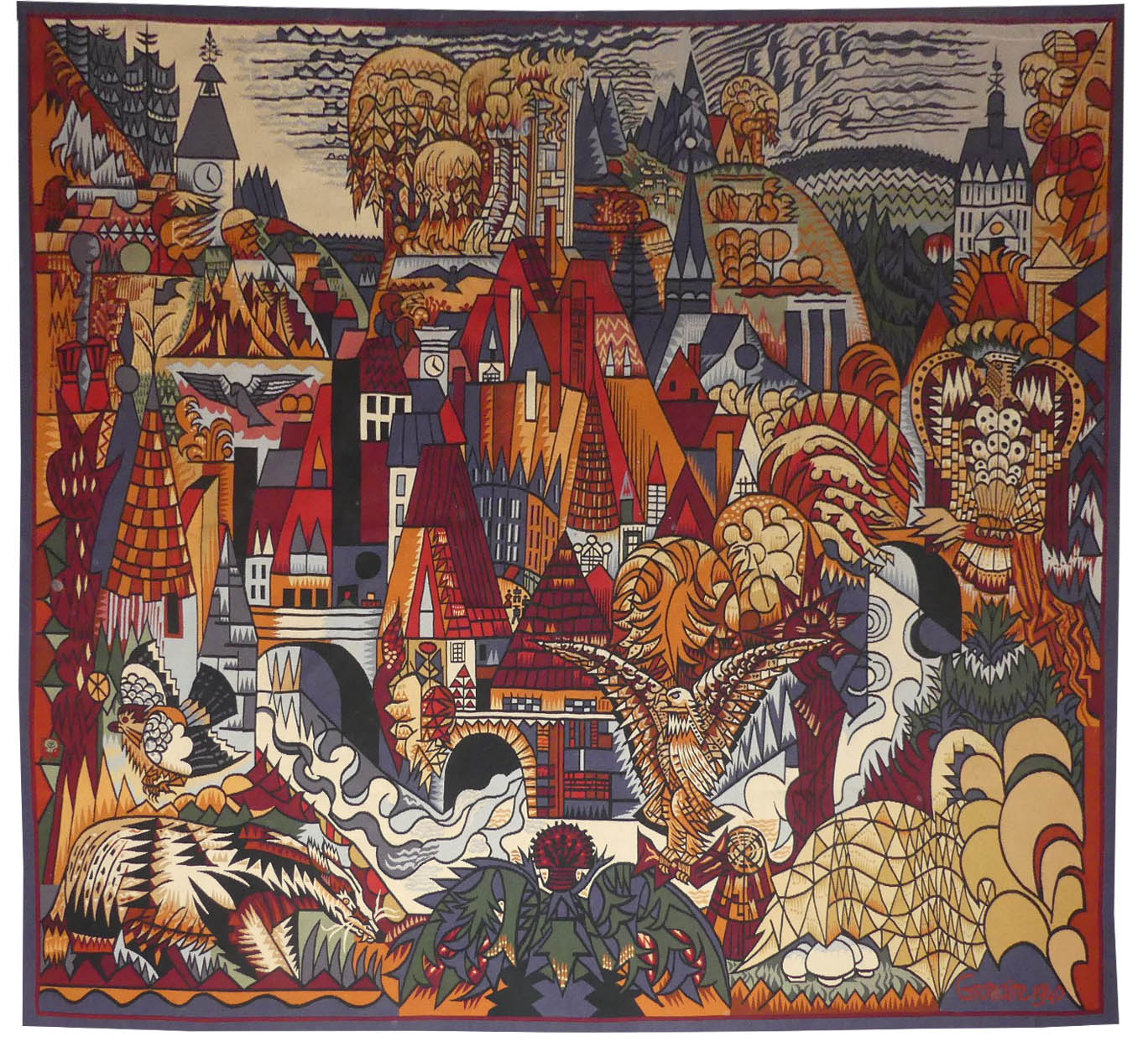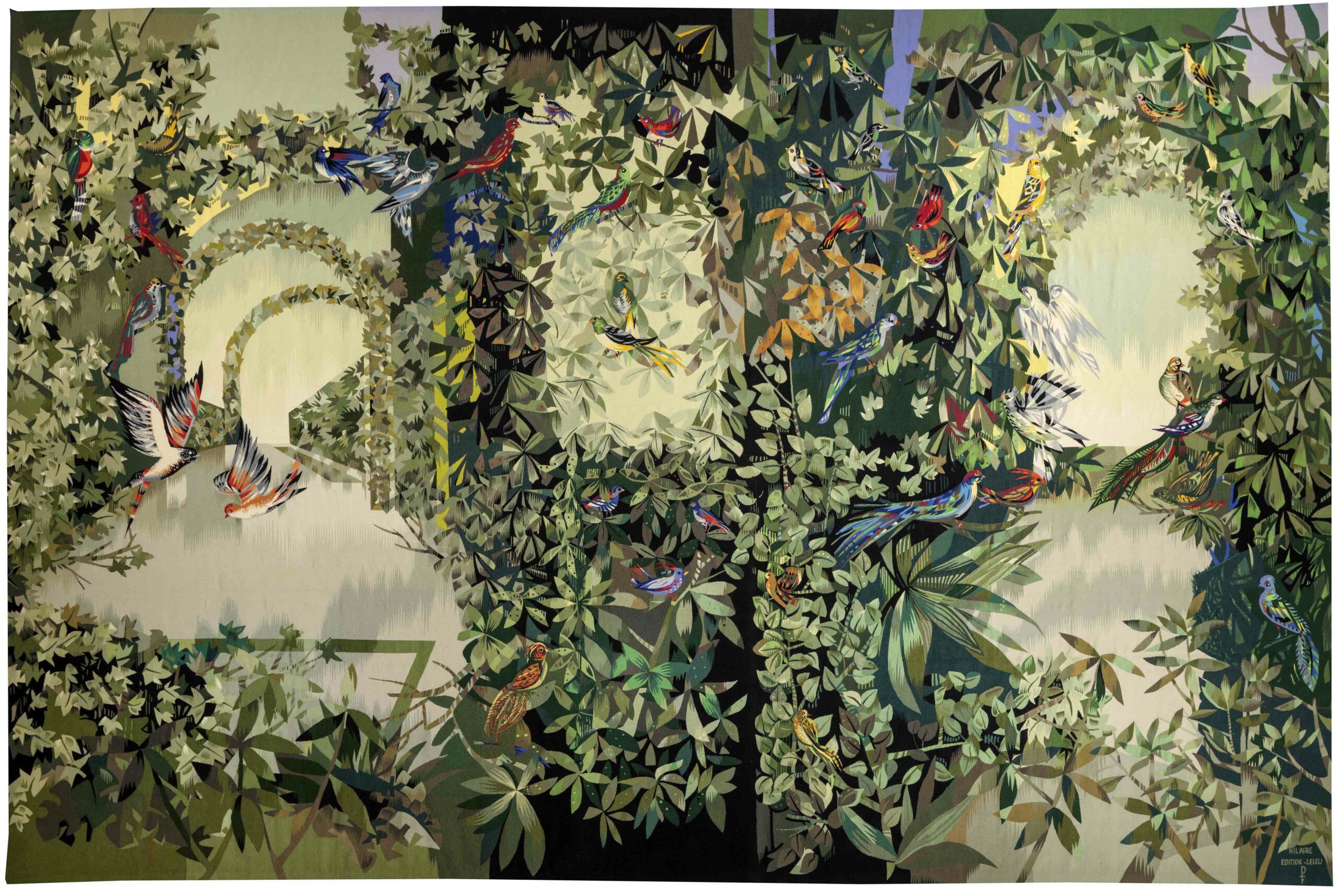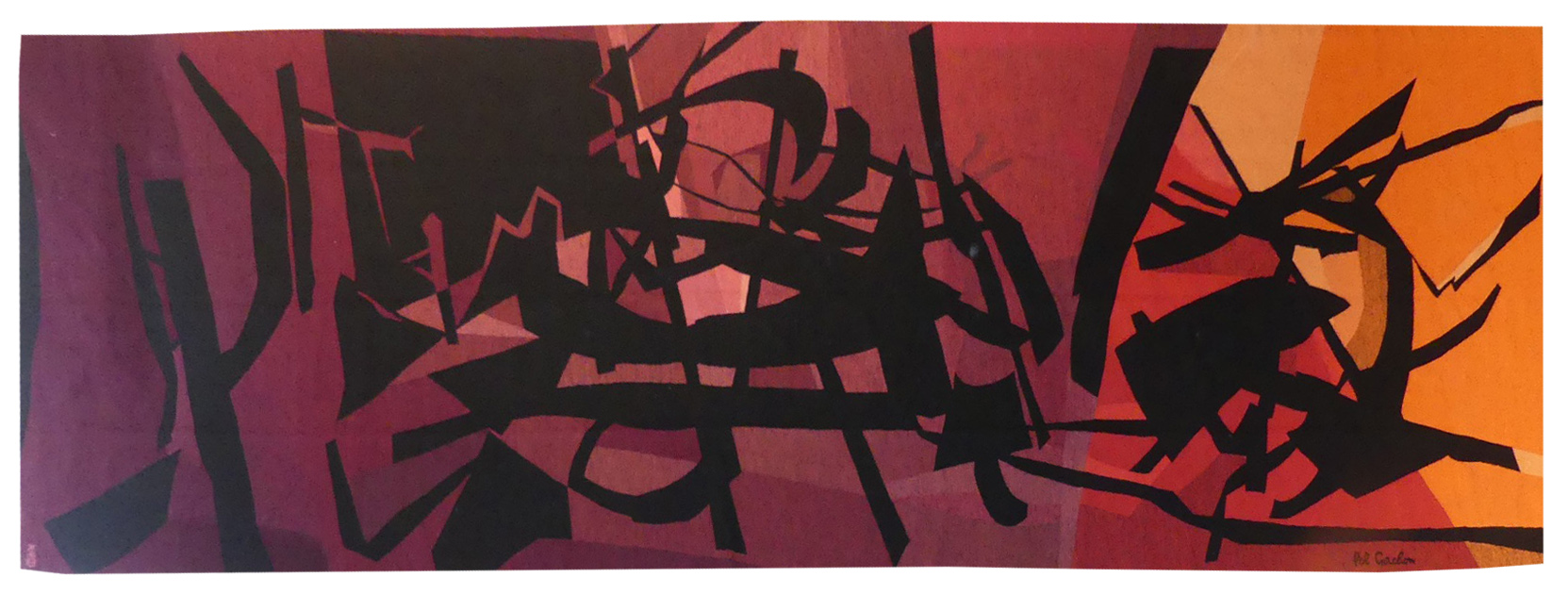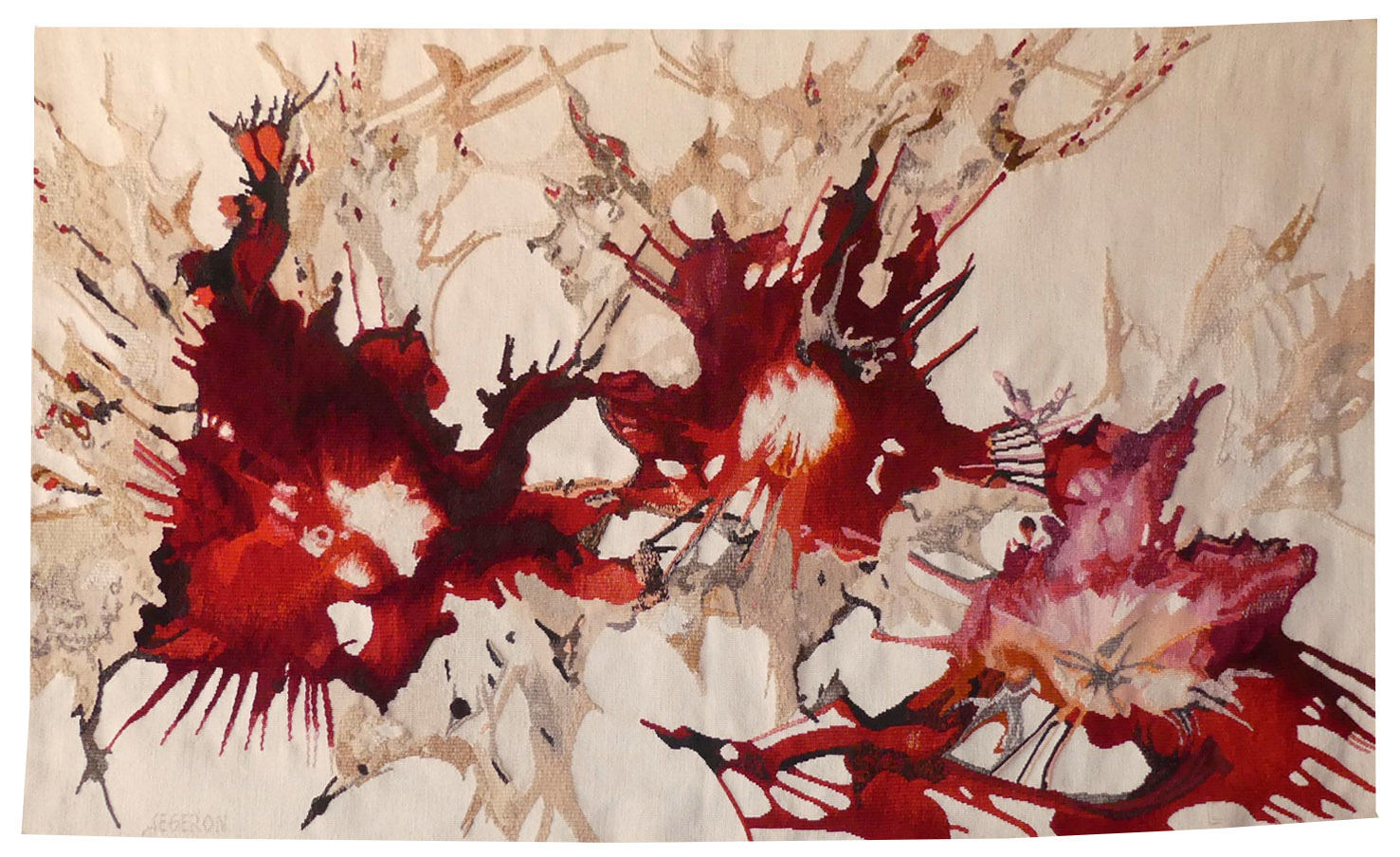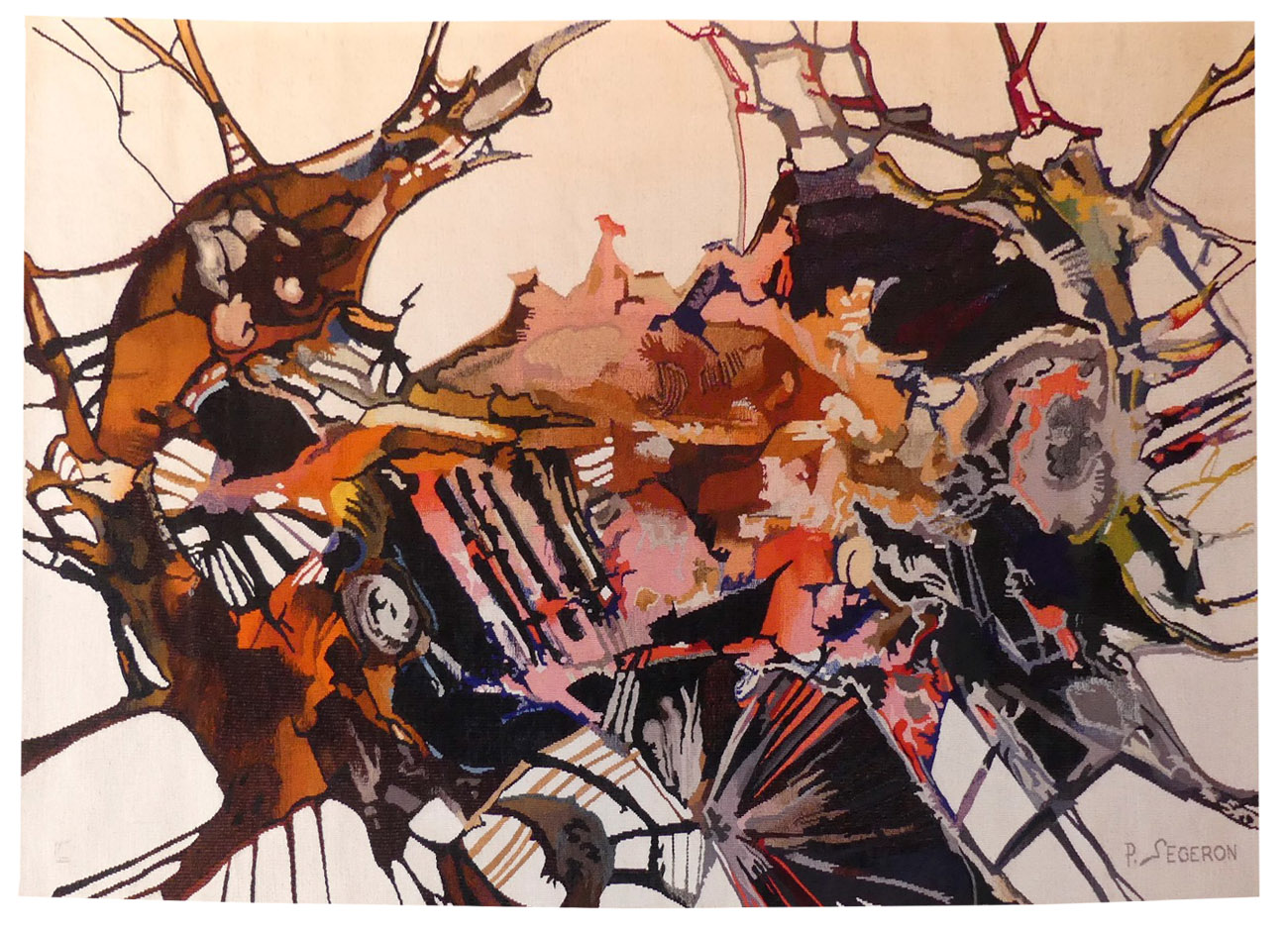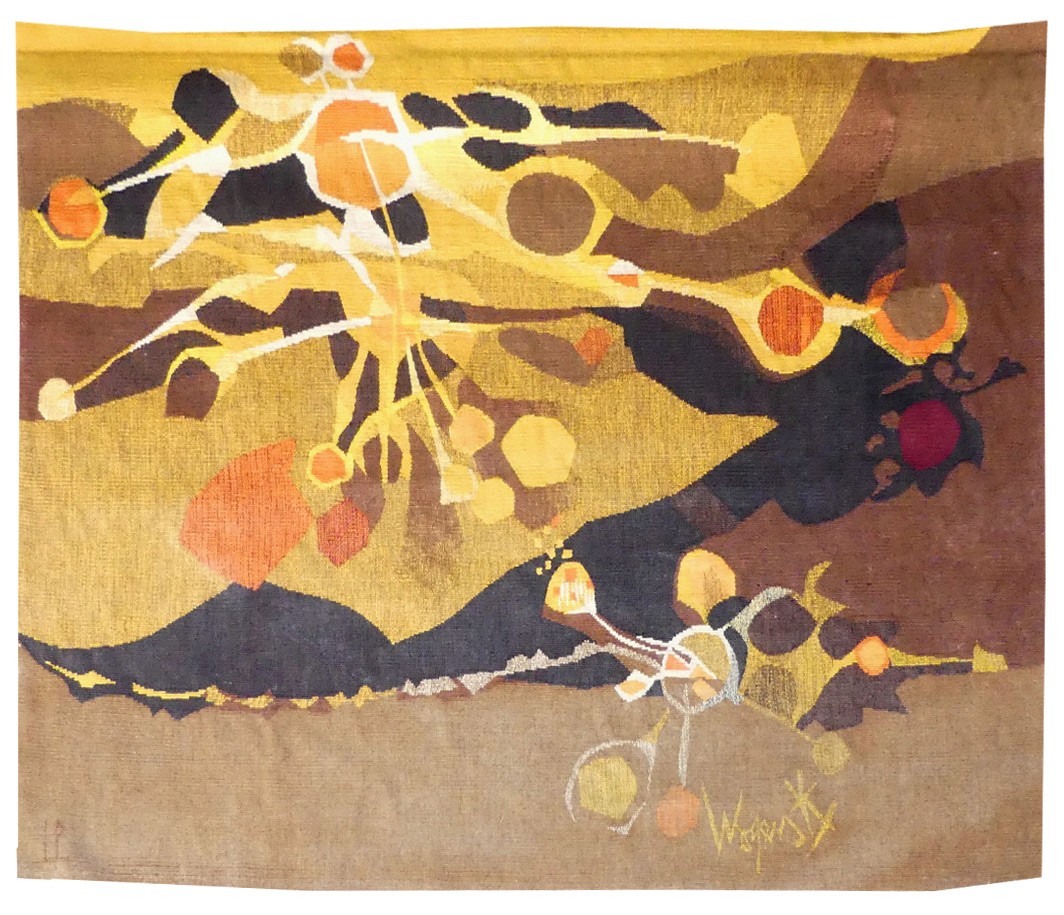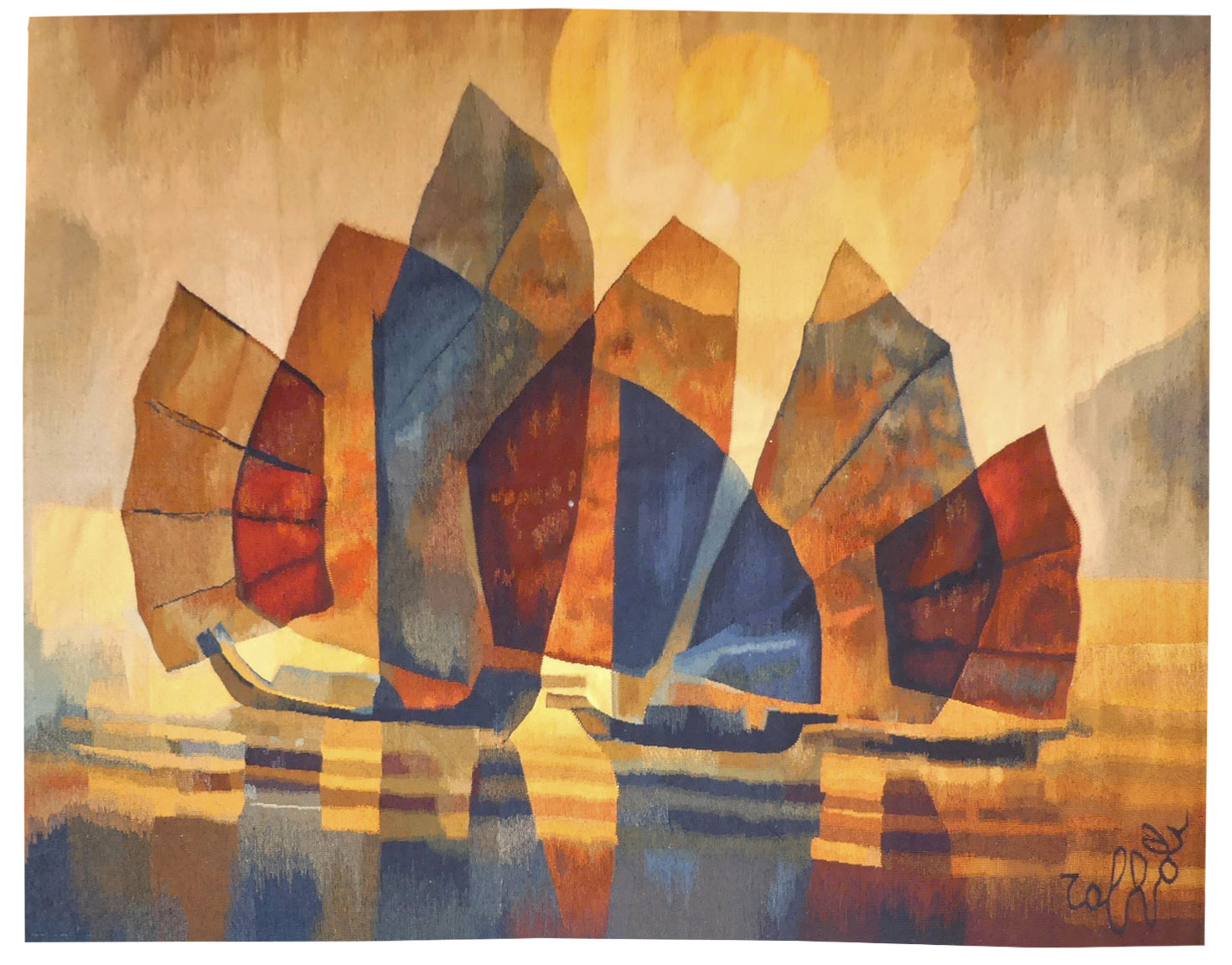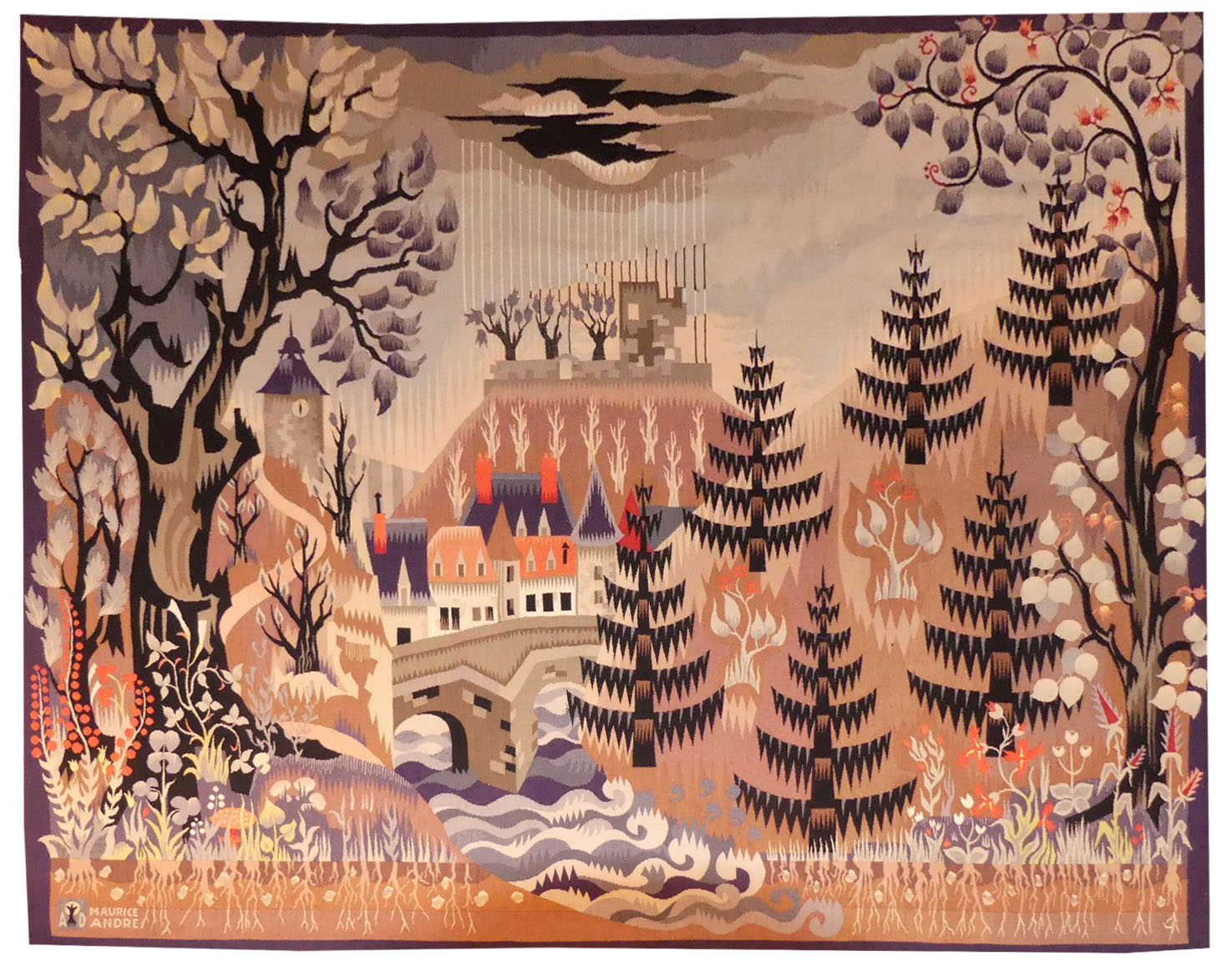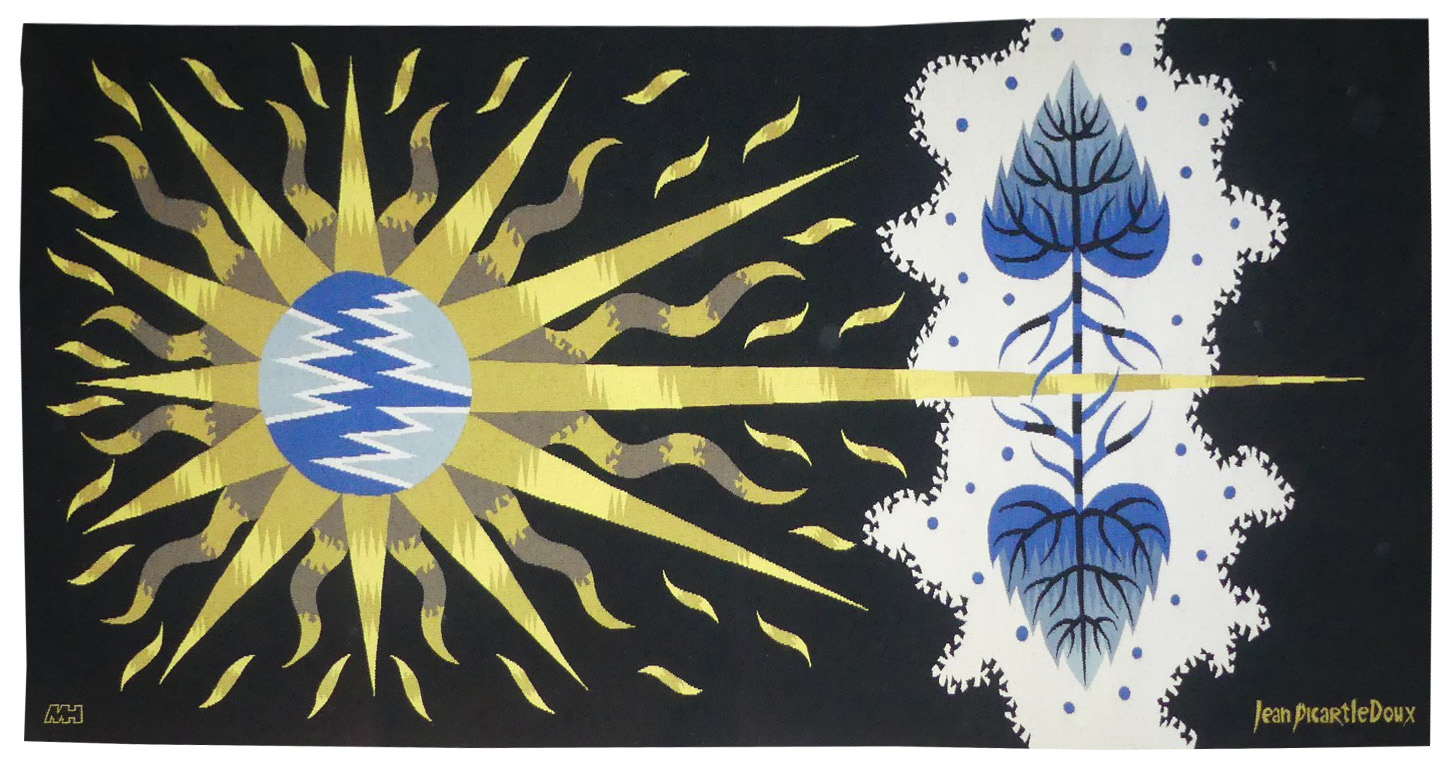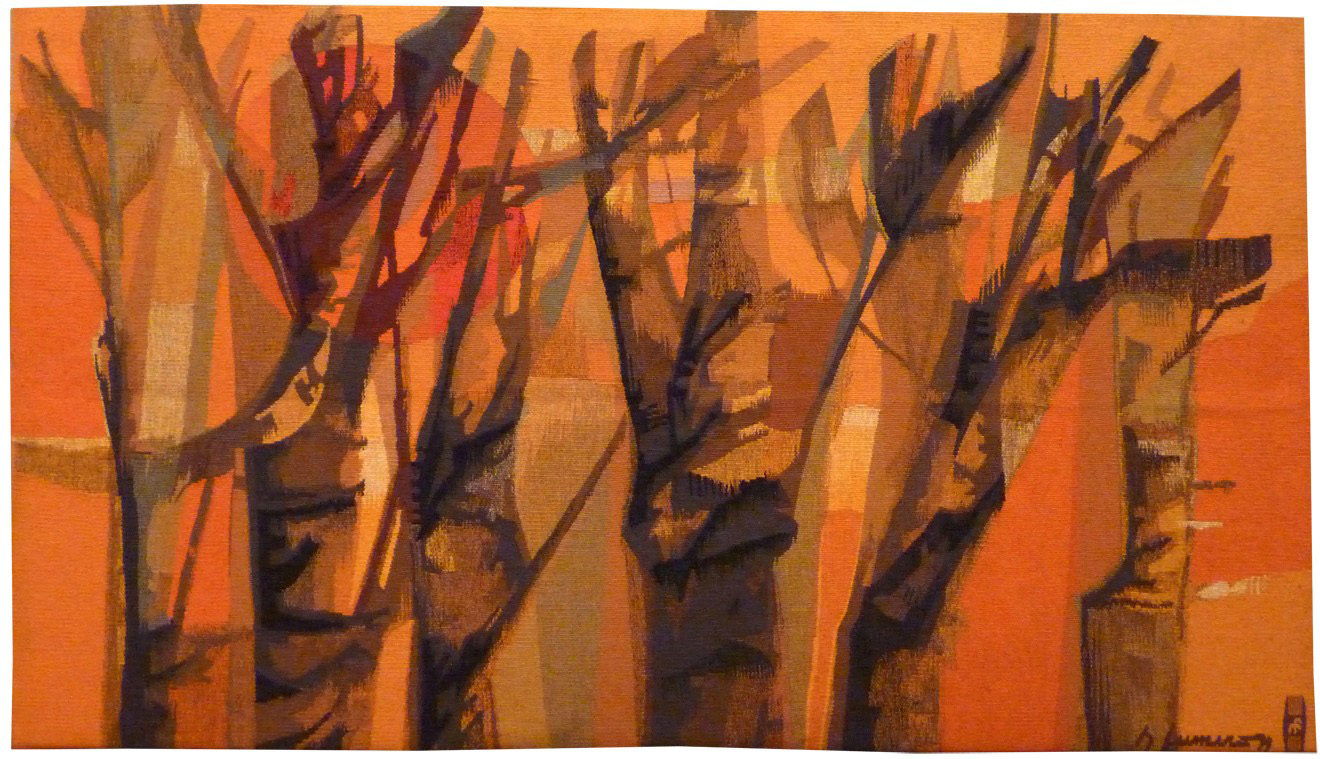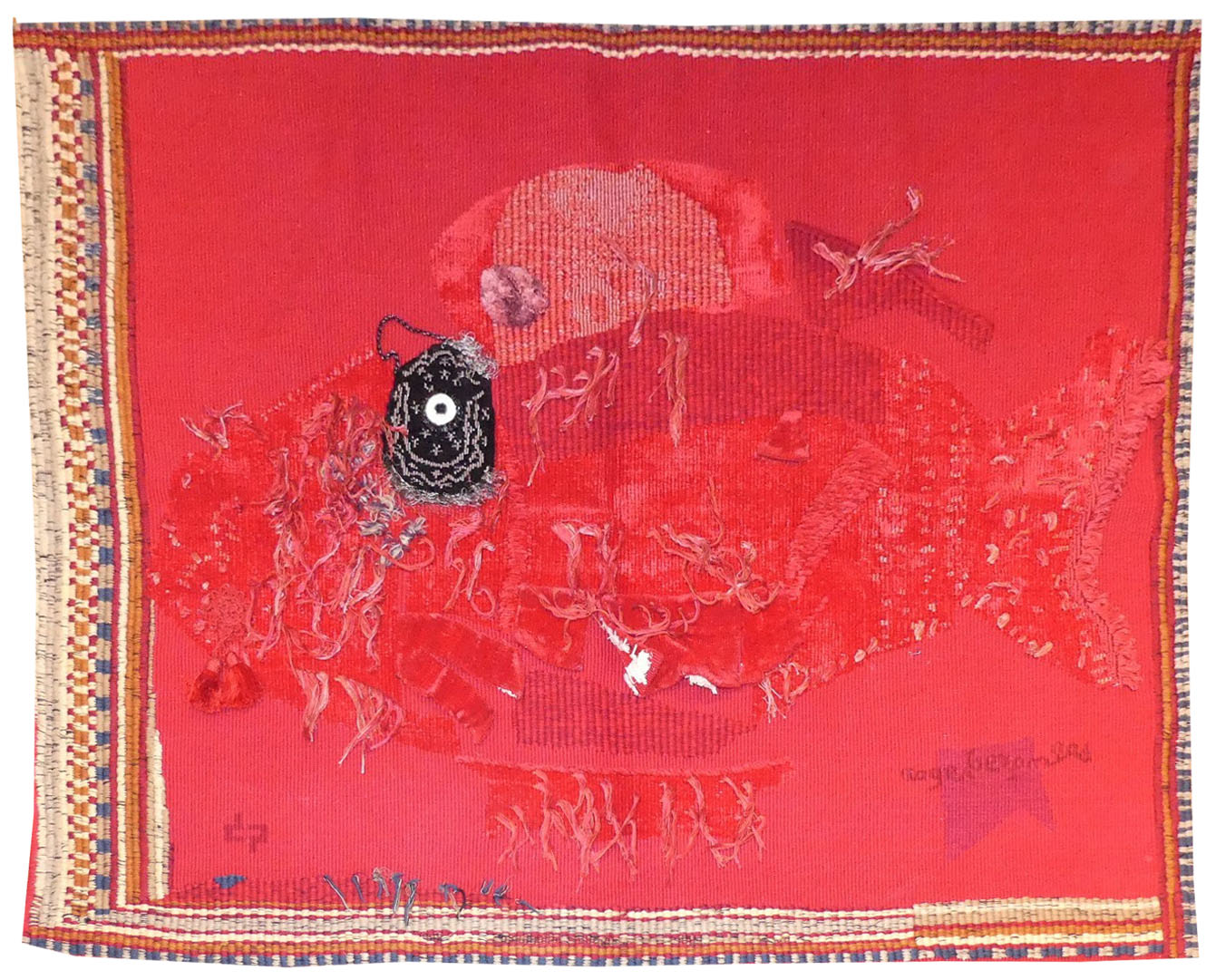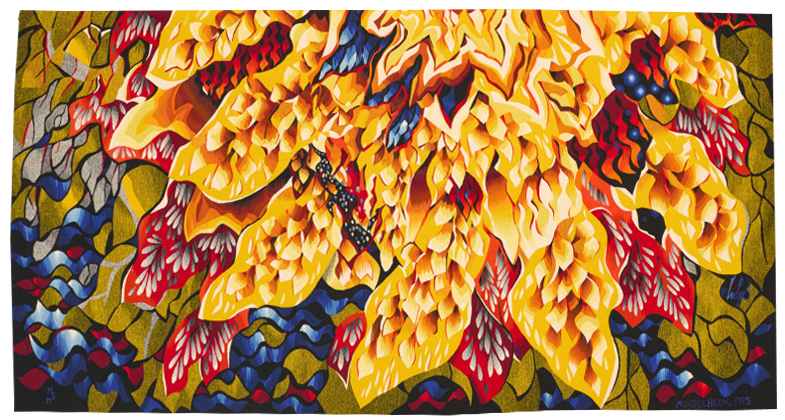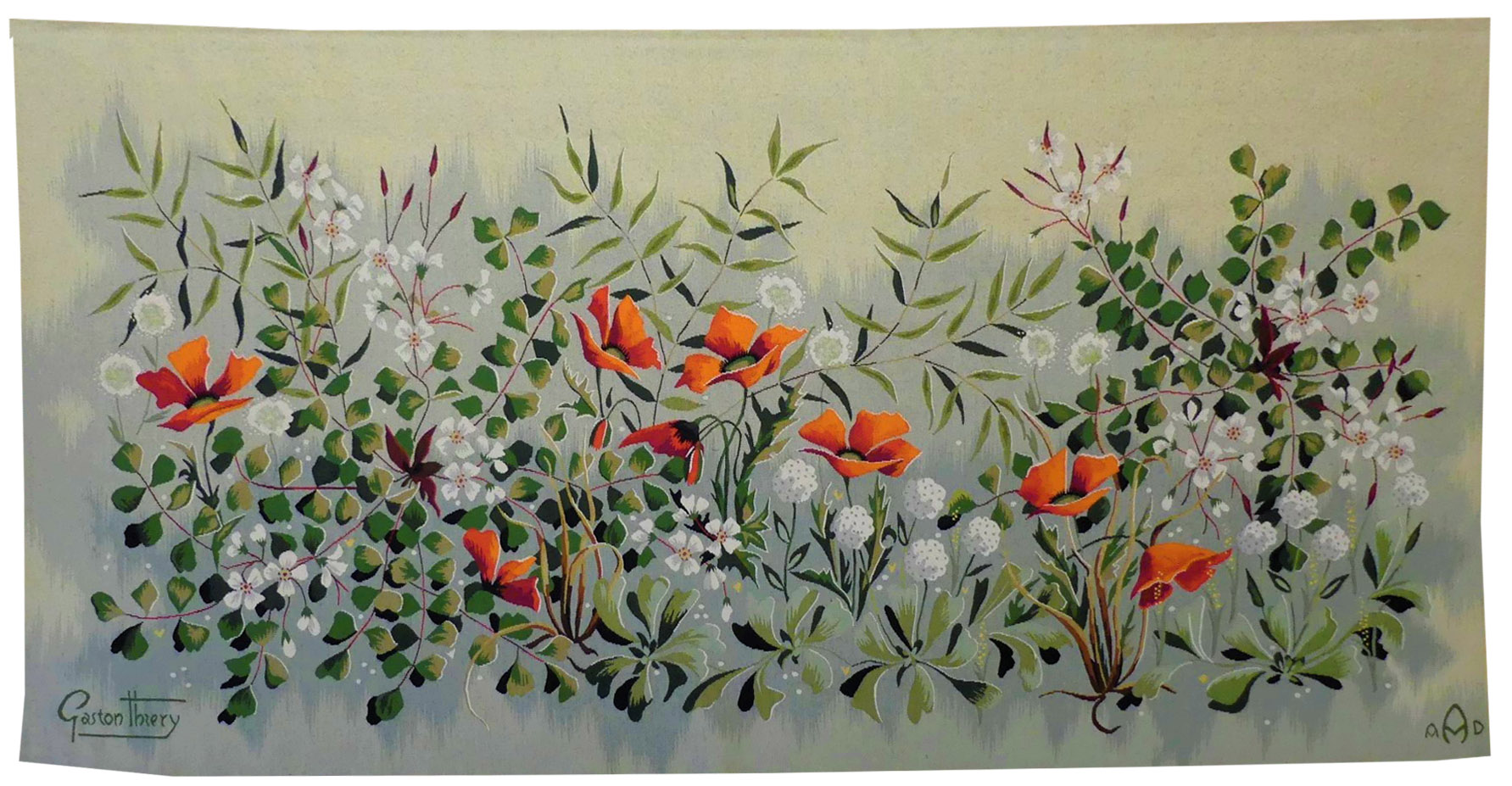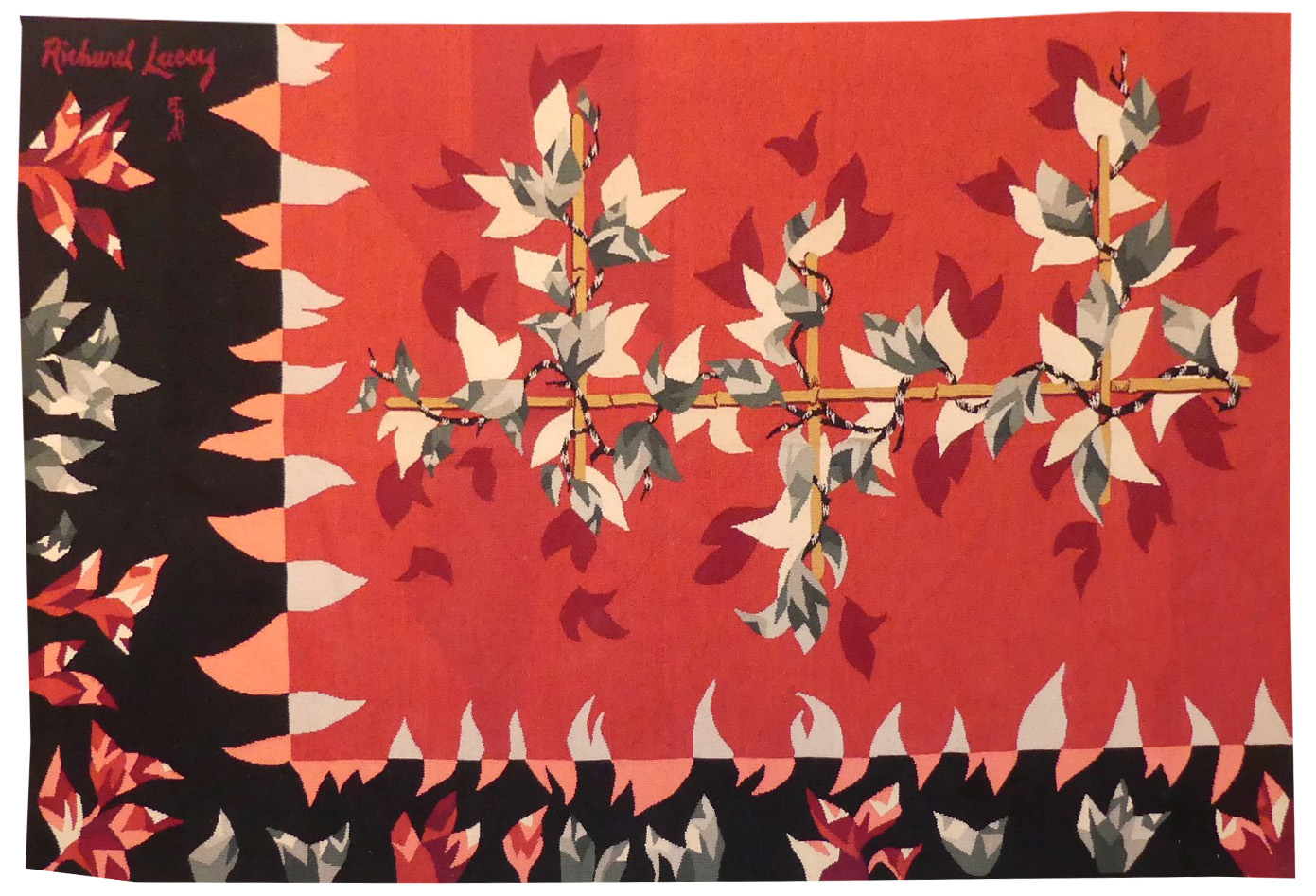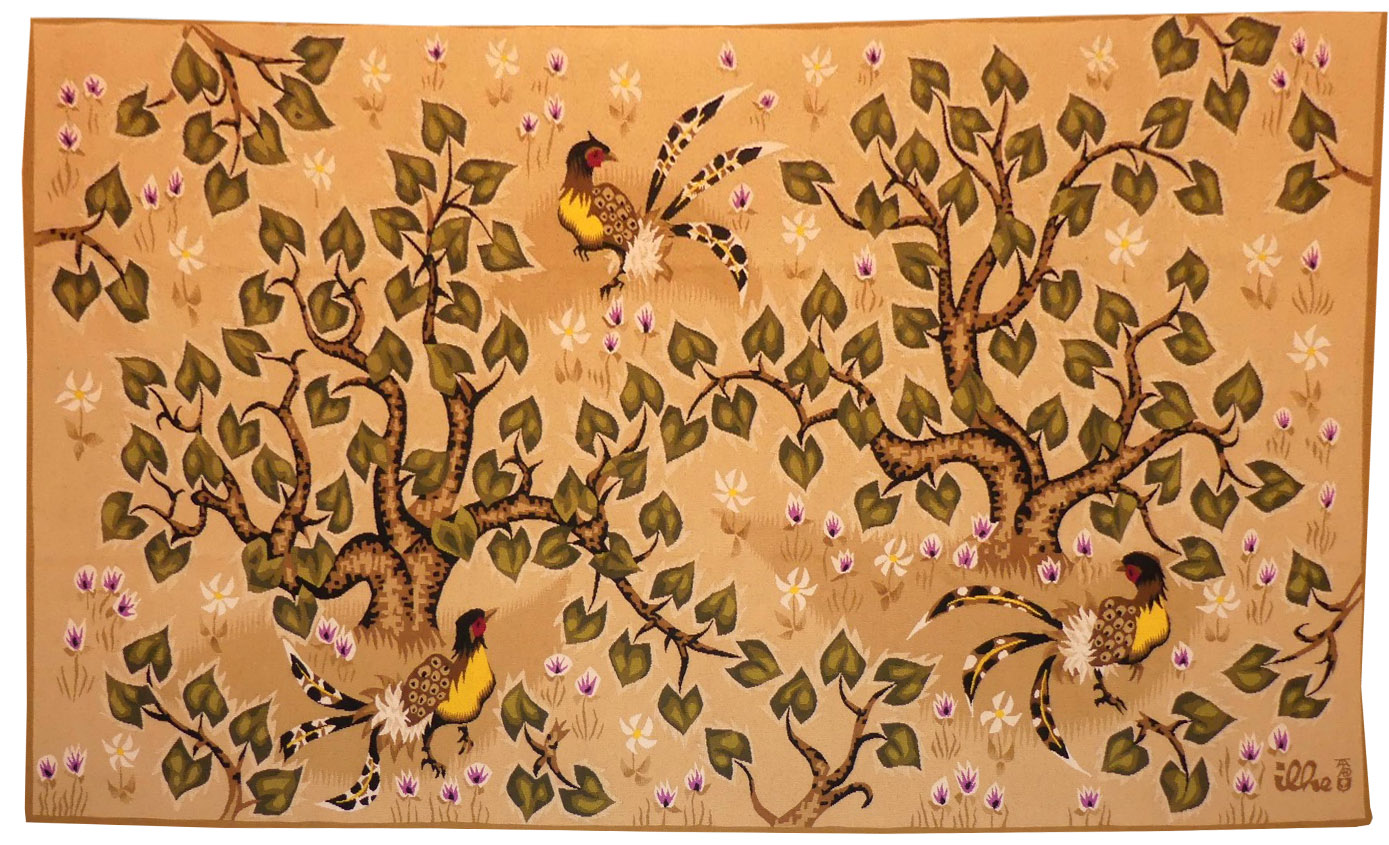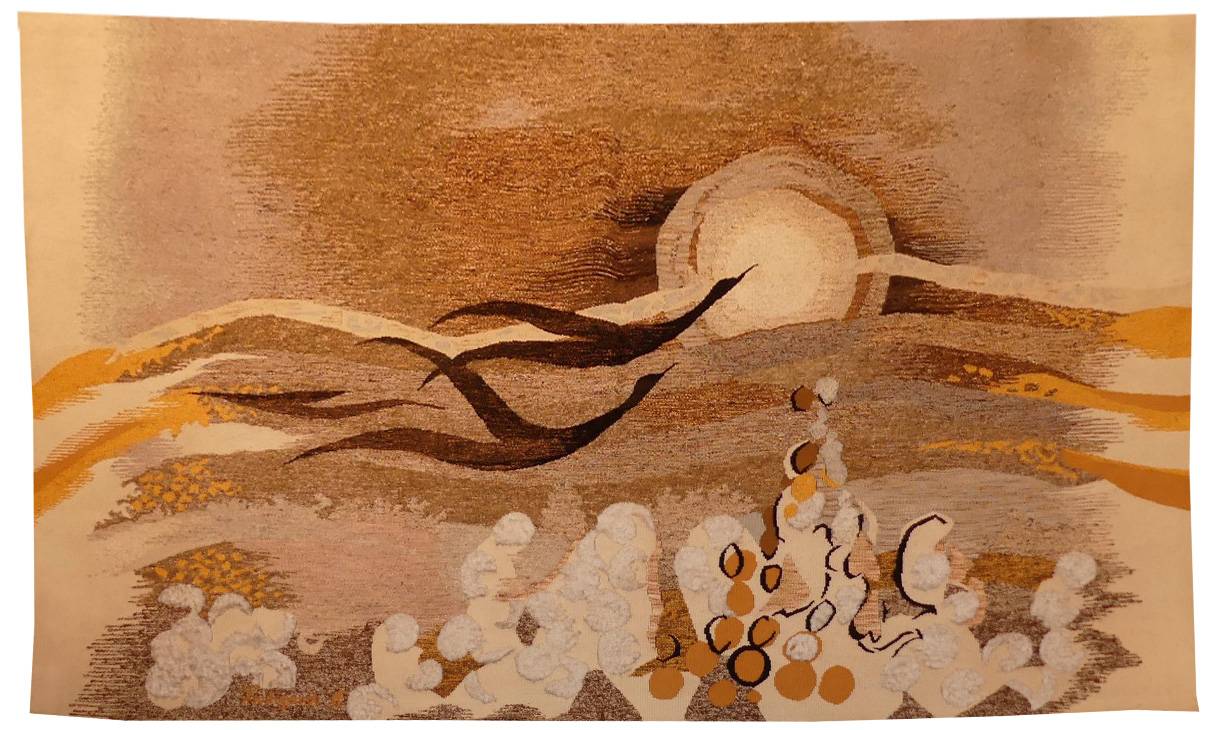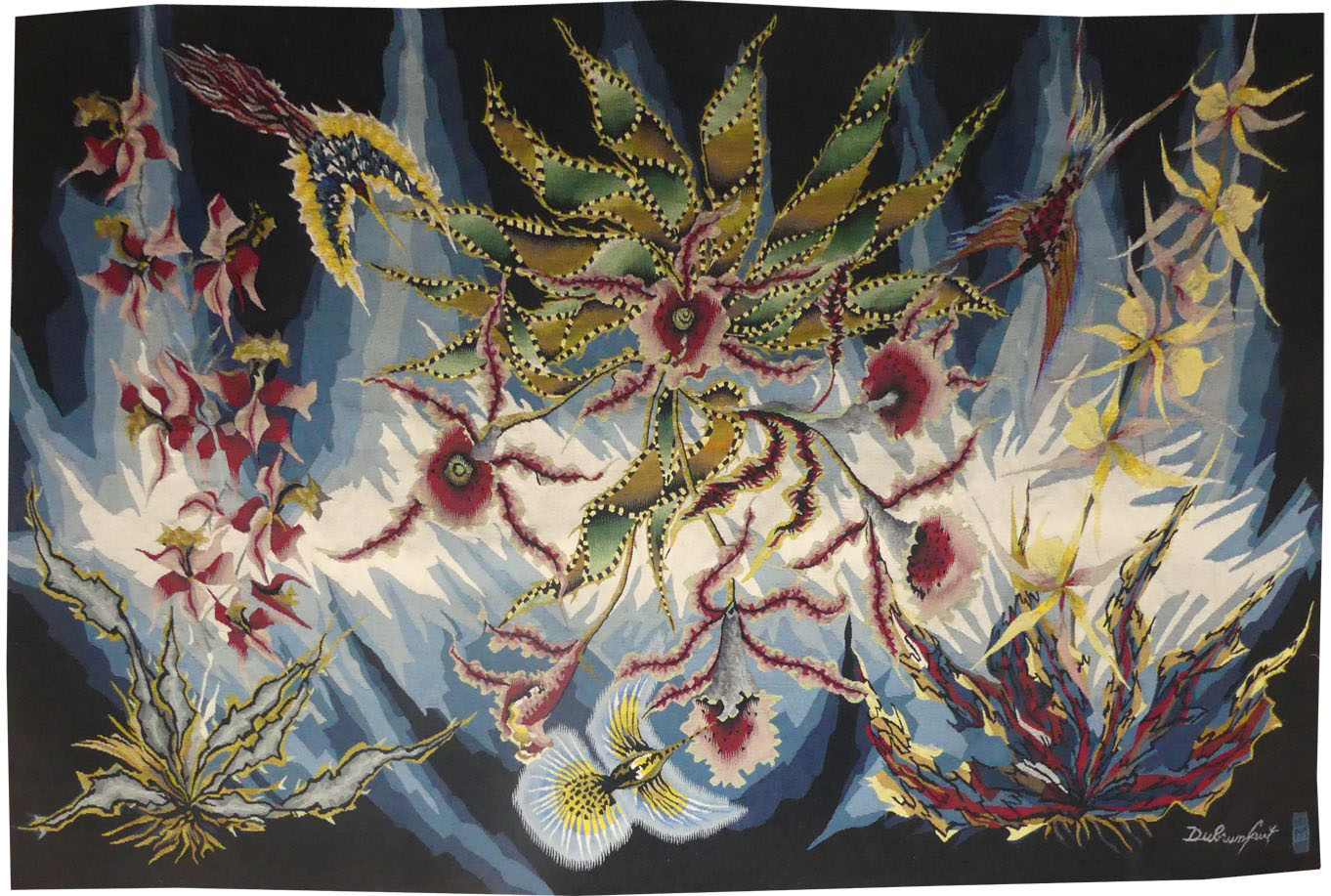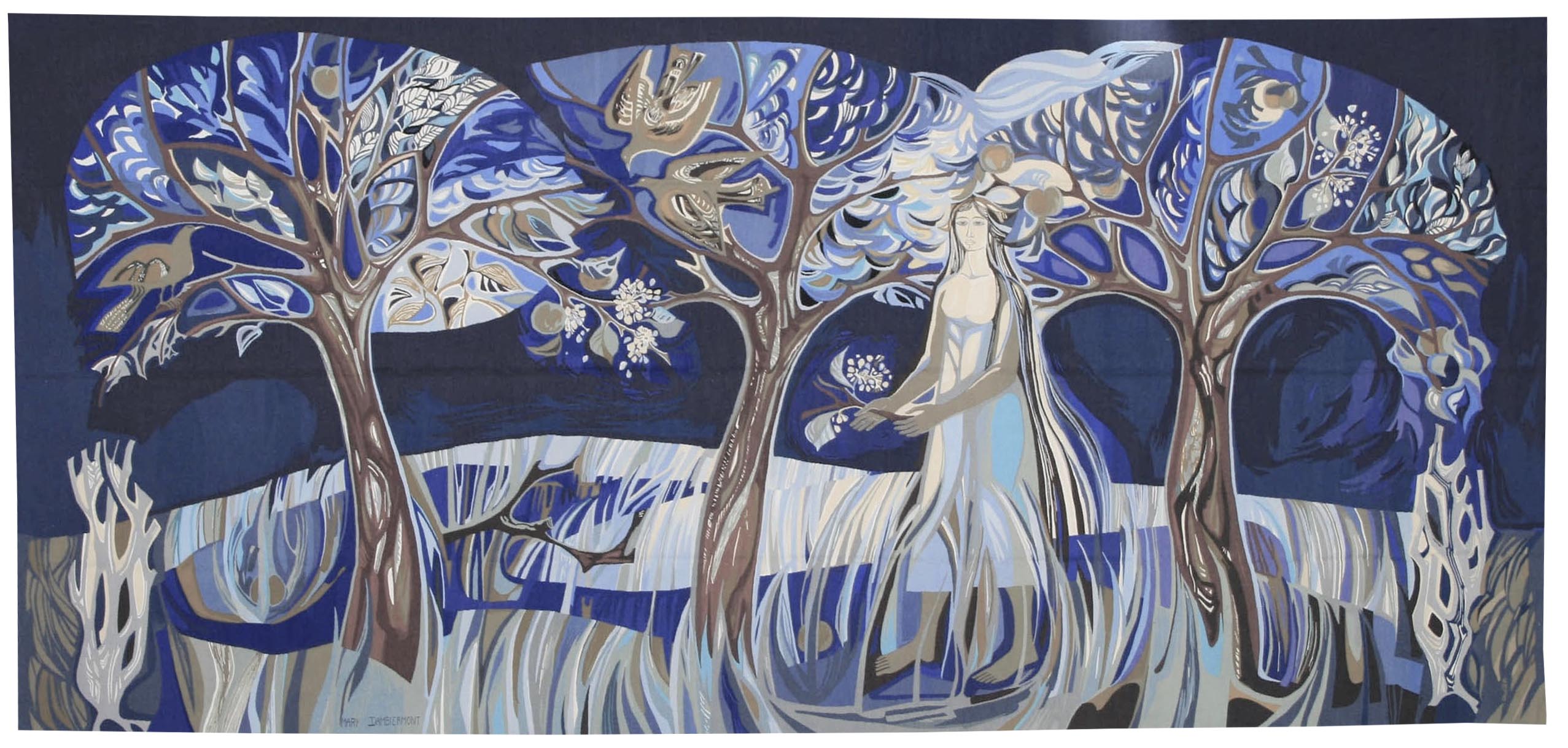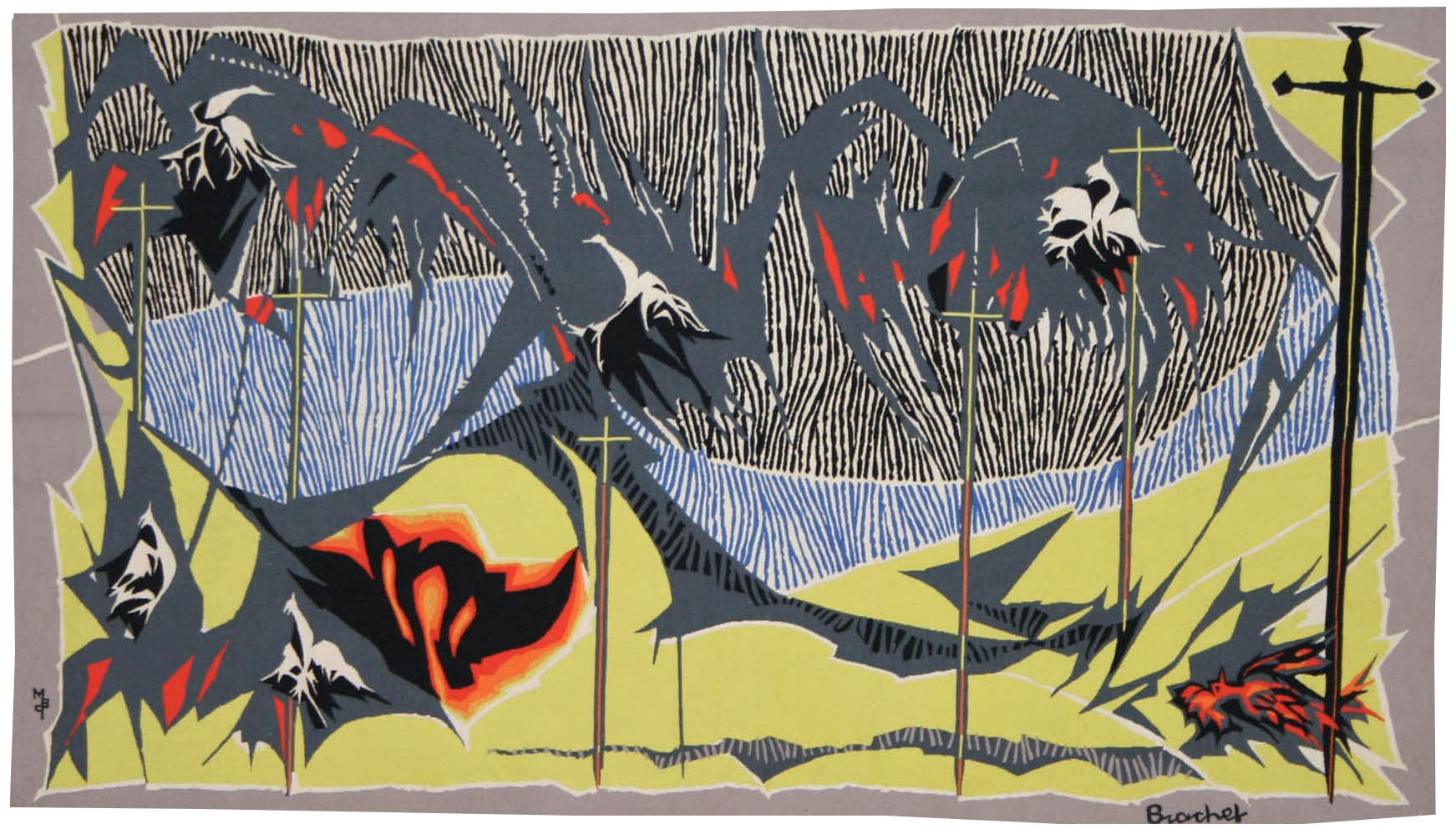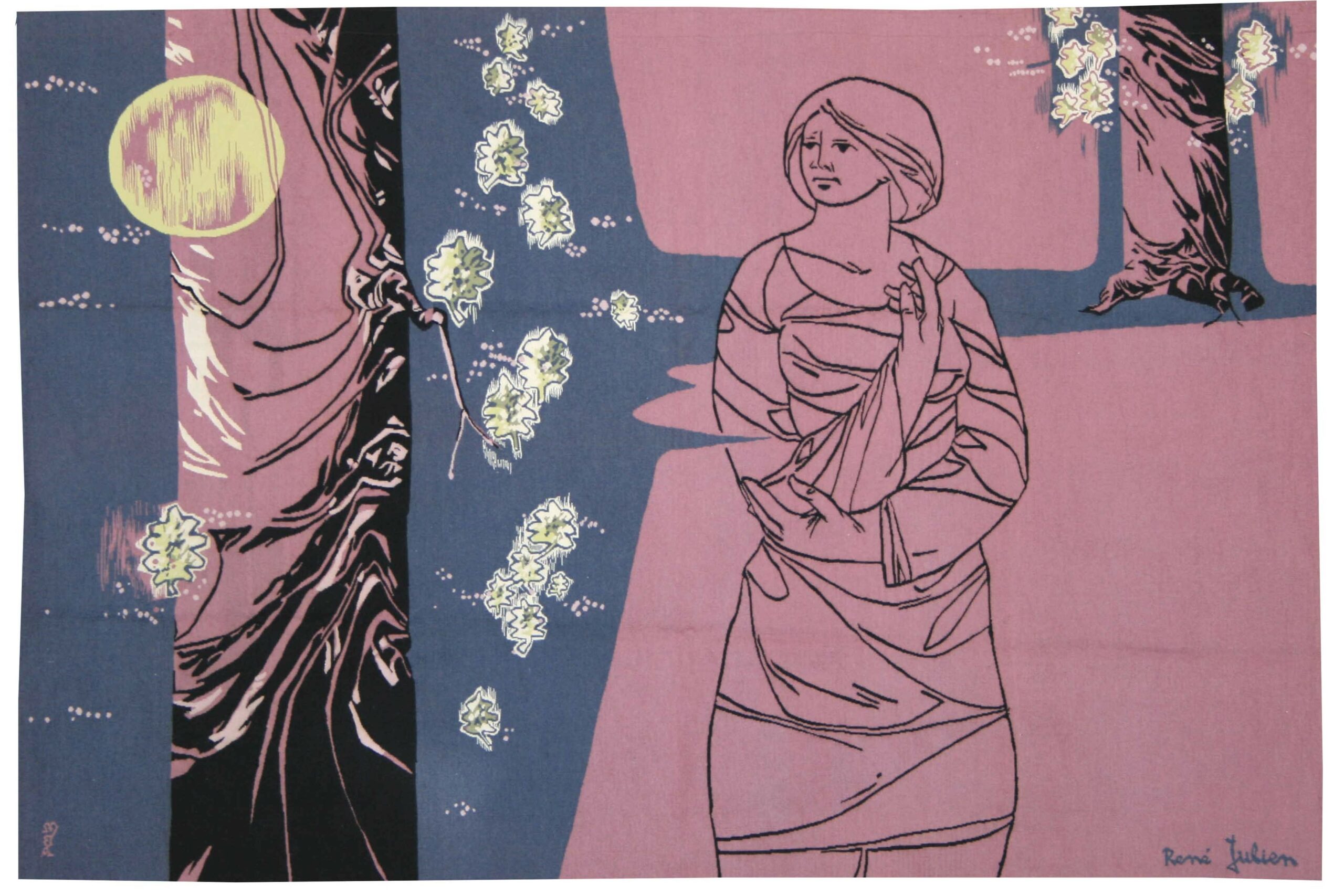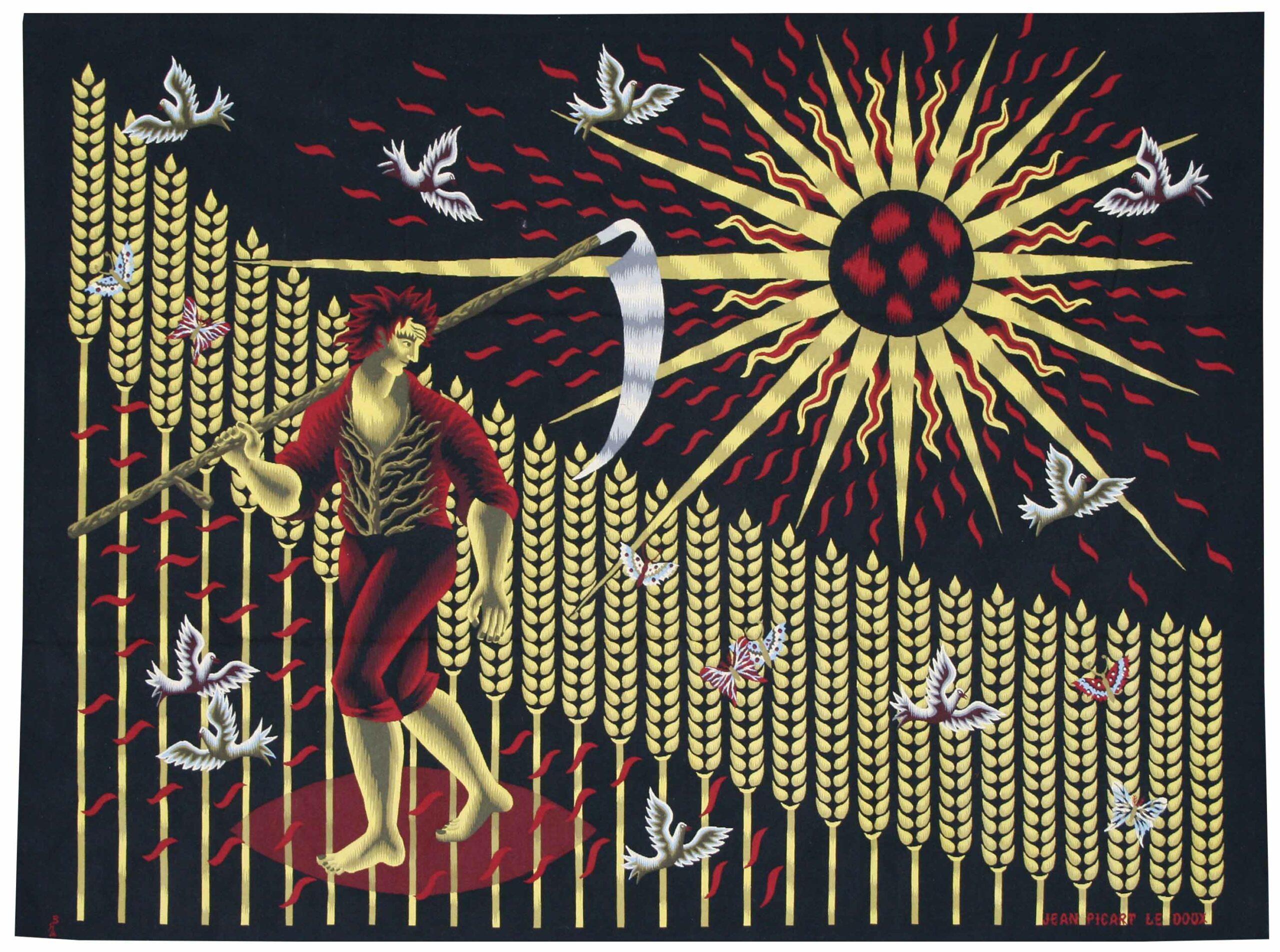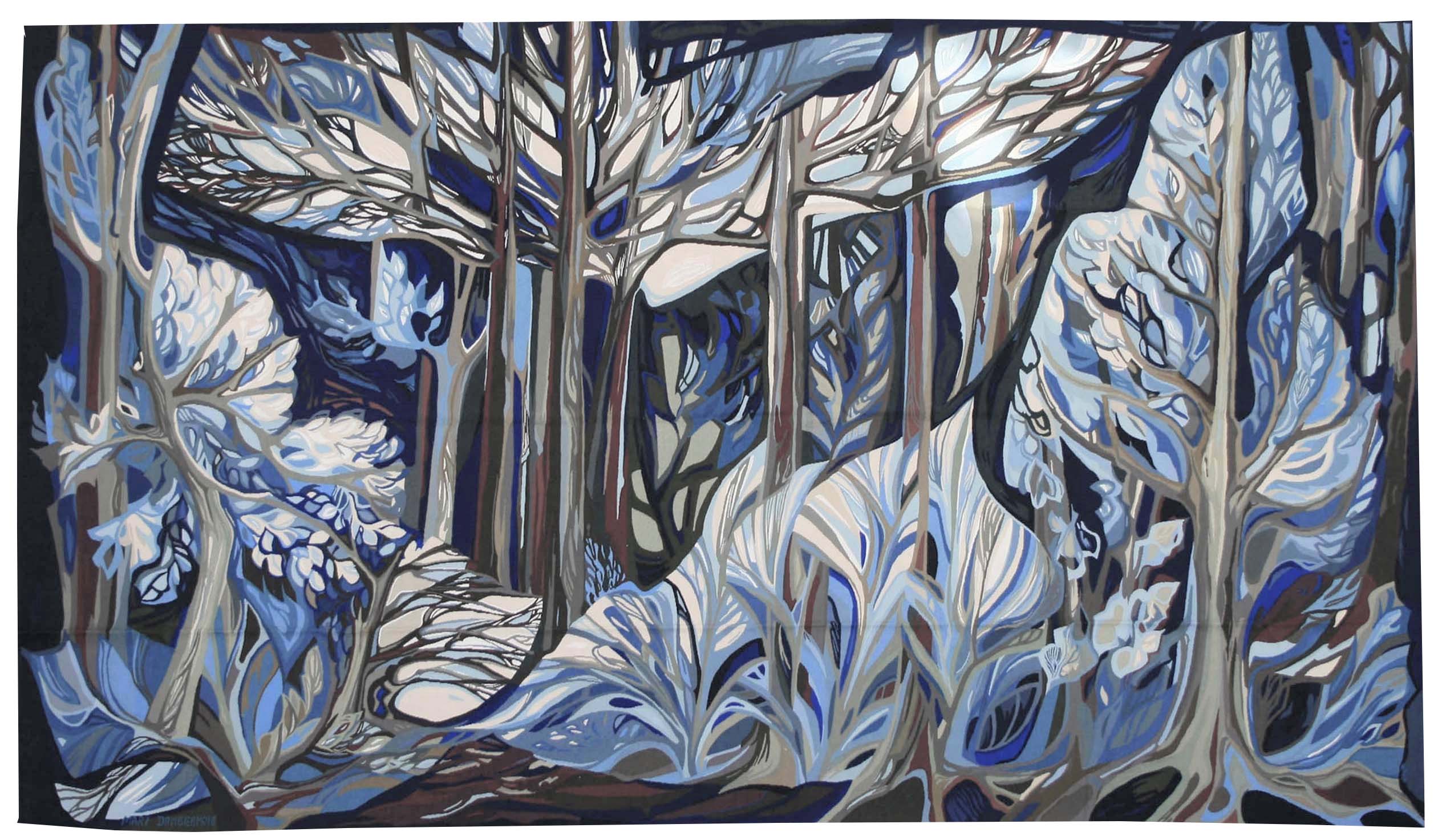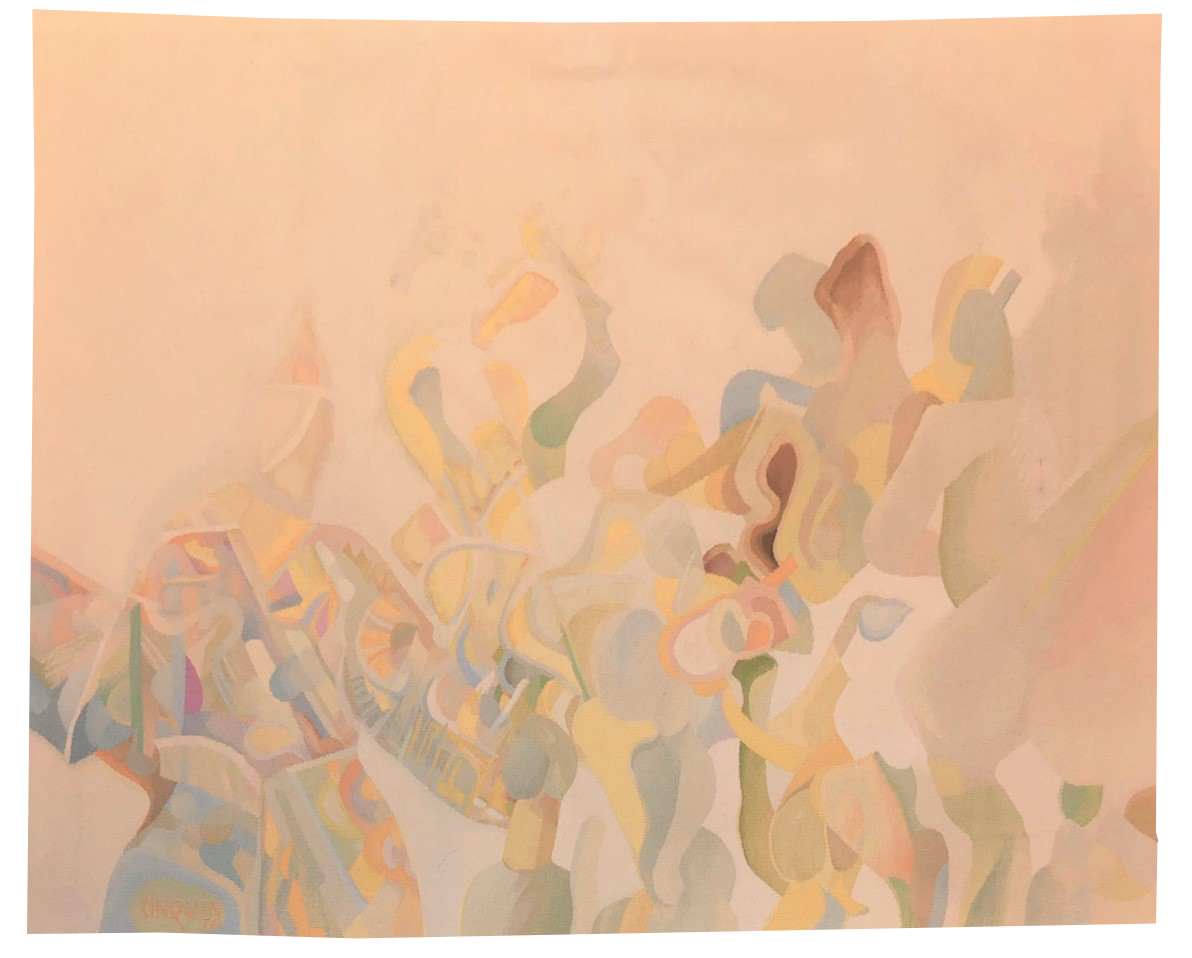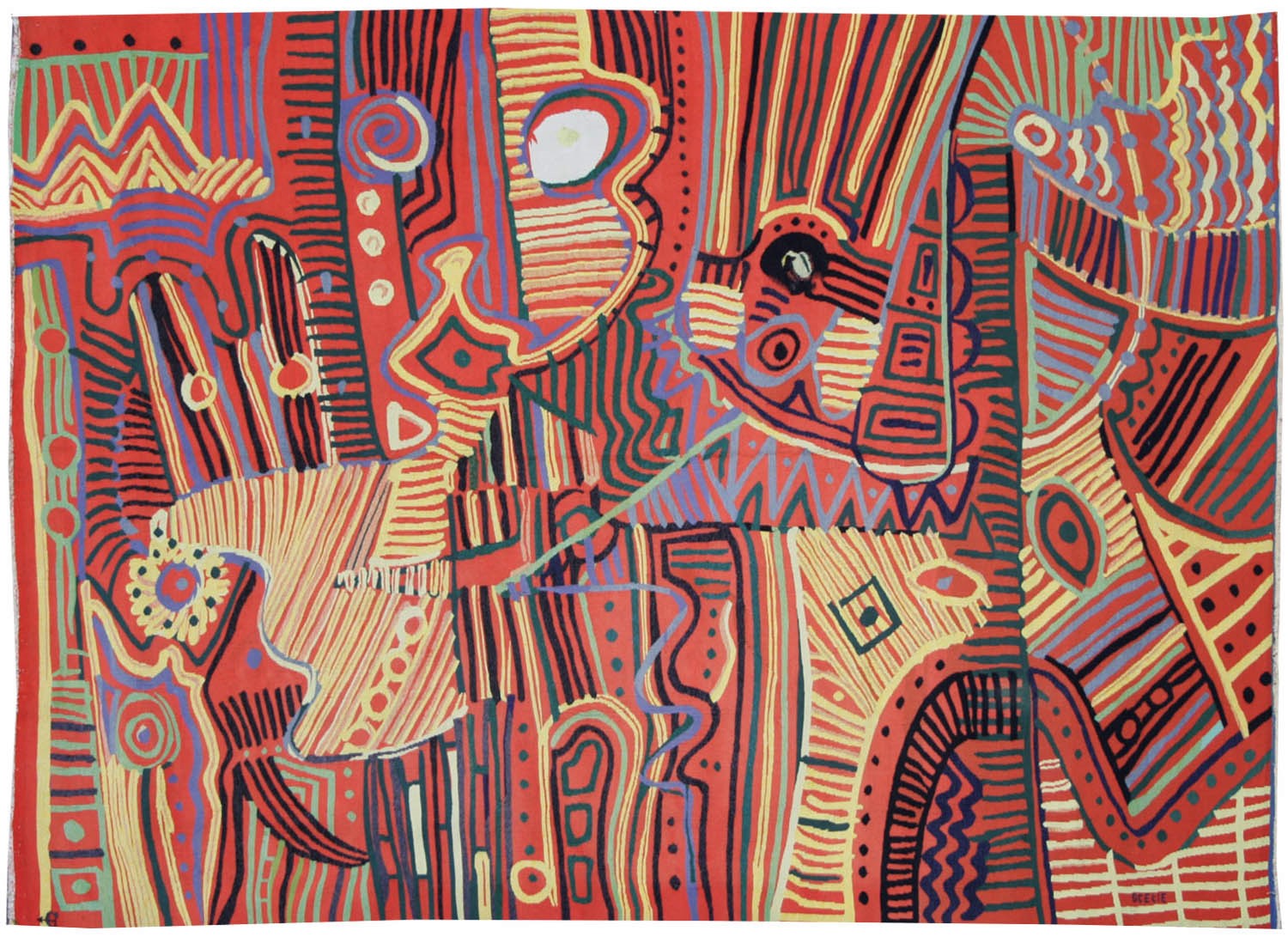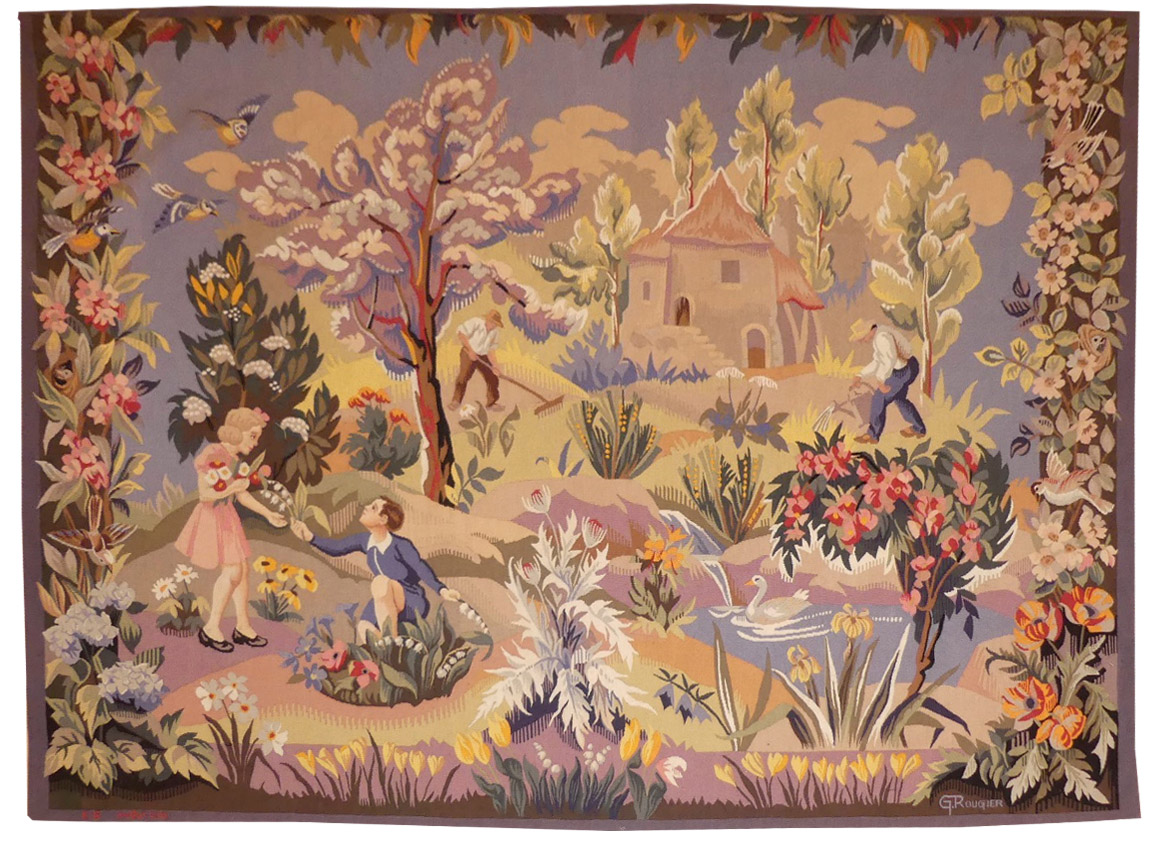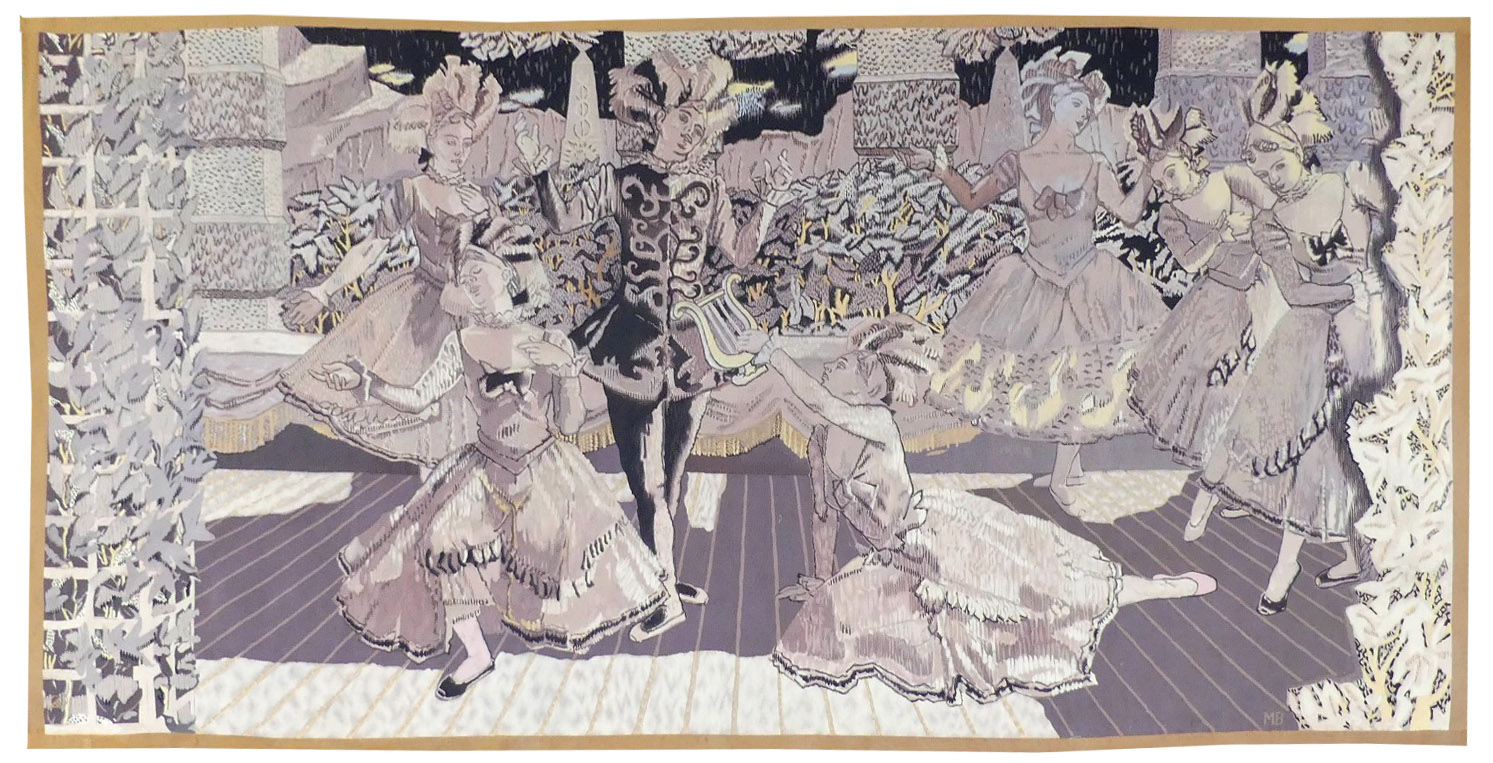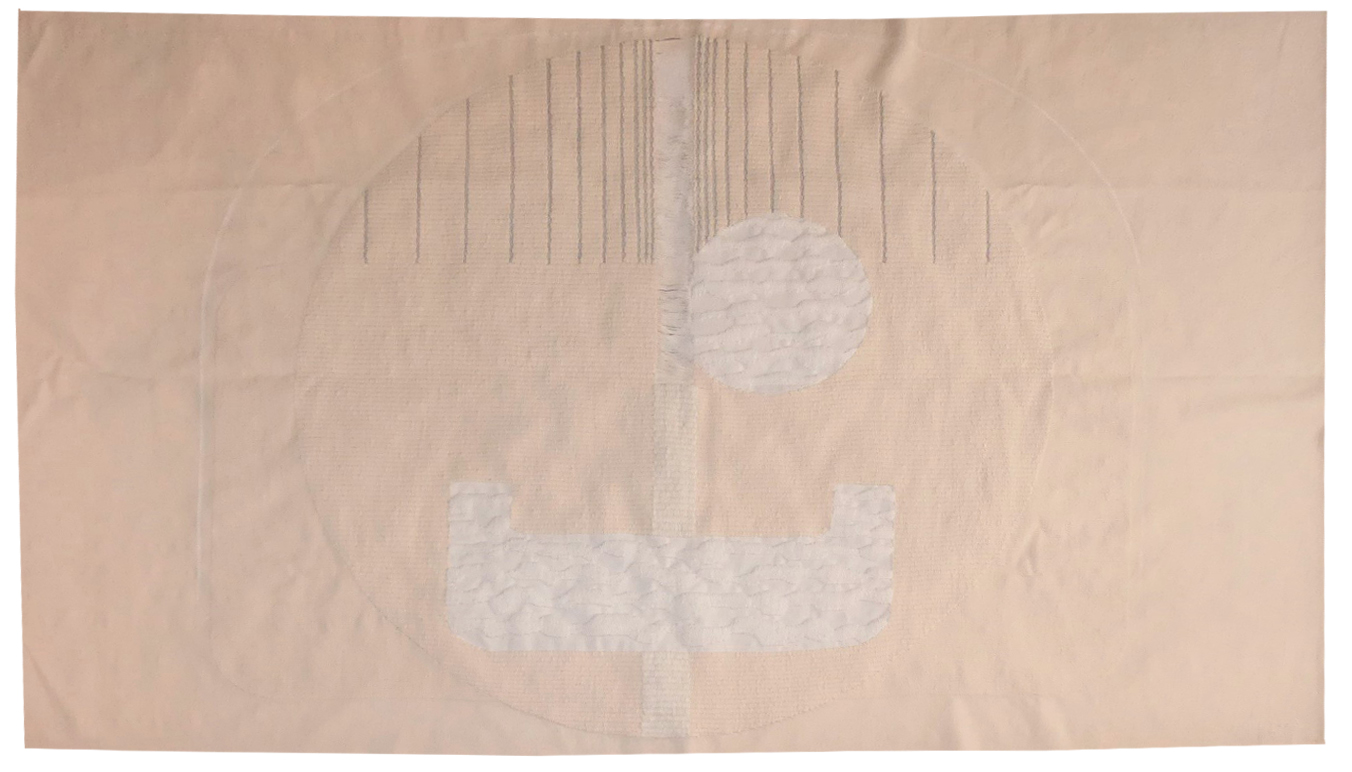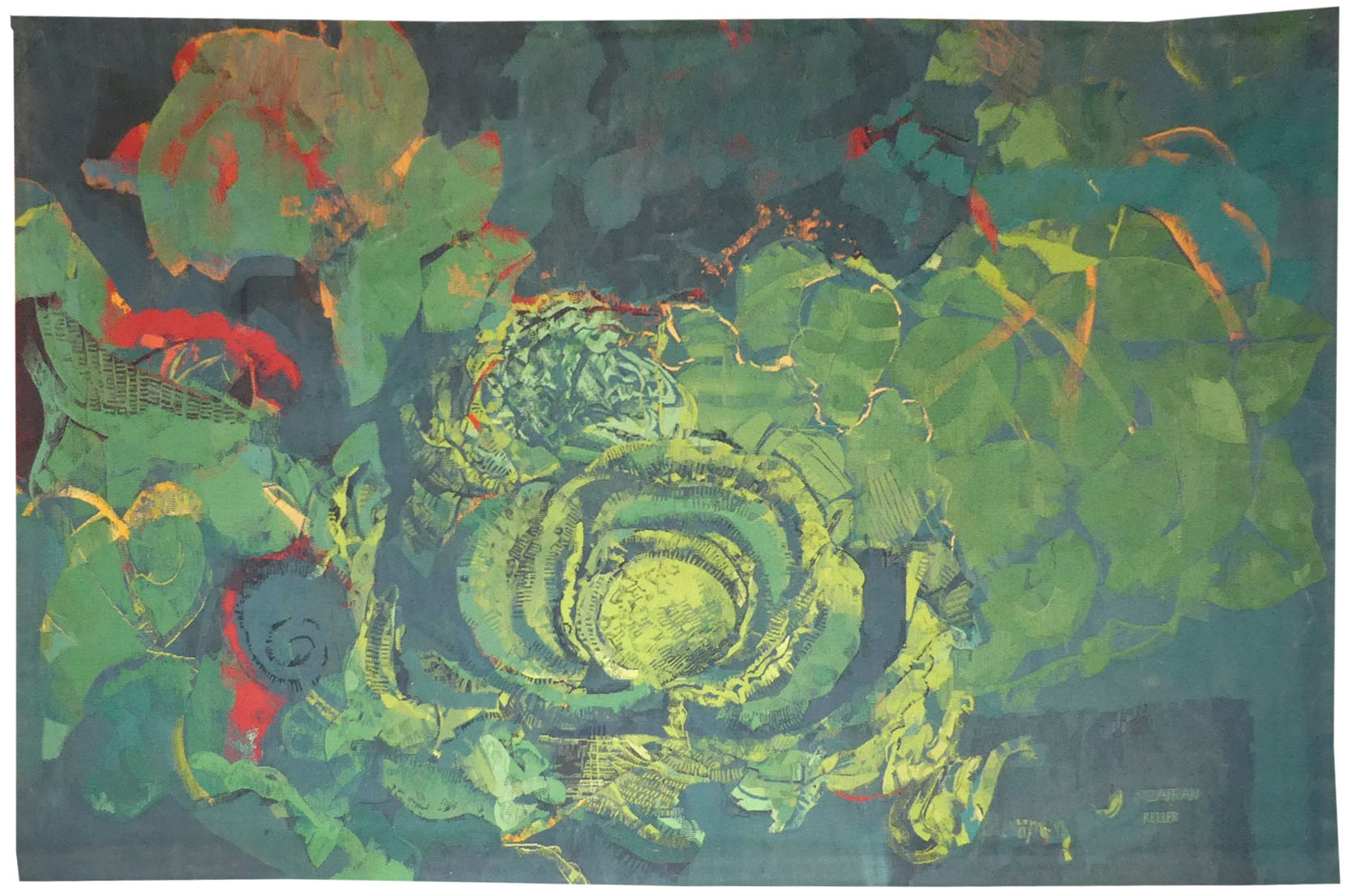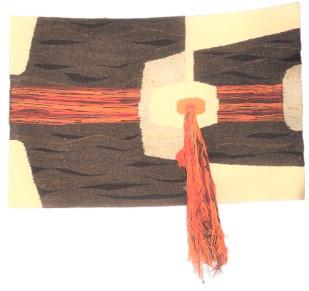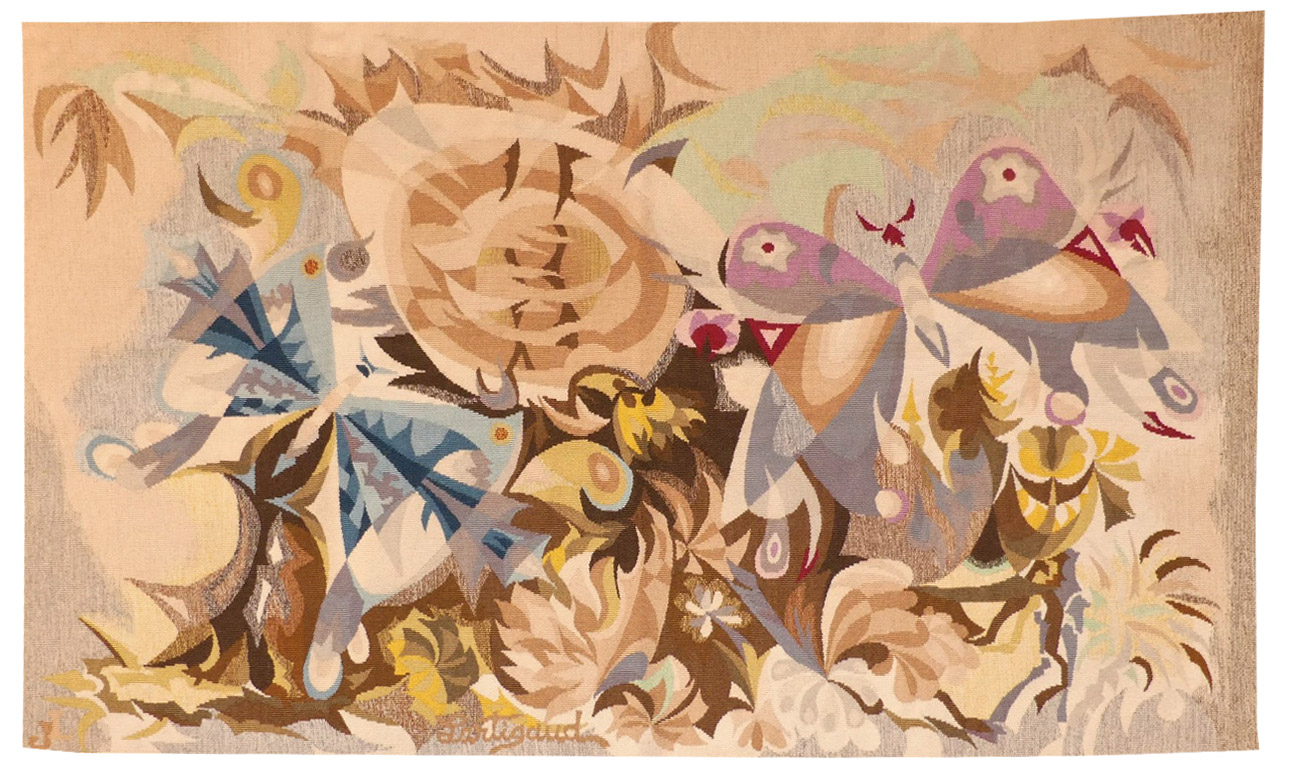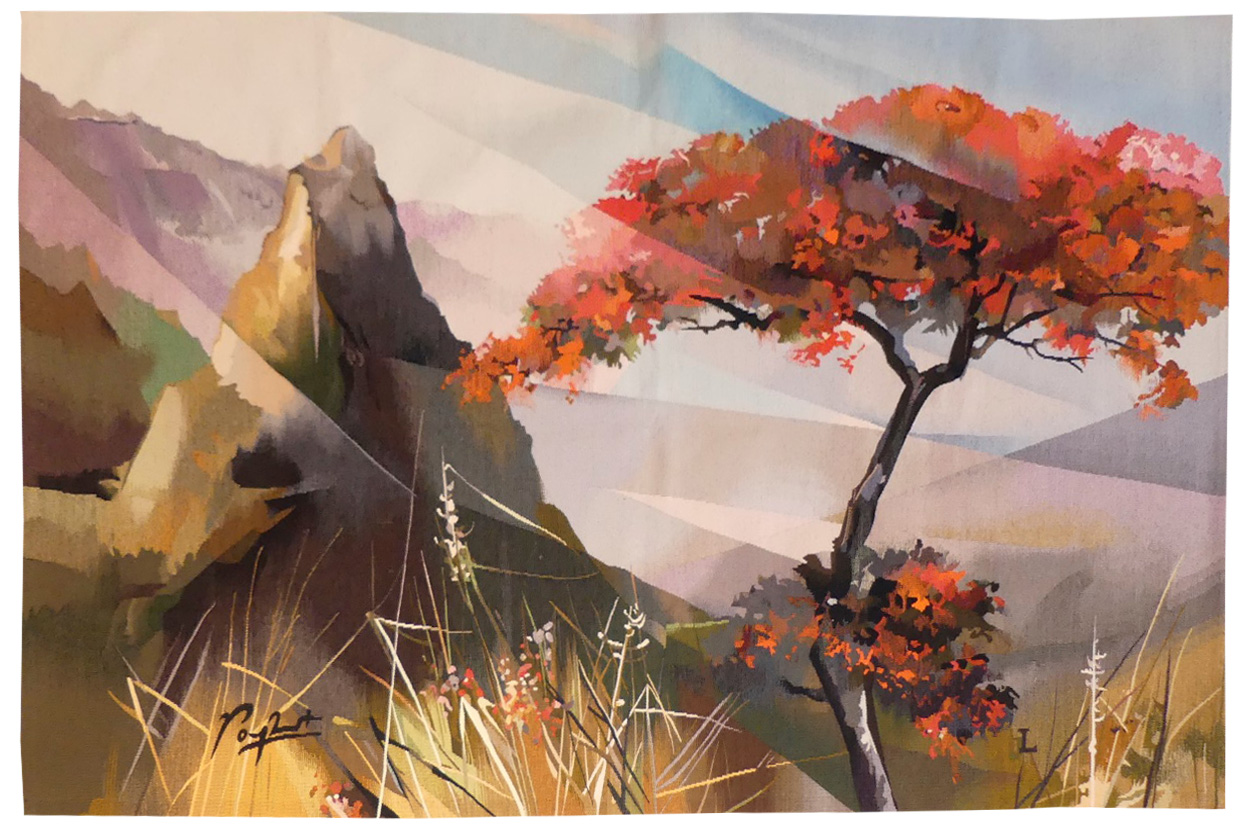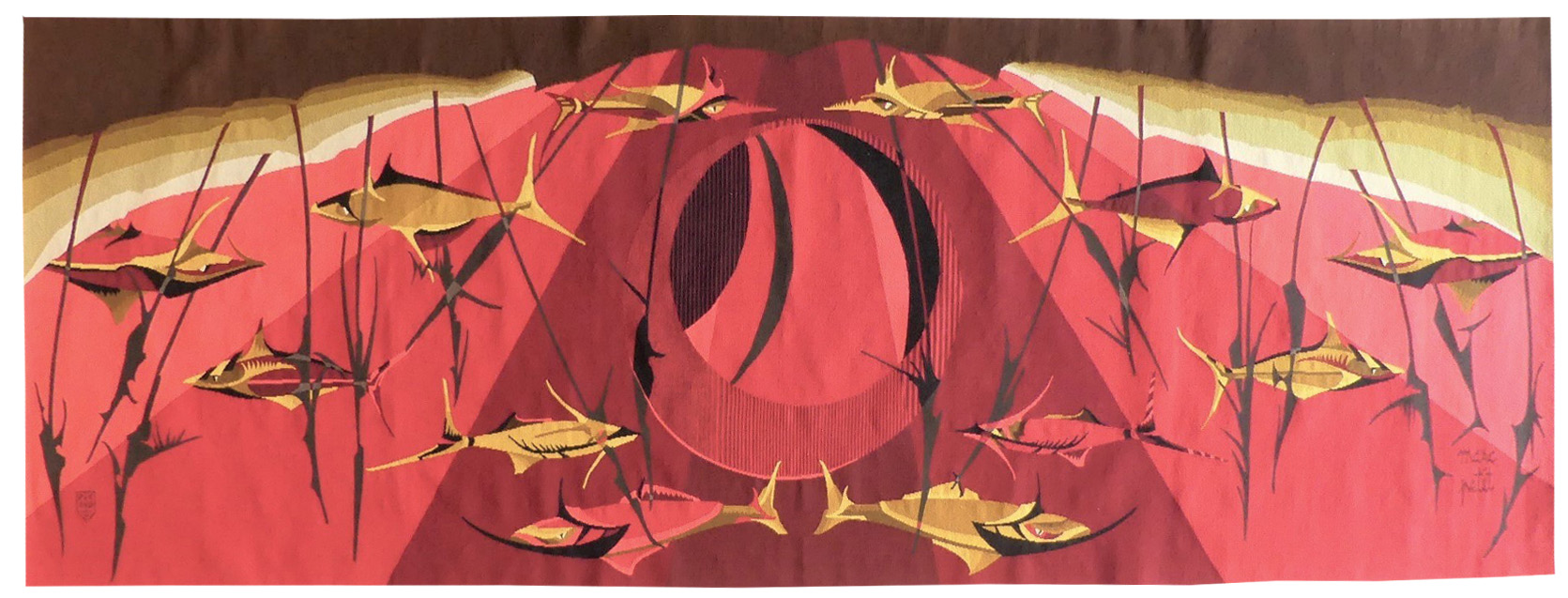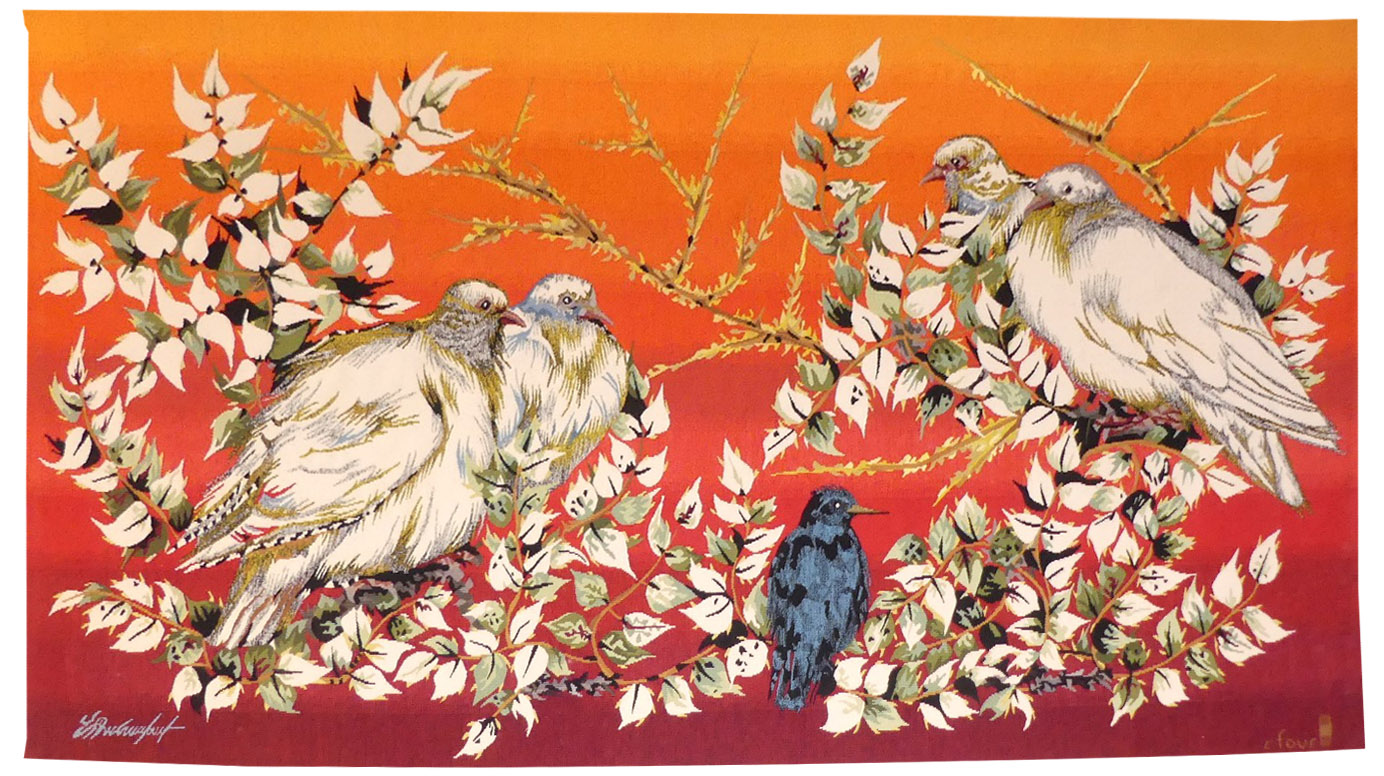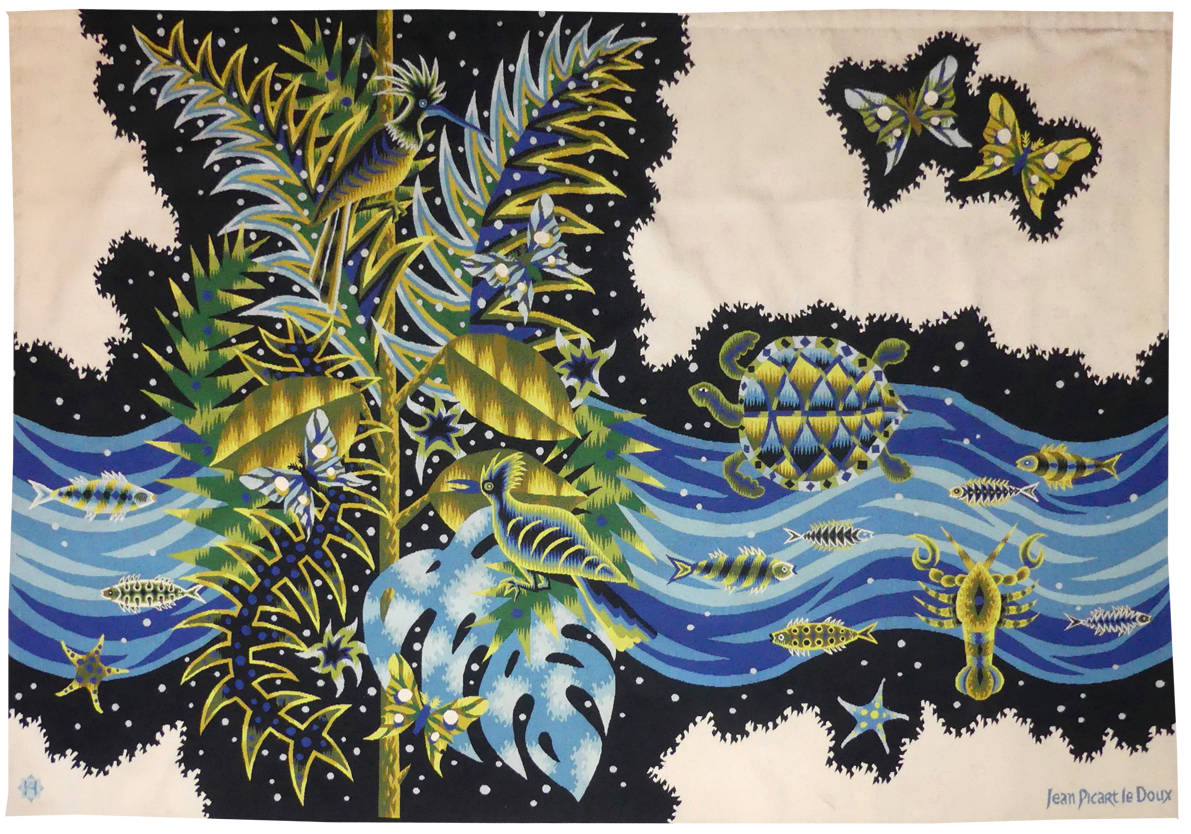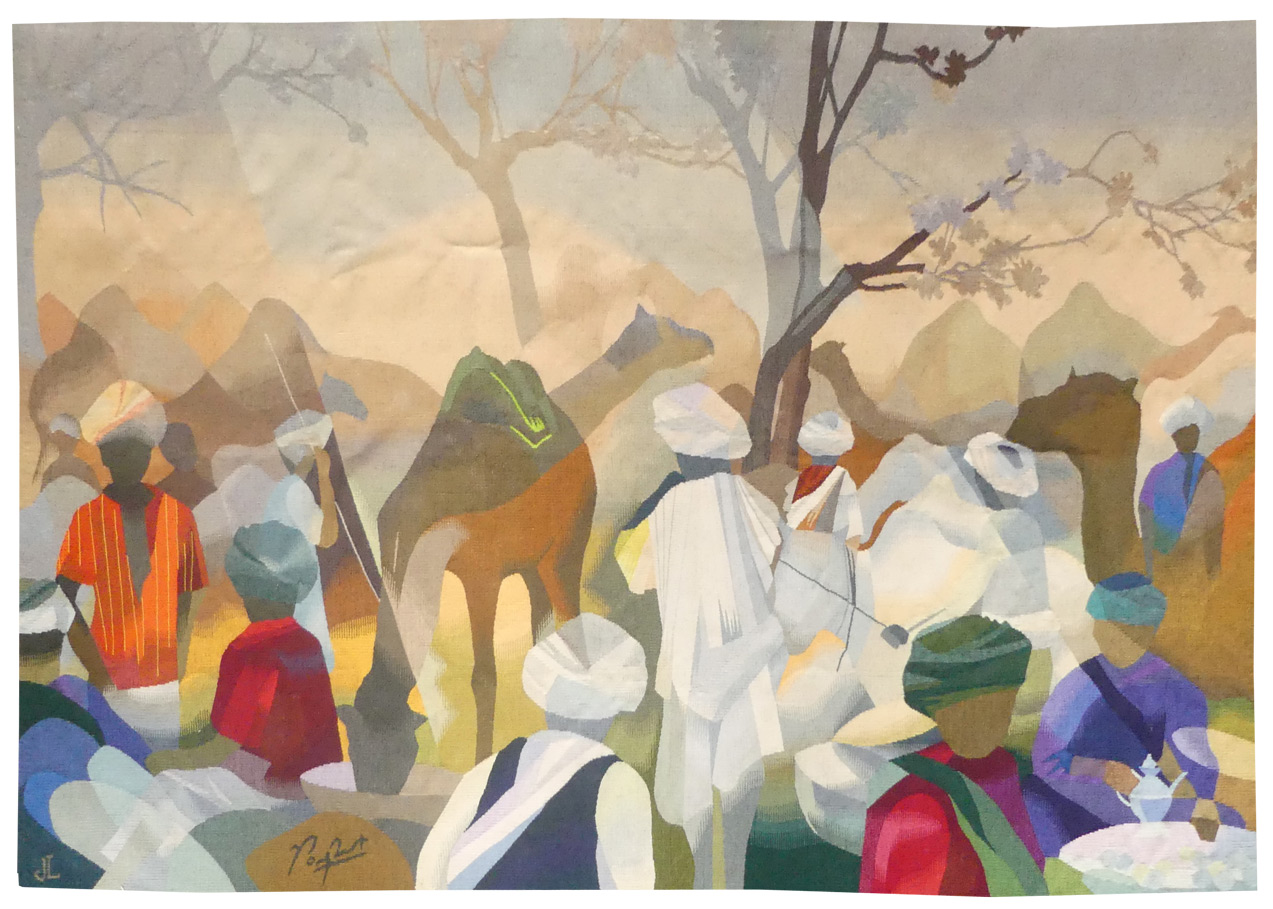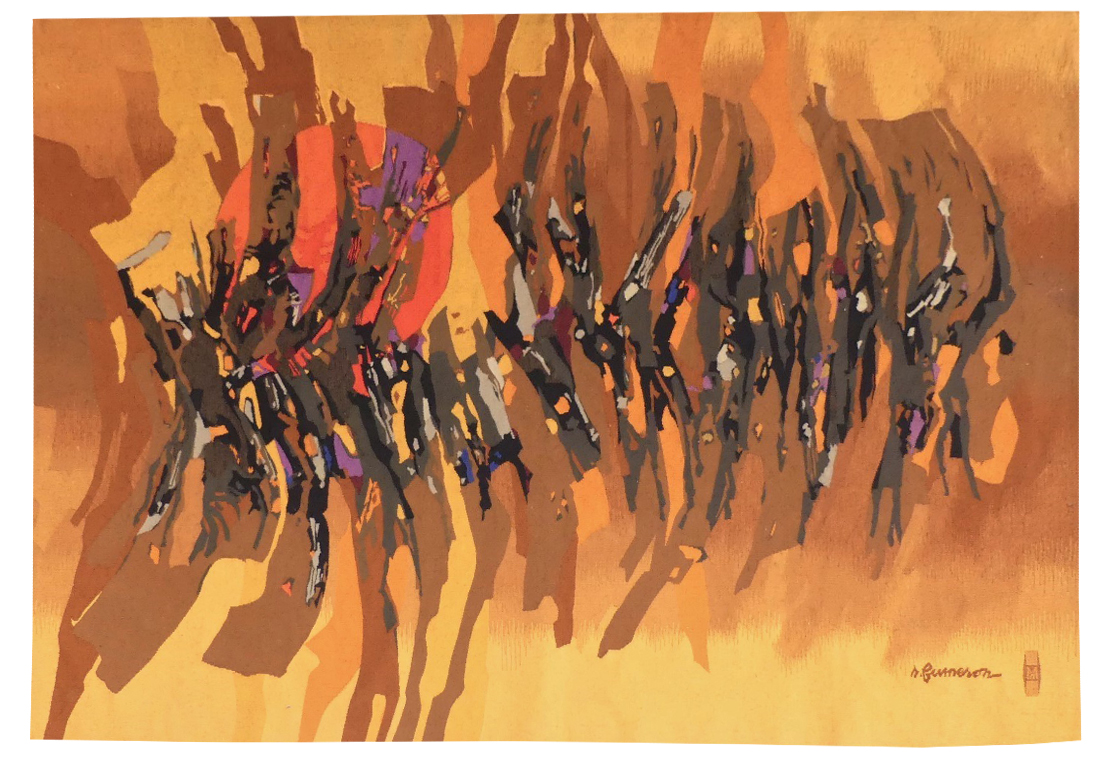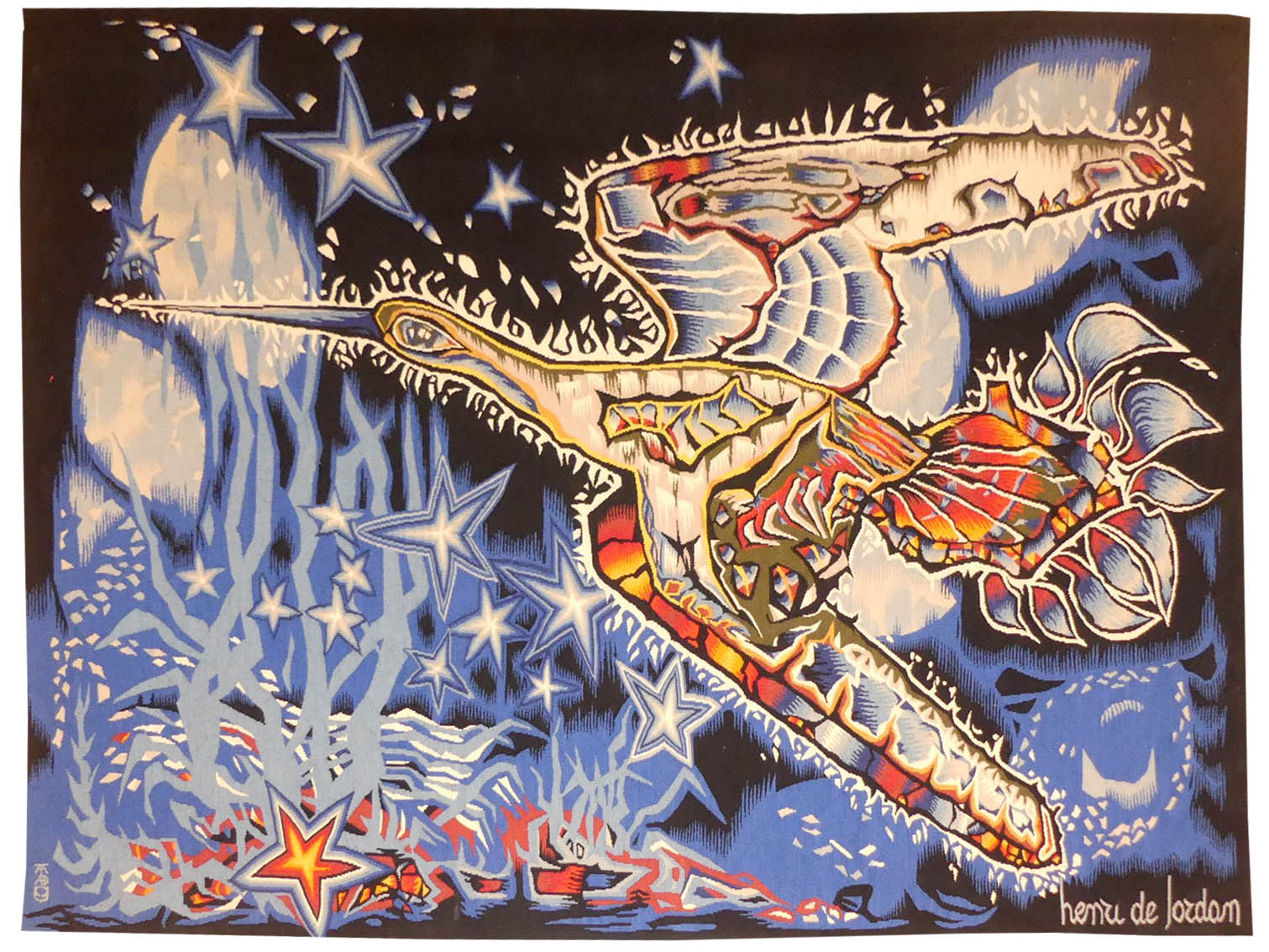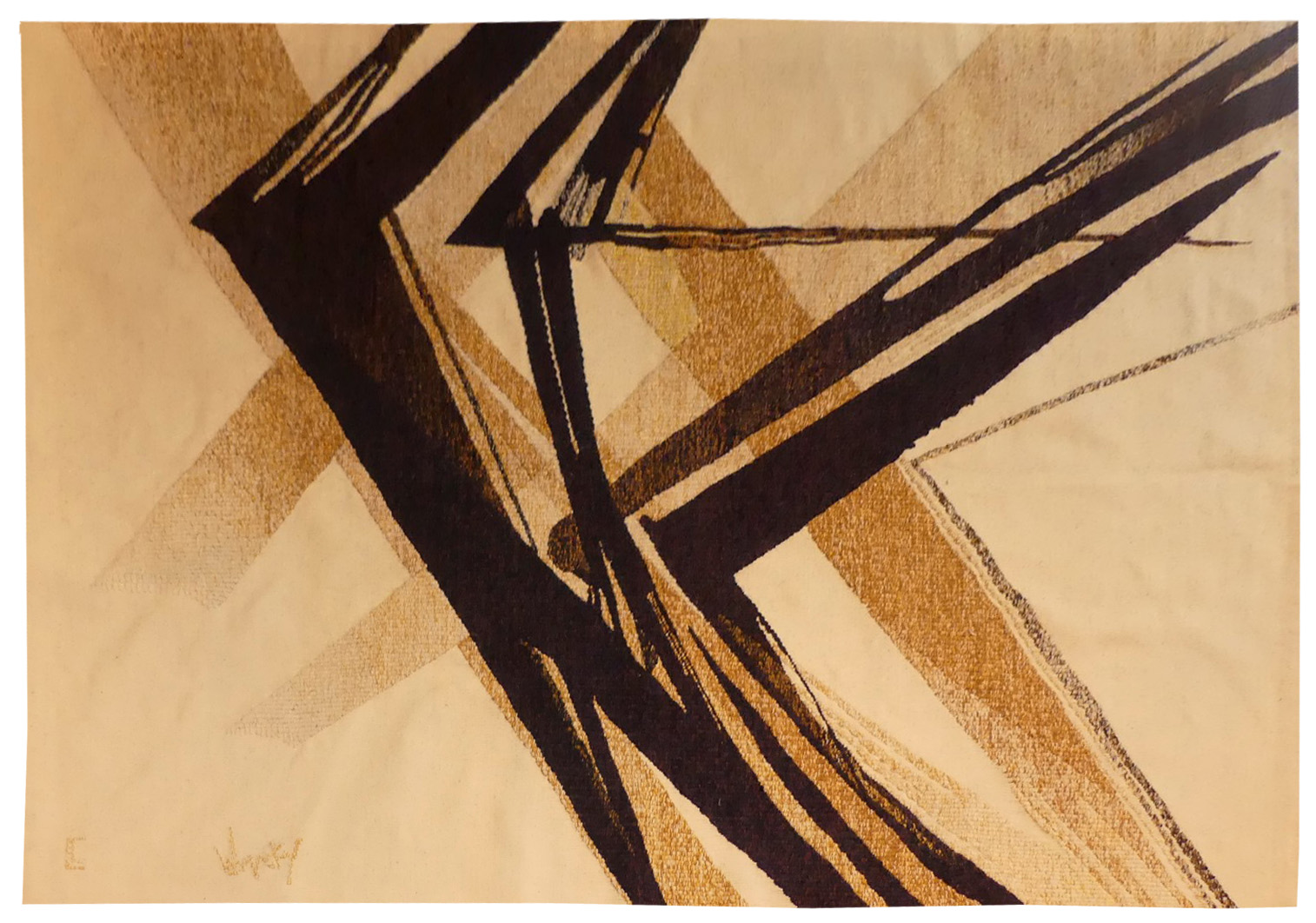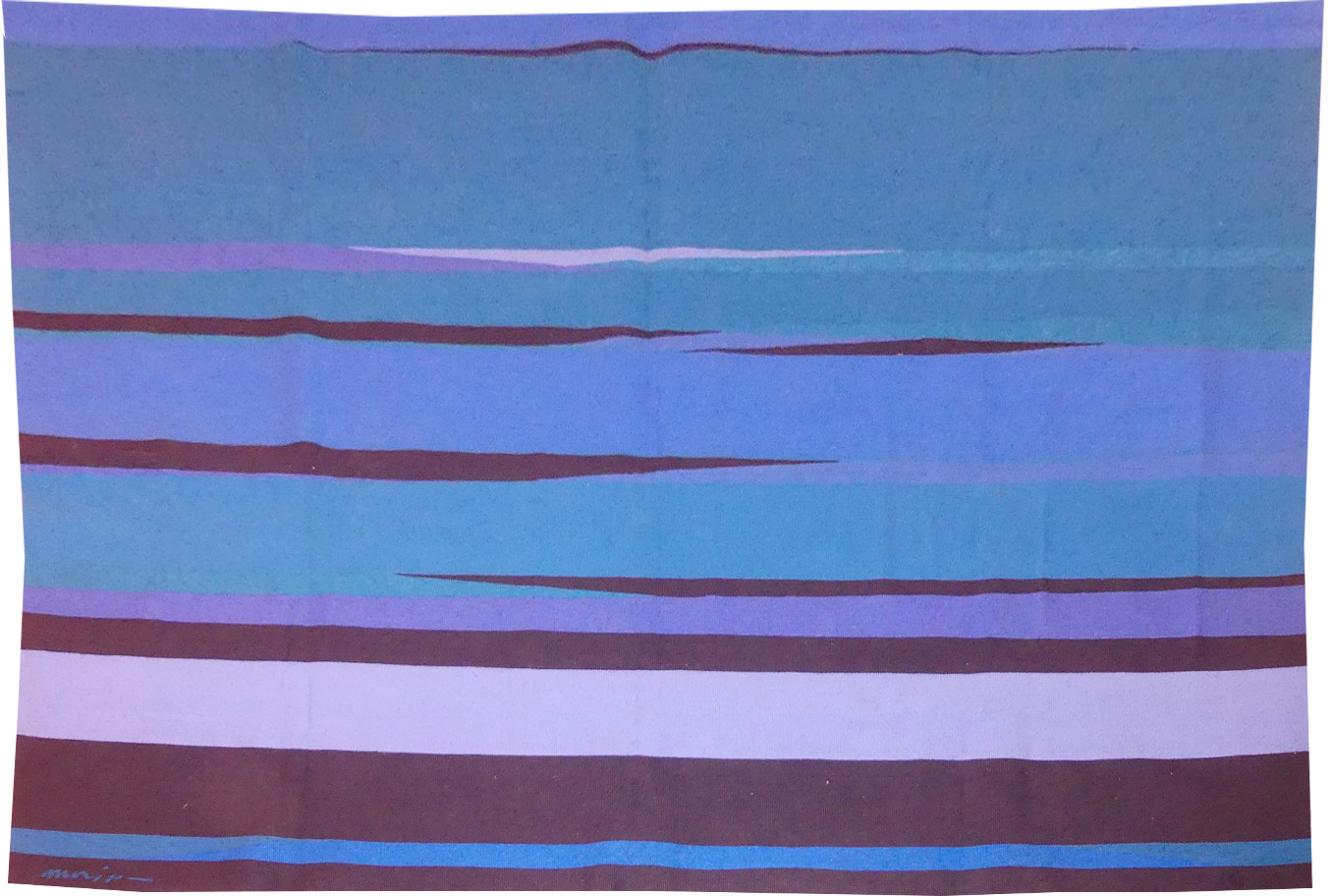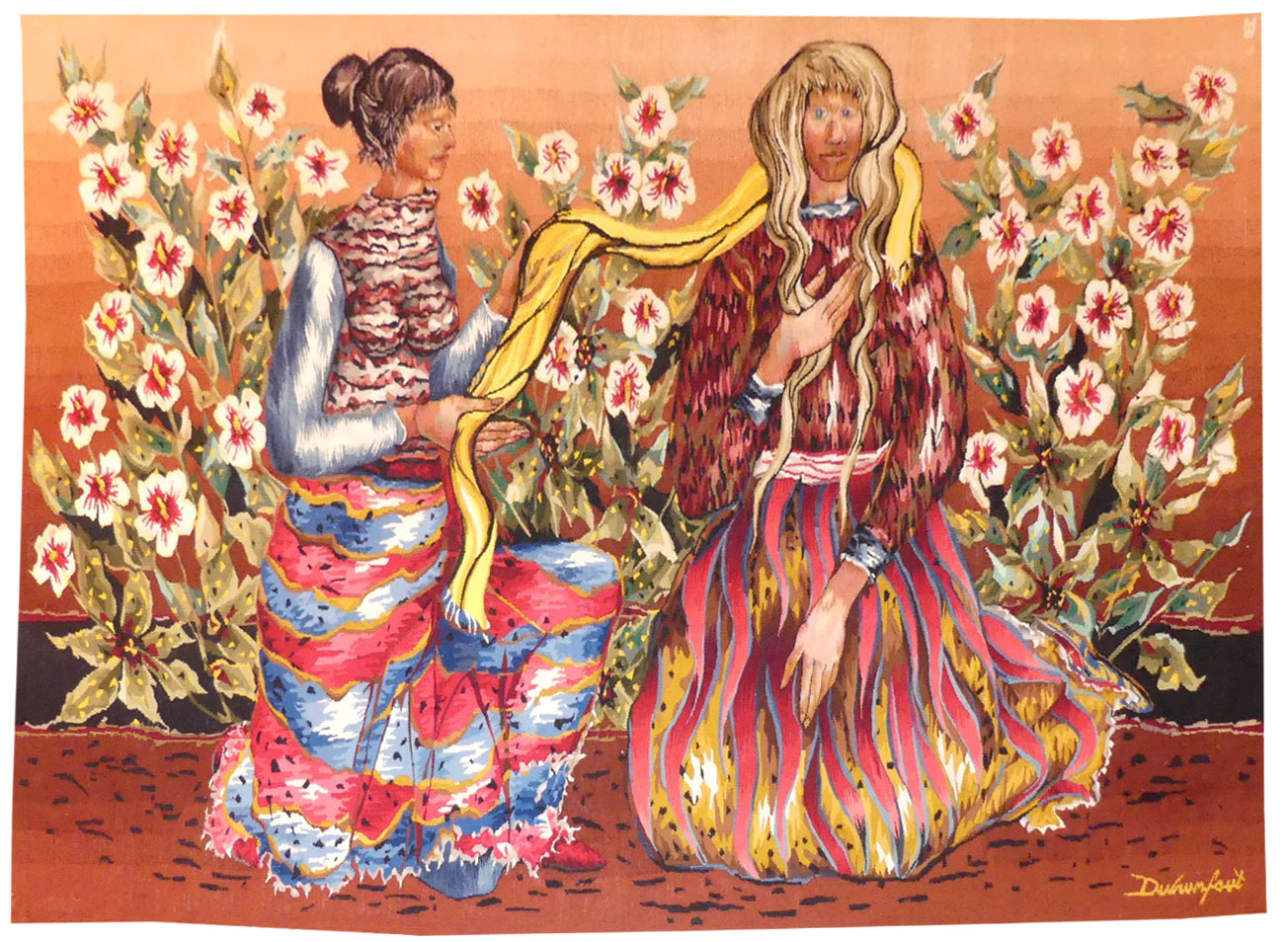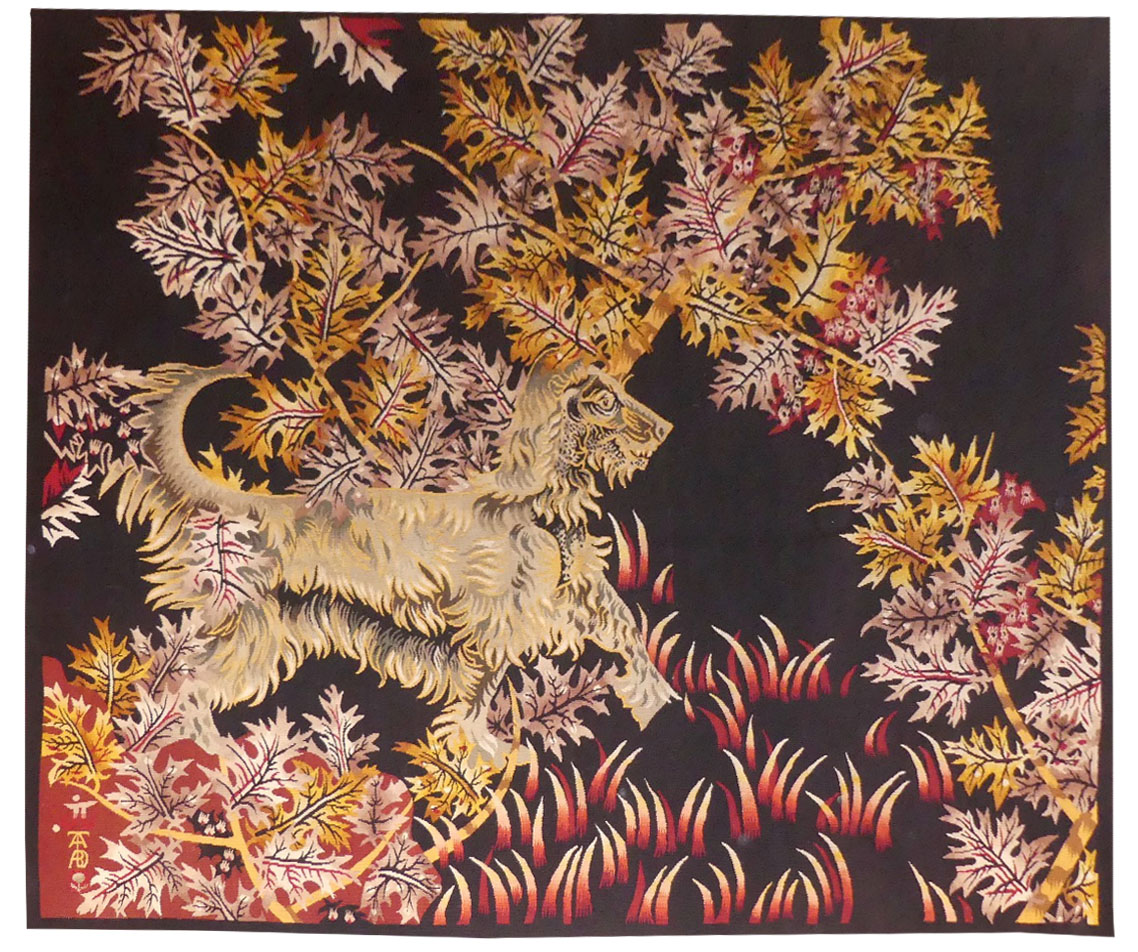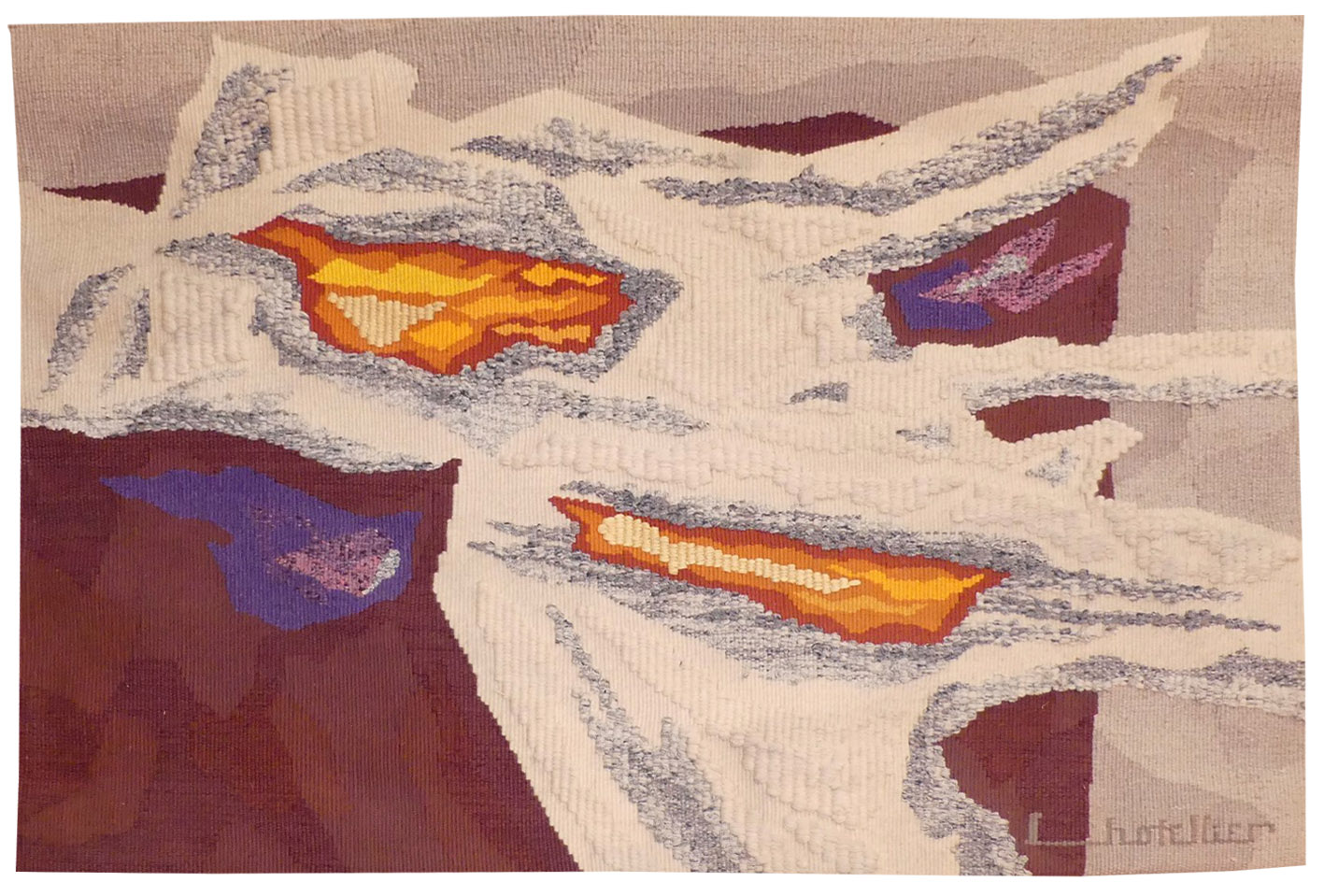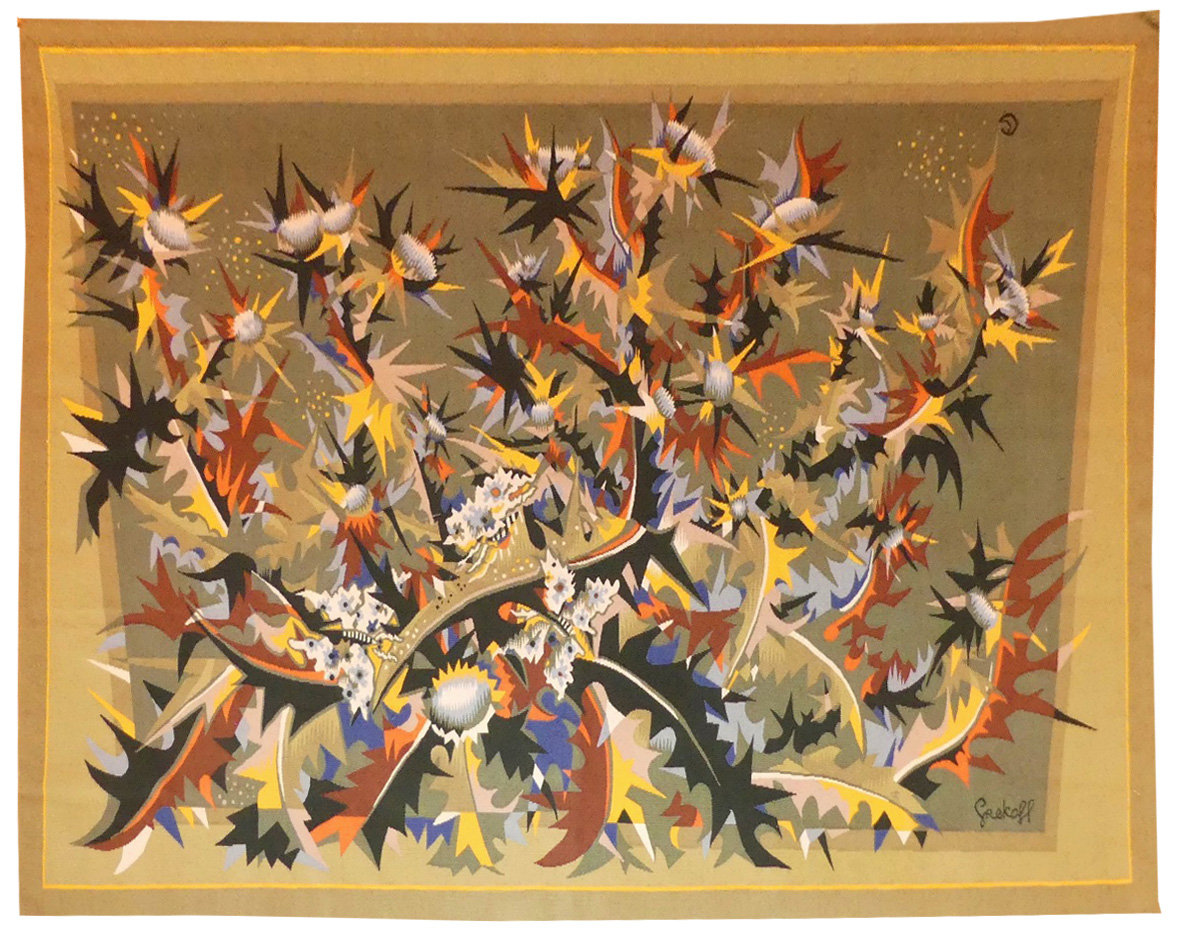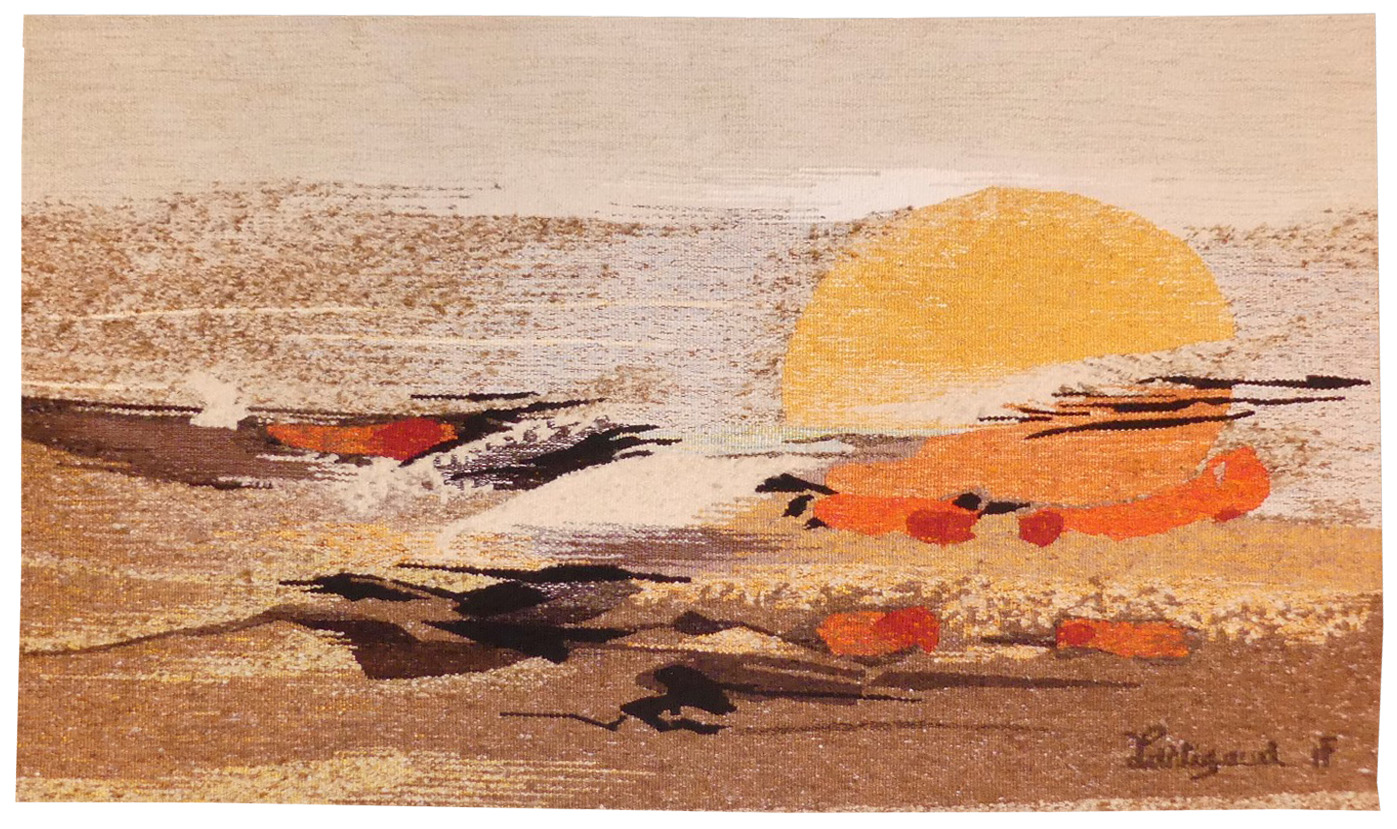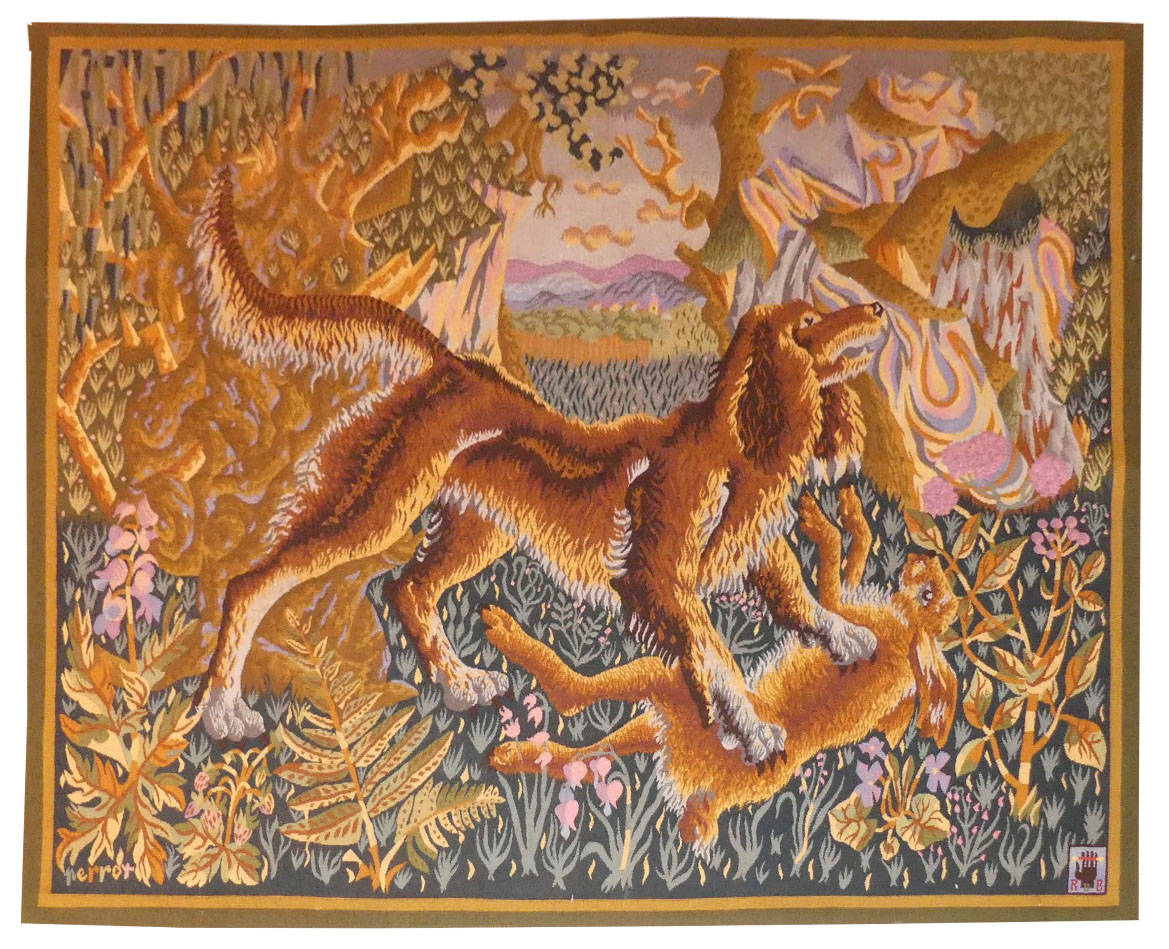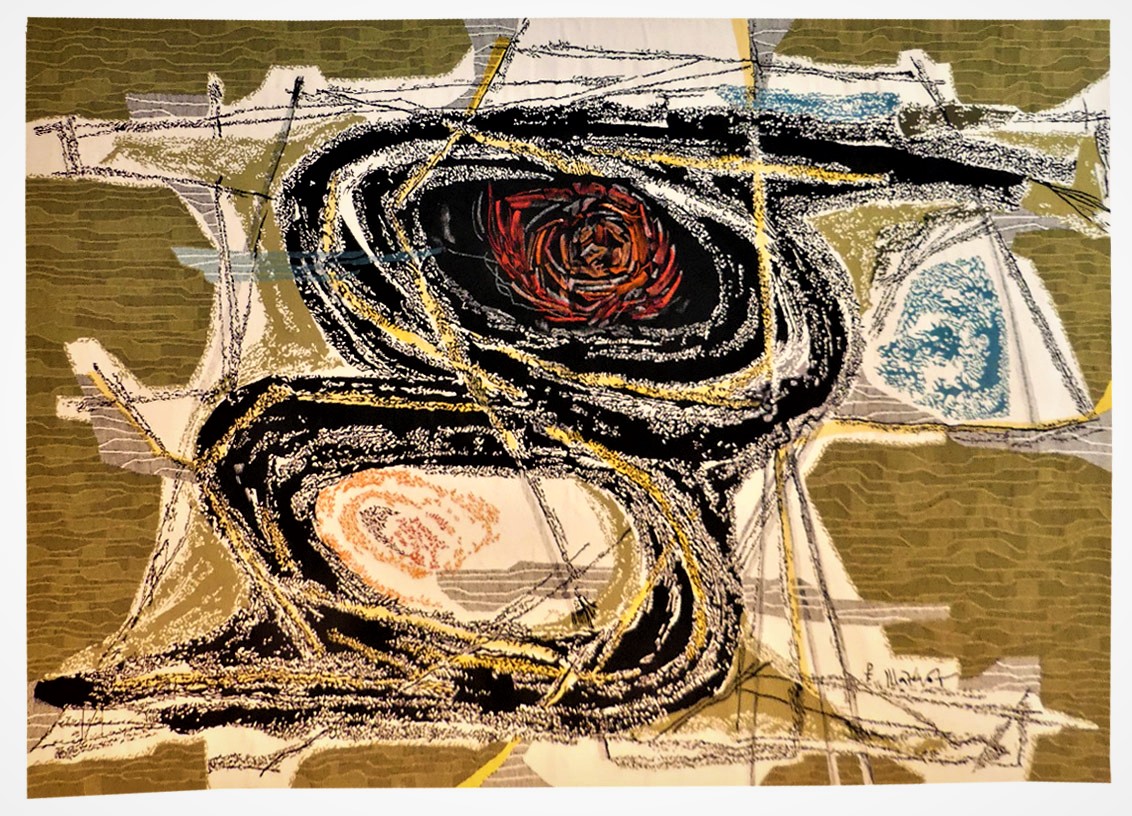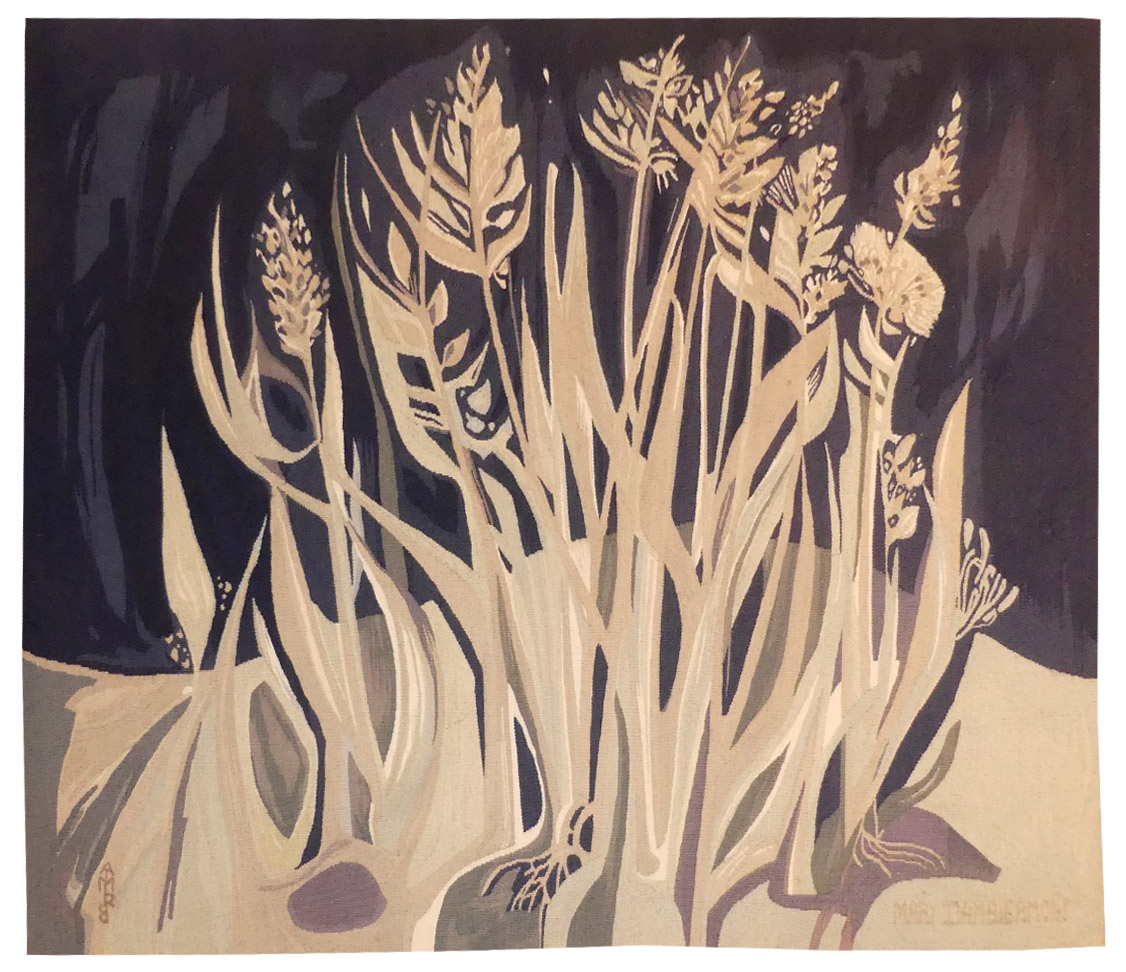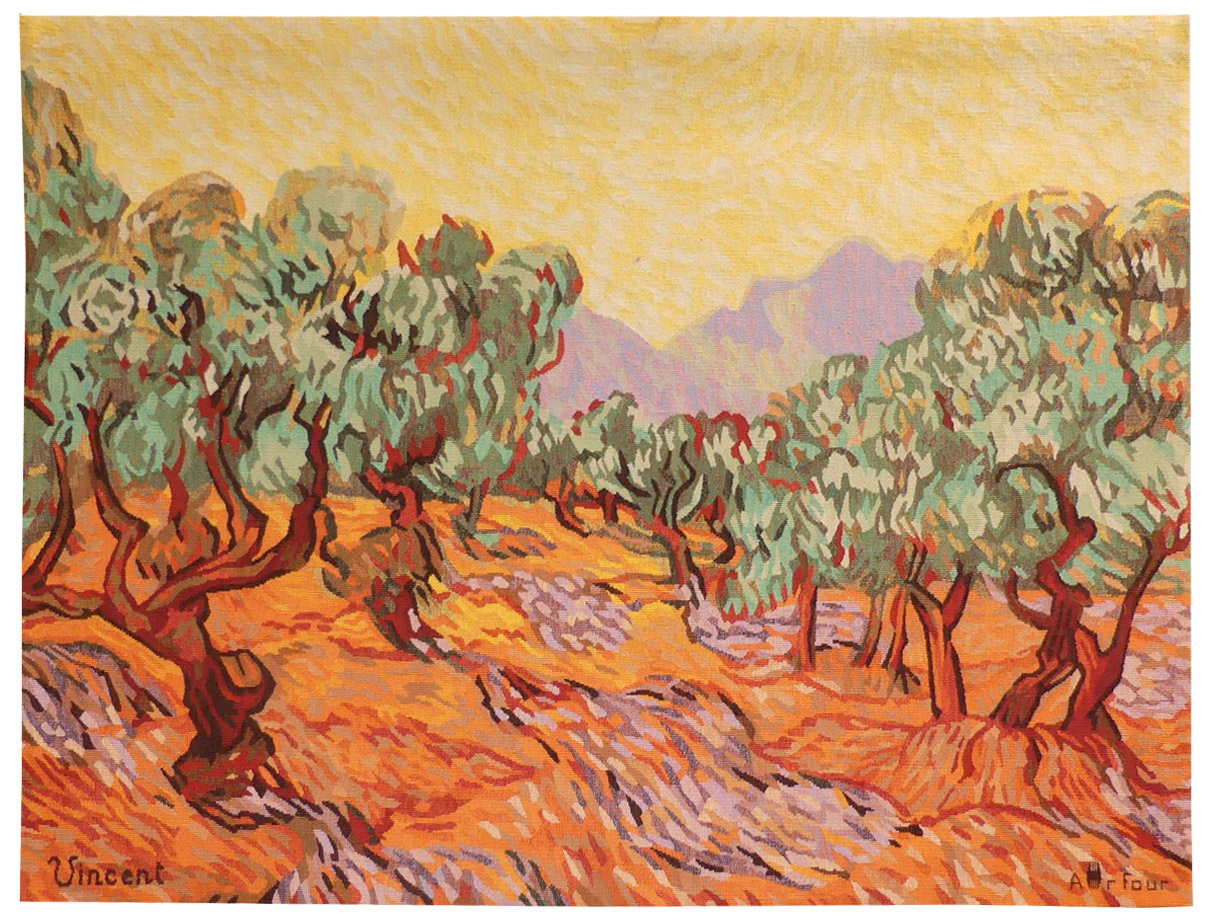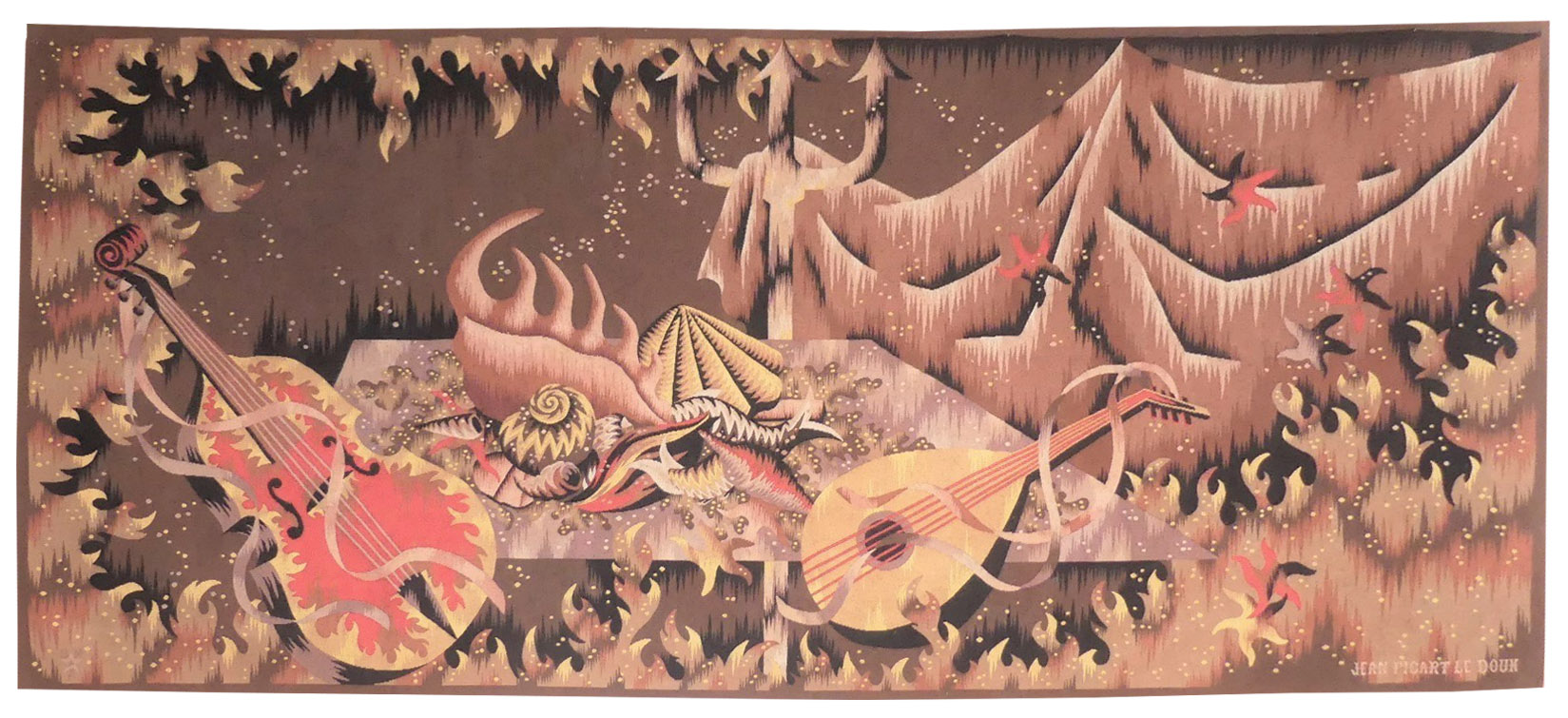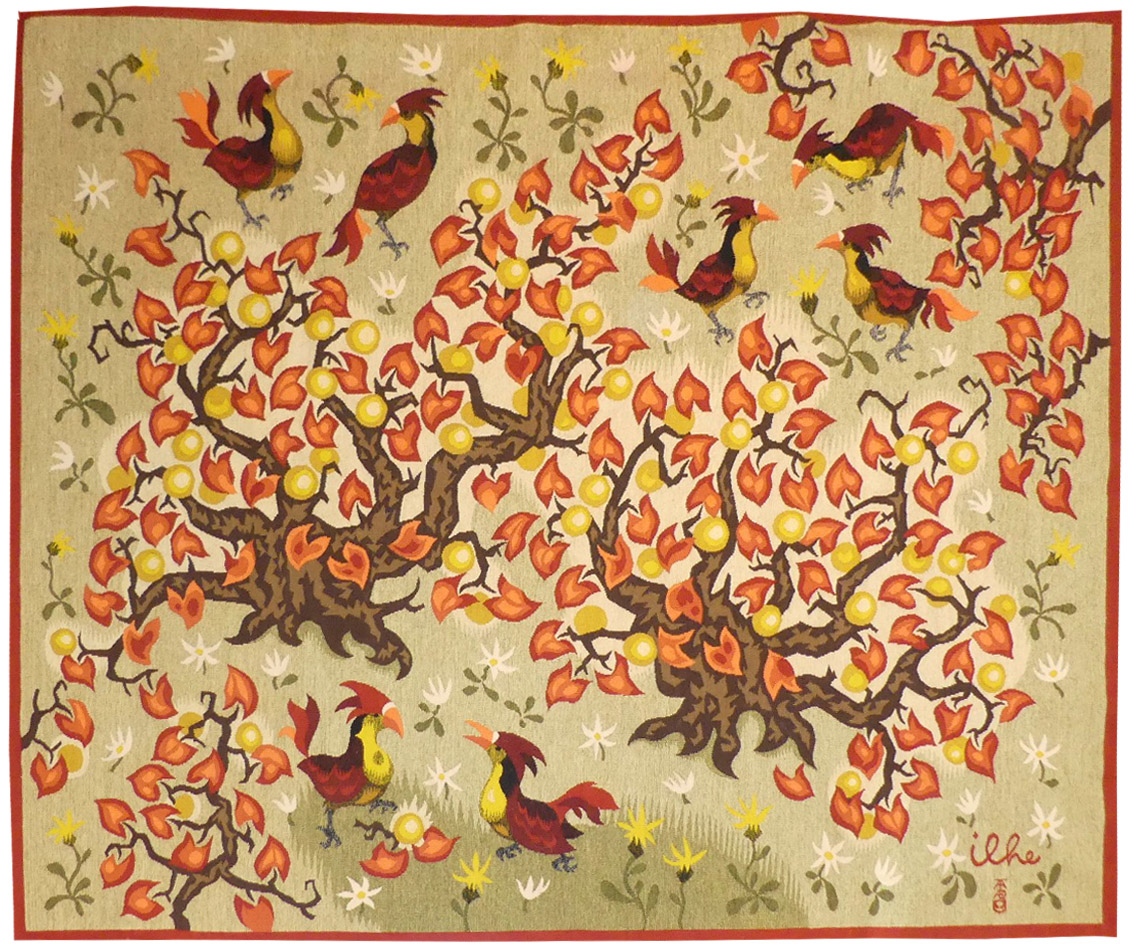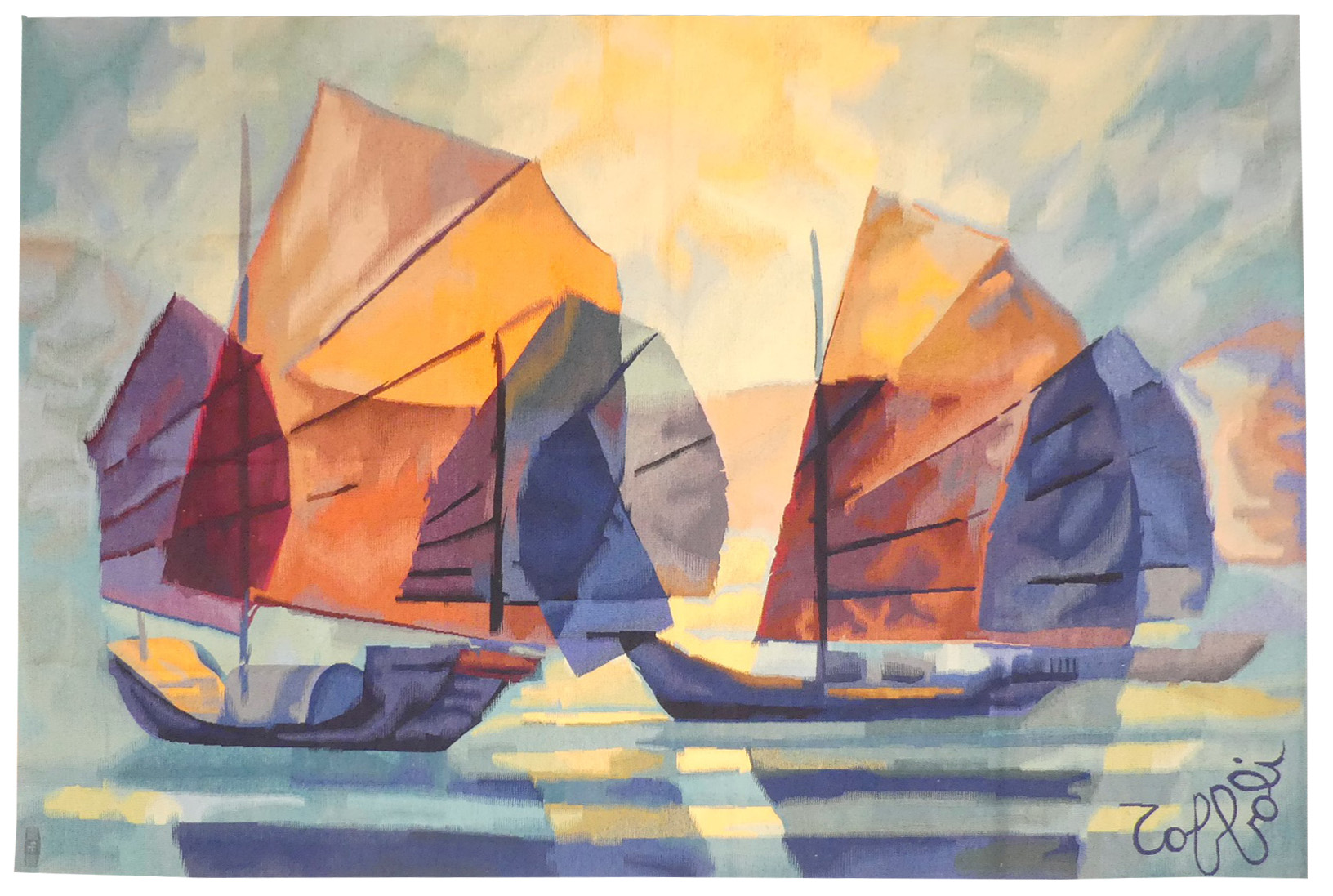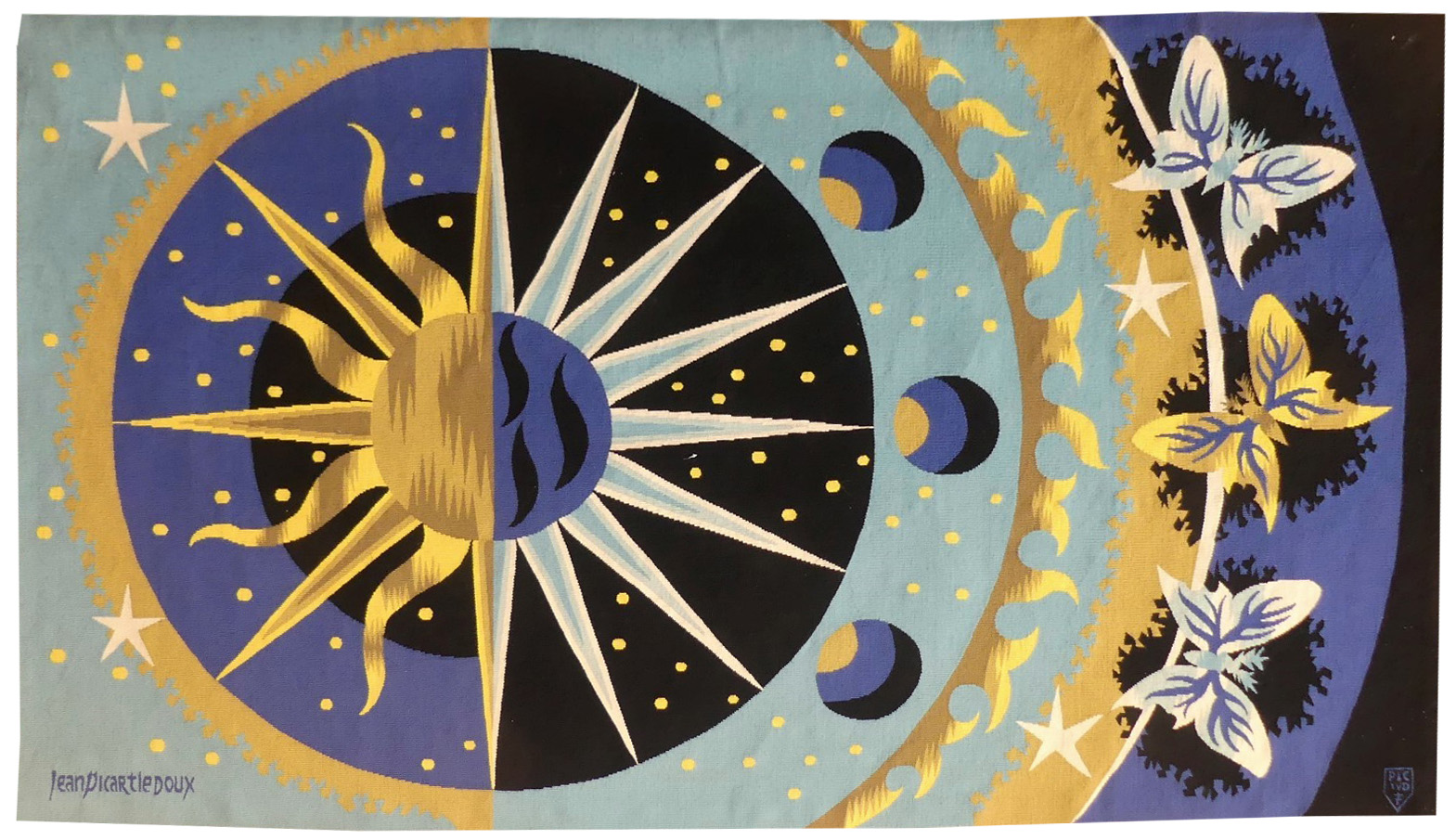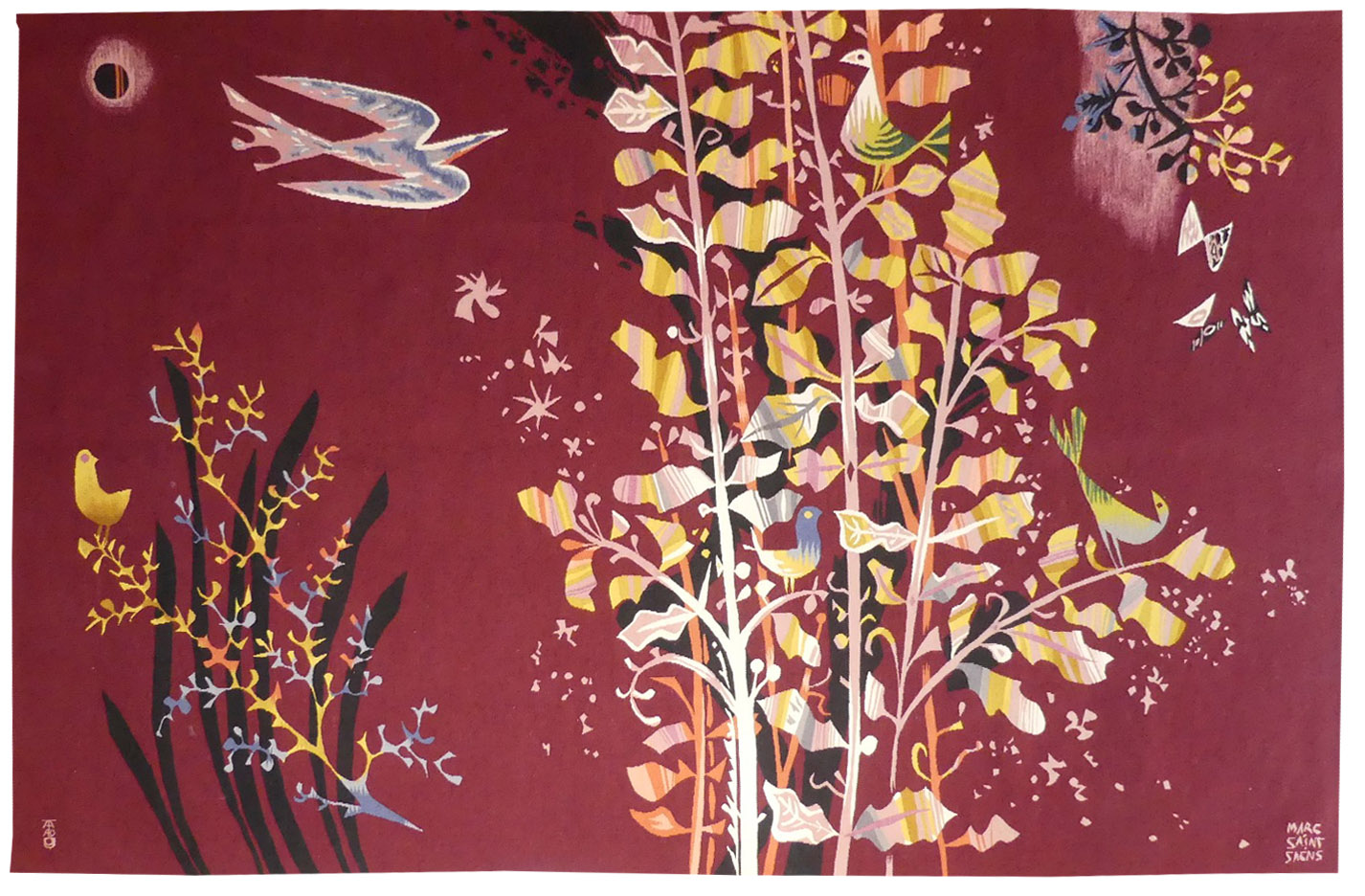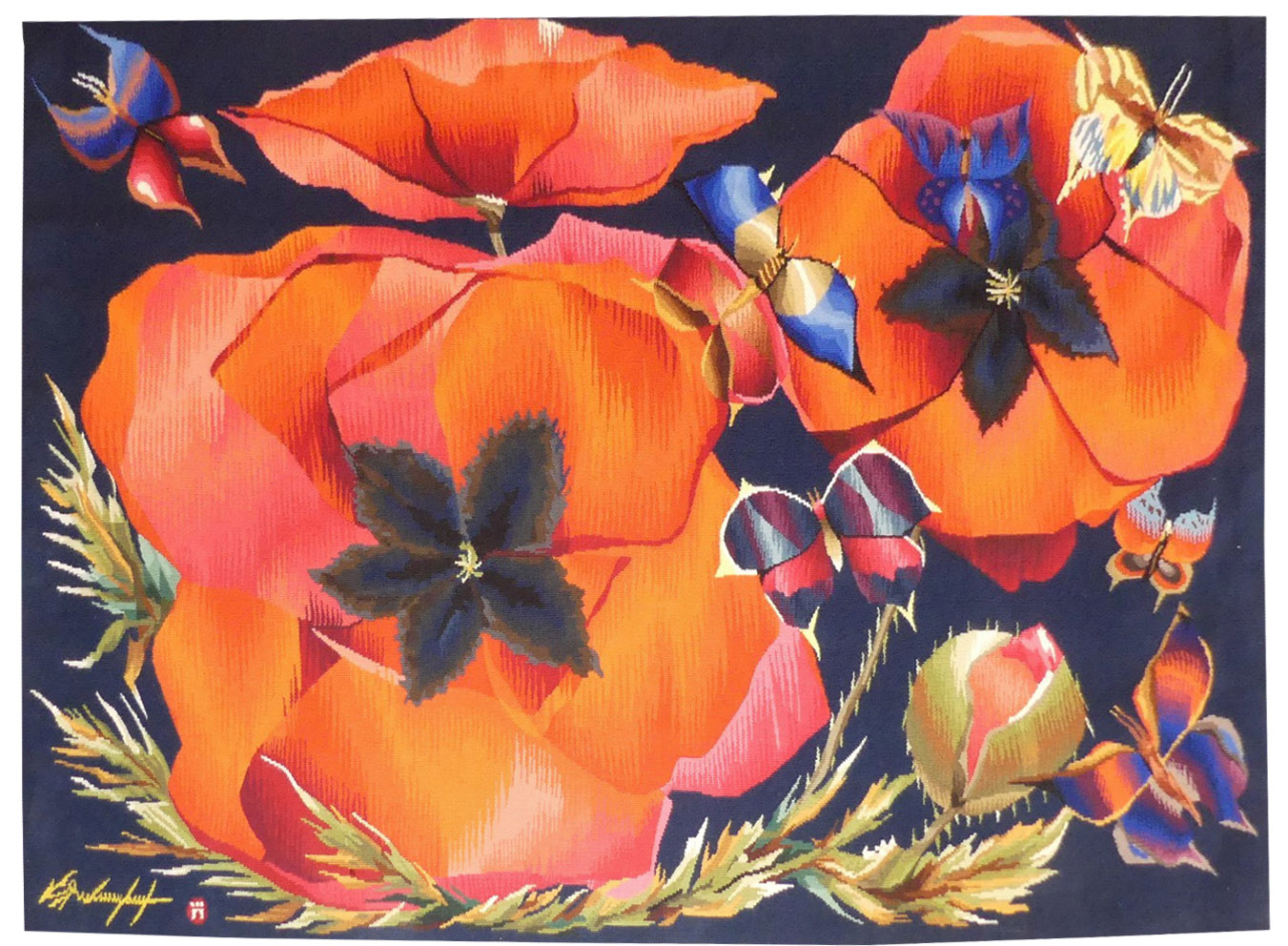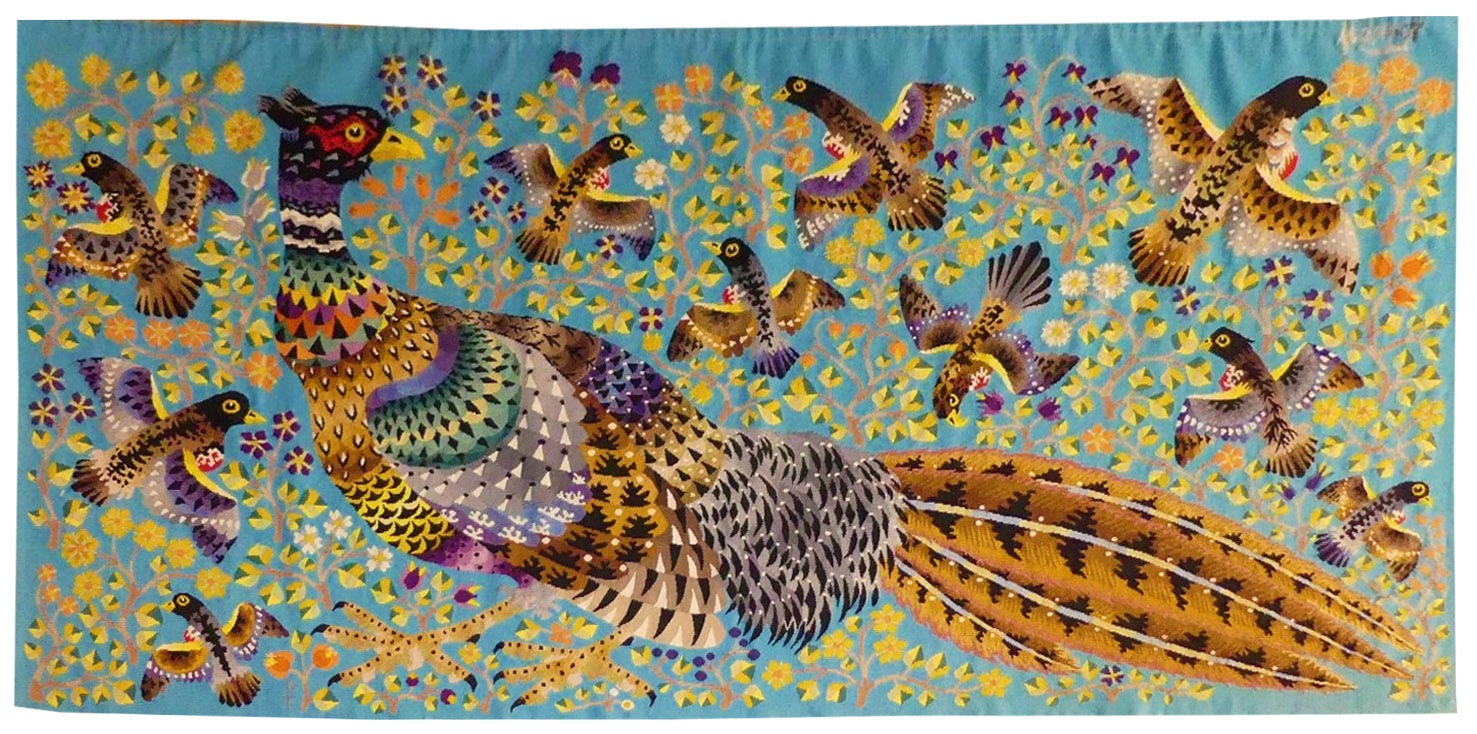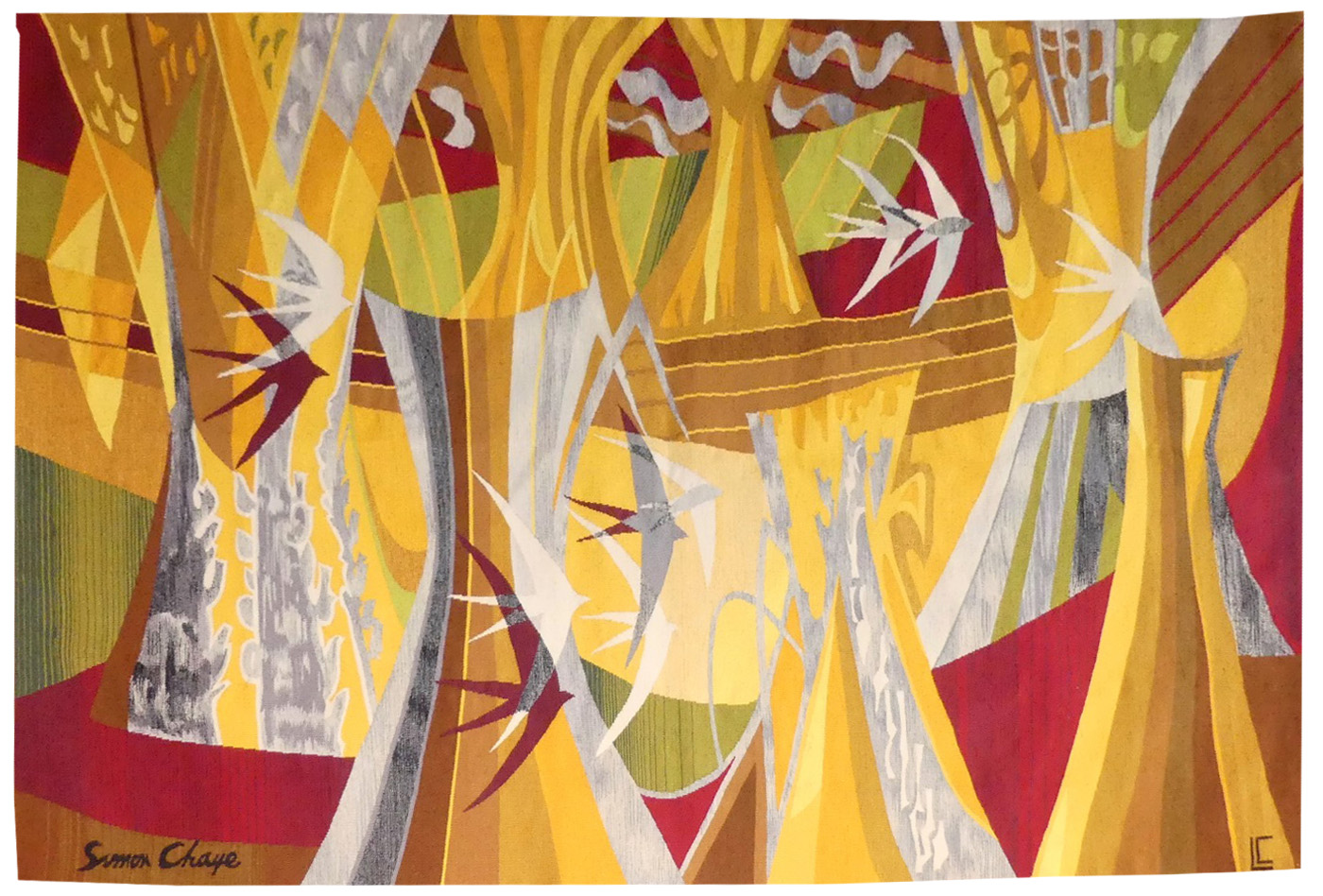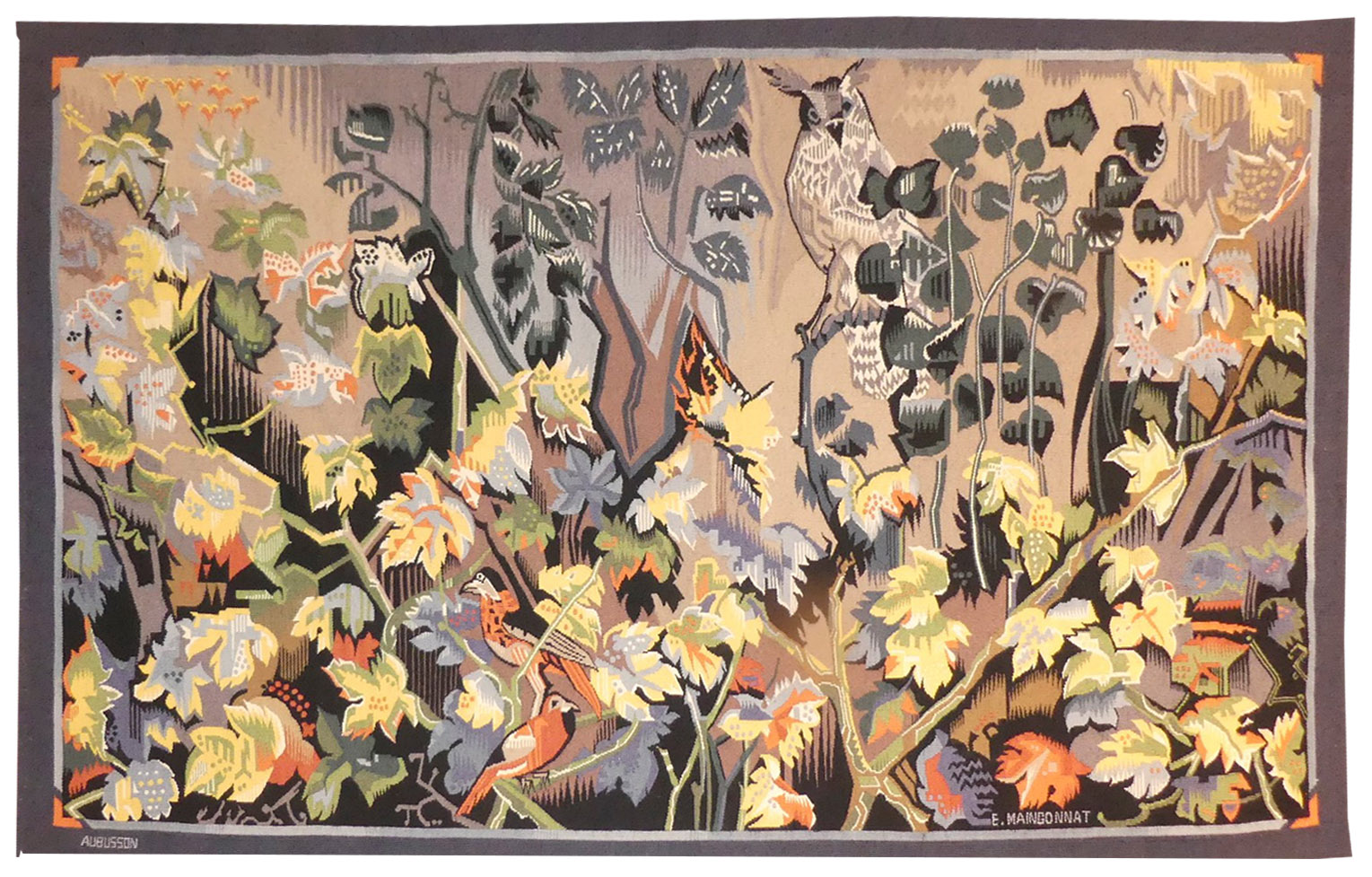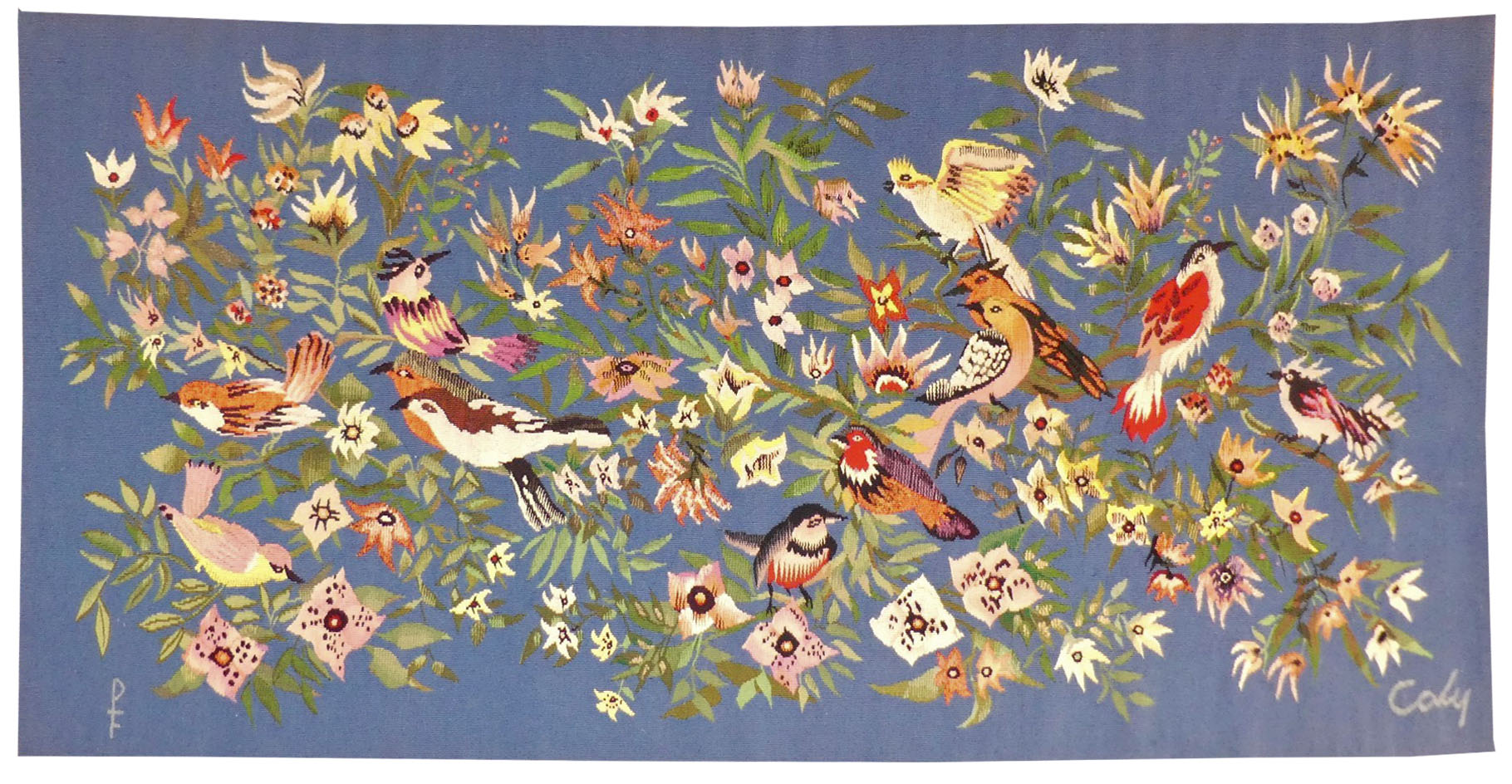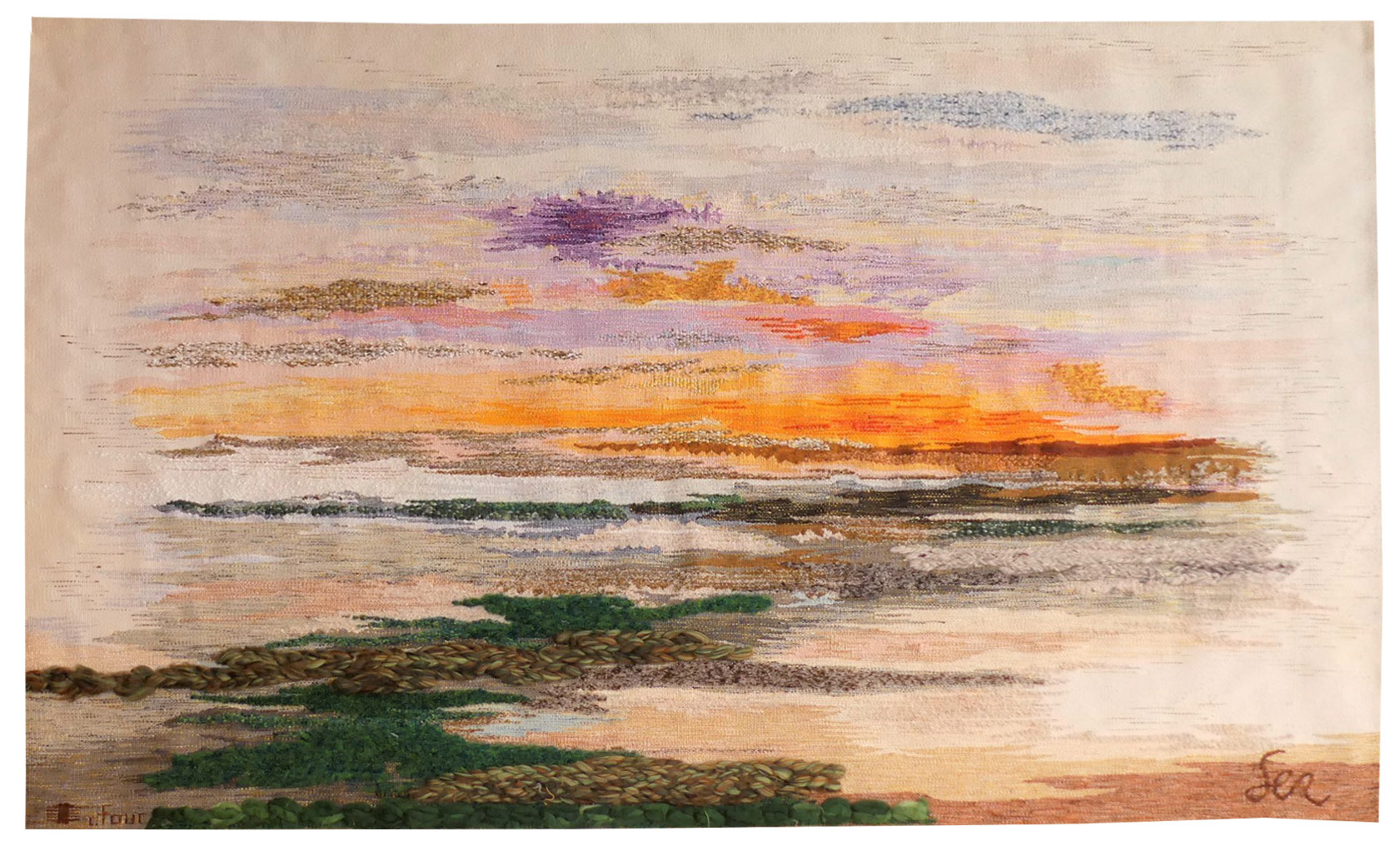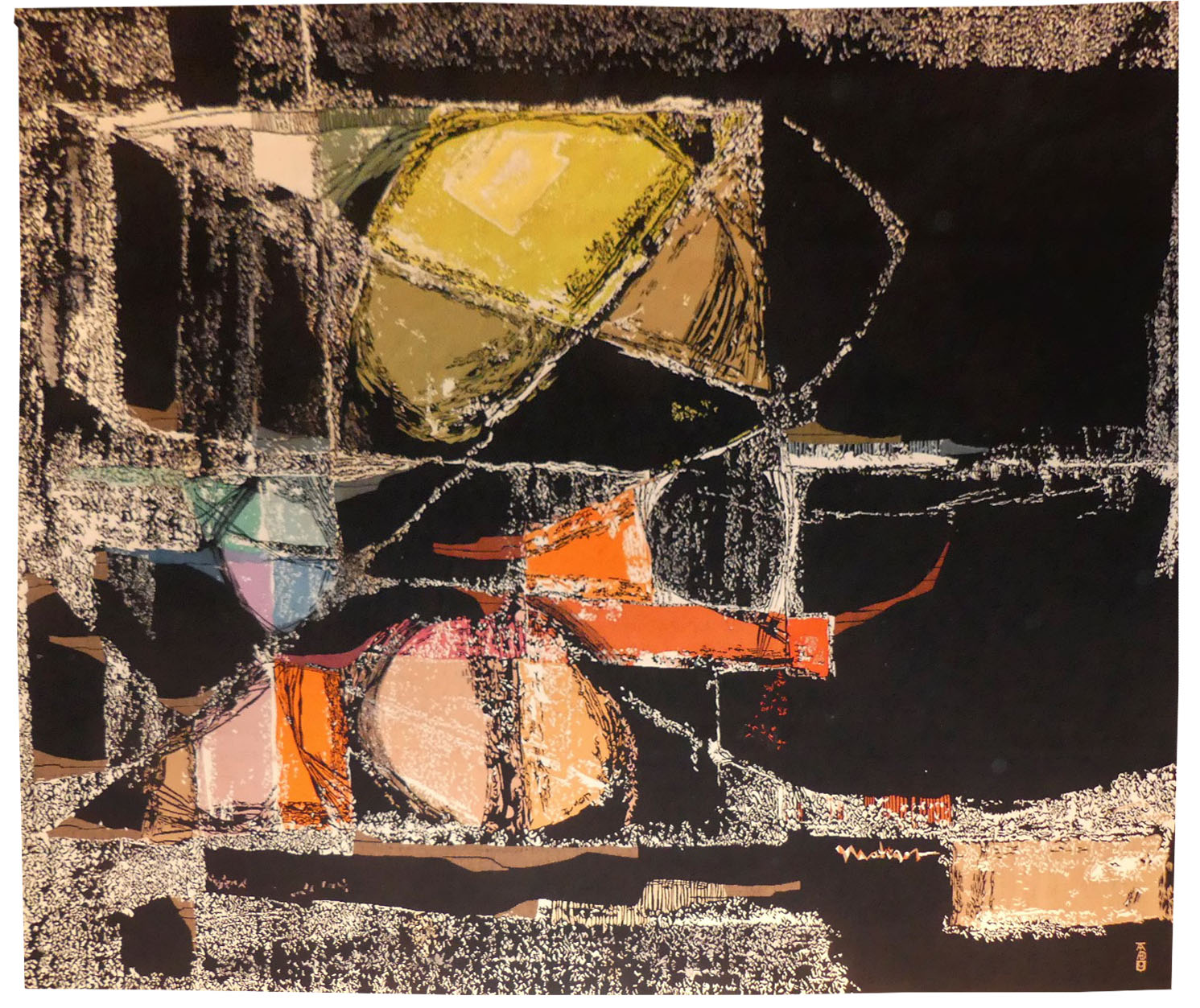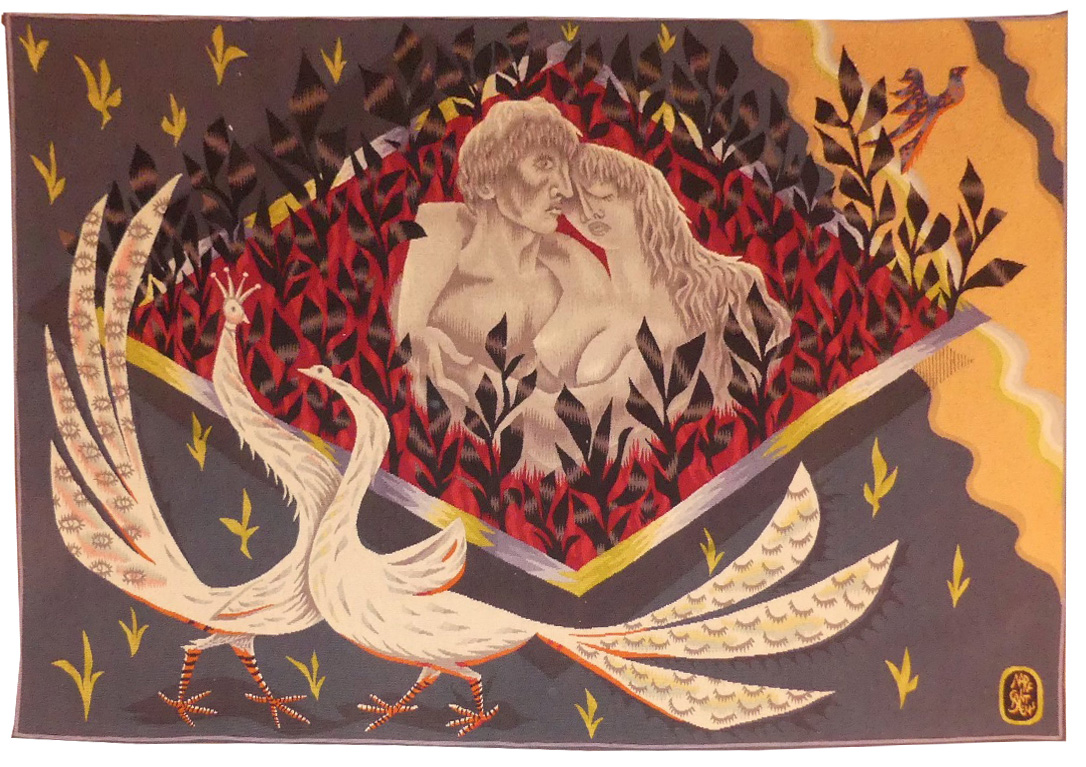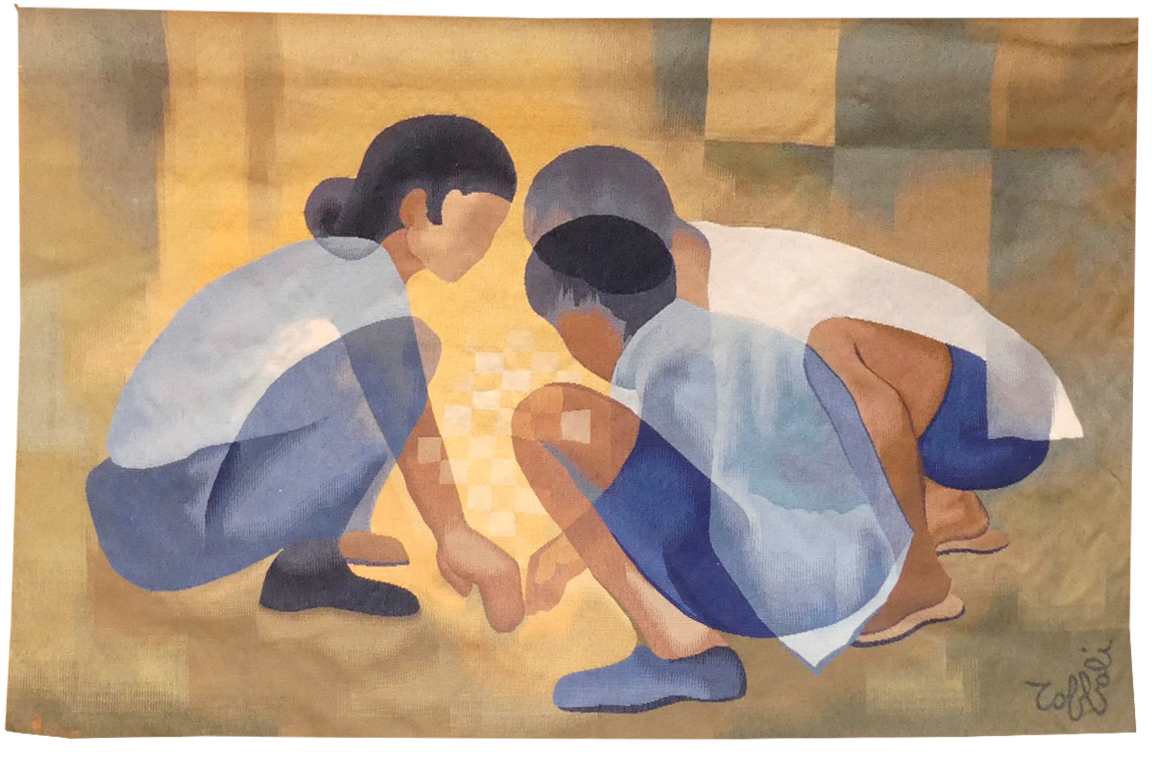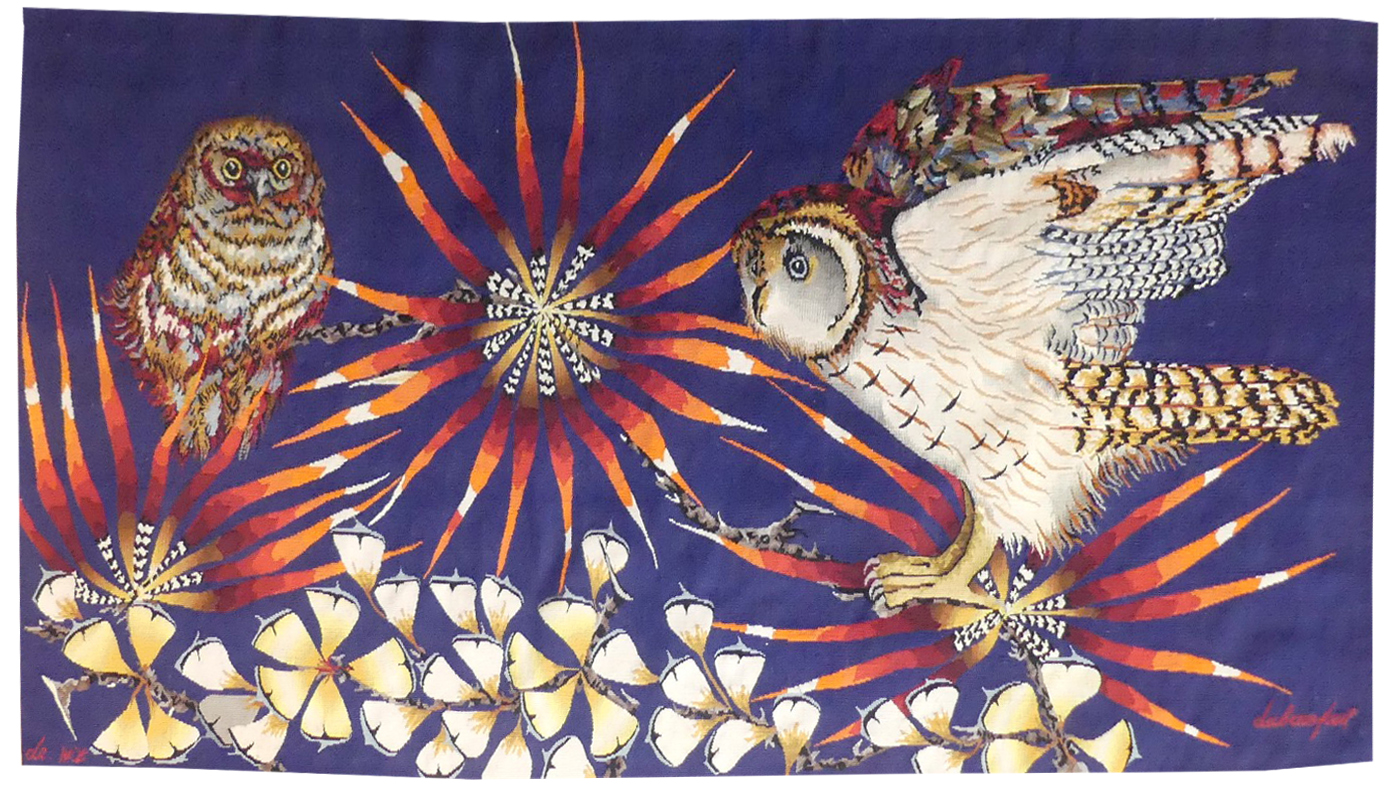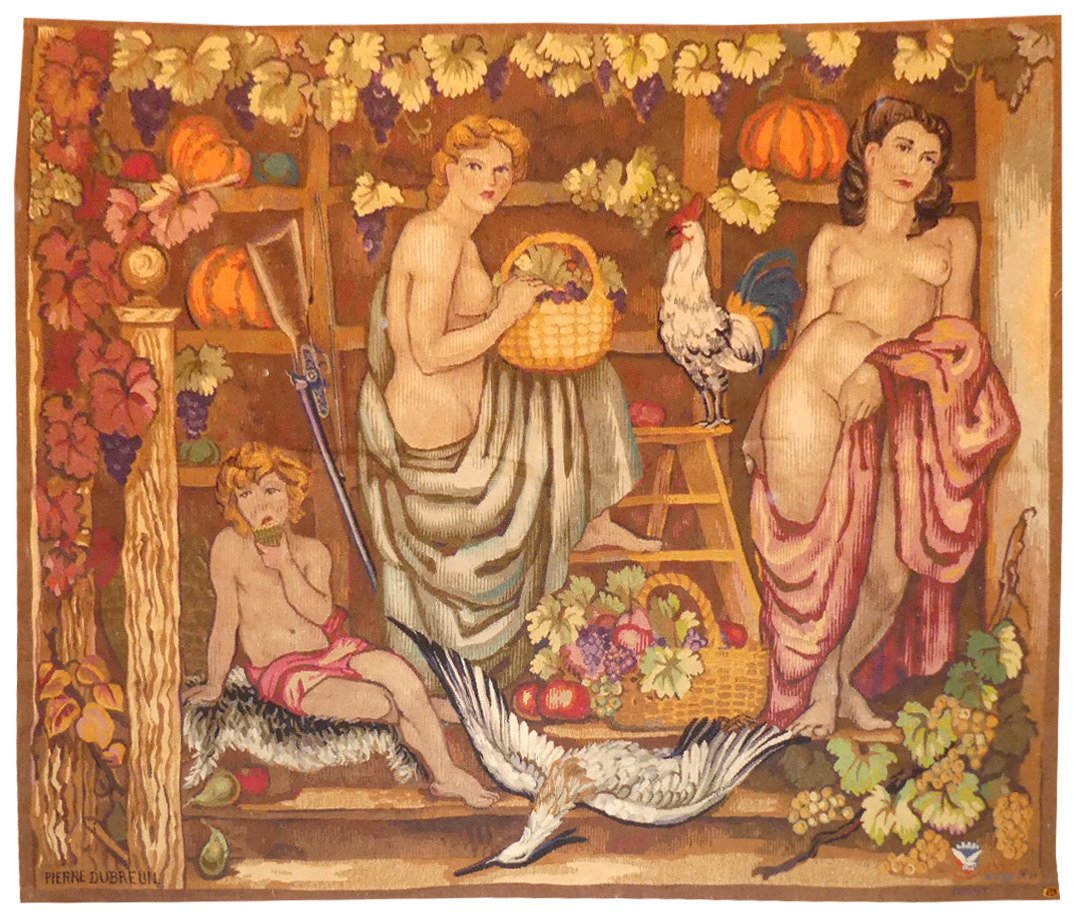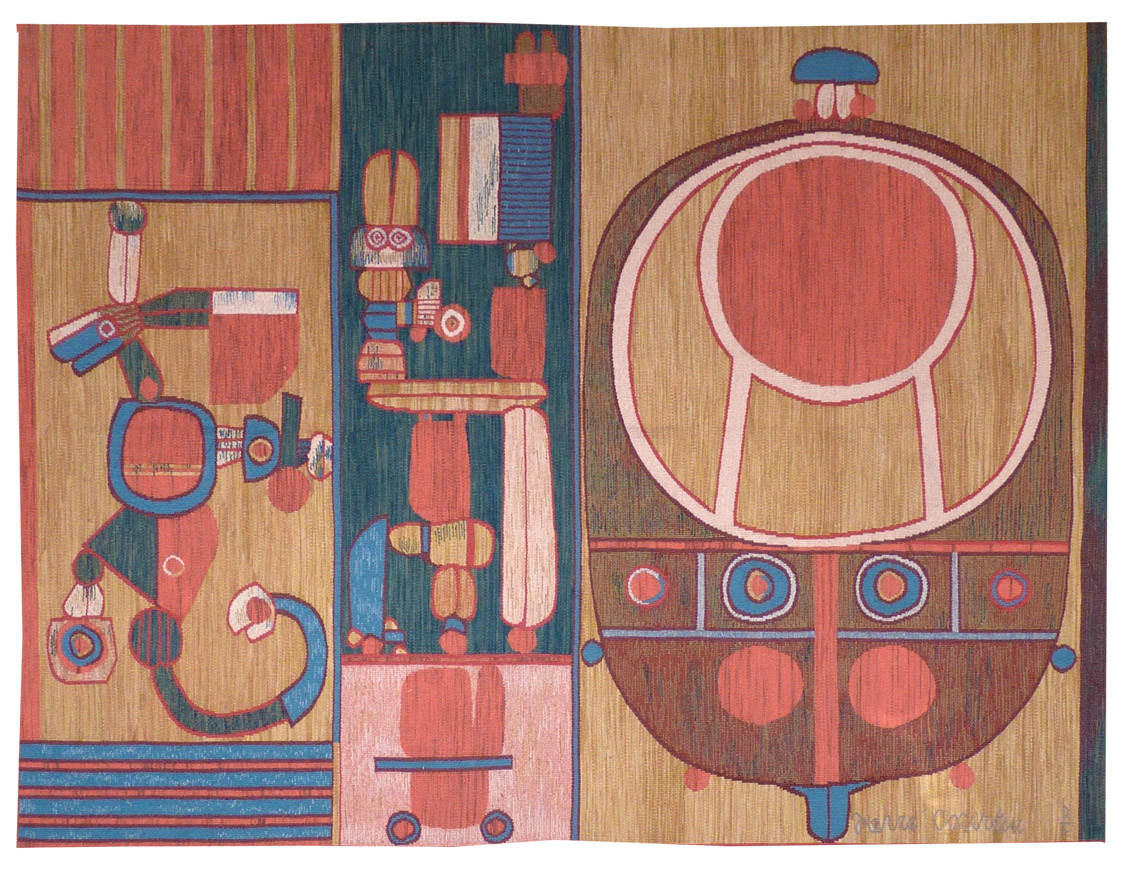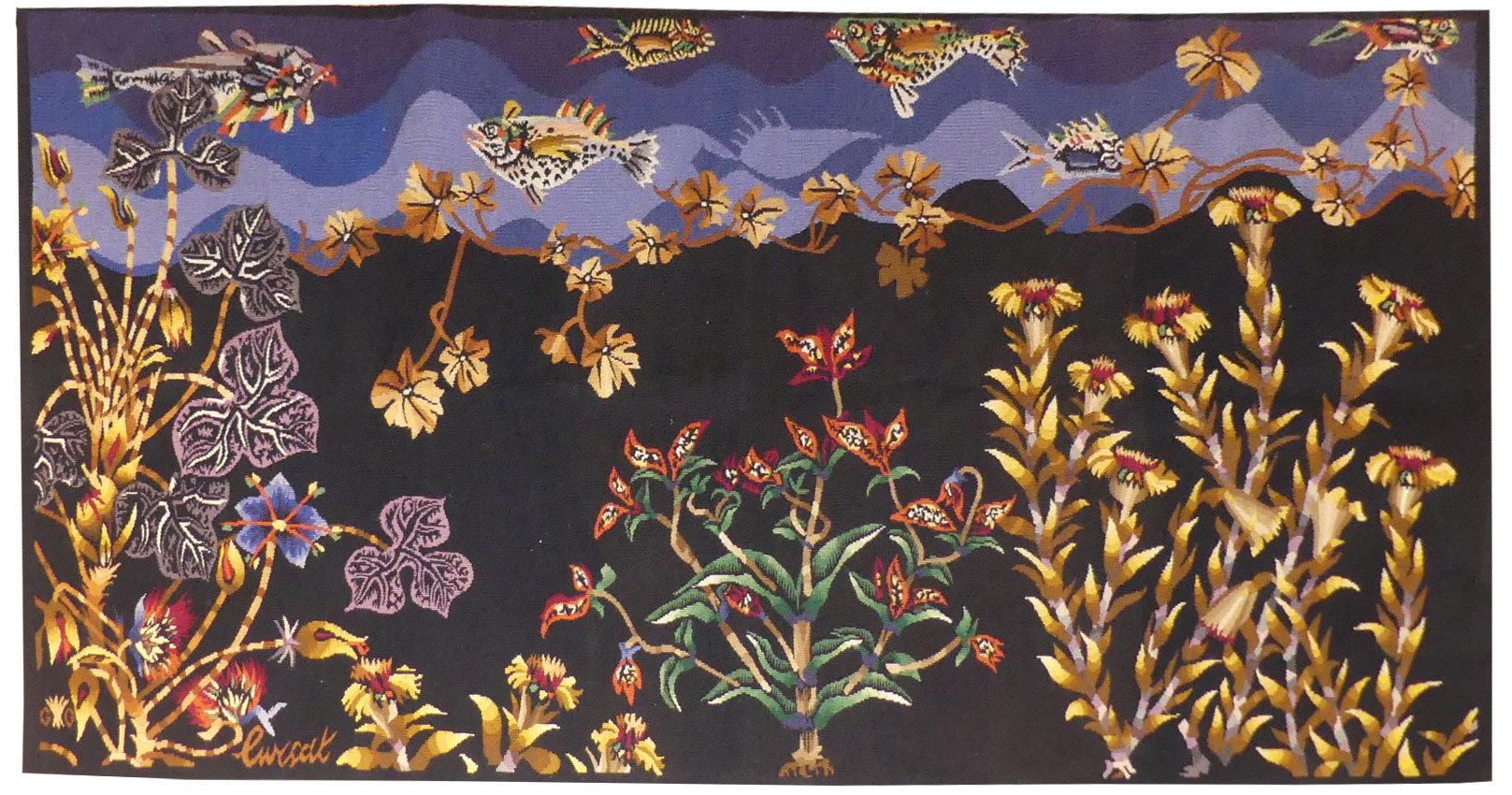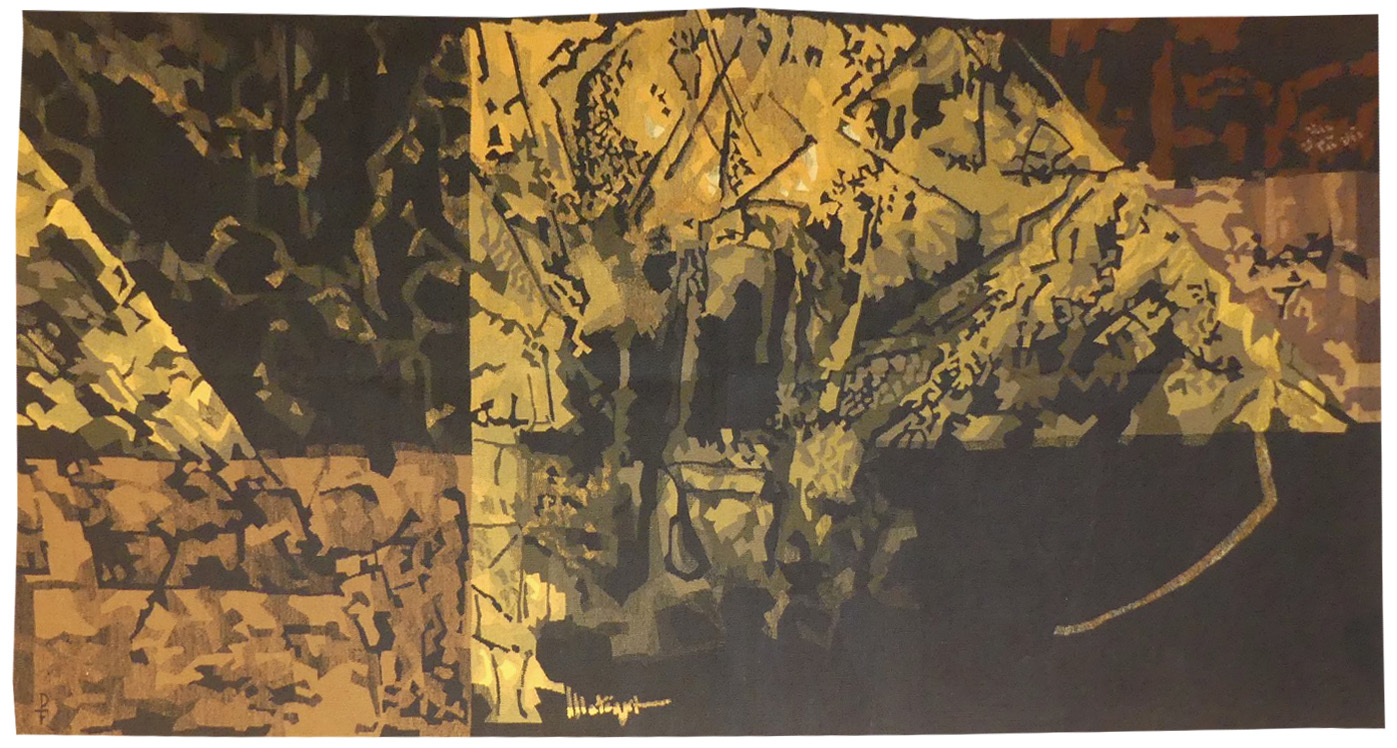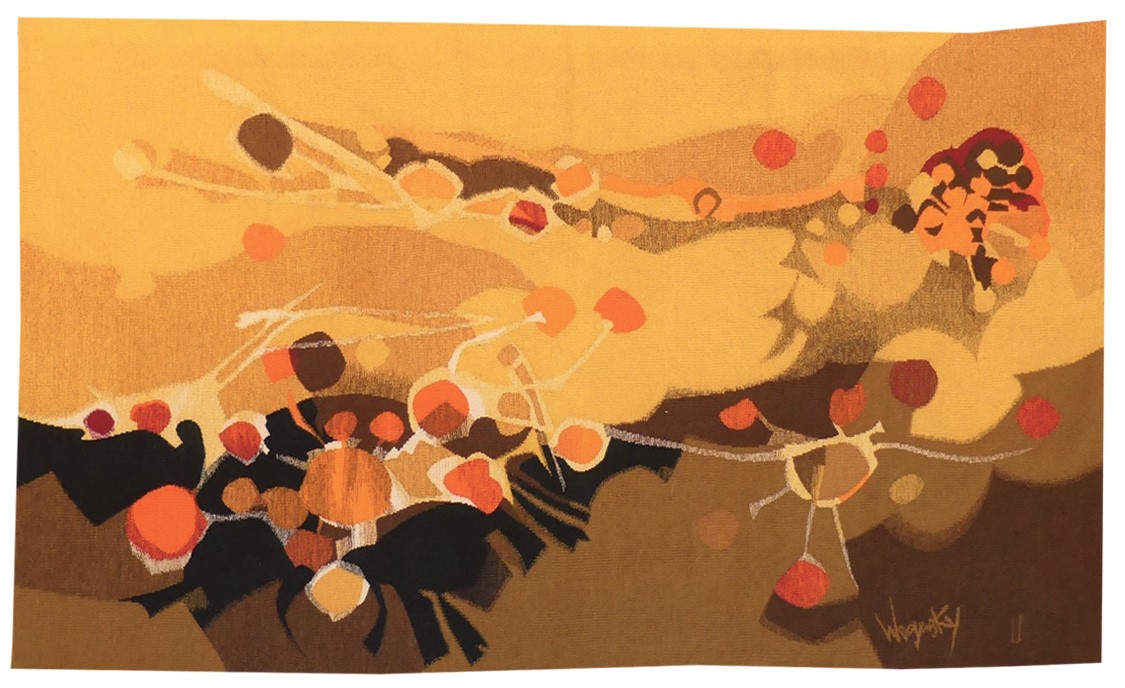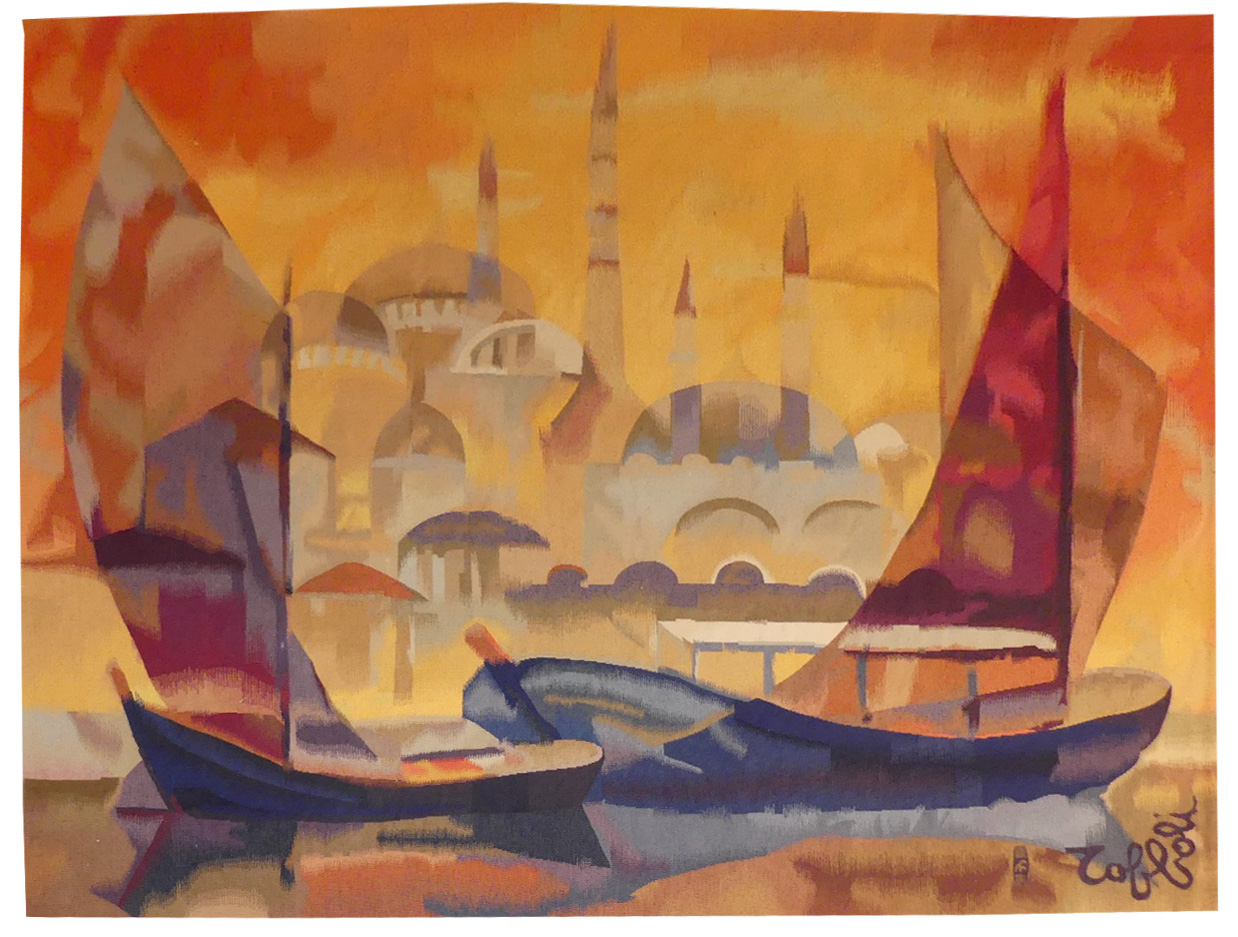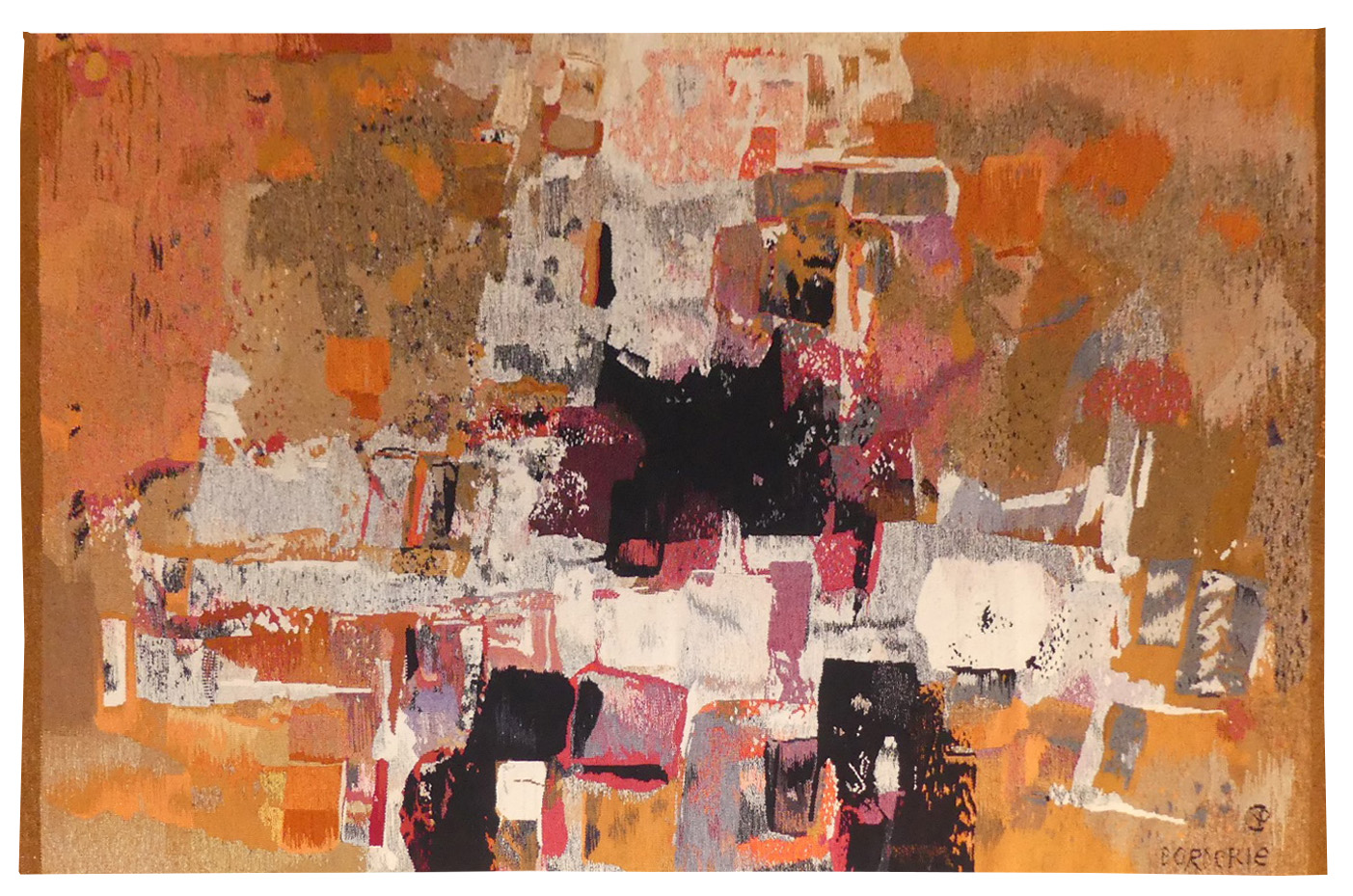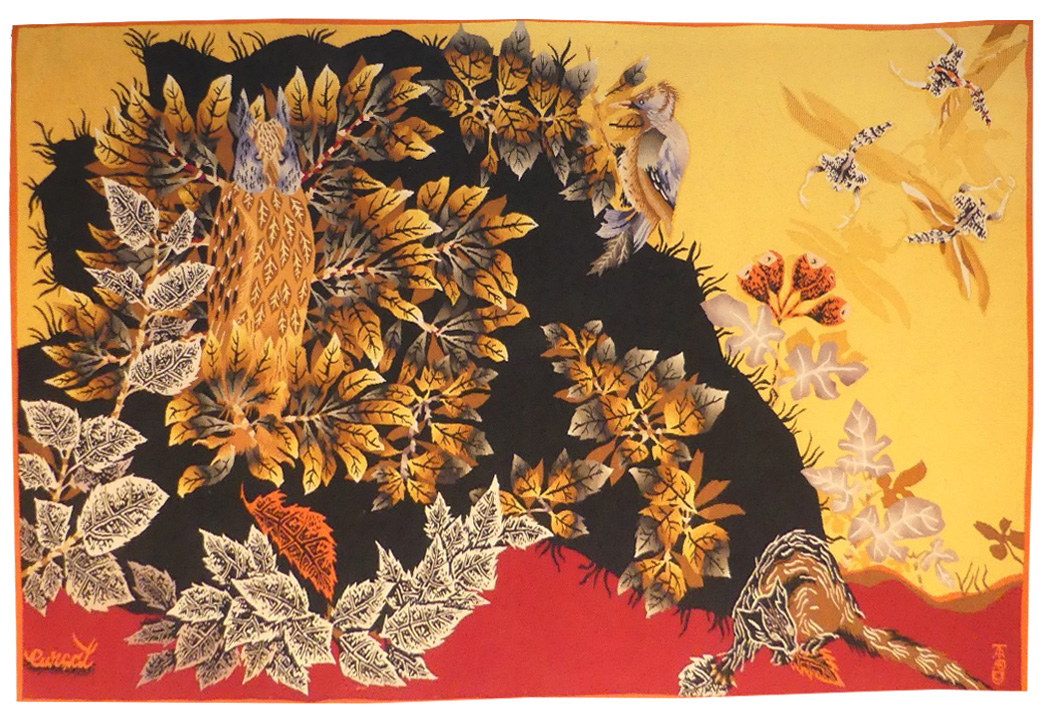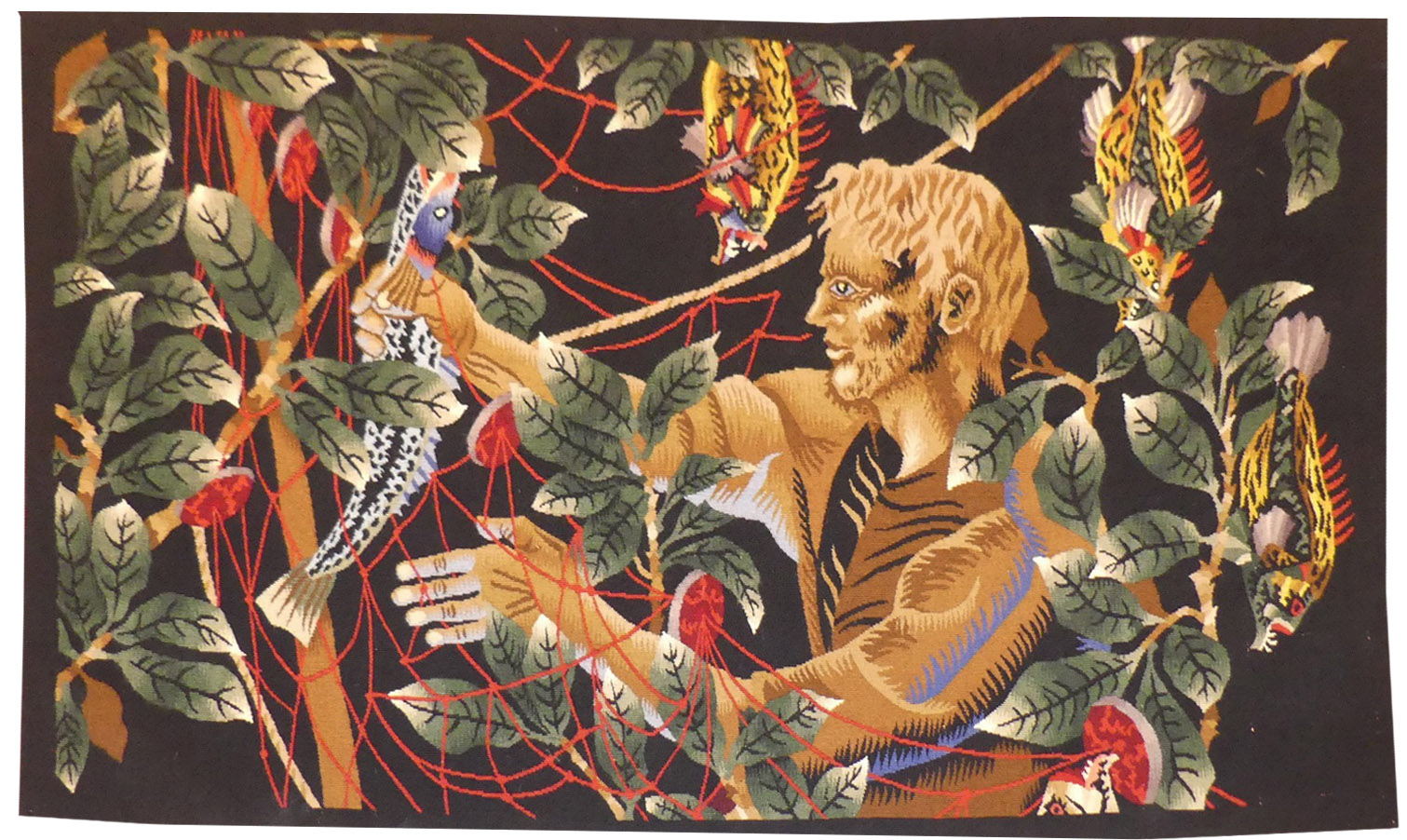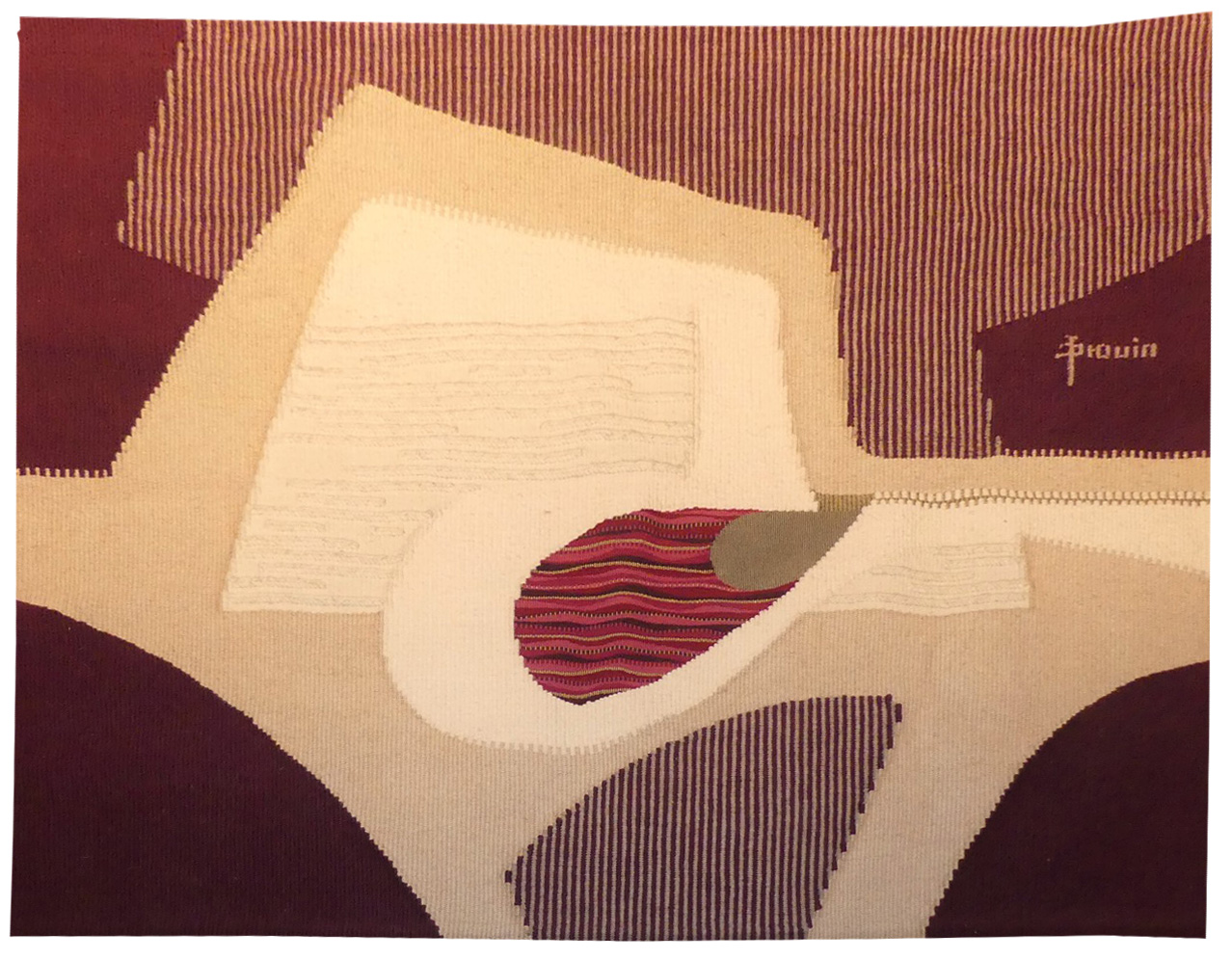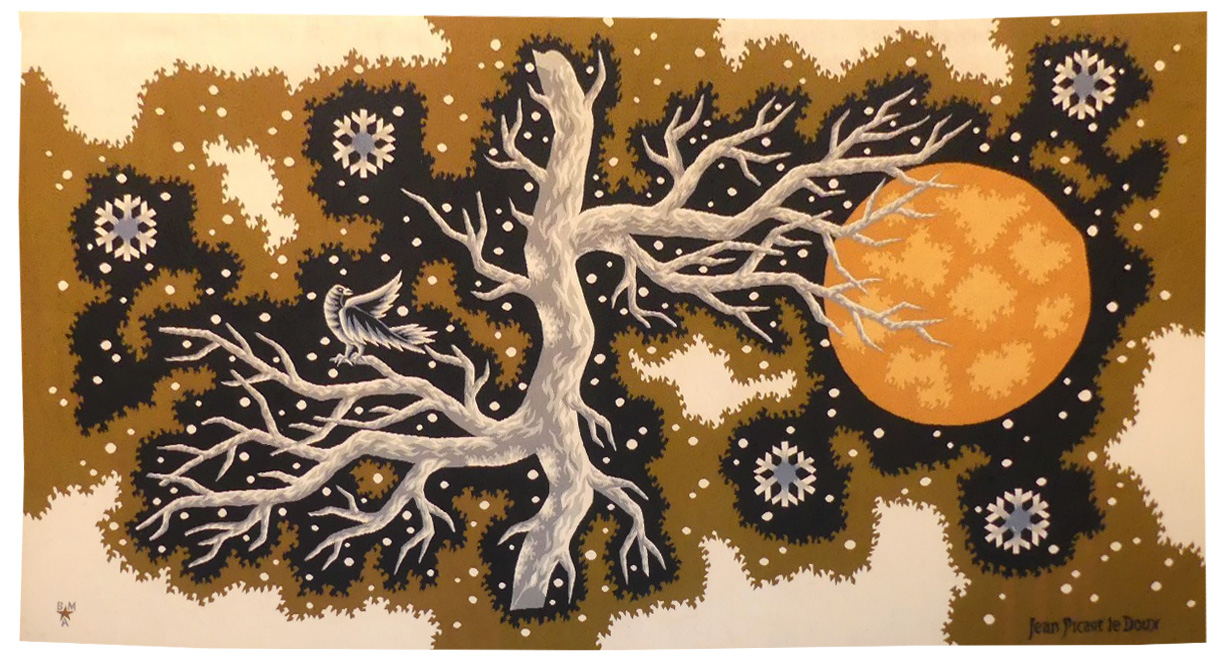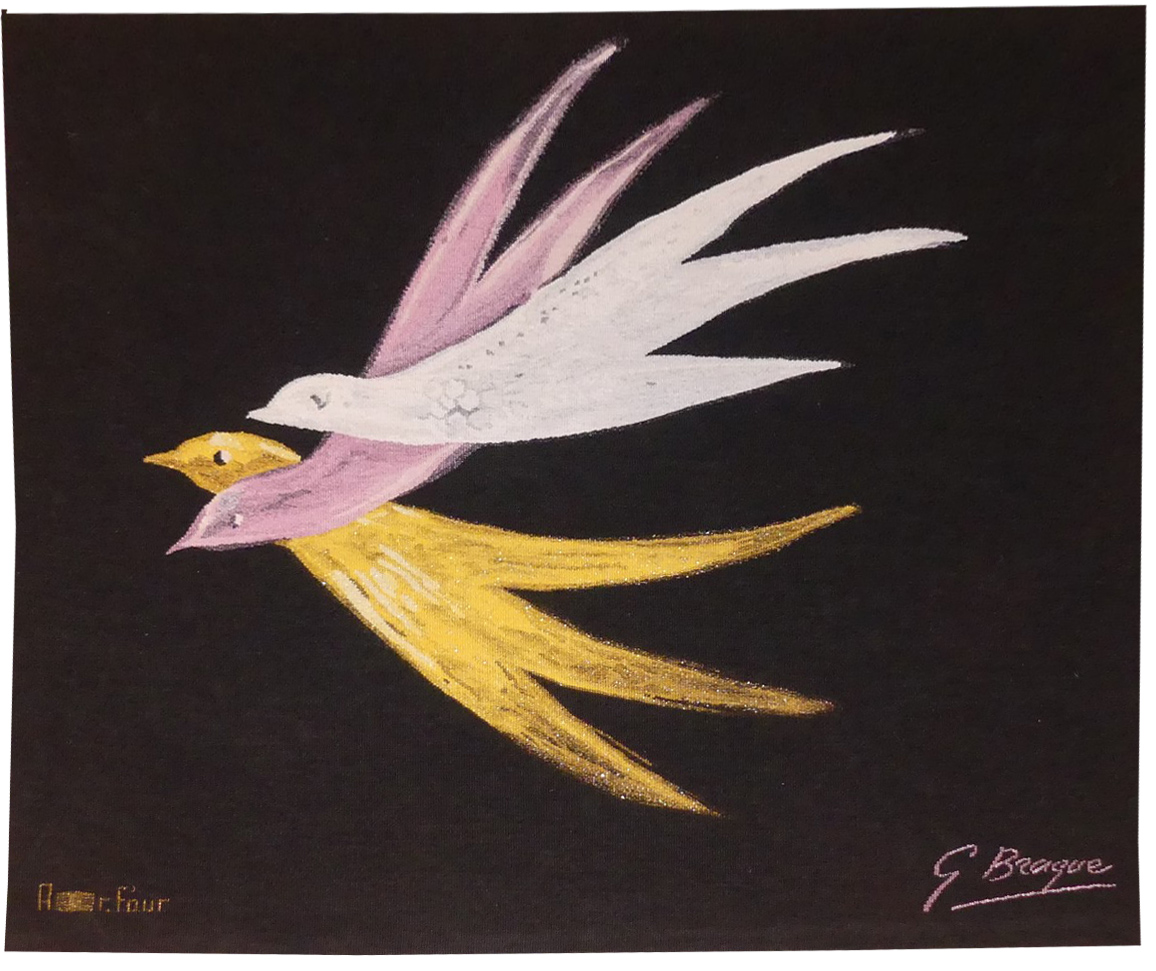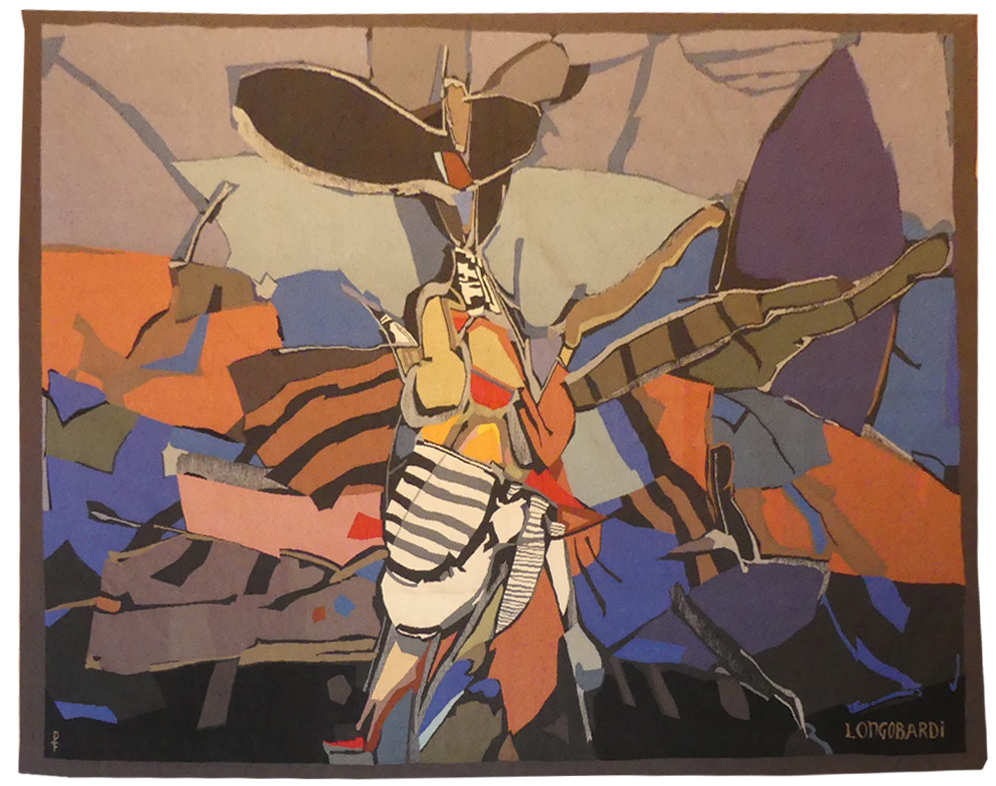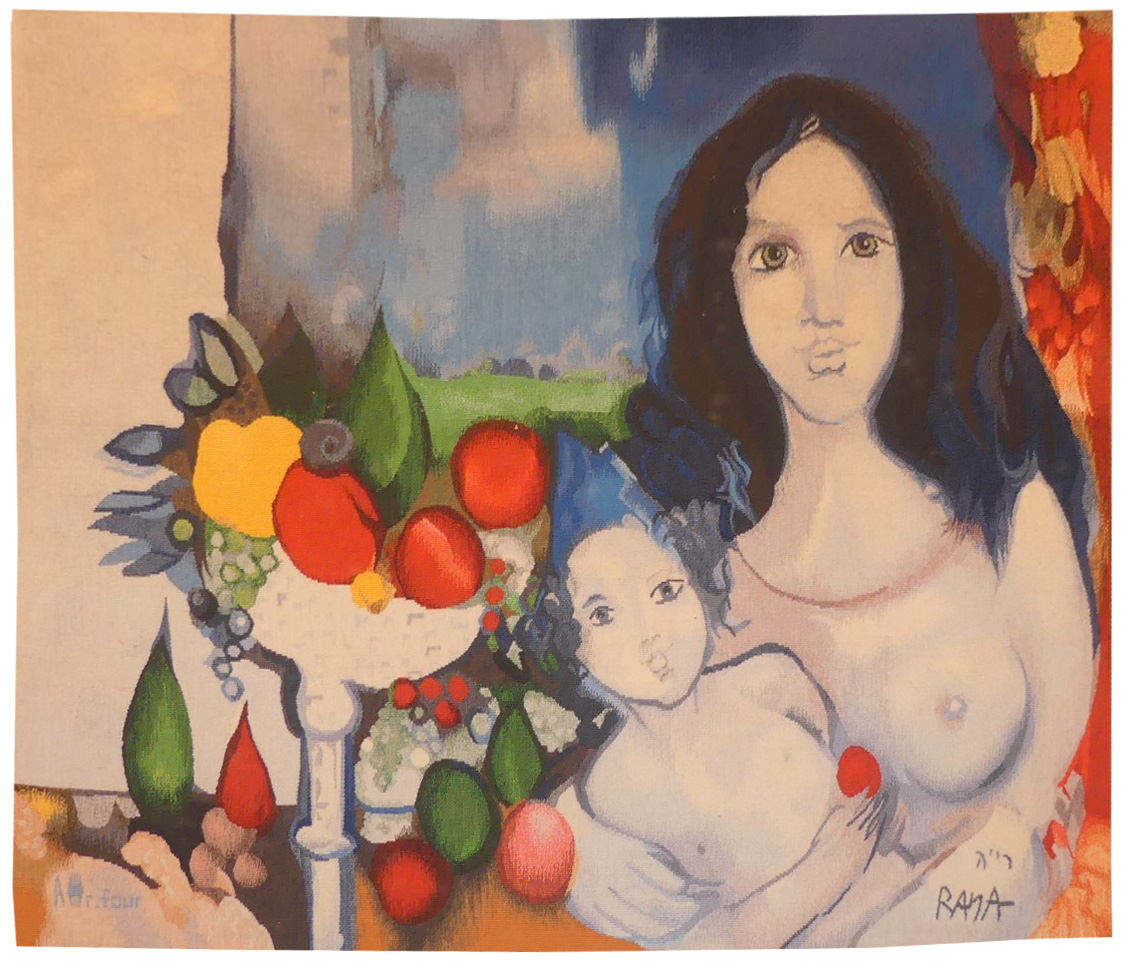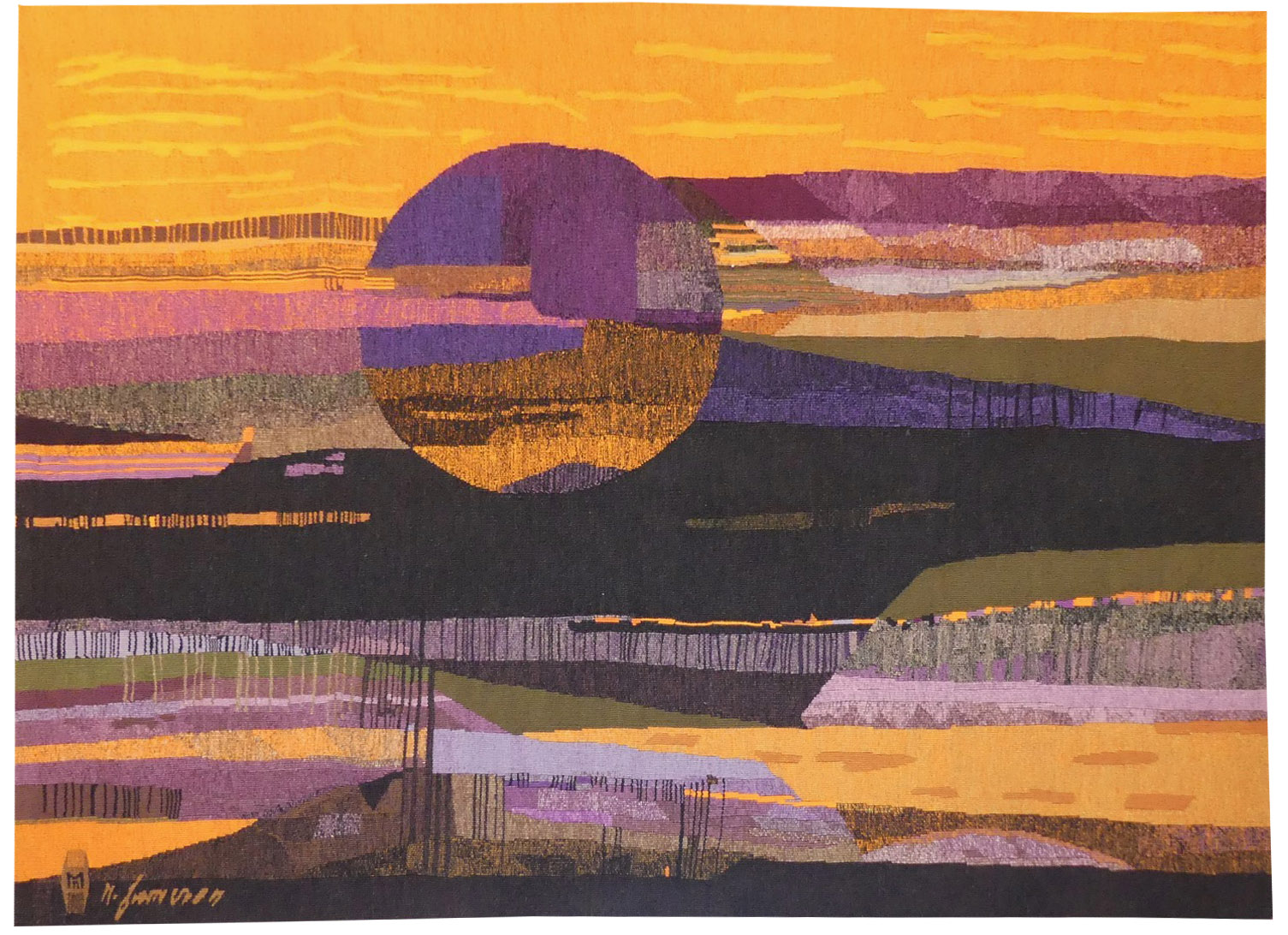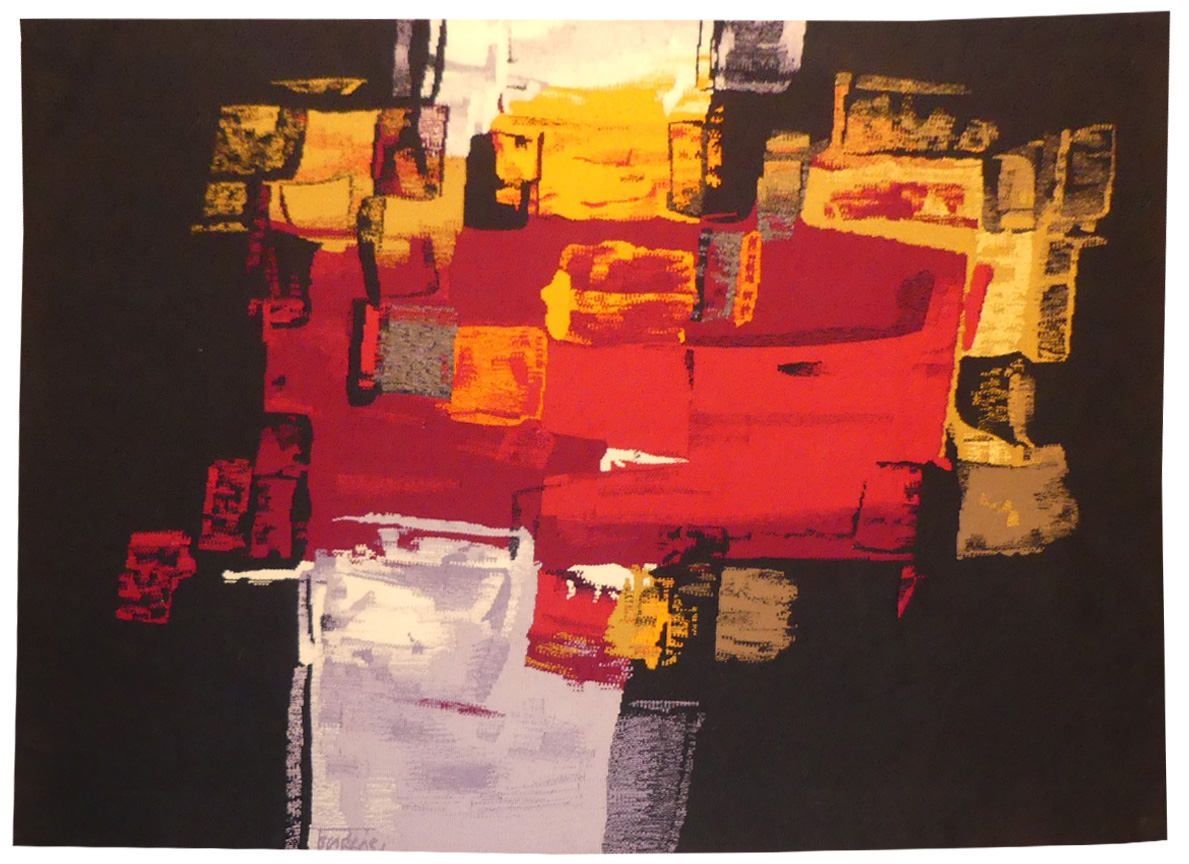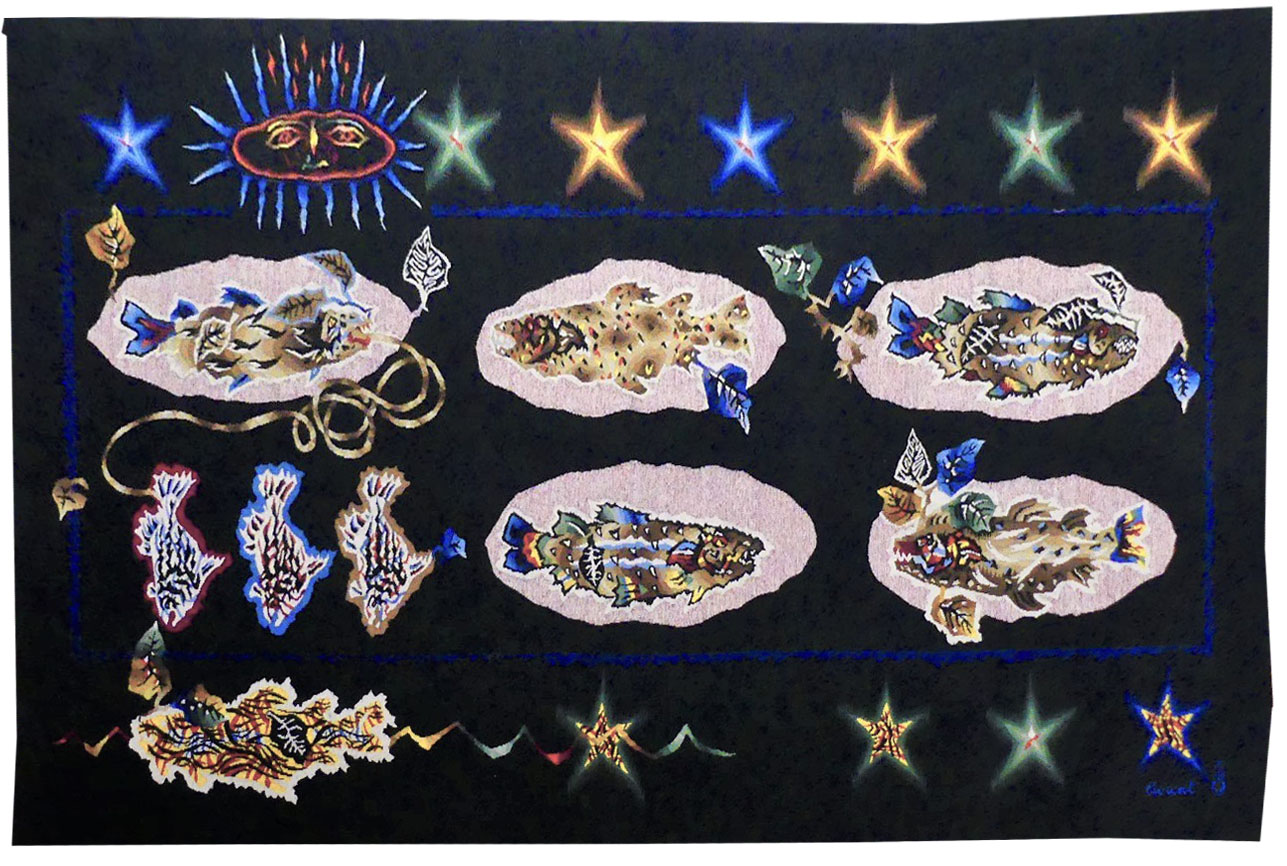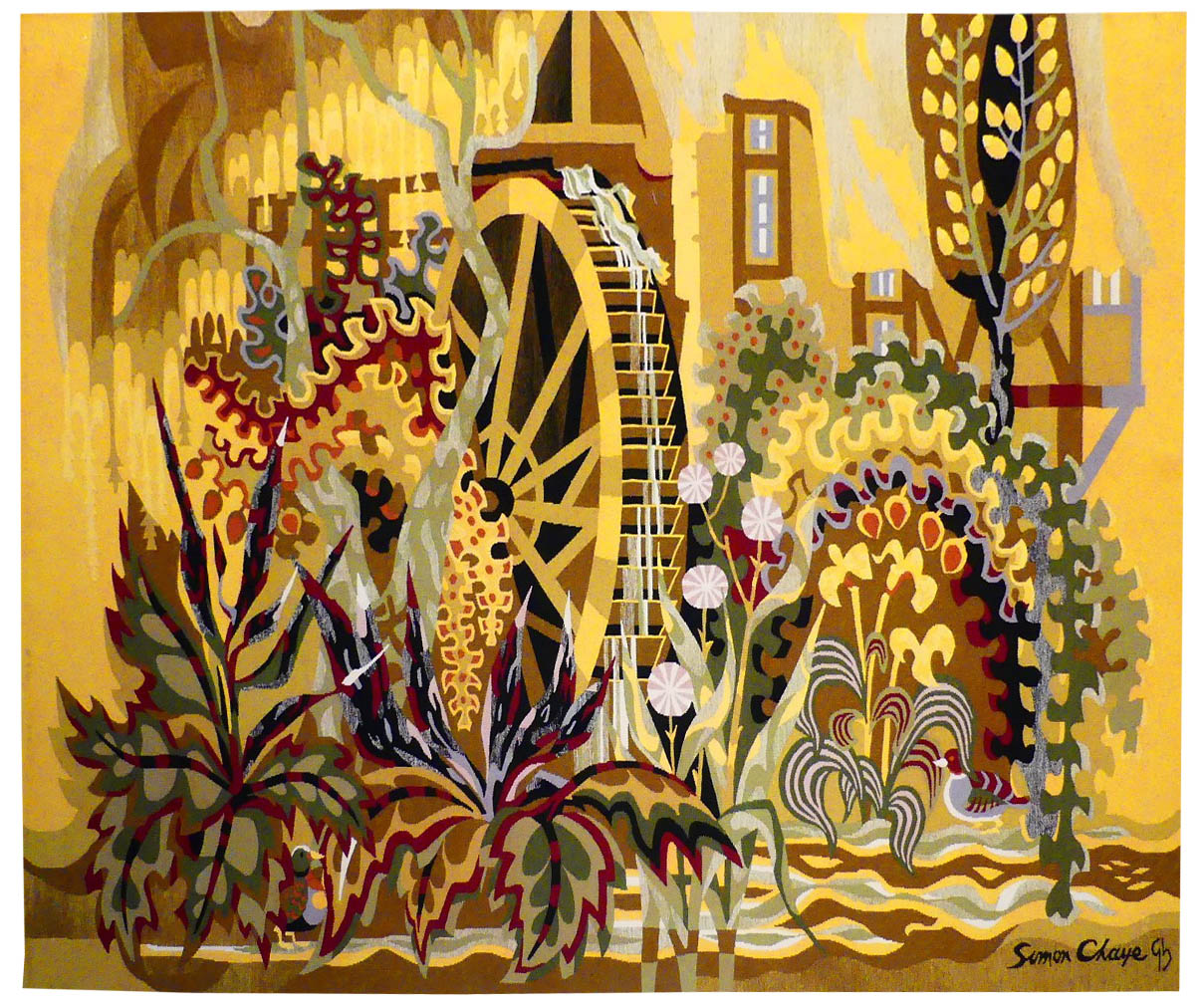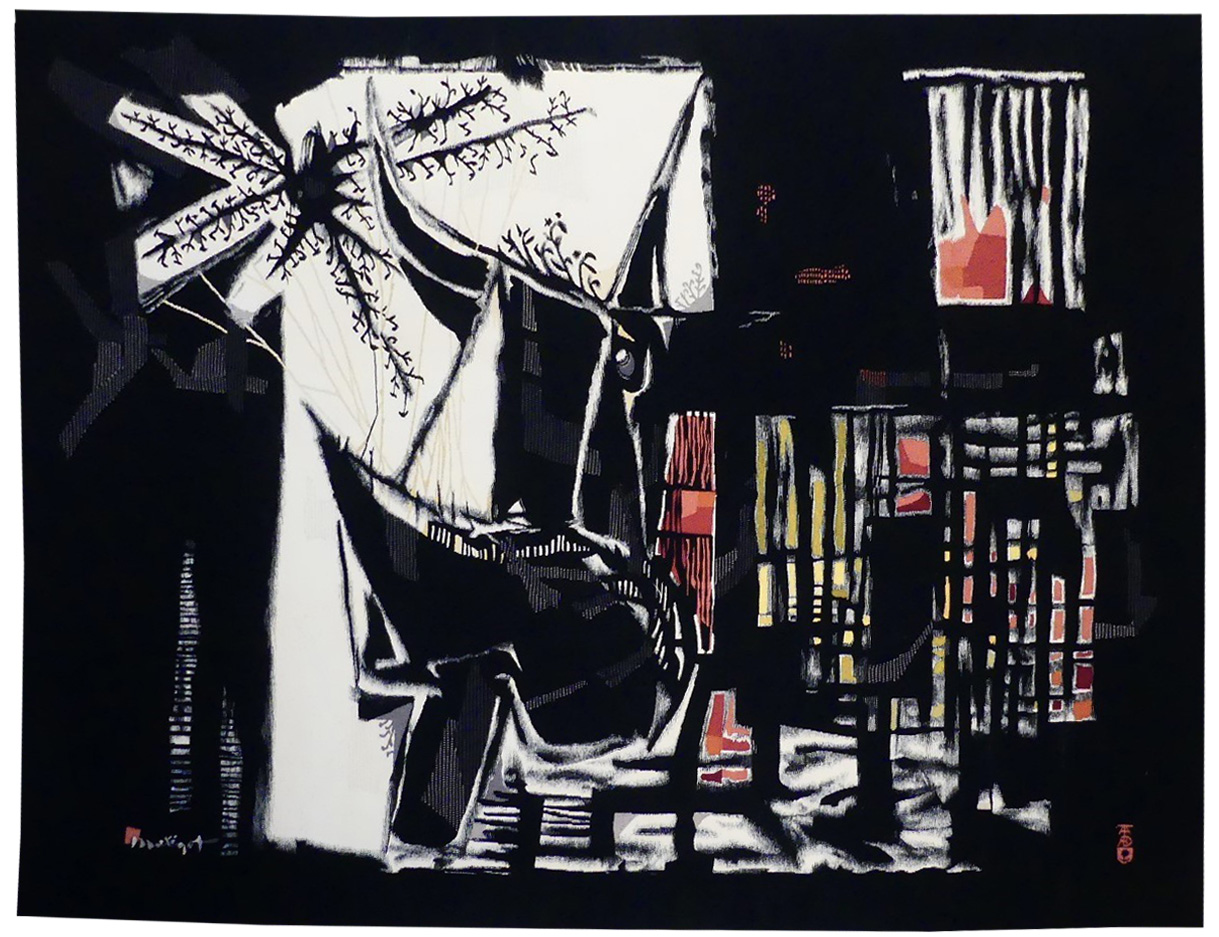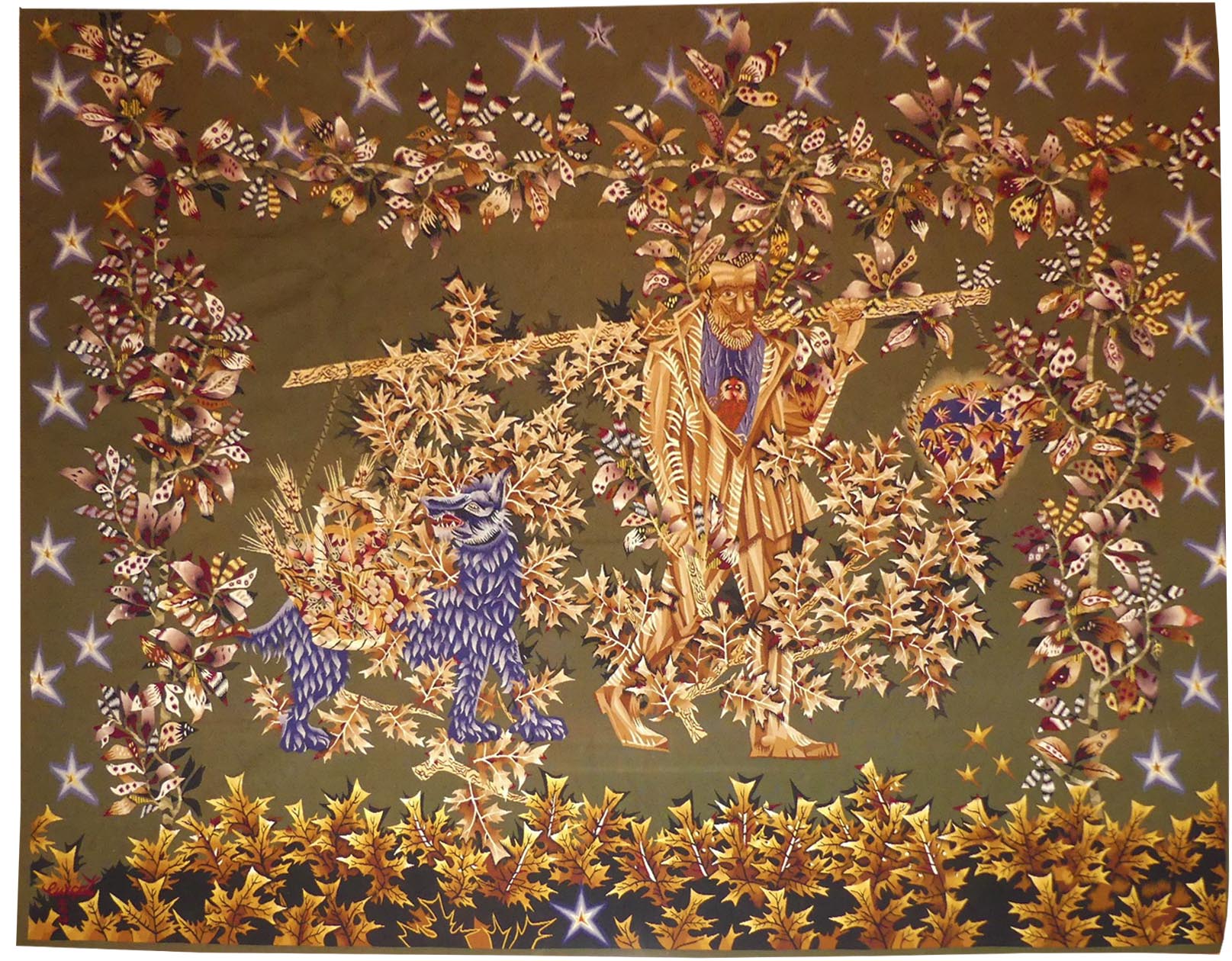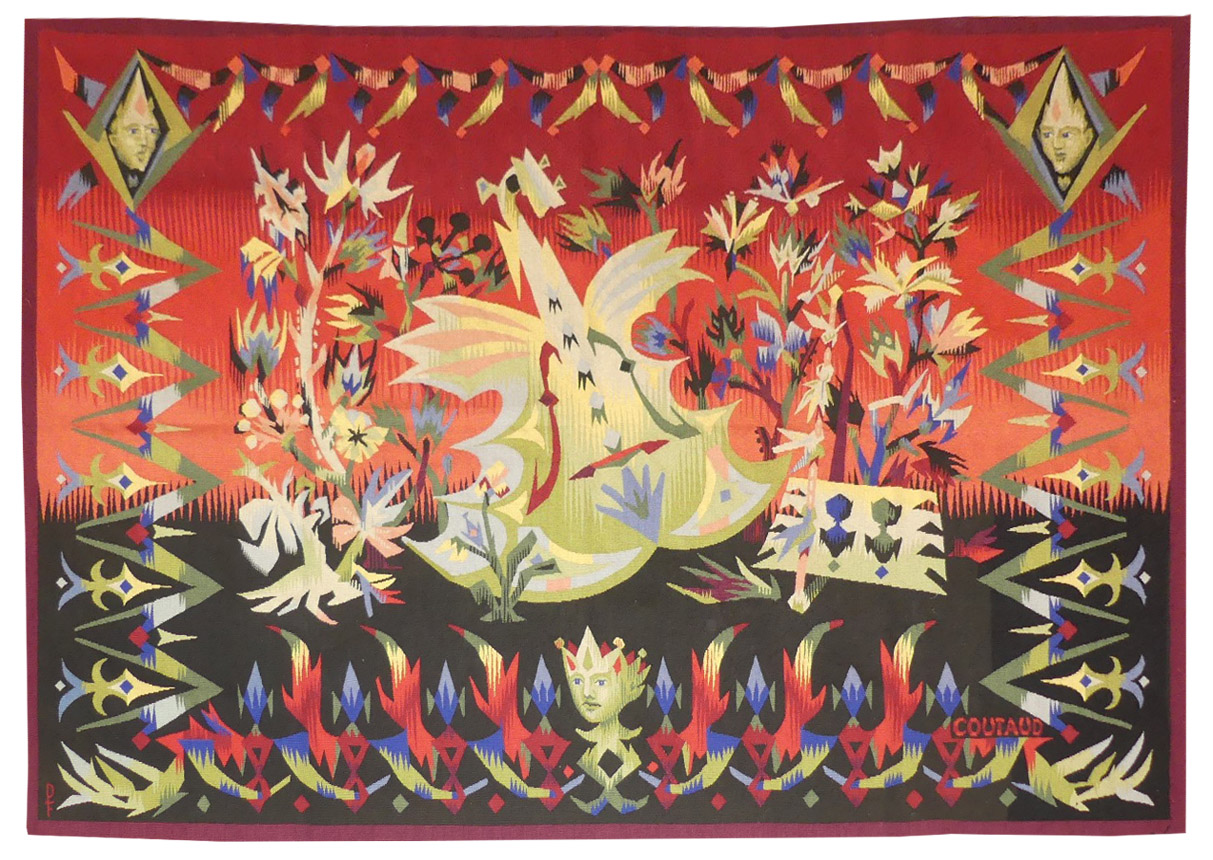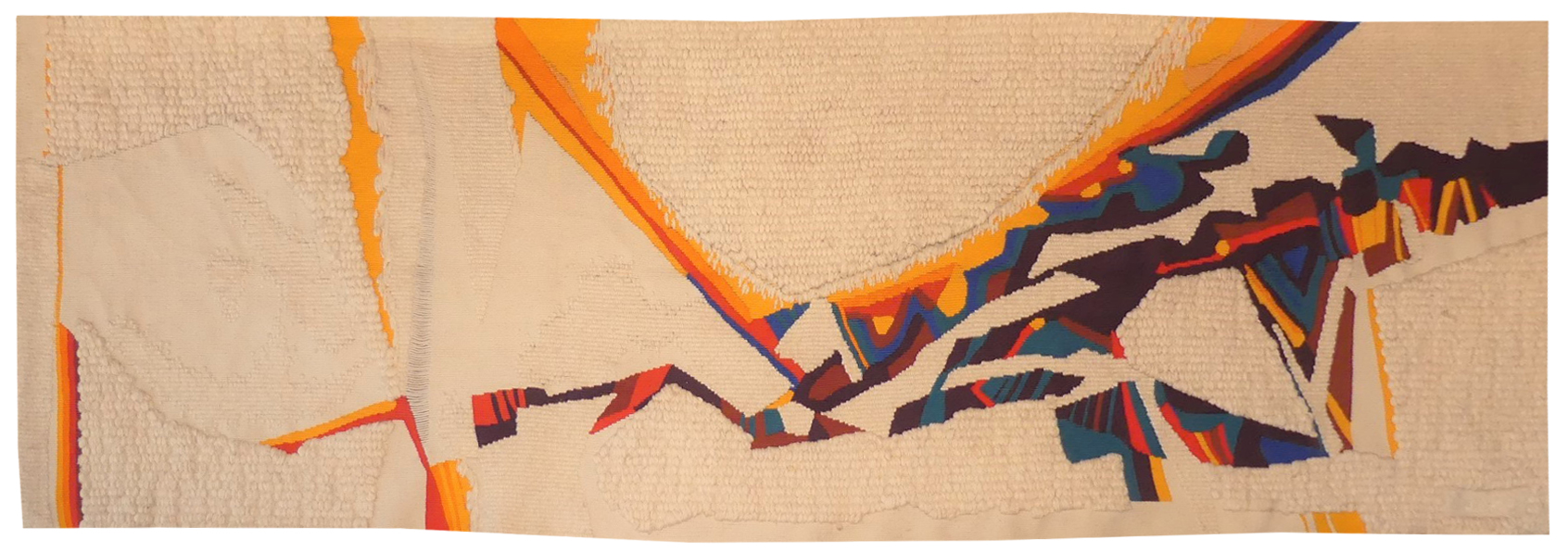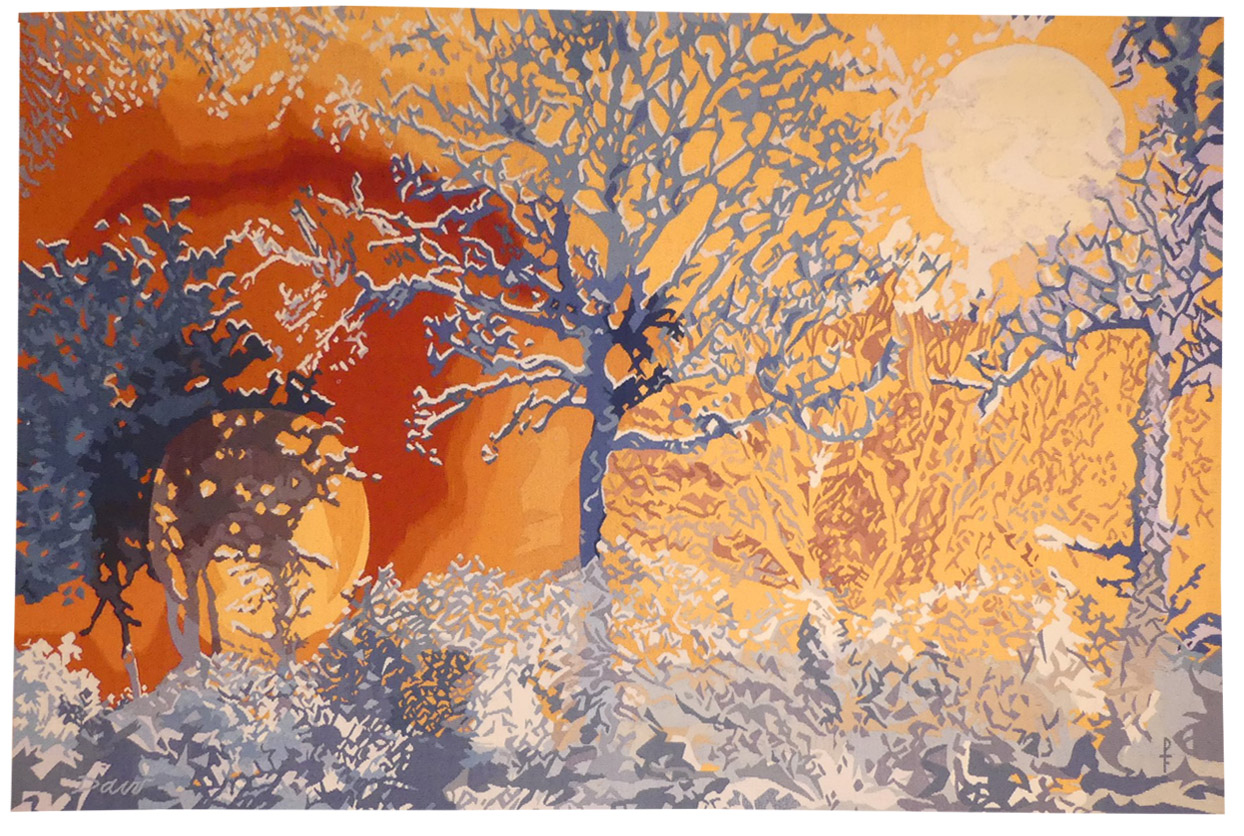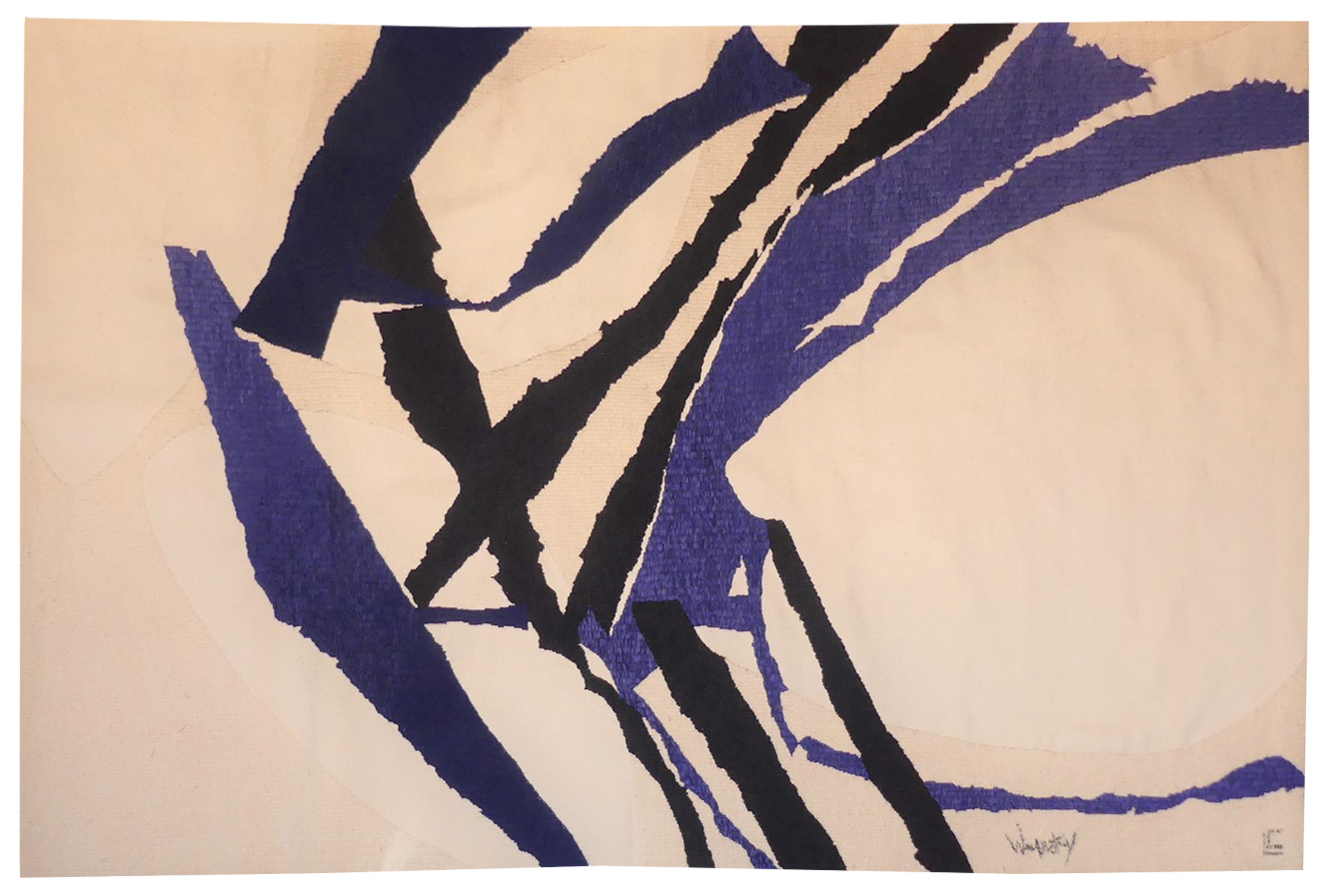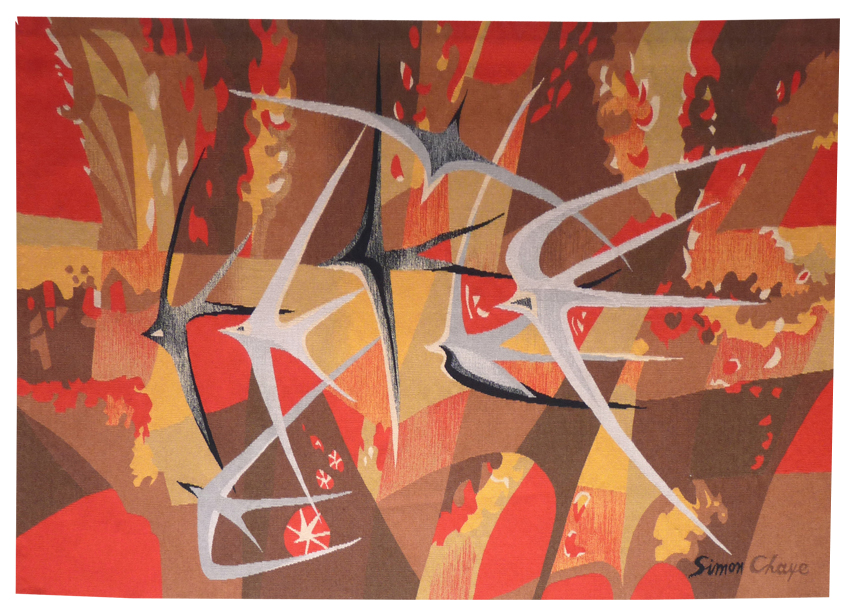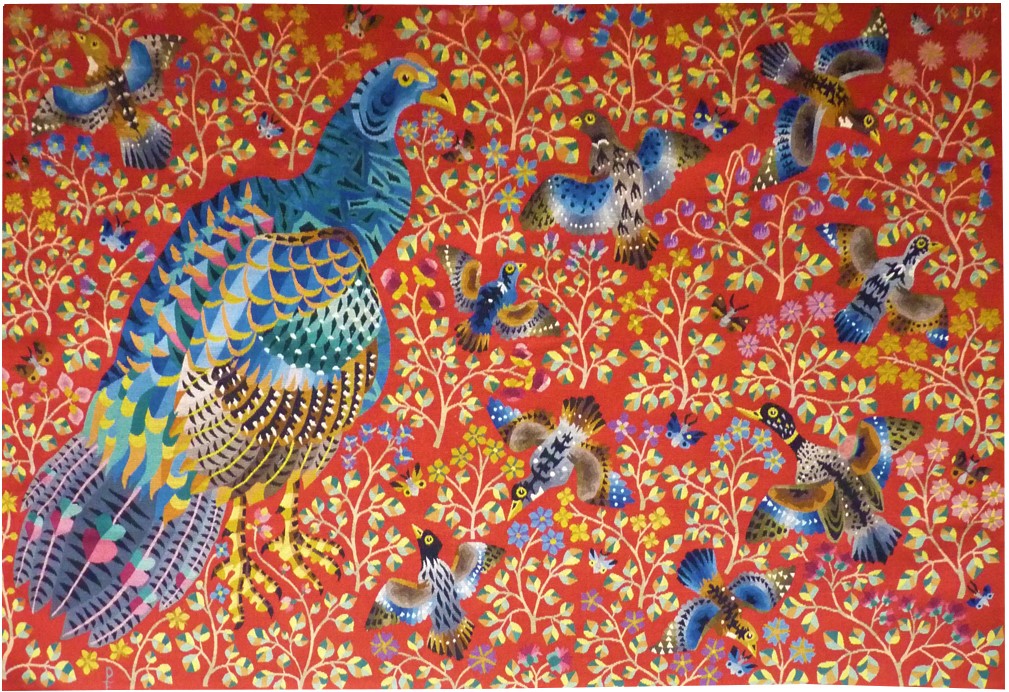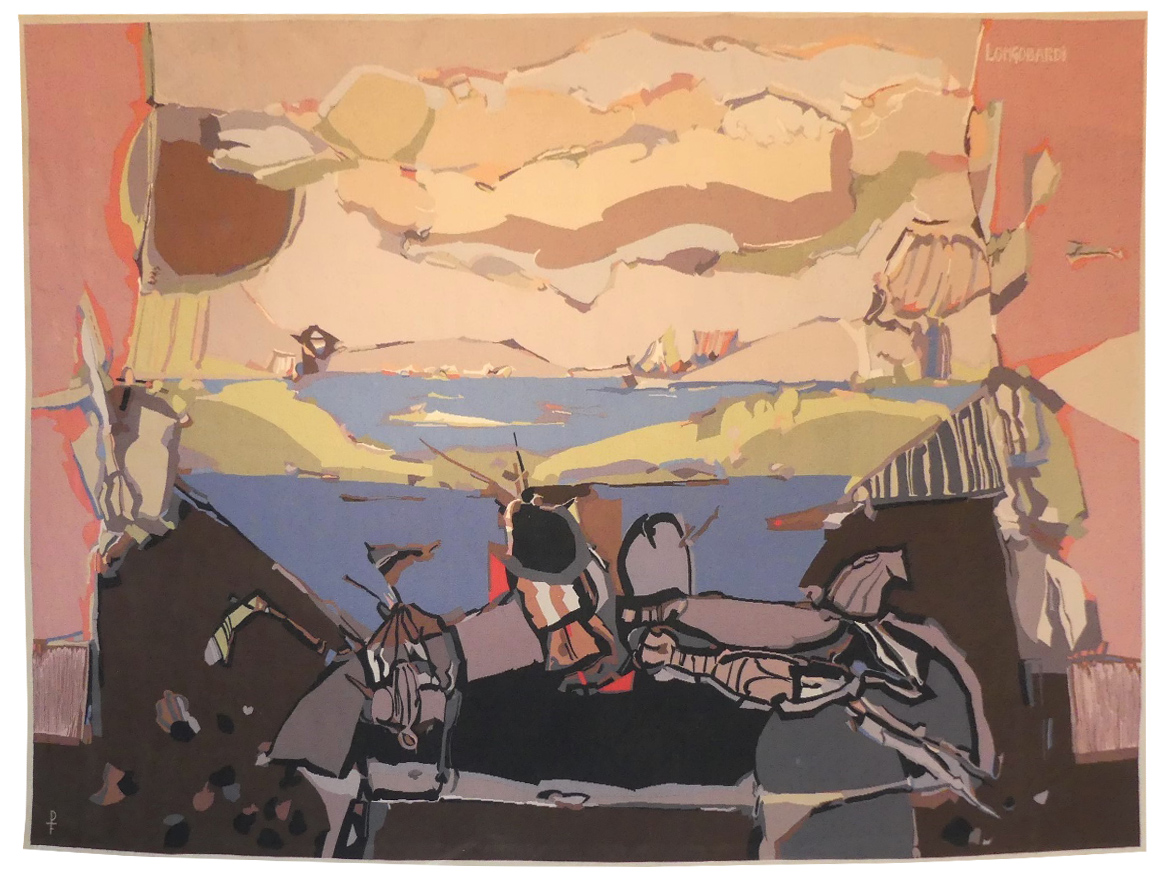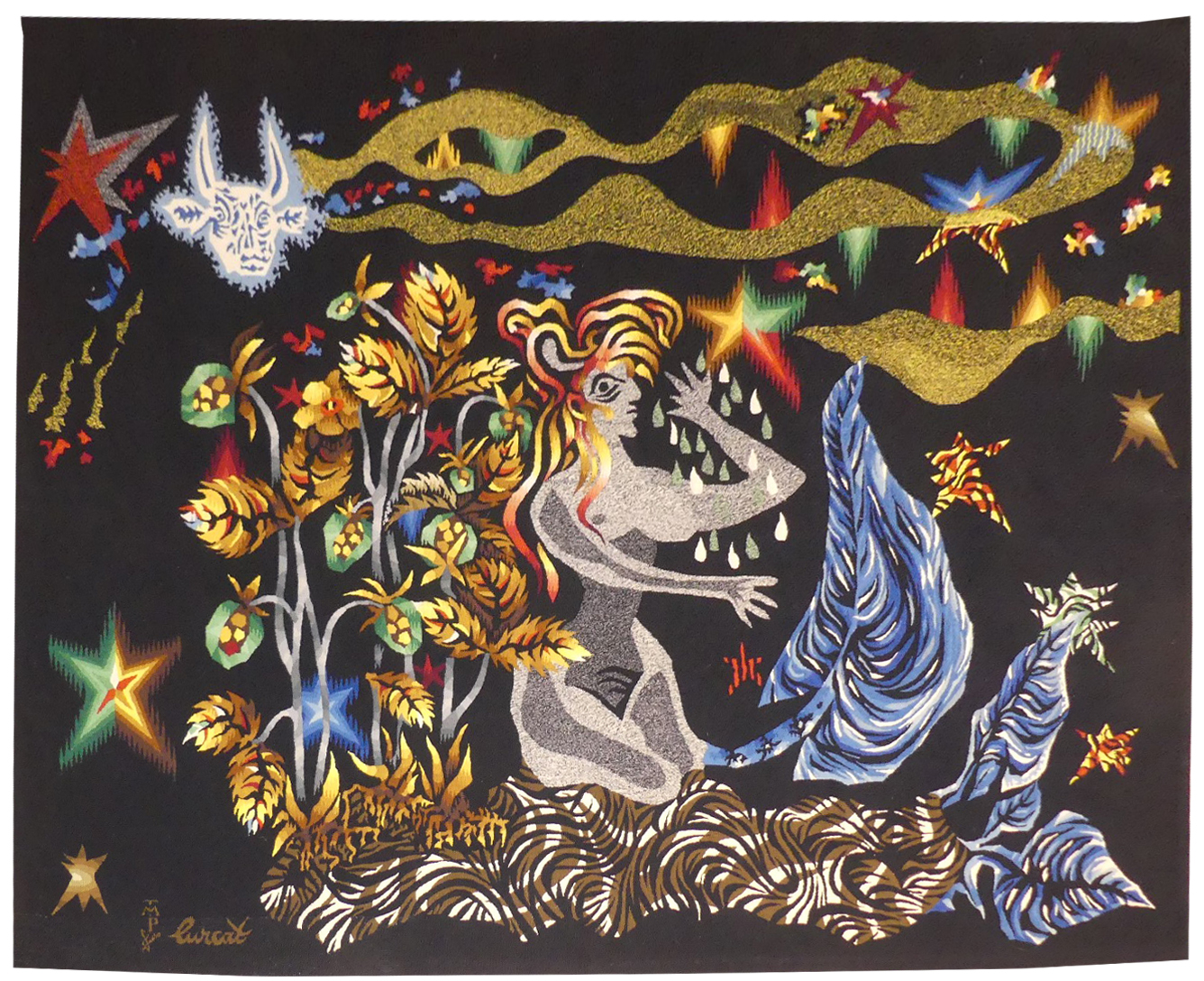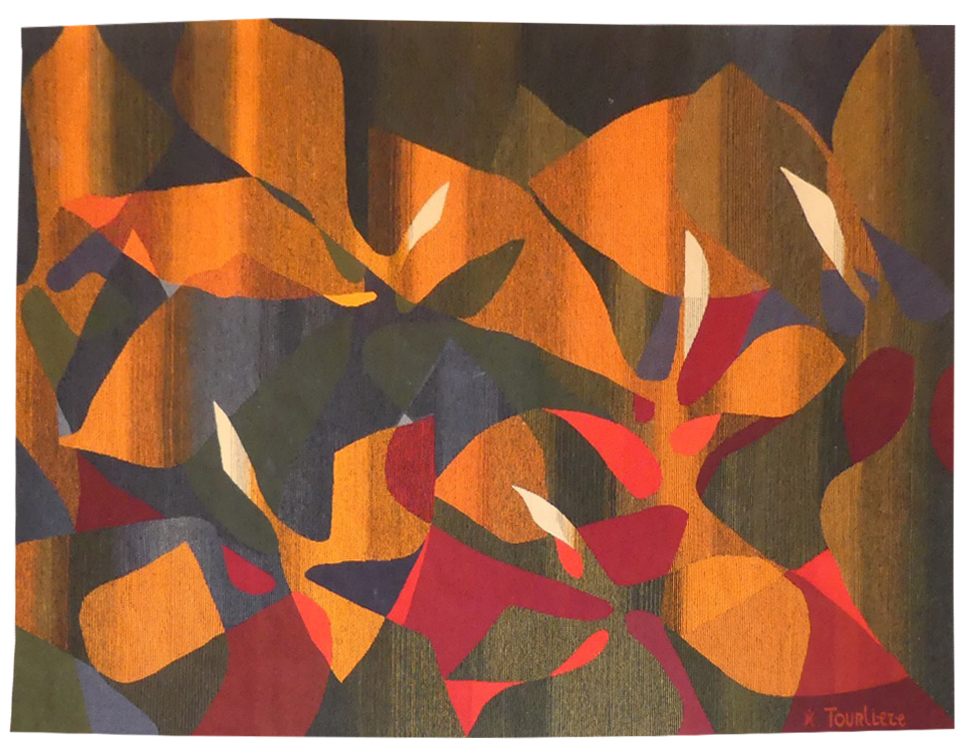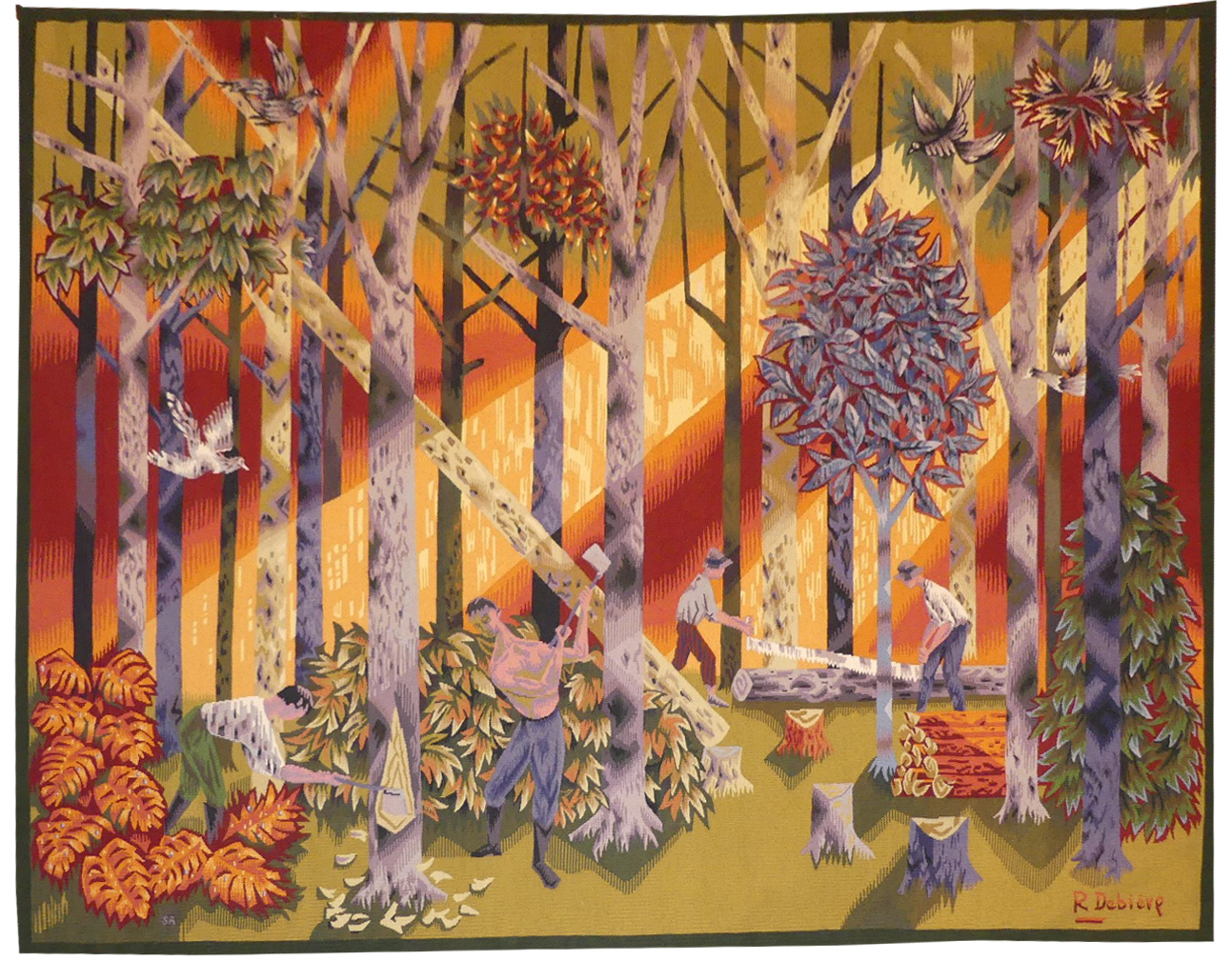-
Le Chalut (the trawler)
Aubusson tapestry woven by the Berthaut workshop. Complete with certificate of origin signed by the artist. 1952. Jean Picart le Doux is one of the foremost figures in the renaissance of the art of tapestry. His earliest contributions to the field date back to 1943 when he designed cartoons for the passenger ship “la Marseillaise”. A close associate of Lurçat, whose theories he would adopt (limited palette, numbered cartoons...), he was a founding member of the A.P.C.T. (Association des Peintres-cartonniers de Tapisserie), and soon after, a teacher at the Ecole Nationale Supérieure des Arts Décoratifs. The state gave him several commissions most of them at the Aubusson workshop, and some at the Gobelins : the most spectacular of these being for the University of Caen, the Theatre in Le Mans, the passenger ship France or the Prefecture of the Creuse département ... In as much as Picart le Doux’s aesthetic is close to that of Lurçat, so also is his insipiration and his subject matter, although in a register which is more decorative than symbolic, where he brings together heavenly bodies (the sun, the moon, the stars...), the elements, nature (wheat, vines, fish, birds...), man, literary quotation ... « One of the best-known of Picart le Doux’s tapestries : it is highly organised and the generous curves of the trawl net underline the choice of a large and simple graphic.” Is how Maurice Bruzeau describes this tapestry (n° 37 in his book) in the commentary he devotes to it. “The trawler” is typical of the marine themes which are omnipresent in this artist’s work, particularly at this period : “Dieu Marin (marine god), “La Sirène” (the mermaid), “le Dauphin” (the dolphin), “Fruits de mer” (shellfish), “Etoiles de mer” (starfish), in a range of muted colours revolving around kaki and silver grey. Here the treatment of the theme is more documentary (apart from the presence of a trident) : the subject is fishing, as it appears to Picart le Doux. Bibliography : Léon Moussinac, Jean Picart le Doux, Editions Cercle d’art,1964 (ill. Pl.10) Marthe Belle-Jouffray, Jean Picart le Doux, Publications filmées d’art et d’histoire, 1966, ill. n°4 Exhibition catalogue, Hommage à Jean Picart le Doux, Centre artistique et littéraire de Rochechouart, 1968 (ill.) Maurice Bruzeau, Jean Picart le Doux, Murs du soleil, Editions Cercle d’art 1972 Exhibition catalogue Jean Picart le Doux, Paris, Musée de la Poste, 1980 (ill.) Exhibition Catalogue Picart le Doux, château d'Olonne, 1992 (ill.) -
Remous (swell)
Aubusson tapestry woven in the Tabard workshop. Circa 1960. Matégot, originally a decorator, then creator of artefacts and furniture (an activity he abandoned in 1959) met François Tabard in 1945 and gave him his first cartoons, first of all figurative then rapidly of abstract design in the 1950’s. He became a member of the A.P.C.T. (Association des Peintres Cartonniers de Tapisserie) in 1949, participated in many international exhibitions (Matégot, like Lurçat before him, was an untiring advocate of the art of tapestry) fulfilled numerous public commissions, sometimes of monumental proportions (“Rouen” 85m2 for the Préfecture of the Seine Maritime département, and also tapestries for Orly Airport, for the Maison de la Radio, for the IMF...) and designed no fewer than 629 cartoons up until the 1970’s. In 1990 the Matégot foundation for contemporary tapestry was inaugurated in Bethesda, U.S.A. Matégot is an artist, like Wogensky, Tourlière or Prassinos, who turns wool textiles resolutely towards the abstract: at first lyrical, geometric in the 70’s, exploiting various technical aspects of the loom : colour graduations, shading, irregularities... Remous can be seen as representative of Matégot’s production around 1960 : lyrical, playing with transparency, using all the technical expertise of the weavers (colour shading and grading…) Its evocative title is a reminder of the artist’s interest for aquatic subjects (cf “Régates”) treated in an abstract-metaphorical way. Bibliography : Exhibition Cat. Les tapisseries de Mathieu Matégot, galerie La Demeure, 1962 (ill.) Exhibition catalogue, Matégot, Angers, Musée Jean Lurçat et de la Tapisserie Contemporaine, 1990-1991 -
Papillons de cocagne (ideal butterflies)
Aubusson tapestry, woven in the Picaud workshop. Complete with certificate of origin signed by the artist. Circa 1970. Michèle Van Hout le Beau designed numerous cartoons in the 1960’s and 70’s, working in collaboration with several workshops in Aubusson and receiving some state commissions (she participated along with Soulages, Lagrange, Alechinsky and others in the decoration of the transatlantic Boeing 707’s for Air France). Her style often involves the use of strident colours (very evocative of the 1970’s) from which emerge foliage, stylised human or animal figures. This cartoon, with its acidic colours is particularly characteristic of the artist’s style ; here we can also observe, on a theme abundantly developed by Lurçat, the different way in which the butterflies are evoked : the subject is here a pretext for highly coloured, geometrical evocations approaching abstraction. -
Nymphes et chasseurs (Nymphs and hunters)
Aubusson tapestry woven in the Pinton workshop for the Compagnie des Arts Français. 1941. The place occupied by André Planson in the history of tapestry-making is a direct result of the role that was alotted to him by Jacques Adnet in the synthesis of art and design advocated by the Compagnie des Arts Français of which he was the director. As early as 1941, Adnet approached several painters (Brianchon, Vera,... and Planson) to design tapestry cartoons in the context of furniture and interior design : “our intention was to demonstrate that contemporary tapestries have much to contribute to the integrated design of a room” (L. Chéronnet, Jacques Adnet, Art et Industrie 1948). The Compagnie des Arts Français organised throughout the 1940’s tapestry exhibitions on its premises. These ambitious decorative aspirations, which were important in encouraging the renewal of the art of the tapestry, remain however somewhat irrelevant to the preoccupations of Lurçat and his followers. The gracious and joyful attributes (compare with the contemporary creations of Lurçat or Gromaire) of the Compagnie are plainly evident in this cartoon dating from 1941 which brings right up to date the traditional tapestry themes of the hunting scene and bucolic pleasures in a voluntarily innovative style which is highly decorative. Although certain technical innovations typical of the Lurçat doctrine are already assimilated (limited palette, irregular stitch size) it is to be noted that this decorative intention is still influenced by techniques associated with painting (the use of perspective, and shading for flesh colours...) -
Camargue
Aubusson tapestry woven in the Pinton workshop. Complete with certificate of origin signed by the artist n° 4 of 6. 1963. With a taste for the large-scale, influenced by Untersteller at the Ecole des Beaux Arts, Hilaire undertook numerous mural paintings. In the same vein, beginning in 1949, along with a number of other artists stimulated by Lurçat, (he would join the latter at the A.P.C.T. Association des Peintres-Cartonniers de Tapisserie) he designed a number of cartoons some of which were woven at Beauvais or at Les Gobelins. His figurative cubist-influenced style (which sometimes approaches abstraction) is immediately recognisable in his tapestry cartoons : in this one, but also for example in the one designed for the Salon Fontainebleau for the ocean liner France, “Sous-bois” (undergrowth) (190 x 988 cm, Pinton frères, reproduced in Le paquebot France, Armelle Bouchet Mazas, Paris 2006p. 169) where shapes and colours are fragmented in a kaleidoscopic fashion. “Camargue” is reproduced in the “Tapisserie d’Aubusson” sample collection of the Guéret Chamber of Commerce and Industry published in the early 1980’s to illstrate the technical competence of the Aubusson workshops. Bibliography : Exhibition catalogue Hilaire, œuvre tissé, galerie Verrière, 1970 (ill.) Exhibition catalogue, du trait à la lumière, Musée Départemental Georges de la Tour at Vic-sur-Seille, 2010. -
Automne-Hiver (Autumn-Winter)
Aubusson tapestry woven by the Pinton workshop. Complete with certificate of origin n° 6 of 6. Circa 1975. Jean Picart le Doux is one of the foremost figures in the renaissance of the art of tapestry. His earliest contributions to the field date back to 1943 when he designed cartoons for the passenger ship “la Marseillaise”. A close associate of Lurçat, whose theories he would adopt (limited palette, numbered cartoons...), he was a founding member of the A.P.C.T. (Association des Peintres-cartonniers de Tapisserie), and soon after, a teacher at the Ecole Nationale Supérieure des Arts Décoratifs. The state gave him several commissions most of them at the Aubusson workshop, and some at the Gobelins : the most spectacular of these being for the University of Caen, the Theatre in Le Mans, the passenger ship France or the Prefecture of the Creuse département ... In as much as Picart le Doux’s aesthetic is close to that of Lurçat, so also is his insipiration and his subject matter, although in a register which is more decorative than symbolic, where he brings together heavenly bodies (the sun, the moon, the stars...), the elements, nature (wheat, vines, fish, birds...), man, literary quotation ... The theme of the seasons is a classic in the history of tapestry which was enthusiastically ressuscitated by the 20th century cartoon artists, of whom Lurçat was foremost (cf his Seasons wall hanging commissioned by the state in 1939). For Picart le Doux the inspiration is two-fold : Nature obviously but also Music ; “l’Hiver” (Winter) an allegorical treatment of the theme and one of the best-known works of this artist dates from 1950, but it is the “Hommage à Vivaldi” (Homage to Vivaldi) from 1963, with its 4 seasons represented in symbolic fashion by coloured suns, featuring symbols from the zodiac and fronds of vegetation that is the source of this cartoon where the motifs are reworked in a horizontal format. Bibliography : Maurice Bruzeau, Jean Picart le Doux, Murs de soleil, Editions Cercle d'art, 1972 -
Normands sur la Seine (Norsemen on the Seine)
Tapestry woven at Aubusson by the Pinton workshop. Signed certificate of origin n° 1. 1961. Lars Gynning is one of the numerous artists of various origins whose work would be woven in Aubusson during the years from the 50’s to the 70’s, at a period when tapestry imposed itself as an artistic medium. From a thematic point of view, this cartoon can be seen as a referrence, across the centuries, to Franco-Scandinavian relations seen through the prism of Viking incursions up the Seine estuary : an inevitable throw-back to the Bayeux tapestry. However, rather than a historic or diplomatic statement by Gynning, the cartoon in fact illustrates a saga by Evart Taube, the 20th century Swedish national poet (an extract from the text is woven at the bottom of the tapestry) ; added to the subject itself, the textile rendition of an epic saga is a gesture in the direction of the great mediaeval tapestry tradition, which was an inevitable model for many painter-cartoonists of the period. The aesthetic, which is resolutely contemporary and influenced by cubism, revitalises an ancient subject. -
Poissons de la lune (Moon fish)
Aubusson tapestry woven by the Pinton workshop. Complete with certificate of origin. Circa 1960. Fumeron designed his first cartoons (he would ultimately make over 500) in the 1940’s, in collaboration with the Pinton workshop, he was then commissioned on numerous occasions by the state before participating in the decoration of the ocean liner “France”. His work was figurative to begin with and influenced by Lurçat, then turned towards abstraction, before coming back to a style characterised by colourful figurative and realistic depictions from the 1980’s onwards. Beneath the red moon, fish, butterflies, a lobster all frolic in a dream-like composition typical of the artist : numerous examples of these motifs can be found for instance in “Avant l’homme” Before man, woven by the Gobelins (cf Exhibition Catalogue “le Mobilier National et les Manufactures Nationales des Gobelins et de Beauvais sous la IVe République”, Beauvais 1997) -
Hommage à l'abbé Breuil (a tribute to Father Breuil)
Aubusson tapestry woven by the Pinton workshop. Complete with certificate of origin. Circa 1955. Perrot began his career as a cartoon designer at the end of the war, making almost 500 cartoons including numerous commissions from the state, most of which were woven at Aubusson. His style which is particularly rich and decorative is eminently recognisable : a crowd of butterflies or birds, most often, stands out against a background of vegetation, reminiscent of the millefleurs tapestries (which would also inspire Dom Robert). Uncharacteristic cartoon whose inspiration lies in the cave paintings at Lascaux ; here it can be said that never has a tapestry merited quite so well the term « wall art ». Perrot’s input is, in the end, relatively modest : the use of saturated colours (particularly the mauve-pink background), the overlapping of the motifs (which are more spaced out in the cave itself), superficial laid over blotching,... If Perrot is an habitué of hommage-cartoons (Pergaud, Redouté, Audubon,...) this particular example is interesting because of the well-established proximity between the artist and the dedicatee, “the Pope of Prehistory”: here the hommage owes nothing to the artificiality of an official commission. Bibliography : Tapisseries, dessins, peintures, gravures de René Perrot, Dessein et Tolra, 1982 -
Soleils éteints (Extinct suns)
Aubusson tapestry woven in the Pinton workshop. Complete with certificate of origin signed by the artist, n°1/6. Circa 1970. Originally an engraver (Prix de Rome, intaglio technique in 1942), Jean-Louis Viard designed his first tapestry cartoons in the mid 1950’s. At first his work was figurative (he was collaborating at the time with Picart Le Doux), but then he evolved along the same lines as many other painter-cartoonists of the period (Matégot, Tourlière or Prassinos,...) towards abstraction. He produced scores of cartoons working up until the 2000’s, in parallel to his work as a painter and engraver, but throughout revealing a particular interest for the use of contrasting materials and textures in the tradition of the “Nouvelle Tapisserie” of which Pierre Daquin was one of the leading lights. The inspiration for his motifs, sometimes metaphysical (“Mémoires” Memories, “Destins” Destinies,…) is wide-reaching, from astronomical infinity « ténèbres solaires » solar darkness) to the microscopic (« Mutation végétale” Plant mutation) : a profuse and varied production, regularly exhibited at his home, in various public and private exhibition spaces and, most significantly, at the Salon Comparaison of which he was the curator for the Tapestry section. Origin : the artist’s workshop -
Destins (Destinies)
Aubusson tapestry woven in the Glaudin-Brivet workshop. Complete with certificate of origin signed by the artist, n°1/6. 1974. Originally an engraver (Prix de Rome, intaglio technique in 1942), Jean-Louis Viard designed his first tapestry cartoons in the mid 1950’s. At first his work was figurative (he was collaborating at the time with Picart Le Doux), but then he evolved along the same lines as many other painter-cartoonists of the period (Matégot, Tourlière or Prassinos,...) towards abstraction. He produced scores of cartoons working up until the 2000’s, in parallel to his work as a painter and engraver, but throughout revealing a particular interest for the use of contrasting materials and textures in the tradition of the “Nouvelle Tapisserie” of which Pierre Daquin was one of the leading lights. The inspiration for his motifs, sometimes metaphysical (“Mémoires” Memories, “Destins” Destinies,…) is wide-reaching, from astronomical infinity « ténèbres solaires » solar darkness) to the microscopic (« Mutation végétale” Plant mutation) : a profuse and varied production, regularly exhibited at his home, in various public and private exhibition spaces and, most significantly, at the Salon Comparaison of which he was the curator for the Tapestry section. Origin : the artist’s workshop -
Danseuses cambodgiennes (Cambodian dancers)
Tapestry woven at Aubusson by the Picaud workshop. Certificate of origin, n° 1/4. Circa 1965. Although somewhat overlooked now, the contribution that Maurice Ferréol made, in the 1960’s, to the design of figurative tapestry is quite remarkable. He proposed a style redolent of popular imagery where the use of pure blocks of colour exacerbates the almost childlike outline of the figures. What connects these bright and garishly coloured, masked figures to Cambodia? They are simply a pretext for a profusion of colours and motifs in the particular characteristic style of Ferréol. -
Galathée
Aubusson tapestry woven by the Picaud workshop. Complete with certificate of origin signed by the artist, n° 1 of 4. 1970. Loewer designed his first cartoon in 1953 ; his early works are first figurative before turning to abstraction (like Matégot) which is exclusively geometric in Loewer’s case. He designed over 180 cartoons, most of which were woven by his friend, Raymond Picaud. Only one example of this tapestry was woven according to the catalogue raisonné, « Galathée » is representative of the artist’s style around 1970 where the recurrent design motif is the square used in superpositions. Bibliography : Claude Loewer, l’évasion calculée : travaux de 1939 à 1993, catalogue raisonné des tapisseries de 1953 à 1974, Sylvio Acatos, Charlotte Hug, Walter Tschopp and Marc-Olivier Wahler, Artcatos, 1994, n°120 -
Les oiseaux s'envolent (birds fly)
Aubusson tapestry woven in the Berthaut workshop. Complete with certificate of origin signed by the artist. 1949. Jean Picart le Doux is one of the foremost figures in the renaissance of the art of tapestry. His earliest contributions to the field date back to 1943 when he designed cartoons for the passenger ship “la Marseillaise”. A close associate of Lurçat, whose theories he would adopt (limited palette, numbered cartoons…), he was a founding member of the A.P.C.T. (Association des Peintres-cartonniers de Tapisserie), and soon after, a teacher at the Ecole Nationale Supérieure des Arts Décoratifs. The state gave him several commissions most of them at the Aubusson workshop, and some at the Gobelins : the most spectacular of these being for the University of Caen, the Theatre in Le Mans, the passenger ship France or the Prefecture of the Creuse département … In as much as Picart le Doux’s aesthetic is close to that of Lurçat, so also is his inspiration and his subject matter, although in a register which is more decorative than symbolic, where he brings together heavenly bodies (the sun, the moon, the stars…), the elements, nature (wheat, vines, fish, birds…), man, literary quotation … “Les oiseaux s’envolent” (the flight of the birds) was intended as a symbolic representation of the Liberation of France, a theme which recurrs in the “la cage ouverte’ (the open cage) in 1953. Bibliography : Maurice Bruzeau, Jean Picart le Doux, Murs de soleil, Editions Cercle d’art, 1972 Exhibition Catalogue, Jean Picart le Doux, tapisseries, Musée de Saint-Denis, 1976 Exhibition Catalogue Jean Picart le Doux, Musée de la Poste, 1980 -
Le luth et les colombes (the lute and the doves)
Aubusson tapestry woven in the Berthaut workshop. Complete with certificate of origin signed by the artist, n°6/8. Circa 1955. Jean Picart le Doux is one of the foremost figures in the renaissance of the art of tapestry. His earliest contributions to the field date back to 1943 when he designed cartoons for the passenger ship “la Marseillaise”. A close associate of Lurçat, whose theories he would adopt (limited palette, numbered cartoons...), he was a founding member of the A.P.C.T. (Association des Peintres-cartonniers de Tapisserie), and soon after, a teacher at the Ecole Nationale Supérieure des Arts Décoratifs. The state gave him several commissions most of them at the Aubusson workshop, and some at the Gobelins : the most spectacular of these being for the University of Caen, the Theatre in Le Mans, the passenger ship France or the Prefecture of the Creuse département ... In as much as Picart le Doux’s aesthetic is close to that of Lurçat, so also is his inspiration and his subject matter, although in a register which is more decorative than symbolic, where he brings together heavenly bodies (the sun, the moon, the stars...), the elements, nature (wheat, vines, fish, birds...), man, literary quotation ... The lute and the doves is a reworking of a larger and more densely decorated cartoon dating from 1949 and titled “les oiseaux s’envolent” (the flight of the birds) which was intended as a symbolic representation of the Liberation of France, a theme which recurrs in the “la cage ouverte’ (the open cage) in 1953. Bibliography : Marthe Belle-Jouffray, Jean Picart le Doux, Publications filmées d’art et d’histoire, 1966, ill. n°3 Maurice Bruzeau, Jean Picart le Doux, Murs de soleil, Editions Cercle d’art, 1972 Exhibition Catalogue, Jean Picart le Doux, tapisseries, Musée de Saint-Denis, 1976 Exhibition Catalogue Jean Picart le Doux, Musée de la Poste, 1980 -
Vega
Aubusson tapestry woven in the Legoueix workshop. Certificate of origin signed by the artist n° 2 of 4. 1967. A member of the A.P.C.T. (Association des Peintres-Cartonniers de Tapisserie), Wogensky is one of the many artists who would follow in Lurçat’s footsteps immediately after the war. At first influenced by his predecessor, Wogensky’s subsequent work (159 cartoons according to the 1989 exhibition catalogue) would evolve during the 1960’s towards a, not completely self-avowed, lyrical abstraction, from cosmic-astronomical themes expressed in decomposed, moving, birdlike shapes to cartoons both more refined and less dense. Although always claiming to be a painter, the artist’s conception of tapestry is extremely well thought out : “the realisation of a mural cartoon.... requires the consideration of a space which is no longer ours alone, by the nature of its dimensions, its scale, it also imposes a grand gesture which transforms and accentuates our presence.” « Vega » is a work inspired by Wogensky’s « cosmic » vein (it’s title alone bears witness to the fact) which lasted through the 1960’s and of which “Cosmos” (1968 Strasbourg University) and “Galaxy” (1970, Sénat Palais du Luxembourg) would be the high points. Shading (omnipresent) and blocks of colour co-exist in a subtle harmony, evoking a curious, unknown world with elements of the infinitely small as seen through a microscope and the infinitely large. Bibliography : Exhibition catalogue Robert Wogensky, Aubusson, Musée départemental de la tapisserie, 1989 Exhibition catalogue Robert Wogensky, Angers, Musée Jean Lurçat et de la Tapisserie Contemporaine, 1989 -
Concert des oiseaux (concert of birds)
Tapestry woven in the Picaud workshop. Complete with certificate of origin signed by the artist, n°4/6. Circa 1975. Jean Picart le Doux is one of the foremost figures in the renaissance of the art of tapestry. His earliest contributions to the field date back to 1943 when he designed cartoons for the passenger ship “la Marseillaise”. A close associate of Lurçat, whose theories he would adopt (limited palette, numbered cartoons...), he was a founding member of the A.P.C.T. (Association des Peintres-cartonniers de Tapisserie), and soon after, a teacher at the Ecole Nationale Supérieure des Arts Décoratifs. The state gave him several commissions most of them at the Aubusson workshop, and some at the Gobelins : the most spectacular of these being for the University of Caen, the Theatre in Le Mans, the passenger ship France or the Prefecture of the Creuse département ... In as much as Picart le Doux’s aesthetic is close to that of Lurçat, so also is his inspiration and his subject matter, although in a register which is more decorative than symbolic, where he brings together heavenly bodies (the sun, the moon, the stars...), the elements, nature (wheat, vines, fish, birds...), man, literary quotation ... Music as a theme is frequently associated with birds in Picart le Doux’s work ; this particular cartoon is an extension of the « harpe des forêts” tapestry dating from 1953. Bibliography : Maurice Bruzeau, Jean Picart le Doux, Murs de soleil, Editions Cercle d’art, 1972 Exhibition Catalogue, Jean Picart le Doux, tapisseries, Musée de Saint-Denis, 1976 Exhibition Catalogue Jean Picart le Doux, Musée de la Poste, 1980 -
Etoiles de neige (Snow Flakes)
Aubusson tapestry woven in the Berthaut workshop. N°7/8. 1962. Jean Picart le Doux is one of the foremost figures in the renaissance of the art of tapestry. His earliest contributions to the field date back to 1943 when he designed cartoons for the passenger ship “la Marseillaise”. A close associate of Lurçat, whose theories he would adopt (limited palette, numbered cartoons...), he was a founding member of the A.P.C.T. (Association des Peintres-cartonniers de Tapisserie), and soon after, a teacher at the Ecole Nationale Supérieure des Arts Décoratifs. The state gave him several commissions most of them at the Aubusson workshop, and some at the Gobelins : the most spectacular of these being for the University of Caen, the Theatre in Le Mans, the passenger ship France or the Prefecture of the Creuse département ... In as much as Picart le Doux’s aesthetic is close to that of Lurçat, so also is his inspiration and his subject matter, although in a register which is more decorative than symbolic, where he brings together heavenly bodies (the sun, the moon, the stars...), the elements, nature (wheat, vines, fish, birds...), man, literary quotation ... The theme of winter is chracterised in Picart le Doux’s work by the use of templates, colours (muted tones, browns, black, white), and motifs (bare branches, kaleidoscopic flake shapes) ; the snow flakes referred to here will also be used in “Solstice d’hiver” and “Hommage à Vivaldi”. Bibliography : Maurice Bruzeau, Jean Picart le Doux, Murs de soleil, Editions Cercle d’art, 1972, ill. n°122 Exhibition Catalogue, Jean Picart le Doux, tapisseries, Musée de Saint-Denis, 1976 Exhibition Catalogue Jean Picart le Doux, Musée de la Poste, 1980 -
Poissons et grenouilles (fish and frogs)
Aubusson tapestry woven by the Picaud workshop. Complete with signed label, n°1/4. Circa 1970. Elie Grekoff, whose aesthetic is similar to that of Lurçat, designed over 300 cartons : a black background evokes an underwater world where fish and leaves are pictured with the amusing and un-Lurçat-like presence of frogs. -
Argos
Aubusson tapestry woven by the Picaud workshop. Complete with signed certificate of origin, n° 1/4. 1971. Loewer designed his first cartoon in 1953 ; his early works are first figurative before turning to abstraction (like Matégot) which is exclusively geometric in Loewer’s case. He designed over 180 cartoons, most of which were woven by his friend, Raymond Picaud. Around 1971-1972, Loewer’s style became more refined, with fewer geometric squares and a brighter, more contrasted use of colour. As is often the case with Loewer, this is a one-off piece. Bibliography : Claude Loewer, l’évasion calculée : travaux de 1939 à 1993, catalogue raisonné des tapisseries de 1953 à 1974, Sylvio Acatos, Charlotte Hug, Walter Tschopp and Marc-Olivier Wahler, Artcatos, 1994, n°128 -
Sphère et colombes (Sphere and doves)
Aubusson tapestry woven in the Berthaut workshop. Complete with signed label. Circa 1954. Jean Picart le Doux is one of the foremost figures in the renaissance of the art of tapestry. His earliest contributions to the field date back to 1943 when he designed cartoons for the passenger ship “la Marseillaise”. A close associate of Lurçat, whose theories he would adopt (limited palette, numbered cartoons...), he was a founding member of the A.P.C.T. (Association des Peintres-cartonniers de Tapisserie), and soon after, a teacher at the Ecole Nationale Supérieure des Arts Décoratifs. The state gave him several commissions most of them at the Aubusson workshop, and some at the Gobelins : the most spectacular of these being for the University of Caen, the Theatre in Le Mans, the passenger ship France or the Prefecture of the Creuse département ... In as much as Picart le Doux’s aesthetic is close to that of Lurçat, so also is his inspiration and his subject matter, although in a register which is more decorative than symbolic, where he brings together heavenly bodies (the sun, the moon, the stars...), the elements, nature (wheat, vines, fish, birds...), man, literary quotation ... Typical of the associations that characterise his work, Picart le Doux here confronts Nature (organised in a formal French garden style) peopled by doves with 3 allegories : literature (a book) the arts (a mandoline), science (a sphere) : the incarnation of a classical mind. Bibliography : Maurice Bruzeau, Jean Picart le Doux, Murs de soleil, Editions Cercle d’art, 1972 Exhibition Catalogue, Jean Picart le Doux, tapisseries, Musée de Saint-Denis, 1976 Exhibition Catalogue Jean Picart le Doux, Musée de la Poste, 1980 -
Musique et coquillage (music and shell)
Aubusson tapestry woven by the Tabard workshop. Complete with label. Circa 1950. Lurçat’s artistic production was immense : it is however his role as the renovator of the art of tapestry design which ensures his lasting renown. As early as 1917, he started producing works on canvas, then in the 20’s and 30’s, he worked with Marie Cuttoli. His first collaboration with the Gobelins workshop dates back to 1937, at the same time he discovered the tapestry of the Apocalypse which was essential in his decision to devote himself to tapestry design. He first tackled the technical aspects with François Tabard, then on his installation at Aubusson during the war, he established his technique : broad point, a simplified palette, outlined cartoons with colours indicated by pre-ordained numbers. A huge production then follows (over 1000 cartoons) amplified by his desire to include his painter friends, the creation of the A.P.C.T. (Association des Peintres-Cartonniers de Tapisserie) and the collaboration with the art gallery La Demeure and Denise Majorel, and then by his role as a tireless advocate for the medium around the world. His tapestries reveal a pictorial world which is specifically decorative, with a very personal symbolic iconography : cosmogony (the sun, the planets, the zodiac, the four elements…) stylised vegetation, fauna (rams, cocks, butterflies, chimera …) standing out against a background without perspective (voluntarily different from painting) and, in his more ambitious work, designed as an invitation to share in a poetic (he sometimes weaves quotations into his tapestries) and philosophical (the grand themes are broached from the wartime period onwards) vision whose climax is the “Chant du Monde” (Song of the World) (Jean Lurçat Museum , ancien hôpital Saint Jean, Angers) which remained unfinished at his death. This piece (of which a copy is exhibited at the Cité de la Tapisserie in Aubusson) is a typical example of the laden table, recurrent in Lurçat’s work. The juxtaposition of a musical instrument and shellfish is a direct reference to the work of Picart le Doux. Bibliography : Tapisseries de Jean Lurçat 1939-1957, Pierre Vorms Editeur, 1957 Exhibition Catalogue Lurçat, 10 ans après, Musée d'Art moderne de la ville de Paris, 1976 Exhibition catalogue Les domaines de Jean Lurçat, Angers, Musée Jean Lurçat et de la tapisserie contemporaine, 1986 Symposium Jean Lurçat et la renaissance de la tapisserie in Aubusson, Aubusson, Musée départemental de la tapisserie 1992 Exhibition Catalogue Dialogues avec Lurçat, Musées de Basse-Normandie, 1992 Exhibition catalogue Jean Lurçat, Donation Simone Lurçat, Académie des Beaux-Arts, 2004 Jean Lurçat, le chant du monde Angers 2007 R. Guinot, la tapisserie d’Aubusson et de Felletin, Lucien Souny, 2009, ill. p.96 Gérard Denizeau, Jean Lurçat, Liénart, 2013 Exhibition Catalogue Jean Lurçat au seul bruit du soleil, Paris, galerie des Gobelins, 2016 -
Petit bois (grove)
Aubusson tapestry woven in the Tabard workshop. With label, signed by the artist. Circa 1970. Henri Ilhe, who came to the design of tapestry cartoons late on in his career, still managed to produce from 1964 onwards a considerable number (more than 120, all woven by the Tabard workshop) in an urbane style, incorporating birds and butterflies sporting in and around the gnarled branches of trees and bushes. “Petit bois” is thus, characteristic of Ilhe’s bucolic inspiration. -
Ô soleil (O Sun)
Aubusson tapestry woven by the Hamot workshop. With signed label, n°2/8. 1968. Jean Picart le Doux is one of the foremost figures in the renaissance of the art of tapestry. His earliest contributions to the field date back to 1943 when he designed cartoons for the passenger ship “la Marseillaise”. A close associate of Lurçat, whose theories he would adopt (limited palette, numbered cartoons...), he was a founding member of the A.P.C.T. (Association des Peintres-cartonniers de Tapisserie), and soon after, a teacher at the Ecole Nationale Supérieure des Arts Décoratifs. The state gave him several commissions most of them at the Aubusson workshop, and some at the Gobelins : the most spectacular of these being for the University of Caen, the Theatre in Le Mans, the passenger ship France or the Prefecture of the Creuse département ... In as much as Picart le Doux’s aesthetic is close to that of Lurçat, so also is his inspiration and his subject matter, although in a register which is more decorative than symbolic, where he brings together heavenly bodies (the sun, the moon, the stars...), the elements, nature (wheat, vines, fish, birds...), man, literary quotation ... « The inclusion of text constitutes a closer means of communication with the poet” says Picart le Doux (a process used also by Lurçat) who will quote Apollinaire as here (“la jolie rousse”) but also Whitman, Eluard, Saint John Perse,... Illustrated by an ardent heart and, in a literal reflection of the text, by the sun, he associates the zodiac, one of his recurrent motifs, with the love poem. Bibliography : Maurice Bruzeau, Jean Picart le Doux, Murs de soleil, Editions Cercle d’art, 1972, ill. n°161 Exhibition Catalogue, Jean Picart le Doux, tapisseries, Musée de Saint-Denis, 1976 Exhibition Catalogue Jean Picart le Doux, Musée de la Poste, 1980 -
L'Homme et la Terre (Man and the Earth)
Aubusson tapestry woven in the Hamot workshop. 1962. Jean Picart le Doux is one of the foremost figures in the renaissance of the art of tapestry. His earliest contributions to the field date back to 1943 when he designed cartoons for the passenger ship “la Marseillaise”. A close associate of Lurçat, whose theories he would adopt (limited palette, numbered cartoons...), he was a founding member of the A.P.C.T. (Association des Peintres-cartonniers de Tapisserie), and soon after, a teacher at the Ecole Nationale Supérieure des Arts Décoratifs. The state gave him several commissions most of them at the Aubusson workshop, and some at the Gobelins : the most spectacular of these being for the University of Caen, the Theatre in Le Mans, the passenger ship France or the Prefecture of the Creuse département ... In as much as Picart le Doux’s aesthetic is close to that of Lurçat, so also is his inspiration and his subject matter, although in a register which is more decorative than symbolic, where he brings together heavenly bodies (the sun, the moon, the stars...), the elements, nature (wheat, vines, fish, birds...), man, literary quotation ... At the turn of the 1960’s Picart le Doux conceived a series of large-scale cartoons (« Le Temps » Galaxie », « L’Homme et la Mer », …) all of which were spectacular allegories centred around Man at the centre of Creation. Here in “L’Homme et la Terre”, the vocabulary he uses : vines, ears of wheat, the human body irrigated by veins,...are all elements used in previous cartoons by the same artist. Bibliography : Maurice Bruzeau, Jean Picart le Doux, Murs de soleil, Editions Cercle d’art, 1972, ill. n°132 Exhibition Catalogue, Jean Picart le Doux, tapisseries, Musée de Saint-Denis, 1976 Exhibition Catalogue Jean Picart le Doux, Musée de la Poste, 1980 -
Composition
Aubusson tapestry woven in the Pinton workshop. With label, n°1/1. 1974. Jean Bazaine, like many of his contemporaries, was a prolific mural artist particularly for large scale edifices. Although he is above all recognised as a designer of stained glass windows and mosaics, he was also making tapestry cartoons as early as the 1930’s. These pieces formed part of the renewal of religious art of which Bazaine would be one of the principal protagonists, particularly after the war. However, Bazaine’s designs are not all destined to be displayed in a religious context. His mastery of mural art is revealed by commissions for mosaics for the UNESCO building and also for the Maison de la Radio as well as tapestries for the Manufactures Nationales or for Aubusson, for the Palais de Justice in Lille or the Hotel de Ville in Strasbourg. This is the context for a commission for this widely recognised, indeed almost official, artist (Grand Prix National des Arts in 1964, an exhibition at the Musée National d’Art Moderne in 1965) from the Federation Française du Bâtiment for its head office, at the beginning of the 1970’s. His response would be this vast, lyrical and rythmic composition in a homogeneous colour scheme. Unfortunately, the illegibility of the certificate of origin leaves us without a title for this work whose creator did not see himself as an abstract artist. Origin : The Head Office of the Federation Francaise du Bâtiment. -
Le basset (Basset hound)
Aubusson tapestry woven in the Tabard worshop. Complete with label. Circa 1950. Lurçat’s artistic production was immense : it is however his role as the renovator of the art of tapestry design which ensures his lasting renown. As early as 1917, he started producing works on canvas, then in the 20’s and 30’s, he worked with Marie Cuttoli. His first collaboration with the Gobelins workshop dates back to 1937, at the same time he discovered the tapestry of the Apocalypse which was essential in his decision to devote himself to tapestry design. He first tackled the technical aspects with François Tabard, then on his installation at Aubusson during the war, he established his technique : broad point, a simplified palette, outlined cartoons with colours indicated by pre-ordained numbers. A huge production then follows (over 1000 cartoons) amplified by his desire to include his painter friends, the creation of the A.P.C.T. (Association des Peintres-Cartonniers de Tapisserie) and the collaboration with the art gallery La Demeure and Denise Majorel, and then by his role as a tireless advocate for the medium around the world. His tapestries reveal a pictorial world which is specifically decorative, with a very personal symbolic iconography : cosmogony (the sun, the planets, the zodiac, the four elements…) stylised vegetation, fauna (rams, cocks, butterflies, chimera …) standing out against a background without perspective (voluntarily different from painting) and, in his more ambitious work, designed as an invitation to share in a poetic (he sometimes weaves quotations into his tapestries) and philosophical (the grand themes are broached from the wartime period onwards) vision whose climax is the “Chant du Monde” (Song of the World) (Jean Lurçat Museum , ancien hôpital Saint Jean, Angers) which remained unfinished at his death. Something of a dog lover, Lurçat owned Afghan hounds. They can be found occasionally in his cartoons and seemingly Lurçat found it difficult not to be influenced by their aspect : his basset hound (similar in style to another cartoon entitled “le chien vert” the green dog, but without the owl) scarcely merits its name. Bibliography : Tapisseries de Jean Lurçat 1939-1957, Pierre Vorms Editeur, 1957 Exhibition Catalogue Lurçat, 10 ans après, Musée d'Art moderne de la ville de Paris, 1976 Exhibition catalogue Les domaines de Jean Lurçat, Angers, Musée Jean Lurçat et de la tapisserie contemporaine, 1986 Symposium Jean Lurçat et la renaissance de la tapisserie in Aubusson, Aubusson, Musée départemental de la tapisserie 1992 Exhibition Catalogue Dialogues avec Lurçat, Musées de Basse-Normandie, 1992 Exhibition catalogue Jean Lurçat, Donation Simone Lurçat, Académie des Beaux-Arts, 2004 Jean Lurçat, le chant du monde Angers 2007 Gérard Denizeau, Jean Lurçat, Liénart, 2013 Exhibition Catalogue Jean Lurçat au seul bruit du soleil, Paris, galerie des Gobelins, 2016 -
Nappe blanche (White tablecloth)
Lurçat’s artistic production was immense : it is however his role as the renovator of the art of tapestry design which ensures his lasting renown. As early as 1917, he started producing works on canvas, then in the 20’s and 30’s, he worked with Marie Cuttoli. His first collaboration with the Gobelins workshop dates back to 1937, at the same time he discovered the tapestry of the Apocalypse which was essential in his decision to devote himself to tapestry design. He first tackled the technical aspects with François Tabard, then on his installation at Aubusson during the war, he established his technique : broad point, a simplified palette, outlined cartoons with colours indicated by pre-ordained numbers. A huge production then follows (over 1000 cartoons) amplified by his desire to include his painter friends, the creation of the A.P.C.T. (Association des Peintres-Cartonniers de Tapiisserie) and the collaboration with the art gallery La Demeure and Denise Majorel, and then by his role as a tireless advocate for the medium around the world. His tapestries reveal a pictorial world which is specifically decorative, with a very personal symbolic iconography : cosmogony (the sun, the planets, the zodiac, the four elements…) stylised vegetation, fauna (rams, cocks, butterflies, chimera …) standing out against a background without perspective (voluntarily different from painting) and, in his more ambitious work, designed as an invitation to share in a poetic (he sometimes weaves quotations into his tapestries) and philosophical (the grand themes are broached from the wartime period onwards) vision whose climax is the “Chant du Monde” (Song of the World) (Jean Lurçat Museum , ancien hôpital Saint Jean, Angers) which remained unfinished at his death. The theme of the laid table is a leitmotiv in Lurçat’s work as early as the 1940’s (cf The four corners, 1943 Goubely-Gatien workshop, Angers Musée Jean Lurçat et de la tapisserie contemporaine). These tables, often with connotations of the horn of plenty and often featuring musical instruments (most often the mandolin) recall the traditional still life’s of the XVIIth century, not, as it happens, a theme of contemporary tapestry. Bibliography : Tapisseries de Jean Lurçat 1939-1957, Pierre Vorms Editeur, 1957 Exhibition Catalogue Lurçat, 10 ans après, Musée d'Art moderne de la ville de Paris, 1976 Exhibition catalogue Les domaines de Jean Lurçat, Angers, Musée Jean Lurçat et de la tapisserie contemporaine, 1986 Symposium Jean Lurçat et la renaissance de la tapisserie in Aubusson, Aubusson, Musée départemental de la tapisserie 1992 Exhibition Catalogue Dialogues avec Lurçat, Musées de Basse-Normandie, 1992 Exhibition catalogue Jean Lurçat, Donation Simone Lurçat, Académie des Beaux-Arts, 2004 Jean Lurçat, le chant du monde Angers 2007 Gérard Denizeau, Jean Lurçat, Liénart, 2013 Exhibition Catalogue Jean Lurçat au seul bruit du soleil, Paris, galerie des Gobelins, 2016Aubusson tapestry woven in the Goubely workshop. Circa 1955. -
Hommage à Mozart (Homage to Mozart)
Jean Picart le Doux is one of the foremost figures in the renaissance of the art of tapestry. His earliest contributions to the field date back to 1943 when he designed cartoons for the passenger ship “la Marseillaise”. A close associate of Lurçat, whose theories he would adopt (limited palette, numbered cartoons...), he was a founding member of the A.P.C.T. (Association des Peintres-cartonniers de Tapisserie), and soon after, a teacher at the Ecole Nationale Supérieure des Arts Décoratifs. The state gave him several commissions most of them at the Aubusson workshop, and some at the Gobelins : the most spectacular of these being for the University of Caen, the Theatre in Le Mans, the passenger ship France or the Prefecture of the Creuse département ... In as much as Picart le Doux’s aesthetic is close to that of Lurçat, so also is his insipiration and his subject matter, although in a register which is more decorative than symbolic, where he brings together heavenly bodies (the sun, the moon, the stars...), the elements, nature (wheat, vines, fish, birds...), man, literary quotation ... Cartoons devoted to musical themes are extremely frequent in Picart le Doux’s work : forms (here the concerto), specific works (“La petite musique de nuit”, a little night music, another title for our work ; “Les 4 saisons”, the 4 seasons, for example) composers (“Hommage à Vivaldi”, “Hommage à Bach”, which was reproduced as a stamp in 1980), instruments (“Soleil-Lyre”, Sun-lyre, “Harpe des mers”, Ocean harp), mythological figures (“Orphée”, Orpheus).In most cases these thematic motifs are integrated into a bucolic natural scene animated by birds and butterflies in a decorative style typical of the artist. Bibliography : Marthe Belle-Jouffray, Jean Picart le Doux, Publications filmées d’art et d’histoire, 1966, ill. n°5 Maurice Bruzeau, Jean Picart le Doux, Murs de soleil, Editions Cercle d’art, 1972, ill. n°159 Exhibition Catalogue, Jean Picart le Doux, tapisseries, Musée de Saint-Denis, 1976 Exhibition Catalogue Jean Picart le Doux, Musée de la Poste, 1980Aubusson tapestry woven by the Hamot workshop. N° EA. 1955. -
Hibou (Owl)
Aubusson tapestry woven in the Pinton workshop. 1955.Perrot began his career as a cartoon designer at the end of the war, making almost 500 cartoons including numerous commissions from the state, most of which were woven at Aubusson. His style which is particularly rich and decorative is eminently recognisable : a crowd of butterflies or birds, most often, stands out against a background of vegetation, reminiscent of the millefleurs tapestries (which would also inspire Dom Robert). This tapestry is a typical example of the artist’s portraits of birds ; the owl appears, as often in his work, associated with other birds, against a background inspired by the flower-strewn mediaeval tapestries. Bibliography : Tapisseries, dessins, peintures, gravures de René Perrot, Dessein et Tolra, 1982. -
La souche (the stump)
Fumeron designed his first cartoons (he would ultimately make over 500) in the 1940’s, in collaboration with the Pinton workshop, he was then commissioned on numerous occasions by the state before participating in the decoration of the ocean liner “France”. His work was figurative to begin with and influenced by Lurçat, then turned towards abstraction, before coming back to a style characterised by colourful figurative and realistic depictions from the 1980’s onwards. Strangely enough, despite the naturalistic title, the cartoon leans towards abstraction in a kind of refinement of Fumeron’s figurative cartoons where we can still recognise the circular yellow-sun characteristic of the artist.Aubusson tapestry woven in the Pinton workshop. With label. Circa 1960. -
Couple génétique (Genetic couple)
Aubusson tapestry woven by the Pinton workshop. With label. 1976.In this work – which is apparently the only cartoon by this artist – the deft line and clear drawing technique of Trémois are immediately recognisable. He is best known for his work as an engraver and illustrator, albeit having won the Grand Prix de Rome for his painting. Also evident, his predilection for the nude : here a loving embrace and a meditation on modern science are found in association in a surprising, and very personal, juxtaposition. -
Eaux vives (Wild water)
Aubusson tapestry woven in the Legoueix workshop. Complete with signed label, n°1/6. Circa 1970.Originally a sculptor exploiting very diverse materials (steel, concrete, clay…), Borderie came to tapestry with immense enthusiasm in the 1950’s with the weaving of his first cartoon in 1957. Receiving encouragement from Denise Majorel, he was awarded the Grand Prix National de la Tapisserie in 1962. In 1974 he was appointed as director at the Ecole Nationale des Arts Décoratifs at Aubusson but he resigned from this post shortly thereafter. He designed over 500 painted cartoons, abstracts using simple shapes, shading in a limited palette of colours and weaving with gros points. Despite its warm colours and lyrical shapes (notably the sinuous vertical swirl, ressembling water currents), “Eaux vives” remains a one-off in Borderie’s work : the habitual muted colour scheme is broken here by the striking central red oval. Bibliography : Exhibition catalogue André Borderie « pour l’homme simplement », Angers, Musée Jean Lurçat et de la Tapisserie Contemporaine 1998 J.J. et B. Wattel, André Borderie et la tapisserie d'Aubusson, Editions Louvre Victoire, 2018 -
L’enclos (Enclosure)
Aubusson tapestry woven in the Brivet workshop. With signed label, n°4/4. 1966.It was in 1953 that Jean Picart le Doux proposed to Chaye to become his assistant and encouraged him to design tapestry cartoons : he would produce numerous bucolic cartoons, but also views of Normandy (Mont Saint Michel, Honfleur, regattas,...) from whence he came. Here is a thoroughly characteristic cartoon of this artist who specialises in pastures, hedges and woodland scenes. -
Composition
Aubusson tapestry woven in the Pinton workshop. N°1/6. Circa 1970.Maurice André settled in Aubusson for the duration of the second world war. A founding member of the group “Tapisserie de France” and a member of the A.P.C.T. (Association des Peintres-Cartonniers de Tapisserie), he developed a personal style, different from that of Lurçat, characterised by rigorous, cubist-influenced flat areas of colour, often using a limited palette ; he received large-scale public commissions for the Council of Europe in Strasbourg (“L’Europe unie dans le Travail et la Paix”) or for the French pavilion at the Brussels Exhibition in 1958 (“La Technique moderne au service de l’Homme”). Gradually (as with Wogensky and Prassinos,...) his style evolved towards more abstraction, firstly lyrical and then more and more geometric, in a way very similar to Matégot. Characteristic of André’s final period, the geometric shapes and flat areas of colour are tempered by hatching, stripes and shading. -
Le paon (the peacock)
Tapestry woven by the Baudonnet workshop. With label. 1959.Lurçat approached Saint-Saëns, originally a painter of murals, in 1940. And during the war the latter produced the first of his allegorical masterpieces, tapestries reflecting indignation, combat, resistance : “les Vierges folles (the foolish virgins), “Thésée et le Minotaure” (Theseus and the Minotaur). At the end of the war, as a natural development he joined up with Lurçat, whose convictions he shared (concerning a simplified palette, outlined cartoons with colours indicated by pre-ordained numbers, and the specific nature of tapestry design…) at the A.P.C.T. (Association des Peintres-cartonniers de Tapisserie). His universe, where the human figure, stretched, elongated, ooccupies an important place (particularly when compared to his companions Lurçat or Picart le Doux), pivots around traditional themes : woman, the Commedia dell’arte, Greek mythology… refined by the brilliance of the colours and the simplification of the layout. His work would evolve later, in the 1960’s, towards cartoons of a more lyrical design, almost abstract where elemental and cosmic forces would dominate. The number and variety of animals used in his tapestries by Saint-Saëns is not so rich as others of his contemporaries such as Lurçat, Perrot or Dom Robert, principally known for his peacocks. Here the use, as if off the ground, of a similar motif (despite the fact that it more ressembles a cockerel than a peacock) illustrates the variety of solutions employed by the painter-cartonniers of the period. Bibliography : Exhibition catalogue Saint-Saëns, galerie La Demeure, 1970 Exhibition catalogue Saint-Saëns, the tapestries, Aubusson, Musée départemental de la Tapisserie, 1987 Exhibition catalogue Marc Saint-Saëns, tapestries, 1935-1979, Angers, Musée Jean Lurçat et de la Tapisserie Contemporaine 1997-1998 -
Le veilleur (the watchman)
A member of the A.P.C.T. (Association des Peintres-Cartonniers de Tapisserie), Wogensky is one of the many artists who would follow in Lurçat’s footsteps immediately after the war. At first influenced by his predecessor, Wogensky’s subsequent work (159 cartoons according to the 1989 exhibition catalogue) would evolve during the 1960’s towards a, not completely self-avowed, lyrical abstraction, from cosmic-astronomical themes expressed in decomposed, moving, birdlike shapes to cartoons both more refined and less dense. Although always claiming to be a painter, the artist’s conception of tapestry is extremely well thought out : “the realisation of a mural cartoon…. requires the consideration of a space which is no longer ours alone, by the nature of its dimensions, its scale, it also imposes a grand gesture which transforms and accentuates our presence.” Symptomatic of the heroic period at the end of the 1940’s, which also saw the blossoming of such talents as Tourlière, Lagrange, Matégot,..., all of whom were still young, inspired by Lurçat, and at the same time trying to assert their independent styles, whilst still remaining figurative, “le veilleur” affirms in a lyrical and brightly coloured style, its proximity to daily life (viz the detail of the striped jacket), and, at the same time, a highly symbolic connotation : a figure on the look-out in uncertain times. Bibliography : J. Cassou, M. Damain, R. Moutard-Uldry, la tapisserie française et les peintres cartonniers, Tel, 1957, ill. p.131 Exhibition catalogue Robert Wogensky, Aubusson, Musée départemental de la tapisserie, 1989, ill. p.15 Exhibition catalogue Robert Wogensky, Angers, Musée Jean Lurçat et de la Tapisserie Contemporaine, 1989 Exhibition Catalogue Jean Lurçat, compagnons de route et passants considérables, Felletin, Eglise, 1992, ill. p.46Aubusson tapestry woven by the Legoueix workshop. With label. 1948. -
Allégorie des métiers (Allegory of trades)
Aubusson tapestry woven by the Braquenié workshop. 1958.A curious cartoon where, against a vaguely hexagonal (reference to France, often referred to as “l’hexagone”) star-shaped background are pictured the family, traditional trades (fisherman, farmer,...) placed in front of gasometres, cranes and other emblems of modernity : a hymn to reconstruction, a political allegory, a work of propaganda,... ? -
Flore des Baronnies (Baronnies's Flora)
Aubusson tapestry woven in the Andraud workshop. With label, n°1/6. 1974.A student of Léon Detroy, Gaston Thiéry is one of the last representatives of the Crozant school of painting. Established in the Creuse region of France, he started working on tapestries in 1965 with the Andraud workshop for whom he designed cartoons inspired by the local flora, in a decorative style which can be situated somewhere between that of Dom Robert and Maingonnat, a world away from his landscape paintings which were strongly influenced by the impressionists. -
L'étang (the pond)
Aubusson tapestry woven in theTabard workshop. With label. Circa 1950.Lurçat’s artistic production was immense : it is however his role as the renovator of the art of tapestry design which ensures his lasting renown. As early as 1917, he started producing works on canvas, then in the 20’s and 30’s, he worked with Marie Cuttoli. His first collaboration with the Gobelins workshop dates back to 1937, at the same time he discovered the tapestry of the Apocalypse which was essential in his decision to devote himself to tapestry design. He first tackled the technical aspects with François Tabard, then on his installation at Aubusson during the war, he established his technique : broad point, a simplified palette, outlined cartoons with colours indicated by pre-ordained numbers. A huge production then follows (over 1000 cartoons) amplified by his desire to include his painter friends, the creation of the A.P.C.T. (Association des Peintres-Cartonniers de Tapisserie) and the collaboration with the art gallery La Demeure and Denise Majorel, and then by his role as a tireless advocate for the medium around the world. His tapestries reveal a pictorial world which is specifically decorative, with a very personal symbolic iconography : cosmogony (the sun, the planets, the zodiac, the four elements…) stylised vegetation, fauna (rams, cocks, butterflies, chimera …) standing out against a background without perspective (voluntarily different from painting) and, in his more ambitious work, designed as an invitation to share in a poetic (he sometimes weaves quotations into his tapestries) and philosophical (the grand themes are broached from the wartime period onwards) vision whose climax is the “Chant du Monde” (Song of the World) (Jean Lurçat Museum , ancien hôpital Saint Jean, Angers) which remained unfinished at his death. Fish in their natural habitat surrounded by foliage in a characteristically profuse style. An owl, also a habitual character, looks on. Bibliography : Tapisseries de Jean Lurçat 1939-1957, Pierre Vorms Editeur, 1957 Exhibition Catalogue Lurçat, 10 ans après, Musée d'Art moderne de la ville de Paris, 1976 Exhibition catalogue Les domaines de Jean Lurçat, Angers, Musée Jean Lurçat et de la tapisserie contemporaine, 1986 Symposium Jean Lurçat et la renaissance de la tapisserie in Aubusson, Aubusson, Musée départemental de la tapisserie 1992 Exhibition Catalogue Dialogues avec Lurçat, Musées de Basse-Normandie, 1992 Exhibition catalogue Jean Lurçat, Donation Simone Lurçat, Académie des Beaux-Arts, 2004 Jean Lurçat, le chant du monde Angers 2007 Gérard Denizeau, Jean Lurçat, Liénart, 2013 Exhibition Catalogue Jean Lurçat au seul bruit du soleil, Paris, galerie des Gobelins, 2016 -
Composition
Fumeron designed his first cartoons (he would ultimately make over 500) in the 1940’s, in collaboration with the Pinton workshop, he was then commissioned on numerous occasions by the state before participating in the decoration of the ocean liner “France”. His work was figurative to begin with and influenced by Lurçat, then turned towards abstraction, before coming back to a style characterised by colourful figurative and realistic depictions from the 1980’s onwards. An abstract cartoon, typical of the artist’s work, in a style which are redolent of Borderie or Wogensky, and which bear witness to the unceasing originality of his creativity.Aubusson tapestry woven in the Pinton workshop. N°1/6. Circa 1960. -
Composition
Aubusson tapestry woven in the Picaud workshop. Circa 1960.Born in 1912, Farvèze is one of the second generation of painter-cartonniers whose heyday dates from the end of the 1950’s, with the likes of Grékoff, Ferréol, Petit, Potin, … Influenced both by his meeting with Gleizes and a trip to Senegal which brought prestigious state commissions, he would be chosen to participate in the second Biennale de Lausanne in 1965. This piece is characterised by a highly stylised and very colourful design ; the absence of the certificate of origin means that we have no indication of the title or subject - although various animal-shaped forms can be distinguished. -
Le compotier (the fruit stand)
Jean Picart le Doux is one of the foremost figures in the renaissance of the art of tapestry. His earliest contributions to the field date back to 1943 when he designed cartoons for the passenger ship “la Marseillaise”. A close associate of Lurçat, whose theories he would adopt (limited palette, numbered cartoons...), he was a founding member of the A.P.C.T. (Association des Peintres-cartonniers de Tapisserie), and soon after, a teacher at the Ecole Nationale Supérieure des Arts Décoratifs. The state gave him several commissions most of them at the Aubusson workshop, and some at the Gobelins : the most spectacular of these being for the University of Caen, the Theatre in Le Mans, the passenger ship France or the Prefecture of the Creuse département ... In as much as Picart le Doux’s aesthetic is close to that of Lurçat, so also is his insipiration and his subject matter, although in a register which is more decorative than symbolic, where he brings together heavenly bodies (the sun, the moon, the stars...), the elements, nature (wheat, vines, fish, birds...), man, literary quotation ... A trellis background, reguarly found in Picart le Doux’s work in the 1950’s, notably in « Nature morte à la fontaine », woven at the Gobelins in 1952, is the expression of a certain decorative inclination to a style of tapestry popular in earlier times. “Le compotier” is a reworking of “les fruits et la guitare”, a larger work, woven at the Berthaut workshop in 1955. Bibliography : Maurice Bruzeau, Jean Picart le Doux, Murs de soleil, Editions Cercle d’art, 1972, ill. n°64 Exhibition catalogue Jean Picart le Doux Tapisseries, Musée municipal d’Art et d’Histoire, Saint-Denis, 1976 Exhibition catalogue Jean Picart le Doux, Musée de la Poste, 1980Aubusson tapestry woven by the Braquenié workshop. Complete with signed label. 1956. -
Solaire (solar )
Aubusson tapestry woven in Pinton workshop. With a label signed by the artist, n°2/6. Circa 1970.Odette Caly, who specialised in the depiction of bouquets, designed numerous cartoons for Aubusson, woven in the Pinton, Henry or Hamot workshops. Her inspiration, rather rural usually, has oriented here towards more exotic flowers, highlighted by the green background. Bibliography : Multi-authored, Caly, Filmed Publications of Art and History, 1972, reproduced No. 24 -
Le petit oiseleur (the little bird-catcher)
Aubusson tapestry woven by the Picaud workshop. With label, n°1/6. Circa 1970.Elie Grekoff, whose aesthetic is similar to that of Lurçat, designed over 300 cartons.“The little bird catcher” is typical of a vein characteristic of Grekoff where melancholic children consider each other within a dream-like landscape against a background of large flat areas of colour, redolent of an illustration for a folk tale. -
Faiseur d'étoiles (Starmaker)
After the traditional completion of some mural paintings in the 1930’s, he then arrived in Aubusson in 1936, became closely associated with Picart le Doux in 1947 and then joined the A.P.C.T. (Association des Peintres-Cartonniers de Tapisserie). From then on he devoted himself to tapestry with zeal and designed 167 cartoons, at first figurative following on from Picart le Doux and Saint-Saëns, then, influenced by the scientific themes that he dealt with, tending more towards abstraction. In 1981, two years before his death, he donated his studio to the Musée départemental de la tapisserie in Aubusson. Jullien’s interest in science and technology was evident early on in his career, at the end of the 1950’s, and this position singled him out somewhat among the other designers of the post-war period known in France as the “30 glorieuses” (despite a few works by Matégot, Maurice André and particularly Millecamps). Jullien imagined in 1961 an exhibition of his works entitled “Espace Poétique de l’Industrie” (Poetry in Industry) where he exhibited “Diamant noir” (the coal mine), Métropolis (oil refineries), ..., and this piece “Faiseur d’étoiles”, an allegory of autogenous welding. Bibliography : Exhibition Catalogue, Espace poétique de l'industrie, galerie La Demeure, 1961 (ill.) Exhibition catalogue Hommage à Louis-Marie Jullien, Aubusson, Musée départemental de la Tapisserie, 1983Aubusson tapestry woven in the André workshop. With signed label, n°3/3. 1957. -
Le réviseur (the reviser)
Aubusson tapestry woven by the Picaud workshop. With label, n°1/8. Circa 1980. Marc Petit met Jean Lurçat in 1954, went to Aubusson in 1955, exhibited his work for the first time at La Demeure in 1956, became a member of the A.P.C.T. (Association des Peintres-Cartonniers de Tapisserie) in 1958. After this lightning start to his career, he produced hundreds of cartoons, in a style all his own, where long-legged waders and acrobats wend in and out of dreamscapes. An amusing design, which could be interpreted as the illustration of the antithesis of an author and his editor : here depicted by the curious association of a bird and a fish, in an extremely lively colour scheme. -
Mirage
Fumeron designed his first cartoons (he would ultimately make over 500) in the 1940’s, in collaboration with the Pinton workshop, he was then commissioned on numerous occasions by the state before participating in the decoration of the ocean liner “France”. His work was figurative to begin with and influenced by Lurçat, then turned towards abstraction, before coming back to a style characterised by colourful figurative and realistic depictions from the 1980’s onwards. This is a particularly interesting cartoon by Fumeron, one of his best in an abstract vein which puts him on an equal footing with Matégot.Aubusson tapestry woven in the Pinton workshop. With label. Circa 1965. -
La rivière d'argent (the silver river)
Aubusson tapestry woven in the Hamot workshop to the artist’s cartoon. With certificate of origin signed by the artist. Circa 1960. It was in 1953 that Jean Picart le Doux proposed to Chaye to become his assistant and encouraged him to design tapestry cartoons : he would produce numerous bucolic cartoons, but also views of Normandy (Mont Saint Michel, Honfleur, regattas,…) whence he came. A classic cartoon in the naturalistic vein of this particular artist, who made a speciality of enclosures, hedges and riverbanks with animals. -
Linéaire (Linear)
Maurice André settled in Aubusson for the duration of the second world war. A founding member of the group “Tapisserie de France” and a member of the A.P.C.T. (Association des Peintres-Cartonniers de Tapisserie), he developed a personal style, different from that of Lurçat, characterised by rigorous, cubist-influenced flat areas of colour, often using a limited palette ; he received large-scale public commissions for the Council of Europe in Strasbourg (“L’Europe unie dans le Travail et la Paix”) or for the French pavilion at the Brussels Exhibition in 1958 (“La Technique moderne au service de l’Homme”). Gradually (as with Wogensky and Prassinos,...) his style evolved towards more abstraction, firstly lyrical and then more and more geometric, in a way very similar to Matégot. Always geometric (going as far as pure abstraction in the 1970’s) Maurice André’s style is here limited to a cubic, kaleidoscopic vision : we can distinguish birds, roots, waves and perhaps a cage, …, all themes that can also be found in Lurçat’s work.Aubusson tapestry woven in the Picaud workshop. With signed label. 1974. -
Soleil (Sun)
Lurçat approached Saint-Saëns, originally a painter of murals, in 1940. And during the war the latter produced the first of his allegorical masterpieces, tapestries reflecting indignation, combat, resistance : “les Vierges folles (the foolish virgins), “Thésée et le Minotaure” (Theseus and the Minotaur). At the end of the war, as a natural development he joined up with Lurçat, whose convictions he shared (concerning a simplified palette, outlined cartoons with colours indicated by pre-ordained numbers, and the specific nature of tapestry design...) at the A.P.C.T. (Association des Peintres-cartonniers de Tapisserie). His universe, where the human figure, stretched, elongated, ooccupies an important place (particularly when compared to his companions Lurçat or Picart le Doux), pivots around traditional themes : woman, the Commedia dell’arte, Greek mythology... refined by the brilliance of the colours and the simplification of the layout. His work would evolve later, in the 1960’s, towards cartoons of a more lyrical design, almost abstract where elemental and cosmic forces would dominate. In the 1960’s, Saint-Saëns moved towards a more abstract style using bright, acidic and highly contrasted colours, and accentuated his attraction to the grand themes of Nature “the seasons”, “lightning”...) Bibliography : Exhibition catalogue Saint-Saëns, galerie La Demeure, 1970 Exhibition catalogue Saint-Saëns, the tapestries, Aubusson, Musée départemental de la Tapisserie, 1987 Exhibition catalogue Marc Saint-Saëns, tapestries, 1935-1979, Angers, Musée Jean Lurçat et de la Tapisserie Contemporaine 1997-1998Tapestry woven by the Baudonnet workshop. N°1/6. Circa 1970. -
Rêve gris (Grey dream)
An unreferenced artist, Monique Brix submitted a few tapestry cartoons to Aubusson which were woven by the Glaudin-Brivet or Pinton workshops.Aubusson tapestry woven by the Glaudin-Brivet workshop. With signed label, n°6/6. Circa 1980. -
Les petites algues (Small seaweed)
Aubusson tapestry woven by the Pinton workshop Complete with certificate of origin. Circa 1950. Jean Picart le Doux is one of the foremost figures in the renaissance of the art of tapestry. His earliest contributions to the field date back to 1943 when he designed cartoons for the passenger ship “la Marseillaise”. A close associate of Lurçat, whose theories he would adopt (limited palette, numbered cartoons…), he was a founding member of the A.P.C.T. (Association des Peintres-cartonniers de Tapisserie), and soon after, a teacher at the Ecole Nationale Supérieure des Arts Décoratifs. The state gave him several commissions most of them at the Aubusson workshop, and some at the Gobelins : the most spectacular of these being for the University of Caen, the Theatre in Le Mans, the passenger ship France or the Prefecture of the Creuse département … In as much as Picart le Doux’s aesthetic is close to that of Lurçat, so also is his insipiration and his subject matter, although in a register which is more decorative than symbolic, where he brings together heavenly bodies (the sun, the moon, the stars…), the elements, nature (wheat, vines, fish, birds…), man, literary quotation … Seaweed (and more generally the underwater world) was a theme in Picart le Doux’s work throughout his career, from “les algues” in 1946 onwards ; “Spiralgues”, “Buisson d’algues”, “les algues vertes”,... to name but a few. “Les petites algues” is a treatment, on a smaller scale, of the theme of “les algues” a cartoon 260 x 250 cm, edited by Leleu. The eponymous seaweed surround, lace-like, a central square where the real subject of the cartoon, a still-life arrangement of seashells and starfish, is framed. Bibliography : Marthe Belle-Joufray, Jean Picart le Doux, Publications filmées d’art et d’histoire, 1966 Maurice Bruzeau, Jean Picart le Doux, Murs de soleil, Editions Cercle d’art, 1972 Exhibition catalogue Jean Picart le Doux Tapisseries, Musée municipal d’Art et d’Histoire, Saint-Denis, 1976 Exhibition catalogue Jean Picart le Doux, Musée de la Poste, 1980 -
Tropiques (Tropics)
On returning to France in the 1950’s after a lengthy period spent in Argentina, Berroeta produced quite a number of cartoons in a style which was first figurative (animals, human figures,...) then turned to abstraction, as in his paintings. The influence of cubism and a lyrical sense of colour cohabit here in a cartoon which could be seen as a reminiscence of South America.Aubusson tapestry woven in the Pinton workshop. Circa 1955. -
Oiseau pilote (Pilot bird)
Aubusson tapestry woven in the Legoueix workshop. With signed label, n°1/6. 1969.A member of the A.P.C.T. (Association des Peintres-Cartonniers de Tapisserie), Wogensky is one of the many artists who would follow in Lurçat’s footsteps immediately after the war. At first influenced by his predecessor, Wogensky’s subsequent work (159 cartoons according to the 1989 exhibition catalogue) would evolve during the 1960’s towards a, not completely self-avowed, lyrical abstraction, from cosmic-astronomical themes expressed in decomposed, moving, birdlike shapes to cartoons both more refined and less dense. Although always claiming to be a painter, the artist’s conception of tapestry is extremely well thought out : “the realisation of a mural cartoon…. requires the consideration of a space which is no longer ours alone, by the nature of its dimensions, its scale, it also imposes a grand gesture which transforms and accentuates our presence.” « Oiseau pilote » in the singular, like its path « time-weaving » its way through a red sky (cf. “Oiseaux de Midi”, or “Envol” from the same year) forming a shape (or even a veritable dynamic!) showing the way and guiding us to follow... Bibliography : Exhibition catalogue Robert Wogensky, Aubusson, Musée départemental de la tapisserie, 1989 Exhibition catalogue Robert Wogensky, Angers, Musée Jean Lurçat et de la Tapisserie Contemporaine, 1989 Exhibition Catalogue Tissages d’ateliers-tissages d’artistes, Angers, Musée Jean Lurçat et de la Tapisserie Contemporaine, 2004 -
Technique de groupe (group technique)
Aubusson tapestry woven in the Novion workshop. With label. 1973.A Benedictine monk and an illuminator, Dom Robert met Jean Lurçat in 1941 at the Abbey of En Calcat : while he never abandoned drawing (his watercolours, painted to life, would serve him as a reservoir of ideas for his tapestries), his work as a cartoonist (he was a member of the A.P.C.T. from its inception) would take on a considerable importance (at least a hundred cartoons, all numbered) and would be highly thought of. His immediately recognisable style, absence of perspective¸motifs inspired from the natural world (in a Paradisiac style) where stylised flora and fauna combine in a festive and extrovert exuberance, where the influence of mediaeval tapestry can be clearly felt ; poetic and colourful, Dom Robert’s cartoons are the incarnation of their author’s spiritual asceticism. Inaugurated in the Spring of 2015, the musée Dom Robert opened its doors in in the monastery-school in Sorèze in the department of the Tarn. Although the theme of horses runs through a lot of Dom Robert’s work (cf. “Dartmoor”, “Compagnons de la Marjolaine”, « Farfadet » …), what makes « Technique de groupe » particularly interesting is its origin and the technical aspects of its realisation : unusually, this cartoon is not numbered ; it was Novion, at the time a teacher at the Ecole Nationale d’Art Décoratif in Aubusson, who asked dom Robert to make a watercolour (now held at the museum in Sorèze), thus allowing the weaver more interpretative freedom, and a very different end result, from work made by the workshops of Goubely or Tabard. Bibliography : Cat. Expo. Dom Robert, tapisseries récentes, Paris, Galerie la Demeure, 1974, ill. p.9 Multi-authored, Dom Robert, Tapisseries, Editions Julliard, 1980, ill. p.68-69 Multi-authored, Dom Robert, Tapisseries, Editions Siloë-Sodec, 1990, ill. p.116-117 Exhibition Catalogue, Dom Robert, œuvre tissé, Angers, Musée Jean Lurçat et de la tapisserie contemporaine, 1990, ill. Multi-authored, la clef des champs, Dom Robert, Editions Privat, 2003, ill. p. 109 -
Jardin sauvage (wild garden)
A student of Léon Detroy, Gaston Thiéry is one of the last representatives of the Crozant school of painting. Estalished in the Creuse region of France, he started working on tapestries in 1965 with the Andraud workshop for whom he designed cartoons inspired by the local flora, in a decorative style which can be situated somewhere between that of Dom Robert and Maingonnat, a world away from his landscape paintings which were strongly influenced by the impressionists.Aubusson tapestry woven in the Andraud workshop. With label, n°6/8. 1970. -
Composition
It is perhaps the association with Pierre Vago, the architect who was her husband, that inspired Nicole Cormier to take an interest in mural art (cv. “Soleil levant” for the university at Villeneuve d’Ascq) ; in the 1970’s she designed and made hangings sewn from felt and cotton textiles and designed cartoons for tapestries some of which were woven by Pierre Daquin notably.Tapestry woven in the Saint-Cyr workshop. With signed label, n°EA1. Circa 1980. -
Bel canto
Lurçat approached Saint-Saëns, originally a painter of murals, in 1940. And during the war the latter produced the first of his allegorical masterpieces, tapestries reflecting indignation, combat, resistance : “les Vierges folles (the foolish virgins), “Thésée et le Minotaure” (Theseus and the Minotaur). At the end of the war, as a natural development he joined up with Lurçat, whose convictions he shared (concerning a simplified palette, outlined cartoons with colours indicated by pre-ordained numbers, and the specific nature of tapestry design…) at the A.P.C.T. (Association des Peintres-cartonniers de Tapisserie). His universe, where the human figure, stretched, elongated, ooccupies an important place (particularly when compared to his companions Lurçat or Picart le Doux), pivots around traditional themes : woman, the Commedia dell’arte, Greek mythology… refined by the brilliance of the colours and the simplification of the layout. His work would evolve later, in the 1960’s, towards cartoons of a more lyrical design, almost abstract where elemental and cosmic forces would dominate. If Music as a theme is ever-present in Saint-Saëns’s work, the changes that his style underwent in the 1960’s towards a vision that is both more informal and biomorphic, influenced his treatment of it ; but is not the lyricism evident in this piece ideally suited to the expression “Bel Canto” ? Bibliography : Exhibition catalogue La tapisserie française du Moyen-âge à nos jours, Paris, Musée d’art moderne, 1946 Exhibition catalogue Saint-Saëns, Paris, galerie La Demeure, 1970, ill. Exhibition catalogue Saint-Saëns, the tapestries, Aubusson, Musée départemental de la Tapisserie, 1987 Exhibition catalogue Marc Saint-Saëns, tapestries, 1935-1979, Angers, Musée Jean Lurçat et de la Tapisserie Contemporaine 1997-1998Aubusson tapestry woven by the Tabard workshop. N°4. 1964. -
Soleil de corail (coral sun)
Aubusson tapestry woven in the Pinton workshop. With signed label. Circa 1960.Fumeron designed his first cartoons (he would ultimately make over 500) in the 1940’s, in collaboration with the Pinton workshop, he was then commissioned on numerous occasions by the state before participating in the decoration of the ocean liner “France”. His work was figurative to begin with and influenced by Lurçat, then turned towards abstraction, before coming back to a style characterised by colourful figurative and realistic depictions from the 1980’s onwards. The vertical fronds, through which mottled fish weave in and out, partially hide a flaming red sun : in this piece we recognise all the elements of Fumeron’s characteristically fantastical vision. -
Soleil pour Maria Pia (Sun for Maria Pia)
Aubusson tapestry woven by the Pinton workshop. With label, n°1/3. Circa 1970. Holger was a student at the Ecole Nationale d’Art Décoratif d’Aubusson and worked with Lurçat before the latter’s death in 1966. He designed numerous dream-like cartoons woven by the Aubusson workshop. Now settled in the United States, he remains a tireless advocate for, and witness to, modern tapestry design, organising exhibitions and lectures on the subject. -
Paysage bleu aux papillons (blue landscape with butterflies)
Elie Grekoff, whose aesthetic is similar to that of Lurçat, designed over 300 cartons : here we find evidence of the artist’s evolution from the 1960’s onwards, as the human or animal figures disappear from his work. The recurrent theme is one where a heavenl_ bod_ (the sun, the moon) appears half-hidden behind foliage.Tapestry woven by the ATA (Atelier de Tapisserie d'Angers). With signed label, n°1/4. Circa 1970. -
Courrier Sud (mail heading south)
Aubusson tapestry, woven for Jean Laurent. With label, n°1/6. 1976.Better known for his geometrically inspired paintings incorporating on occasion mechanical elements, Gachon who came originally from Aubusson, did however design a certain number of tapestry cartoons. This particular example is somewhat atypical of his work. -
La chouette et l'étang (the owl and the pond)
Tapestry woven in the Simone André workshop. With signed label. Circa 1955.Lurçat’s artistic production was immense : it is however his role as the renovator of the art of tapestry design which ensures his lasting renown. As early as 1917, he started producing works on canvas, then in the 20’s and 30’s, he worked with Marie Cuttoli. His first collaboration with the Gobelins workshop dates back to 1937, at the same time he discovered the tapestry of the Apocalypse which was essential in his decision to devote himself to tapestry design. He first tackled the technical aspects with François Tabard, then on his installation at Aubusson during the war, he established his technique : broad point, a simplified palette, outlined cartoons with colours indicated by pre-ordained numbers. A huge production then follows (over 1000 cartoons) amplified by his desire to include his painter friends, the creation of the A.P.C.T. (Association des Peintres-Cartonniers de Tapisserie) and the collaboration with the art gallery La Demeure and Denise Majorel, and then by his role as a tireless advocate for the medium around the world. His tapestries reveal a pictorial world which is specifically decorative, with a very personal symbolic iconography : cosmogony (the sun, the planets, the zodiac, the four elements…) stylised vegetation, fauna (rams, cocks, butterflies, chimera …) standing out against a background without perspective (voluntarily different from painting) and, in his more ambitious work, designed as an invitation to share in a poetic (he sometimes weaves quotations into his tapestries) and philosophical (the grand themes are broached from the wartime period onwards) vision whose climax is the “Chant du Monde” (Song of the World) (Jean Lurçat Museum , ancien hôpital Saint Jean, Angers) which remained unfinished at his death. The owl, almost completely hidden by vegetation, is in apposition to the fish in the pond. The various worlds and elements evoked here : animal, vegetable, air and water...reflect on each other in a syncretism both harmonious and serene. Bibliography : Tapisseries de Jean Lurçat 1939-1957, Pierre Vorms Editeur, 1957 Exhibition Catalogue Lurçat, 10 ans après, Musée d’Art moderne de la ville de Paris, 1976 Exhibition catalogue Les domaines de Jean Lurçat, Angers, Musée Jean Lurçat et de la tapisserie contemporaine, 1986 Symposium Jean Lurçat et la renaissance de la tapisserie in Aubusson, Aubusson, Musée départemental de la tapisserie 1992 Exhibition Catalogue Dialogues avec Lurçat, Musées de Basse-Normandie, 1992 Exhibition catalogue Jean Lurçat, Donation Simone Lurçat, Académie des Beaux-Arts, 2004 Jean Lurçat, le chant du monde Angers 2007 Gérard Denizeau, Jean Lurçat, Liénart, 2013 Exhibition Catalogue Jean Lurçat, Meister der französischen Moderne, Halle, Kunsthalle Exhibition Catalogue Jean Lurçat au seul bruit du soleil, Paris, galerie des Gobelins, 2016 -
Soleil rouge (Red sun)
Aubusson tapestry woven in the Legoueix workshop. With signed label, n°1/6. Circa 1980.It was in 1953 that Jean Picart le Doux proposed to Chaye to become his assistant and encouraged him to design tapestry cartoons : he would produce numerous bucolic cartoons, but also views of Normandy (Mont Saint Michel, Honfleur, regattas,…) whence he came. A design which brings together two leitmotivs characteristic of Simon Chaye, a bouquet and a flock of birds, which here detach themselves from a background formed by the red sun. -
Banlieue (Suburbs)
Aubusson tapestry woven in the Goubely workshop. With signed label. 1945.An enthusiastic mural artist as early as 1937 (he participated in the Exposition Internationale), Lagrange designed his first cartoons in 1945, and became one of the founding members of the A.P.C.T. His early cartoons were expressionist (like Matégot and Tourlière), then his work evolved towards a stylisation (dating from his collaboration with Pierre Baudouin) which would bring him in the 1970’s to a highly refined style using very pure colours. As well as his important rôle in the tapestry renaissance movement of the period (and the state commissions that went with it), Lagrange would become a teacher at the Ecole Nationale des Beaux-Arts, a regular collaborator with Jacques Tati, a designer of monumental elements incorporated in various architectural projects and a recognised painter close to Estève and Lapicque. « Banlieue » the first of my tapestries woven in Aubusson, pictures the work of travelling mattress carders using a curious contraption to comb wool which flies around the streets” explained the artist. In his early works Lagrange in a realistic, almost expressionist, vein deals in themes of life in the suburbs, the people who plied their trades (here in an amusing mise en abyme about working with wool) in daily life (cf also Guignebert “le marché aux puces” “flea market” which is contemporary) in a completely different style from Lurçat’s cosmology. The tapestry was featured in the 1946 exhibition and two other copies are conserved at the Musée de la Chaux-de-Fonds and the Museum du Pays d’Ussel. Bibliography : Multi-authored, Muraille et laine, Editions Pierre Tisné, 1946, ill. n°58 Madeleine Jarry, La tapisserie, art du XXe siècle, Office du livre, 1974, ill. n°69 Exhibition Catalogue Lagrange, Angers, Musée Jean Lurçat et de la tapisserie contemporaine, 1987, ill.p.16-17 Exhibition catalogue, Jean Lurçat, compagnons de route et passants considérables, Felletin, Eglise du château, 1992, ill. p.29 Robert Guinot, Jacques Lagrange, les couleurs de la vie, Lucien Souny editeur, 2005, n°28, illustrated Gérard Denizeau, Denise Majorel, une vie pour la tapisserie, Aubusson, Musée départemental de la tapisserie, ill. p.73 J.J. et B. Wattel, Jacques Lagrange ets es toiles : peintures, tapisseries, cinéma, Editions Louvre Victoire, 2020, ill. p.33, 70-71 -
Ville (city)
A former student at the ENAD in Aubusson, Lartigaud created his first tapestry cartoon in 1968. He went on to design hundreds more, most of them woven by the Four Workshop, in an abstract style occasionally studded with celestial bodies.Aubusson tapestry woven in the Four workshop. With signed label, n°EA. Circa 1980. -
La terre de France ne ment pas (French soil doesn't lie)
François Faureau is a singular figure. Born in Aubusson, he studied at the ENAD, of which at the time the director was Marius Martin who was already promoting the use of thick yarn and counted colours that Lurçat would later adopt. Thus he was a representative of the peintre-cartonniers at the stand of the ENAD at the Exposition internationale des Arts décoratifs in 1925 with his tapestry “Solitude, verdure” or the screen “Canards”, which hesitate between neo-classicism and the influence of cubism. He later founded his own workshop, but his production remained somewhat confidential, and somewhat removed from the protagonists of the “Tapestry Renaissance”. Although the workshops in Aubusson continued their activity during the occupation (as did the Manufactures Nationales), the production of pieces directly influenced by the imposition of the values of Pétain’s government are rare, despite the fact that this typically traditional skill undoubtedly coincided with the values of what was known at the time as the National Revolution. The famous formula spoken by Maréchal Pétain on 25th June 1940 (although its author was Emmanuel Berl), which went on to become a leitmotiv in the official public discourse, exalting the countryside, society’s peasant roots and, rather more prosaically, agriculture, is illustrated here in a very literal fashion bringing together the various rural tasks, vegetation, architecture and animals... all harmoniously exposed under the protective watch of the Vichy regime. Provenance : Collection Régine Deforges Bibliography : Exhibition catalogue Tapisseries 1925, Aubusson, Cité de la tapisserie, 2012Aubusson tapestry. 1943. -
La branche (the branch)
Aubusson tapestry woven by the Hamot workshop. Complete with certificate of origin signed by the artist. 1961. Jean Picart le Doux is one of the foremost figures in the renaissance of the art of tapestry. His earliest contributions to the field date back to 1943 when he designed cartoons for the passenger ship “la Marseillaise”. A close associate of Lurçat, whose theories he would adopt (limited palette, numbered cartoons...), he was a founding member of the A.P.C.T. (Association des Peintres-cartonniers de Tapisserie), and soon after, a teacher at the Ecole Nationale Supérieure des Arts Décoratifs. The state gave him several commissions most of them at the Aubusson workshop, and some at the Gobelins : the most spectacular of these being for the University of Caen, the Theatre in Le Mans, the passenger ship France or the Prefecture of the Creuse département ... In as much as Picart le Doux’s aesthetic is close to that of Lurçat, so also is his insipiration and his subject matter, although in a register which is more decorative than symbolic, where he brings together heavenly bodies (the sun, the moon, the stars...), the elements, nature (wheat, vines, fish, birds...), man, literary quotation ... A cartoon (Bruzeau n° 111) which is typical of the artist in the way it combines the animal and plant kingdoms. The realistic treatment of the bark is in strong contrast with the stylised graphic and dream-like nature of the composition. Bibliography : Maurice Bruzeau, Jean Picart le Doux, Murs de soleil, Editions Cercle d’art, 1972 Exhibition catalogue Jean Picart le Doux, Musée de la Poste, 1980 -
L'oeil ébloui (the dazzled eye)
Tapestry woven in the Clochard workshop. With signed label, n°1/6. Circa 1980.Originally an engraver (Prix de Rome, intaglio technique in 1942), Jean-Louis Viard designed his first tapestry cartoons in the mid 1950’s. At first his work was figurative (he was collaborating at the time with Picart Le Doux), but then he evolved along the same lines as many other painter-cartoonists of the period (Matégot, Tourlière or Prassinos,…) towards abstraction. He produced scores of cartoons working up until the 2000’s, in parallel to his work as a painter and engraver, but throughout revealing a particular interest for the use of contrasting materials and textures in the tradition of the “Nouvelle Tapisserie” of which Pierre Daquin was one of the leading lights. The inspiration for his motifs, sometimes metaphysical (“Mémoires” Memories, “Destins” Destinies,…) is wide-reaching, from astronomical infinity « ténèbres solaires » solar darkness) to the microscopic (« Mutation végétale” Plant mutation) : a profuse and varied production, regularly exhibited at his home, in various public and private exhibition spaces and, most significantly, at the Salon Comparaison of which he was the curator for the Tapestry section. -
Oiseaux et grappes (birds and bunches)
Lurçat’s artistic production was immense : it is however his role as the renovator of the art of tapestry design which ensures his lasting renown. As early as 1917, he started producing works on canvas, then in the 20’s and 30’s, he worked with Marie Cuttoli. His first collaboration with the Gobelins workshop dates back to 1937, at the same time he discovered the tapestry of the Apocalypse which was essential in his decision to devote himself to tapestry design. He first tackled the technical aspects with François Tabard, then on his installation at Aubusson during the war, he established his technique : broad point, a simplified palette, outlined cartoons with colours indicated by pre-ordained numbers. A huge production then follows (over 1000 cartoons) amplified by his desire to include his painter friends, the creation of the A.P.C.T. (Association des Peintres-Cartonniers de Tapisserie) and the collaboration with the art gallery La Demeure and Denise Majorel, and then by his role as a tireless advocate for the medium around the world. His tapestries reveal a pictorial world which is specifically decorative, with a very personal symbolic iconography : cosmogony (the sun, the planets, the zodiac, the four elements…) stylised vegetation, fauna (rams, cocks, butterflies, chimera …) standing out against a background without perspective (voluntarily different from painting) and, in his more ambitious work, designed as an invitation to share in a poetic (he sometimes weaves quotations into his tapestries) and philosophical (the grand themes are broached from the wartime period onwards) vision whose climax is the “Chant du Monde” (Song of the World) (Jean Lurçat Museum , ancien hôpital Saint Jean, Angers) which remained unfinished at his death. As always, a synthesis of motifs : vines, bunches of grapes, glasses are habitually displayed on the artist’s lain tables, whilst birds are generally paired with fish. Here the vision is not symbolic but, as suggested by the title, more an evocation of the winegrower’s adversaries. Bibliography : Tapisseries de Jean Lurçat 1939-1957, Pierre Vorms Editeur, 1957 Exhibition Catalogue Lurçat, 10 ans après, Musée d’Art moderne de la ville de Paris, 1976 Exhibition catalogue Les domaines de Jean Lurçat, Angers, Musée Jean Lurçat et de la tapisserie contemporaine, 1986 Symposium Jean Lurçat et la renaissance de la tapisserie in Aubusson, Aubusson, Musée départemental de la tapisserie 1992 Exhibition Catalogue Dialogues avec Lurçat, Musées de Basse-Normandie, 1992 Exhibition catalogue Jean Lurçat, Donation Simone Lurçat, Académie des Beaux-Arts, 2004 Jean Lurçat, le chant du monde Angers 2007 Gérard Denizeau, Jean Lurçat, Liénart, 2013 Exhibition Catalogue Jean Lurçat, Meister der französischen Moderne, Halle, Kunsthalle Exhibition Catalogue Jean Lurçat au seul bruit du soleil, Paris, galerie des Gobelins, 2016Tapestry woven in the Pinton workshop. With label. Circa 1950. -
La loi (Law)
Aubusson tapestry woven by the Rivière des Borderies workshop. With label. 1951.Perrot began his career as a cartoon designer at the end of the war, making almost 500 cartoons including numerous commissions from the state, most of which were woven at Aubusson. His style which is particularly rich and decorative is eminently recognisable : a crowd of butterflies or birds, most often, stands out against a background of vegetation, reminiscent of the millefleurs tapestries (which would also inspire Dom Robert). Ornithological representations in all their various manifestations are extremely common in Perrot’s work : for example “la discorde” and “la méditation” designed for the Palais de Justice (High Court) in Paris which are illustrated respectively by grouse and owls. What else to illustrate “La Loi” and inspire respect in the observor than the severe glare of a majestic eagle. Bibliography : Tapisseries, dessins, peintures, gravures de René Perrot, Dessein et Tolra, 1982 -
Le merle blanc (the white blackbird)
Henri Ilhe, who came to the design of tapestry cartoons late on in his career, still managed to produce from 1964 onwards a considerable number (more than 120, all woven by the Tabard workshop) in an urbane style, incorporating birds and butterflies sporting in and around the gnarled branches of trees and bushes. With this representation of a bird whose rarity value is equal to that of a five-legged sheep, Ilhe expresses no ornithological pretention, merely an illustration of the natural world as a collection of singular phenomena.Aubusson tapestry woven in the Tabard workshop. With signed label. Circa 1965. -
Synthèse (synthesis)
Aubusson tapestry woven by the Hamot workshop. 1961. Jean Picart le Doux is one of the foremost figures in the renaissance of the art of tapestry. His earliest contributions to the field date back to 1943 when he designed cartoons for the passenger ship “la Marseillaise”. A close associate of Lurçat, whose theories he would adopt (limited palette, numbered cartoons...), he was a founding member of the A.P.C.T. (Association des Peintres-cartonniers de Tapisserie), and soon after, a teacher at the Ecole Nationale Supérieure des Arts Décoratifs. The state gave him several commissions most of them at the Aubusson workshop, and some at the Gobelins : the most spectacular of these being for the University of Caen, the Theatre in Le Mans, the passenger ship France or the Prefecture of the Creuse département ... In as much as Picart le Doux’s aesthetic is close to that of Lurçat, so also is his inspiration and his subject matter, although in a register which is more decorative than symbolic, where he brings together heavenly bodies (the sun, the moon, the stars...), the elements, nature (wheat, vines, fish, birds...), man, literary quotation ... « Synthèse » is a reworking of the motifs in « Cosmogonie » (1948) : an arrangement of elements representing scientific knowledge, an astrolabe, a compass, a pyramid, a book of natural science... Bibliography : Marthe Belle-Joufray, Jean Picart le Doux, Publications filmées d’art et d’histoire, 1966, n°15 Maurice Bruzeau, Jean Picart le Doux, Murs de soleil, Editions Cercle d’art, 1972, n°107 Exhibition Catalogue, Jean Picart le Doux, tapisseries, Musée de Saint-Denis, 1976 Exhibition Catalogue Jean Picart le Doux, Musée de la Poste, 1980 -
La légende de Saint Hubert (the legend of Saint hubert)
Aubusson tapestry woven in the Pinton workshop for the Compagnie des Arts Français. 1943.Adnet, who was placed at the head of the Compagnie des Arts Français in 1928, was keen to reinstate tapestry design as an art, distinct from painting, and a key element in interior decoration, with the constraint of numbered coloured threads (in a very similar approach to that of Lurçat). With this intention he contacted at the same time Despierre, Coutaud, Planson, and Brianchon. Despierre was particularly experienced in the conception of monumental art works (he also designed stained glass windows, mosaics and was a member of staff ,and then head, of mural art at the Ecole nationale des arts décoratifs), after receiving commissions during the war, he would be regularly asked to contribute cartoons to the Manufactures nationales who would go on to produce “la pêche” (fishing) “la chasse” (hunting) “le droit maritime”, (the law of the seas) “le droit industriel et commercial” (industrial and commercial law) through the 1950’s and 60’s. The bright colours (the clothing of the man on the left, worthy of mannerism!), the dense and monumental style of the figures (typical both of the period and this artist’s personal style), should not be allowed to overshadow the underlying meaning of the tapestry : a religious subject, vector of faith and hope during a troubled period (Saint Saëns, Lurçat also dissembled the symbolic behind the apparent). A paradox if one considers the essentially decorative preoccupations of Adnet. The Cité de la tapisserie in Aubusson possesses an inverted example of this tapestry, with a different border ; this is the one illustrated in the bibliography. Bibliography : Exhibition catalogue La tapisserie française du moyen âge à nos jours, Musée d’Art Moderne, Paris, 1946, n°247 Heng Michèle, Aubusson et la renaissance de la tapisserie, Histoire de l'art N° 11, 1990, Varia, Fig. 5 page 69 Exhibition catalogue Jean Lurçat, compagnons de route et passants considérables, Felletin, Eglise du château, 1992, ill. p.20-21 Exhibition catalogue Tapisserie et expressions du sacré, Aubusson, musée départemental de la tapisserie, 1999, ill. p.36 Exhibition catalogue Fantastiques chevauchées, le cheval en tapisserie, Aubusson, musée départemental de la tapisserie, 2008, ill.p.63 -
Garrigue de printemps (spring garrigue)
Debiève designed numerous cartoons in a style that is typical of the 1940’s (« le remailleur de filets” the mender of nets, “le potier” the potter,...) although the vast majority were printed on fabric. A notably smaller number of his designs were produced as tapestries in Aubusson and his cartoons are close to the aesthetic of his paintings inspired by Provence.Aubusson tapestry woven by the Jean Laurent workshop. With label, n°3/8. 1976. -
Composition
On returning to France in the 1950’s after a lengthy period spent in Argentina, Berroeta produced quite a number of cartoons in a style which was first figurative (animals, human figures,...) then turned to abstraction, as in his paintings. If he adopts here the motif of fish, very common at the time in contemporary tapestry (cf. Lurçat, Picart le Doux), Berroeta can be considered to have a certain legitimacy in exploiting this subject as it is one he has used on several occasions, in “Mer du Sud” (the south sea) for example.Aubusson tapestry woven by the Pinton workshop. With label. Circa 1950. -
La terre et la mer II (Earth and sea II)
Aubusson tapestry woven by the Hecquet workshop. With label signed by the artist's widow, n°1/6. 1960. Jean Picart le Doux is one of the foremost figures in the renaissance of the art of tapestry. His earliest contributions to the field date back to 1943 when he designed cartoons for the passenger ship “la Marseillaise”. A close associate of Lurçat, whose theories he would adopt (limited palette, numbered cartoons...), he was a founding member of the A.P.C.T. (Association des Peintres-cartonniers de Tapisserie), and soon after, a teacher at the Ecole Nationale Supérieure des Arts Décoratifs. The state gave him several commissions most of them at the Aubusson workshop, and some at the Gobelins : the most spectacular of these being for the University of Caen, the Theatre in Le Mans, the passenger ship France or the Prefecture of the Creuse département ... In as much as Picart le Doux’s aesthetic is close to that of Lurçat, so also is his inspiration and his subject matter, although in a register which is more decorative than symbolic, where he brings together heavenly bodies (the sun, the moon, the stars...), the elements, nature (wheat, vines, fish, birds...), man, literary quotation ... This cartoon is a smaller reworking of his original version (170 x 272 cm) dating from 1960. At that time, Picart le Doux was beginning his series of binary tapestries with allegorical associations of different elements. A system was being established (fish + shells = water or the sea, butterflies + roots = the earth) which Picard le Doux would use for the rest of his career. Bibliography : Marthe Belle-Joufray, Jean Picart le Doux, Publications filmées d’art et d’histoire, 1966 Maurice Bruzeau, Jean Picart le Doux, Murs de soleil, Editions Cercle d’art, 1972, n°103 Exhibition Catalogue, Jean Picart le Doux, tapisseries, Musée de Saint-Denis, 1976 Exhibition Catalogue Jean Picart le Doux, Musée de la Poste, 1980 -
Coq rouge (red rooster)
Lurçat approached Saint-Saëns, originally a painter of murals, in 1940. And during the war the latter produced the first of his allegorical masterpieces, tapestries reflecting indignation, combat, resistance : “les Vierges folles (the foolish virgins), “Thésée et le Minotaure” (Theseus and the Minotaur). At the end of the war, as a natural development he joined up with Lurçat, whose convictions he shared (concerning a simplified palette, outlined cartoons with colours indicated by pre-ordained numbers, and the specific nature of tapestry design…) at the A.P.C.T. (Association des Peintres-cartonniers de Tapisserie). His universe, where the human figure, stretched, elongated, ooccupies an important place (particularly when compared to his companions Lurçat or Picart le Doux), pivots around traditional themes : woman, the Commedia dell’arte, Greek mythology… refined by the brilliance of the colours and the simplification of the layout. His work would evolve later, in the 1960’s, towards cartoons of a more lyrical design, almost abstract where elemental and cosmic forces would dominate. The theme of the cockerel, already present in « réveille-matin » (the alarm clock) in 1959, is something of a rarity in Saint-Saëns’s work (notably when compared with that of Lurçat). In this case the style has much evolved : the forms are supple and sinuous, the colours vivid, the lines uncluttered as if drawn in (red) chalk on a blackboard. Bibliography : Exhibition catalogue Saint-Saëns, oeuvre tissé, Aubusson, Musée départemental de la Tapisserie, 1987 Exhibition catalogue Marc Saint-Saëns, tapisseries, 1935-1979, Angers, Musée Jean Lurçat et de la Tapisserie Contemporaine, 1997-1998, ill. p.22Aubusson tapestry woven by the Glaudin-Brivet workshop. n°1/6. 1974. -
Eléctricité (electricity)
Lurçat approached Saint-Saëns, originally a painter of murals, in 1940. And during the war the latter produced the first of his allegorical masterpieces, tapestries reflecting indignation, combat, resistance : “les Vierges folles (the foolish virgins), “Thésée et le Minotaure” (Theseus and the Minotaur). At the end of the war, as a natural development he joined up with Lurçat, whose convictions he shared (concerning a simplified palette, outlined cartoons with colours indicated by pre-ordained numbers, and the specific nature of tapestry design…) at the A.P.C.T. (Association des Peintres-cartonniers de Tapisserie). His universe, where the human figure, stretched, elongated, ooccupies an important place (particularly when compared to his companions Lurçat or Picart le Doux), pivots around traditional themes : woman, the Commedia dell’arte, Greek mythology… refined by the brilliance of the colours and the simplification of the layout. His work would evolve later, in the 1960’s, towards cartoons of a more lyrical design, almost abstract where elemental and cosmic forces would dominate. « Lightning » [another title for this cartoon] … bears witness to a new departure for Saint-Saëns, already visible in the 1960’s ; an evocation of cosmic forces [or rather as in this case , physical phenomena] not so much suggested by the drawing’s precision so much as by the strident colours employed…. This tapestry was used for the poster advertising the inauguration of the Aérospatiale Cultural Centre in Toulouse in 1971 » according to Michel Heng, in the exhibition catalogue for the Saint-Saëns exhibition in Aubusson. Bibliography : Exhibition catalogue Saint-Saëns, oeuvre tissé, Aubusson, Musée départemental de la Tapisserie, 1987, ill. p.47 Exhibition catalogue Marc Saint-Saëns, tapisseries, 1935-1979, Angers, Musée Jean Lurçat et de la Tapisserie Contemporaine, 1997-1998Aubusson tapestry woven by the Legoueix workshop. With signed label, n°1/6. 1970. -
Chèvrefeuilles (Honeysuckle/Goats and leaves)
Aubusson tapestry woven in the Goubely workshop. With signed label, n°1. 1973. A Benedictine monk and an illuminator, Dom Robert met Jean Lurçat in 1941 at the Abbey of En Calcat : while he never abandoned drawing (his watercolours, painted to life, would serve him as a reservoir of ideas for his tapestries), his work as a cartoonist (he was a member of the A.P.C.T. from its inception) would take on a considerable importance (at least a hundred cartoons, all numbered) and would be highly thought of. His immediately recognisable style, absence of perspective¸motifs inspired from the natural world (in a Paradisiac style) where stylised flora and fauna combine in a festive and extrovert exuberance, where the influence of mediaeval tapestry can be clearly felt ; poetic and colourful, Dom Robert’s cartoons are the incarnation of their author’s spiritual asceticism. Inaugurated in the Spring of 2015, the musée Dom Robert opened its doors in in the monastery-school in Sorèze in the department of the Tarn. Goats and foliage in all their variety, rather than « Honeysuckle » (Chèvre means goat and feuille means leaf in French n.tr.), Dom Robert was never one to turn his back on the possibility of a pun (as in “Plein champ” meaning Open field but to the ear it can be confused with Plainchant tr.n.). It is interesting that a goat appears also in that tapestry design from 1970. Here, on a uniquely large scale for this subject, the goats are displayed against an autumnal background, a reference to “l’Automne” (Autumn) which was the last of the series The Seasons completed in 1943. A similar design is on display at the Cité Internationale de la Tapisserie in Aubusson. Bibliography : Exhibition Catalogue Dom Robert, tapisseries récentes, galerie la Demeure, 1974, ill. p.15, cartoon p.23 Multi-authored, Dom Robert, Tapisseries, Editions Julliard, 1980, ill p.70-71, detail on front cover, cartoon p.85 Multi-authored, Dom Robert, Tapisseries, Editions Siloë-Sodec, 1990, ill. P.62-67 Exhibition Catalogue, Dom Robert, œuvre tissé, Angers, Musée Jean Lurçat et de la tapisserie contemporaine, 1990 Exhibition Catalogue, Hommage à Dom Robert, Musée départemental de la tapisserie, Aubusson, 1998 Multi-authored, la clef des champs, Dom Robert, Editions Privat, 2003, ill. p.124 Multi-authored, les saisons de Dom Robert, Tapisseries, Editions Hazan, 2014, ill p.164-167 B. Ythier, Guide du visiteur, Cité Internationale de la tapisserie d’Aubusson, ill. p.65 R. Guinot, hors-série la Montagne, une Cité pour la tapisserie d’Aubusson, 2018, ill. p.82 Multi-authored, la tapisserie française, Editions du Patrimoine, 2017, ill. 312-313 -
Source claire (clear spring)
Aubusson tapestry woven in the Bonjour workshop. With signed label, n°3/4. Circa 1960.It was in 1953 that Jean Picart le Doux proposed to Chaye to become his assistant and encouraged him to design tapestry cartoons : he would produce numerous bucolic cartoons, but also views of Normandy (Mont Saint Michel, Honfleur, regattas,…) whence he came.A classic cartoon in the naturalistic vein of this particular artist, who made a speciality of enclosures, hedges and riverbanks with animals. -
Voyages, le 3e millénaire (Travelling, the 3rd millenium)
Carzou was most noted at the start of his career as a decorative painter (notably for the theatre), and his work for tapestry is relatively rare and only produced by Pierre de Tartas. His style is immediately recognisable in this cartoon, the busy hatching illustrating dream-like subjects : the theme here is a retake on the (only) cartoon by Carzou woven by the Manufactures Nationales, « L’invitation au voyage ». At the dawn of the 3rd millenium (and only a few months before his death), the artist, who was a regular critic of contemporary society, has a singular vision of the future of travel, envisioned as ballooning and sailing ships.Aubusson tapestry woven in the Fadat workshop. With signed certificate, n°1/1. 2000. -
Equinoxe
Lurçat’s artistic production was immense : it is however his role as the renovator of the art of tapestry design which ensures his lasting renown. As early as 1917, he started producing works on canvas, then in the 20’s and 30’s, he worked with Marie Cuttoli. His first collaboration with the Gobelins workshop dates back to 1937, at the same time he discovered the tapestry of the Apocalypse which was essential in his decision to devote himself to tapestry design. He first tackled the technical aspects with François Tabard, then on his installation at Aubusson during the war, he established his technique : broad point, a simplified palette, outlined cartoons with colours indicated by pre-ordained numbers. A huge production then follows (over 1000 cartoons) amplified by his desire to include his painter friends, the creation of the A.P.C.T. (Association des Peintres-Cartonniers de Tapisserie) and the collaboration with the art gallery La Demeure and Denise Majorel, and then by his role as a tireless advocate for the medium around the world. His tapestries reveal a pictorial world which is specifically decorative, with a very personal symbolic iconography : cosmogony (the sun, the planets, the zodiac, the four elements…) stylised vegetation, fauna (rams, cocks, butterflies, chimera …) standing out against a background without perspective (voluntarily different from painting) and, in his more ambitious work, designed as an invitation to share in a poetic (he sometimes weaves quotations into his tapestries) and philosophical (the grand themes are broached from the wartime period onwards) vision whose climax is the “Chant du Monde” (Song of the World) (Jean Lurçat Museum , ancien hôpital Saint Jean, Angers) which remained unfinished at his death. In a sobre and carefully nuanced colour scheme, the familiar motif of the laid table here takes on a new resonance, as though crushed beneath the rays of an equinoctial sun, replacing the habitual still life motifs : game, lobsters, a mandoline. Bibliography : Tapisseries de Jean Lurçat 1939-1957, Pierre Vorms Editeur, 1957 Exhibition Catalogue Lurçat, 10 ans après, Musée d’Art moderne de la ville de Paris, 1976 Exhibition catalogue Les domaines de Jean Lurçat, Angers, Musée Jean Lurçat et de la tapisserie contemporaine, 1986 Symposium Jean Lurçat et la renaissance de la tapisserie in Aubusson, Aubusson, Musée départemental de la tapisserie 1992 Exhibition Catalogue Dialogues avec Lurçat, Musées de Basse-Normandie, 1992 Exhibition catalogue Jean Lurçat, Donation Simone Lurçat, Académie des Beaux-Arts, 2004 Jean Lurçat, le chant du monde Angers 2007 Gérard Denizeau, Jean Lurçat, Liénart, 2013 Exhibition Catalogue Jean Lurçat, Meister der französischen Moderne, Halle, Kunsthalle Exhibition Catalogue Jean Lurçat au seul bruit du soleil, Paris, galerie des Gobelins, 2016Tapestry woven in the Tabard workshop. With label. Circa 1945. -
La voix du reliquaire (the voice of the reliquary)
Aubusson tapestry woven in the Legoueix workshop. With signed label, n°1/3. 1975.Sautour-Gaillard had his first cartoon woven in 1971 by the Legoueix workshop (a collaboration which was to last), and from then on he designed many very large-scale projects of which the most spectacular was “Pour un certain idéal” a series of 17 tapestries dealing with the theme of Olympianism (property of the Musée de l’Olympisme in Lausanne). If at first close to lyrical abstraction, the artist produced in the 1990’s cartoons superimposing different decorative motifs, textures and figures whose unity originated in the woven texture itself. « La voix du reliquaire » reveals a certain proximity of the artist, in his early work, to the abstract world of Soulages or Schneider. We recognise, transposed into the wool medium, the gestures,the overflows, characteristic of the artists of the “envolée lyrique”, in a severely limited range of colours. Bibliography : D. Cavelier, Jean-René Sautour-Gaillard, la déchirure, Lelivredart, 2013, ill.p.163 -
Deux lumières (two lights)
Lurçat’s artistic production was immense : it is however his role as the renovator of the art of tapestry design which ensures his lasting renown. As early as 1917, he started producing works on canvas, then in the 20’s and 30’s, he worked with Marie Cuttoli. His first collaboration with the Gobelins workshop dates back to 1937, at the same time he discovered the tapestry of the Apocalypse which was essential in his decision to devote himself to tapestry design. He first tackled the technical aspects with François Tabard, then on his installation at Aubusson during the war, he established his technique : broad point, a simplified palette, outlined cartoons with colours indicated by pre-ordained numbers. A huge production then follows (over 1000 cartoons) amplified by his desire to include his painter friends, the creation of the A.P.C.T. (Association des Peintres-Cartonniers de Tapisserie) and the collaboration with the art gallery La Demeure and Denise Majorel, and then by his role as a tireless advocate for the medium around the world. His tapestries reveal a pictorial world which is specifically decorative, with a very personal symbolic iconography : cosmogony (the sun, the planets, the zodiac, the four elements…) stylised vegetation, fauna (rams, cocks, butterflies, chimera …) standing out against a background without perspective (voluntarily different from painting) and, in his more ambitious work, designed as an invitation to share in a poetic (he sometimes weaves quotations into his tapestries) and philosophical (the grand themes are broached from the wartime period onwards) vision whose climax is the “Chant du Monde” (Song of the World) (Jean Lurçat Museum , ancien hôpital Saint Jean, Angers) which remained unfinished at his death. Lurçat here adds to his traditional scattered and busy motifs (stars, fish, butterflies…) 2 rays of sunlight (giving the work its name) which in their intersecting beams alter significantly the colours : difficult to imagine a better way to illustrate the danger of sunlight for the conservation of tapestries (another cartoon, « Coup de soleil » (previously in my possession) illustrates this theme in an even more explicit fashion, Bibliography : Tapisseries de Jean Lurçat 1939-1957, Pierre Vorms Editeur, 1957 Exhibition Catalogue Lurçat, 10 ans après, Musée d’Art moderne de la ville de Paris, 1976 Exhibition catalogue Les domaines de Jean Lurçat, Angers, Musée Jean Lurçat et de la tapisserie contemporaine, 1986 Symposium Jean Lurçat et la renaissance de la tapisserie in Aubusson, Aubusson, Musée départemental de la tapisserie 1992 Exhibition Catalogue Dialogues avec Lurçat, Musées de Basse-Normandie, 1992 Exhibition catalogue Jean Lurçat, Donation Simone Lurçat, Académie des Beaux-Arts, 2004 Jean Lurçat, le chant du monde Angers 2007 Gérard Denizeau, Jean Lurçat, Liénart, 2013 Exhibition Catalogue Jean Lurçat, Meister der französischen Moderne, Halle, Kunsthalle Exhibition Catalogue Jean Lurçat au seul bruit du soleil, Paris, galerie des Gobelins, 2016Tapestry woven in the Goubely-Gatien workshop. With signed label. Circa 1955. -
Matégot, originally a decorator, then creator of artefacts and furniture (an activity he abandoned in 1959) met François Tabard in 1945 and gave him his first cartoons, first of all figurative then rapidly of abstract design in the 1950’s. He became a member of the A.P.C.T. (Association des Peintres Cartonniers de Tapisserie) in 1949, participated in many international exhibitions (Matégot, like Lurçat before him, was an untiring advocate of the art of tapestry) fulfilled numerous public commissions, sometimes of monumental proportions (“Rouen” 85m2 for the Préfecture of the Seine Maritime département, and also tapestries for Orly Airport, for the Maison de la Radio, for the IMF…) and designed no fewer than 629 cartoons up until the 1970’s. In 1990 the Matégot foundation for contemporary tapestry was inaugurated in Bethesda, U.S.A. Matégot is an artist, like Wogensky, Tourlière or Prassinos, who turns wool textiles resolutely towards the abstract: at first lyrical, geometric in the 70’s, exploiting various technical aspects of the loom : colour graduations, shading, irregularities… « Structure et lumière » is a self-explanatory title : at this period Matégot’s tapestries are strongly contrasted, using effects of transparency as in stained glass windows (cf. “Piège de lumière”, “Shadows and light »,…). As for « structure » it refers both to his work as an interior designer whose function is to occupy space and organise it - even within the tapestry itself, despite its apparently haphazard lyricism. Bibliography : Madeleine Jarry, la Tapisserie art du XXe siècle, Office du Livre, 1974, ill. n°115 Exhibition catalogue, Matégot, Angers, Musée Jean Lurçat et de la Tapisserie Contemporaine, 1990-1991, ill. p.44 Patrick Favardin, Mathieu Matégot, Editions Norma, 2014, ill. p.335 pictured with the artist in front of his work at the 1990 exhibition.
Structure et lumière (structure and light)
Aubusson tapestry woven by the Pinton workshop. With signed label, n°1/6. 1964. -
Soleil d'hiver (Winter sun)
Michel Degand, is an artist who expresses himself in many different media (painting, sculpture, illustration,…) and who has in 50 creative years, conceived over a hundred tapestry cartoons, whose inspiration is perpetually evolving, sometimes dreamlike or cosmic (reminiscent of Wogensky), at other times « technological » (like Millecamps), often lyrical, with a marked interest in the material itself, and most of his work has been woven in the Pinton workshop at Felletin. The sun is a regular leitmotiv for this artist ; but in this fragmented composition he works in fragments of older tapestries (using finer stiching), as would Sautour-Gaillard in the 1990’s, making them appear to be glued into the original motif, a technique which results in thought-provoking juxtapositions.Aubusson tapestry woven in the Pinton workshop. N°1/1. Circa 1980. -
L'étang (the pond)
Aubusson tapestry woven in the Legoueix workshop. With signed label, n°6/6. Circa 1970.It was in 1953 that Jean Picart le Doux proposed to Chaye to become his assistant and encouraged him to design tapestry cartoons : he would produce numerous bucolic cartoons, but also views of Normandy (Mont Saint Michel, Honfleur, regattas,…) whence he came. An exact reproduction of the cartoon “Nénuphars” (waterlilies), the only difference being the change of the background colour from the original green. -
Jeux interplanétaires (interplanetary games)
A former student at the ENAD in Aubusson, Lartigaud created his first tapestry cartoon in 1968. He went on to design hundreds more, most of them woven by the Four Workshop, in an abstract style occasionally studded with celestial bodies.Aubusson tapestry woven in the Four workshop. With label, n°EA. Circa 1970. -
Serpent d'étoiles (serpent of stars)
Aubusson tapestry woven by the Tabard workshop. With signed label. 1961.A member of the A.P.C.T. (Association des Peintres-Cartonniers de Tapisserie), Wogensky is one of the many artists who would follow in Lurçat’s footsteps immediately after the war. At first influenced by his predecessor, Wogensky’s subsequent work (159 cartoons according to the 1989 exhibition catalogue) would evolve during the 1960’s towards a, not completely self-avowed, lyrical abstraction, from cosmic-astronomical themes expressed in decomposed, moving, birdlike shapes to cartoons both more refined and less dense. Although always claiming to be a painter, the artist’s conception of tapestry is extremely well thought out : “the realisation of a mural cartoon…. requires the consideration of a space which is no longer ours alone, by the nature of its dimensions, its scale, it also imposes a grand gesture which transforms and accentuates our presence.” « Serpent d’étoiles » (Serpent of stars) references the constellation Serpens (but also inevitably Giono’s novel of the same name), at a time (the 1960’s) when his out and out lyricism led him to the evocation of celestial bodies, space, the galaxies ; from “Cassiopée” in 1961, “Chant des étoiles” in 1962 (which figured at the Biennale de Lausanne), to “Galaxie” (1970) now in the collection of the French Senate. A similar tapestry figures in the the collection of the Conseil Régional du Limousin. Bibliography : Exhibition Catalogue Robert Wogensky, tapisseries, Galerie la Demeure, 1962, ill. Exhibition catalogue Robert Wogensky, Aubusson, Musée départemental de la tapisserie, 1989 Exhibition catalogue Robert Wogensky, Angers, Musée Jean Lurçat et de la Tapisserie Contemporaine, 1989-1990, ill. p.20 Exhibition Catalogue Dialogues avec Lurçat, Musées de Basse-Normandie, 1992, ill. p.73 Gérard Denizeau, Denise Majorel, une vie pour la tapisserie, Aubusson, Musée départemental de la tapisserie, ill. p.67 -
Tauromachie (bullfighting)
Aubusson tapestry woven by the Rivière des Borderies workshop. 1946.Perrot began his career as a cartoon designer at the end of the war, making almost 500 cartoons including numerous commissions from the state, most of which were woven at Aubusson. His style which is particularly rich and decorative is eminently recognisable : a crowd of butterflies or birds, most often, stands out against a background of vegetation, reminiscent of the millefleurs tapestries (which would also inspire Dom Robert). This tapestry is atypical in Perrot’s production : an audaciously strident choice of colours, an unusually sober motif whose singular theme, including human figures, is treated almost choreographically ; we are close here to the vision of Saint-Saëns. Perhaps then this particular design was specially commissioned ? Bibliography : Tapisseries, dessins, peintures, gravures de René Perrot, Dessein et Tolra, 1982 -
Les buveurs (the drinkers)
Lurçat approached Saint-Saëns, originally a painter of murals, in 1940. And during the war the latter produced the first of his allegorical masterpieces, tapestries reflecting indignation, combat, resistance : “les Vierges folles (the foolish virgins), “Thésée et le Minotaure” (Theseus and the Minotaur). At the end of the war, as a natural development he joined up with Lurçat, whose convictions he shared (concerning a simplified palette, outlined cartoons with colours indicated by pre-ordained numbers, and the specific nature of tapestry design...) at the A.P.C.T. (Association des Peintres-cartonniers de Tapisserie). His universe, where the human figure, stretched, elongated, ooccupies an important place (particularly when compared to his companions Lurçat or Picart le Doux), pivots around traditional themes : woman, the Commedia dell’arte, Greek mythology... refined by the brilliance of the colours and the simplification of the layout. His work would evolve later, in the 1960’s, towards cartoons of a more lyrical design, almost abstract where elemental and cosmic forces would dominate. “The original copy of Les Buveurs (The Drinkers) was commissioned by a friend of the artist.. The cartoon of Les Buveurs, of which 8 copies were produced kept recurring like a rotten apple in the correspondance between Tabard and Saint-Saëns, because of the cost of the weaving. Les Buveurs reflects a solid joie de vivre and can be seen as one more emanation of the rich theme of the vine and the Seasons ...” (Exhibition catalogue Marc Saint-Saëns, tapisseries, 1935-1979, Angers, p.26). The thematic contrast with the artist’s previous cartoons is striking : Orion, Thésée, les vierges folles, ... The lightness of touch found here will also be found in Le Braconnier (The Poacher) or Le Bouquet (The bouquet). A copy of this tapestry figured in the 1946 exhibition at the Musée National d’Art Moderne “La Tapisserie française du moyen-âge à nos jours” (n°297) Bibliography : Jean Lurçat, Tapisserie Française, Bordas, 1947, ill. pl.42 Exhibition catalogue Saint-Saëns, galerie La Demeure, 1970 Exhibition catalogue Saint-Saëns, the tapestries, Aubusson, Musée départemental de la Tapisserie, 1987 Exhibition catalogue Marc Saint-Saëns, tapestries, 1935-1979, Angers, Musée Jean Lurçat et de la Tapisserie Contemporaine 1997-1998, ill. p.26 Exhibition catalogue Tissages d’ateliers, tissages d’artistes, dix ans d’enrichissement des collections, Angers, Musée Jean Lurçat et de la Tapisserie Contemporaine, 2004, ill. p.85Aubusson tapestry woven by the Tabard workshop. 1944. -
Coquillage étoilé II (Starry seashell II)
Aubusson tapestry woven by the Picaud workshop. With label signed by the artist, n°2/6. Circa 1975. Jean Picart le Doux is one of the foremost figures in the renaissance of the art of tapestry. His earliest contributions to the field date back to 1943 when he designed cartoons for the passenger ship “la Marseillaise”. A close associate of Lurçat, whose theories he would adopt (limited palette, numbered cartoons...), he was a founding member of the A.P.C.T. (Association des Peintres-cartonniers de Tapisserie), and soon after, a teacher at the Ecole Nationale Supérieure des Arts Décoratifs. The state gave him several commissions most of them at the Aubusson workshop, and some at the Gobelins : the most spectacular of these being for the University of Caen, the Theatre in Le Mans, the passenger ship France or the Prefecture of the Creuse département ... In as much as Picart le Doux’s aesthetic is close to that of Lurçat, so also is his inspiration and his subject matter, although in a register which is more decorative than symbolic, where he brings together heavenly bodies (the sun, the moon, the stars...), the elements, nature (wheat, vines, fish, birds...), man, literary quotation ... « Coquillage étoilé » (Starry seashell) dates from 1959 and thenceforth the motif reappears regularly, in « l’Eau et le Feu » (Water and Fire) (1959), « la Mer et la Terre » (Sea and Land) (1960) or « l’Homme et la Mer » (The man and the sea) (1964)… as an evocation of the sea. This cartoon places the motif at the centre whilst another tapestry, with the same name, uses a vertical format. Bibliography : Marthe Belle-Joufray, Jean Picart le Doux, Publications filmées d’art et d’histoire, 1966 Maurice Bruzeau, Jean Picart le Doux, Murs de soleil, Editions Cercle d’art, 1972 Exhibition Catalogue, Jean Picart le Doux, tapisseries, Musée de Saint-Denis, 1976 Exhibition Catalogue Jean Picart le Doux, Musée de la Poste, 1980 -
Le secret (the secret)
Having established himself in the 1930's in the region around Nantes, Morin worked as an artist in advertising as well as painting and engraving, at first in a figurative style and then evolving towards abstraction from 1954 onwards. His interest in monumental art is revealed in his use of mosaic (particularly within the framework of the government 1% subsidy for art in works produced for schools of the greater Nantes area) but also in tapestry. As early as 1952 he received the first commissions for religious-themed works which would be produced by the Plasse le Caisne workshop (who also worked for Manessier, Le Moal...), before collaborating with Pierre Daquin's Atelier de Saint-Cyr, a major player in the French movement for la Nouvelle Tapisserie, and having several pieces exhibited at the Demeure gallery. From then onwards, until 1982, other designs would be produced by the workshops of the Ecole Regionale des Beaux-Arts in Angers, and later by the artist's own daughter who was herself a weaver. In his collaboration with Daquin (as in the latter's own works) the medium became one with the message, the technical mastery was absolute : the surfaces are animated and vibrant with a complexity of different textures and stitches... and Morin's poetic designs with their delicately symetrical signs, found an ideal expression. Bibliographie : Exhibition Catalogue Jorj Morin, tapisseries, gravures à l'eau-forte, et quelques stèles de mosaïques, Paris, galerie La Demeure, 1974, reproduced Exhibition catalogue Jorj Morin, tapisseries, peintures, gravures, mosaïques, Angers, Musée Jean Lurçat et de la tapisserie contemporaine, 1991-1992Tapestry woven by the Saint-Cyr workshop. With signed label, n°I/VI. 1971. -
Coucher de soleil sur l'Orient (eastern sunset)
Toffoli produced a large number of tapestries in collaboration with the Robert Four workshop from 1976 onwards, designing several hundred cartoons. In them we find post-cubist transparent effects which are characteristic of the artist, as indeed are the subjects treated. Thus Toffoli’s tapestries do not differ from his painting : travelling for inspiration, here he illustrates junks observed during trips to the far East.Aubusson tapestry woven by the Four workshop. With label, n°3/6. Circa 1990. -
Sarabande
After the traditional completion of some mural paintings in the 1930’s, he then arrived in Aubusson in 1936, became closely associated with Picart le Doux in 1947 and then joined the A.P.C.T. (Association des Peintres-Cartonniers de Tapisserie). From then on he devoted himself to tapestry with zeal and designed 167 cartoons, at first figurative following on from Picart le Doux and Saint-Saëns, then, influenced by the scientific themes that he dealt with, tending more towards abstraction. In 1981, two years before his death, he donated his studio to the Musée départemental de la tapisserie in Aubusson. Already, before « Passacaille » which would be produced in 1955, Jullien here reveals his interest in dance and music, recurrent themes although rarely illustrated in such an explicit way, with the guitar and oboe playing as if by magic. Might it be that the notes of the sheet-music are suggested by the bird outlines pictured along the parchment-phylactery ? Bibliography : Exhibition catalogue Hommage à Louis-Marie Jullien, Aubusson, Musée départemental de la Tapisserie, 1983Aubusson tapestry woven in the Pinton workshop. With label. 1954. -
Paris moderne (modern Paris)
Little is known about the artist, but she created a number of cartoons, which would be woven by Antoine Behna’s ART workshop. The panoramic topographical view was one of the specialities of the workshop, “Paris moderne” being a sort of riposte to Bobot's “Vieux Paris 1650”. An example of each of these tapestries was offered as a gift to President Truman. Bibliography : G. Janneau, A. Behna, Tapisseries de notre temps, 1950, ill. n°3 Millon-Robert sale catalogue 3.10.1990 n°1, 31Tapestry woven by the Colombes workshop for ART (Atelier de Rénovation de la Tapisserie). 1945. -
Féérie automnale (automn wonder)
A student of Léon Detroy, Gaston Thiéry is one of the last representatives of the Crozant school of painting. Estalished in the Creuse region of France, he started working on tapestries in 1965 with the Andraud workshop for whom he designed cartoons inspired by the local flora, in a decorative style which can be situated somewhere between that of Dom Robert and Maingonnat, a world away from his landscape paintings which were strongly influenced by the impressionists.Aubusson tapestry woven in the Andraud workshop. With label, n°EA2. 1977. -
Marchande d'illusions (the dream vendor)
Elie Grekoff, whose aesthetic is similar to that of Lurçat, designed over 300 cartons “The dream vendor” is typical of a vein characteristic of Grekoff where melancholic children consider each other, as in a scene on a stage, redolent of an illustration for a folk tale.Aubusson tapestry woven by the Pinton workshop. With label. Circa 1955. -
Le grand été (a great summer)
Lurçat’s artistic production was immense : it is however his role as the renovator of the art of tapestry design which ensures his lasting renown. As early as 1917, he started producing works on canvas, then in the 20’s and 30’s, he worked with Marie Cuttoli. His first collaboration with the Gobelins workshop dates back to 1937, at the same time he discovered the tapestry of the Apocalypse which was essential in his decision to devote himself to tapestry design. He first tackled the technical aspects with François Tabard, then on his installation at Aubusson during the war, he established his technique : broad point, a simplified palette, outlined cartoons with colours indicated by pre-ordained numbers. A huge production then follows (over 1000 cartoons) amplified by his desire to include his painter friends, the creation of the A.P.C.T. (Association des Peintres-Cartonniers de Tapisserie) and the collaboration with the art gallery La Demeure and Denise Majorel, and then by his role as a tireless advocate for the medium around the world. His tapestries reveal a pictorial world which is specifically decorative, with a very personal symbolic iconography : cosmogony (the sun, the planets, the zodiac, the four elements…) stylised vegetation, fauna (rams, cocks, butterflies, chimera …) standing out against a background without perspective (voluntarily different from painting) and, in his more ambitious work, designed as an invitation to share in a poetic (he sometimes weaves quotations into his tapestries) and philosophical (the grand themes are broached from the wartime period onwards) vision whose climax is the “Chant du Monde” (Song of the World) (Jean Lurçat Museum , ancien hôpital Saint Jean, Angers) which remained unfinished at his death. Although here the title evokes a season, in the piece itself Lurçat seems rather to evoke a certain exoticism : his travels in Latin America in the mid 1950's inspired numerous cartooons featuring humming-birds, butterflies and exuberant vegetation. Bibliography : Tapisseries de Jean Lurçat 1939-1957, Pierre Vorms Editeur, 1957 Exhibition Catalogue Lurçat, 10 ans après, Musée d’Art moderne de la ville de Paris, 1976 Exhibition catalogue Les domaines de Jean Lurçat, Angers, Musée Jean Lurçat et de la tapisserie contemporaine, 1986 Symposium Jean Lurçat et la renaissance de la tapisserie in Aubusson, Aubusson, Musée départemental de la tapisserie 1992 Exhibition Catalogue Dialogues avec Lurçat, Musées de Basse-Normandie, 1992 Exhibition catalogue Jean Lurçat, Donation Simone Lurçat, Académie des Beaux-Arts, 2004 Jean Lurçat, le chant du monde Angers 2007 Gérard Denizeau, Jean Lurçat, Liénart, 2013 Exhibition Catalogue Jean Lurçat, Meister der französischen Moderne, Halle, Kunsthalle Exhibition Catalogue Jean Lurçat au seul bruit du soleil, Paris, galerie des Gobelins, 2016Tapestry woven in the Pinton workshop. With signed label. 1957. -
Chevaux en Camargue ( Horses in Camargue)
Although Brayer designed on occasion large-scale mural pieces (notably sets for the Paris Opera), he did not devote much of his time to tapestry : the works he produced in this particular domain are in fact reproductions of pre-existing paintings featuring typically provençal subjects.Aubusson tapestry woven by the Pinton workshop. N°1/6. Circa 1980. -
Oiseaux (birds)
Aubusson tapestry woven by the Tapisseries de France cooperative. 1952.Perrot began his career as a cartoon designer at the end of the war, making almost 500 cartoons including numerous commissions from the state, most of which were woven at Aubusson. His style which is particularly rich and decorative is eminently recognisable : a crowd of butterflies or birds, most often, stands out against a background of vegetation, reminiscent of the millefleurs tapestries (which would also inspire Dom Robert). If in Perrot's tapestries birds are often present (almost a trademark !) the use of landscape as a background is much rarer despite the artist having produced numerous works in gouache of his travels (Doubs, Auvergne, Collioure, the Canaries...), works which, despite their sensitivity, remain essentially little known. Bibliography : Tapisseries, dessins, peintures, gravures de René Perrot, Dessein et Tolra, 1982 -
Le village d'Eze (the village of Eze)
In a decorative post-cubist style redolent of Toffoli, Raymond Poulet here interprets one of the most spectacular locations on the côteAubusson tapestry woven by the Jean Laurent workshop. N°3/6. Circa 1980. -
Bel oiseau querelleur (beautiful, quarrelsome bird)
Lurçat’s artistic production was immense : it is however his role as the renovator of the art of tapestry design which ensures his lasting renown. As early as 1917, he started producing works on canvas, then in the 20’s and 30’s, he worked with Marie Cuttoli. His first collaboration with the Gobelins workshop dates back to 1937, at the same time he discovered the tapestry of the Apocalypse which was essential in his decision to devote himself to tapestry design. He first tackled the technical aspects with François Tabard, then on his installation at Aubusson during the war, he established his technique : broad point, a simplified palette, outlined cartoons with colours indicated by pre-ordained numbers. A huge production then follows (over 1000 cartoons) amplified by his desire to include his painter friends, the creation of the A.P.C.T. (Association des Peintres-Cartonniers de Tapisserie) and the collaboration with the art gallery La Demeure and Denise Majorel, and then by his role as a tireless advocate for the medium around the world. His tapestries reveal a pictorial world which is specifically decorative, with a very personal symbolic iconography : cosmogony (the sun, the planets, the zodiac, the four elements…) stylised vegetation, fauna (rams, cocks, butterflies, chimera …) standing out against a background without perspective (voluntarily different from painting) and, in his more ambitious work, designed as an invitation to share in a poetic (he sometimes weaves quotations into his tapestries) and philosophical (the grand themes are broached from the wartime period onwards) vision whose climax is the “Chant du Monde” (Song of the World) (Jean Lurçat Museum , ancien hôpital Saint Jean, Angers) which remained unfinished at his death. This tapestry quotes a line from Aragon's poem « Coq », which was more lengthily quoted in « Oiseau de toutes les couleurs » (multicoloured bird) (a cartoon from 1948 of which one example is on show at the Cité de la Tapisserie in Aubusson). The use of text as an element of design is recurrent in Lurçat's work ; in this instance it unites the thematic and the symbolic (the cock), the political and the historical (the Resistance and the French Communist Party). Bibliography : Tapisseries de Jean Lurçat 1939-1957, Pierre Vorms Editeur, 1957 Exhibition Catalogue Lurçat, 10 ans après, Musée d’Art moderne de la ville de Paris, 1976 Exhibition catalogue Les domaines de Jean Lurçat, Angers, Musée Jean Lurçat et de la tapisserie contemporaine, 1986 Symposium Jean Lurçat et la renaissance de la tapisserie in Aubusson, Aubusson, Musée départemental de la tapisserie 1992 Exhibition Catalogue Dialogues avec Lurçat, Musées de Basse-Normandie, 1992 Exhibition catalogue Jean Lurçat, Donation Simone Lurçat, Académie des Beaux-Arts, 2004 Jean Lurçat, le chant du monde Angers 2007 Gérard Denizeau, Jean Lurçat, Liénart, 2013 Exhibition Catalogue Jean Lurçat, Meister der französischen Moderne, Halle, Kunsthalle Exhibition Catalogue Jean Lurçat au seul bruit du soleil, Paris, galerie des Gobelins, 2016Tapestry woven in the Tabard workshop. With label. 1948. -
Soleil couchant (Sunset)
Lurçat’s artistic production was immense : it is however his role as the renovator of the art of tapestry design which ensures his lasting renown. As early as 1917, he started producing works on canvas, then in the 20’s and 30’s, he worked with Marie Cuttoli. His first collaboration with the Gobelins workshop dates back to 1937, at the same time he discovered the tapestry of the Apocalypse which was essential in his decision to devote himself to tapestry design. He first tackled the technical aspects with François Tabard, then on his installation at Aubusson during the war, he established his technique : broad point, a simplified palette, outlined cartoons with colours indicated by pre-ordained numbers. A huge production then follows (over 1000 cartoons) amplified by his desire to include his painter friends, the creation of the A.P.C.T. (Association des Peintres-Cartonniers de Tapisserie) and the collaboration with the art gallery La Demeure and Denise Majorel, and then by his role as a tireless advocate for the medium around the world. His tapestries reveal a pictorial world which is specifically decorative, with a very personal symbolic iconography : cosmogony (the sun, the planets, the zodiac, the four elements…) stylised vegetation, fauna (rams, cocks, butterflies, chimera …) standing out against a background without perspective (voluntarily different from painting) and, in his more ambitious work, designed as an invitation to share in a poetic (he sometimes weaves quotations into his tapestries) and philosophical (the grand themes are broached from the wartime period onwards) vision whose climax is the “Chant du Monde” (Song of the World) (Jean Lurçat Museum , ancien hôpital Saint Jean, Angers) which remained unfinished at his death. The motif of the owl with outstretched wings figuring as a protective guardian, is found in his work from the 1950's onward. Interestingly, one of the most iconic photographs of the artist shows him, arms akimbo, but with his hands on his bald head, positioned below and in front of just such a bird. Bibliography : Tapisseries de Jean Lurçat 1939-1957, Pierre Vorms Editeur, 1957 Exhibition Catalogue Lurçat, 10 ans après, Musée d’Art moderne de la ville de Paris, 1976 Exhibition catalogue Les domaines de Jean Lurçat, Angers, Musée Jean Lurçat et de la tapisserie contemporaine, 1986 Symposium Jean Lurçat et la renaissance de la tapisserie in Aubusson, Aubusson, Musée départemental de la tapisserie 1992 Exhibition Catalogue Dialogues avec Lurçat, Musées de Basse-Normandie, 1992 Exhibition catalogue Jean Lurçat, Donation Simone Lurçat, Académie des Beaux-Arts, 2004 Jean Lurçat, le chant du monde Angers 2007 Gérard Denizeau, Jean Lurçat, Liénart, 2013 Exhibition Catalogue Jean Lurçat, Meister der französischen Moderne, Halle, Kunsthalle Exhibition Catalogue Jean Lurçat au seul bruit du soleil, Paris, galerie des Gobelins, 2016Tapestry woven in the Pinton workshop. With signed label. Circa 1950. -
Composition
A friend of both Bertholle and Le Normand, with whom he produced several frescoes in the 1940’s, Idoux produced his first tapestry cartoon in 1946 and joined the A.P.C.T. in 1951. His tapestries, where geometrical and optical effects resonate in a grand harmony (and this is only the beginning of the 1950’s!) hark back to his work in stained glass (the church of Notre Dame in Royan for example). As a confirmation of his meteoric rise in the world of tapestry (producing around twenty cartoons in ten years), official recognition came with a commission for two tapestries “Jardin Magique” and “Fée Mirabelle” which were created for the 1st class saloon of the Atlantic ocean liner “France” (“Jardin Magique” is now kept at the eco-museum in St Nazaire).Aubusson tapestry woven in the Rivière des Borderies workshop. Circa 1950. -
Jardin sauvage (wild garden)
Aubusson tapestry woven by the Glaudin-Brivet workshop. With signed label, n°4/4. Circa 1970. It was in 1953 that Jean Picart le Doux proposed to Chaye to become his assistant and encouraged him to design tapestry cartoons : he would produce numerous bucolic cartoons, but also views of Normandy (Mont Saint Michel, Honfleur, regattas,…) from whence he came. Here is a thoroughly characteristic cartoon of this artist who specialises in pastures, hedges and woodland scenes. -
Sirocco
Despite considering herself first and foremost a sculptor, Hedva Ser also produced some cartoons, woven at the Four workshop in Aubusson, which evoke atmospheric scenes (there are also “Esterel”, “Pampa”, “Océan”...), where clouds, reflections, waves and dunes... are represented by the effective use of different threads and stitches.Aubusson tapestry woven by the Four workshop. N°2/6. Circa 1990. -
Crescendo
Best known as an engraver, Davo reproduces in tapestry the result of his research in that medium, based on the oxydation of different metals placed on the copper plate. The resulting effects are here translated by the difference of relief obtained by different weaving techniques.Aubusson tapestry woven by the Legoueix workshop. With label, n°2/6. Circa 1980.This tapestry is reproduced in the publication « Tapisserie d’Aubusson » produced by the Guéret Chamber of Commerce and Industry at the beginning of the 1980’s to illustrate the technical prowess of the Aubusson tapestry workshops. -
Composition
Aubusson tapestry woven by the Four workshop. n°EA. Circa 1960.Fumeron designed his first cartoons (he would ultimately make over 500) in the 1940’s, in collaboration with the Pinton workshop, he was then commissioned on numerous occasions by the state before participating in the decoration of the ocean liner “France”. His work was figurative to begin with and influenced by Lurçat, then turned towards abstraction, before coming back to a style characterised by colourful figurative and realistic depictions from the 1980’s onwards. An abstract cartoon, typical of the artist’s work, in a style (and a colour scheme !) which are redolent of Borderie or Wogensky, and whose works produced at this time have nothing of which to be ashamed when compared with those of his contemporaries. -
le verveux, variante (fyke net, variation)
An enthusiastic mural artist as early as 1937 (he participated in the Exposition Internationale), Lagrange designed his first cartoons in 1945, and became one of the founding members of the A.P.C.T. His early cartoons were expressionist (like Matégot and Tourlière), then his work evolved towards a stylisation (dating from his collaboration with Pierre Baudouin) which would bring him in the 1970’s to a highly refined style using very pure colours. As well as his important rôle in the tapestry renaissance movement of the period (and the state commissions that went with it), Lagrange would become a teacher at the Ecole Nationale des Beaux-Arts, a regular collaborator with Jacques Tati, a designer of monumental elements incorporated in various architectural projects and a recognised painter close to Estève and Lapicque. « Le verveux » [the fyke net] a large-scale tapestry measuring 203 x 285 cm, woven in the Tabard workshop (and whose cartoon is kept at the cité de la Tapisserie in Aubusson) is a work characteristic of Lagrange’s early style both by its theme (the anachronistic realism of evoking disappearing trades practised by simple people), and its expressionist style. This variant returns to the theme in a smaller scale version with only one human figure and a different colour scheme, however some details remain : the oil lamp, the brightly coloured fish lying on the seabed... Bibliography : Exhibition Catalogue Lagrange, Angers, Musée Jean Lurçat et de la tapisserie contemporaine, 1987 Robert Guinot, Jacques Lagrange, les couleurs de la vie, Lucien Souny editeur, 2005 J.J. et B. Wattel, Jacques Lagrange et ses toiles : peintures, tapisseries, cinéma, Editions Louvre Victoire, 2020Tapestry probably woven in Aubusson. Circa 1947. -
Le royal (King pheasant)
Edmond Dubrunfaut can be considered as the great 20th century renovator of the Belgian tapestry tradition. He founded a weavers’ workshop in Tournai as early as 1942, then, in 1947, created the Centre de Rénovation de la Tapisserie de Tournai. He produced for various Belgian workshops (Chaudoir, de Wit,...) numerous cartoons destined notably to adorn Belgian embassies throughout the world. Moreover, Dubrunfaut was a teacher of monumental art forms at the Academie des Beaux-Arts de Mons from 1947 to 1978 and then, in 1979, contributed to the creation of the Fondation de la tapisserie, des arts du tissu et des arts muraux de Tournai, a veritable heritage centre for the art of the tapestry in Wallonie. His style, characterised by figuration, strong colour contrasts, draws direct inspiration from nature and animal life (as with Perrot, for example, this artist has a net predilection for birdlife). Both the subject and the bright blue background are an echo of Perrot’s work. Also characteristic of Dubrunfaut are the feather-leaves : the animal clothes itself in vegetation.Aubusson tapestry woven in the Simone André workshop. With signed label. Circa 1965. -
Le grand tétras (Capercaillie)
Aubusson tapestry woven by the Legoueix workshop. With signed label, n°2/6. Circa 1970. It was in 1953 that Jean Picart le Doux proposed to Chaye to become his assistant and encouraged him to design tapestry cartoons : he would produce numerous bucolic cartoons, but also views of Normandy (Mont Saint Michel, Honfleur, regattas,…) from whence he came. Here is a thoroughly characteristic cartoon of this artist who specialises in pastures, hedges and woodland scenes. -
Vent de sable (sandstorm)
Aubusson tapestry woven in the Legoueix workshop. With signed label, n°EA/2. Circa 1970.Originally a sculptor exploiting very diverse materials (steel, concrete, clay…), Borderie came to tapestry with immense enthusiasm in the 1950’s with the weaving of his first cartoon in 1957. Receiving encouragement from Denise Majorel, he was awarded the Grand Prix National de la Tapisserie in 1962. In 1974 he was appointed as director at the Ecole Nationale des Arts Décoratifs at Aubusson but he resigned from this post shortly thereafter. He designed over 500 painted cartoons, abstracts using simple shapes, shading in a limited palette of colours and weaving with gros points. A dynamic abstraction with a limited colour scheme running from orange to brown, abstract motifs which play on the plastic effect of light passing through the colours : a classic cartoon from André Borderie. Bibliography : Exhibition catalogue André Borderie « pour l’homme simplement », Angers, Musée Jean Lurçat et de la Tapisserie Contemporaine 1998 J.J. et B. Wattel, André Borderie et la tapisserie d'Aubusson, Editions Louvre Victoire, 2018 -
Aubusson
Aubusson tapestry woven in the Goubely workshop. 1940.Gromaire’s woven pieces are few in number : 11 cartoons, designed between 1938 and 1944, most of them in Aubusson. “His rigorous construction, his use of simplification, his penchant for grand composition and grand fundamental ideas, his knowledgeable use of colour and in sum his supreme quality as a master-craftsman, all of those things were to make of him one of the most expert tapestry artists of his time”, so wrote Jean Cassou (Exhibition catalogue, Marcel Gromaire, Paris, Musée Nationale d’art moderne, 1963). It was Guillaume Janneau, then in the chair of the Mobilier National, who contacted him in 1938, convinced that his style (simplification of shape, geometrical designs framed in black, influenced by cubism, limited colour schemes…) would have something to contribute to the resolution of the new aesthetic problems that the art of tapestry would have to confront in order to bring about its renewal (simplified palette, synthetic cartoon design...) firstly with a commission for a work on the theme of the four elements, then with a second (“les saisons”, the seasons) which would be produced at Aubusson. In 1940 Gromaire joined Lurçat and Dubreuil there. Working alone, with great meticulosity (numerous drawings anticipate the cartoon which is painted rather than numbered as with Lurçat), in close collaboration with Suzanne Goubely, who would weave all his cartoons, he spent 4 years in Aubusson, during which time he devoted all his creative energy to tapestry. At the end of the war, he left the Creuse and produced no more cartoons, leaving to Lurçat the position of grand initiator of the tapestry renewal movement. « Aubusson » is one of the 5 tapestry cartoons that Gromaire designed for the Goubely workshop during the War, and it is emblematic of his « stained glass window » style, busy and geometric. And even if one recognises some of the emblematic features of Aubusson (the clock tower, the church of Sainte Croix...), which Gromaire was coming to know at the time, the town appears to be squeezed in by the rugged natural features that surround it (to which the artist was particularly attracted as can be seen from the many drawings made at this time) steep cliffs and rushing rivers and streams.Interestingly, a copy of this cartoon, woven later in 1960, was displayed in the ocean liner “France”, the only tapestry whose conception predated the commission for the decorative hangings ; what better symbol could there be as a medium (tapestry) and a subject (France’s own landscape) both vectors of tradition, to portray the modernity of French style (Bruno Foucart), and the liner “France” herself. Bibliography : Le Point, Aubusson et la renaissance de la Tapisserie, mars 1946, ill. Formes et couleurs, n°5-6, 1942, ill. L’amour de l’art, la tapisserie Française, 1946, ill. p.185 Jean Lurçat, Tapisserie française, Bordas, 1947 J. Cassou, M. Damain, R. Moutard-Uldry, la tapisserie française et les peintres cartonniers, Tel, 1957 Symposium Jean Lurçat et la renaissance de la tapisserie in Aubusson, Aubusson, Musée départemental de la tapisserie 1992 Exhibition catalogue Jean Lurçat, compagnons de route et passants considérables, Eglise de Felletin, 1992, ill. p. 25 (and detail on front cover) Exhibition catalogue, Gromaire, œuvre tissée, Aubusson, Musée de la tapisserie, 1995, ill. p. 53 (and on front cover) Exhibition catalogue La manufacture des Gobelins dans la première moitié du XXe siècle, Beauvais, Galerie nationale de la tapisserie, 1999 Armelle Bouchet Mazas, le paquebot France, Paris, 2006, ill. p.67 Aubusson, Cité internationale de la tapisserie, guide du visiteur, 2016, ill.p.57 -
Treilles (trellis)
Aubusson tapestry woven in the Pinton workshop for Leleu. With label. 1964.With a taste for the large-scale, influenced by Untersteller at the Ecole des Beaux Arts, Hilaire undertook numerous mural paintings. In the same vein, beginning in 1949, along with a number of other artists stimulated by Lurçat, (he would join the latter at the A.P.C.T. Association des Peintres-Cartonniers de Tapisserie) he designed a number of cartoons some of which were woven at Beauvais or at Les Gobelins. This tapestry hung in the dining-room of the villa Médy Roc, at the Cap d’Antibes, for which the Leleu studio designed furnishings and fittings starting in 1957 : their philosophy, inspired by Jacques Adnet’s theories of the interweaving of architecture, furniture and tapestry design , which should all be unified by a single view, was to lean into the idea of a tradition of good taste “à la française”, as interpreted by the best designers and artists of the period. With this in mind, another work, also by Hilaire, “Jardin à la française” was already in place in the dining-room before this tapestry, where a traditional trellis shelters birds of more exotic plumage, was installed in the same area in 1964. Both works appear in the film “Les seins de glace”, directed by Lautner featuring Delon, Brasseur and Mireille Darc, which was filmed on location in the villa. Provenance : villa Médy Roc, Cap d’Antibes Bibliography : Exhibition catalogue Hilaire, œuvre tissé, galerie Verrière, 1970 Exhibition catalogue, du trait à la lumière, Musée Départemental Georges de la Tour at Vic-sur-Seille, 2010. -
Les gaîtés du soir (evening gaieties)
Aubusson tapestry, woven in the Tabard workshop. With signed label, n°1. Circa 1968.Better known for his geometrically inspired paintings incorporating on occasion mechanical elements, Gachon designed several tapestry cartoons even from the early days of his career as his contacts with the Tabard workshop from the late 1960’s reveal. This design shows the influence on the young man of lyrical abstraction, an artistic current which finds little expression generally in tapestry. -
Fleurs éclatées (shattered flowers)
Known essentially as a sculptor, Segeron produced a certain number of cartoons, woven by Legoueix in Aubusson. In a variety of colours and under a number of different titles, we are confronted by a scattering, almost as though torn, of similar shape-designs rather like strange rhizomes or capillary networks.Aubusson tapestry woven by the Legoueix workshop. With label, n°1/6. Circa 1980. -
Gestation
Known essentially as a sculptor, Segeron produced a certain number of cartoons, woven by Legoueix in Aubusson. In a variety of colours and under a number of different titles, we are confronted by a scattering, almost as though torn, of similar shape-designs rather like strange rhizomes or capillary networks.Aubusson tapestry woven by the Legoueix workshop. With label, n°2/6. Circa 1980. -
Les hyades
Aubusson tapestry woven by the Legoueix workshop. With signed label, n°5/6. 1968.A member of the A.P.C.T. (Association des Peintres-Cartonniers de Tapisserie), Wogensky is one of the many artists who would follow in Lurçat’s footsteps immediately after the war. At first influenced by his predecessor, Wogensky’s subsequent work (159 cartoons according to the 1989 exhibition catalogue) would evolve during the 1960’s towards a, not completely self-avowed, lyrical abstraction, from cosmic-astronomical themes expressed in decomposed, moving, birdlike shapes to cartoons both more refined and less dense. Although always claiming to be a painter, the artist’s conception of tapestry is extremely well thought out : “the realisation of a mural cartoon…. requires the consideration of a space which is no longer ours alone, by the nature of its dimensions, its scale, it also imposes a grand gesture which transforms and accentuates our presence.” « Les Hyades » is a work inspired by Wogensky’s « cosmic » vein (it’s title alone bears witness to the fact) which lasted through the 1960’s and of which “Cosmos” (1968 Strasbourg University) and “Galaxy” (1970, Sénat Palais du Luxembourg) would be the high points. Shading (omnipresent) and blocks of colour co-exist in a subtle harmony, evoking a curious, unknown world with elements of the infinitely small as seen through a microscope and the infinitely large. Bibliography : Exhibition catalogue Robert Wogensky, Aubusson, Musée départemental de la tapisserie, 1989 Exhibition catalogue Robert Wogensky, Angers, Musée Jean Lurçat et de la Tapisserie Contemporaine, 1989-1990 -
Les jonques (junks)
Toffoli produced a large number of tapestries in collaboration with the Robert Four workshop from 1976 onwards, designing several hundred cartoons. In them we find post-cubist transparent effects which are characteristic of the artist, as indeed are the subjects treated. Thus Toffoli’s tapestries do not differ from his painting : travelling for inspiration, here he illustrates junks observed during trips to the far East.Aubusson tapestry woven by the Four workshop. With signed label, n°1/6. Circa 1980. -
Aubusson
Aubusson tapestry woven in the Andraud-Dethève workshop. 1943.Maurice André settled in Aubusson for the duration of the second world war. A founding member of the group “Tapisserie de France” and a member of the A.P.C.T. (Association des Peintres-Cartonniers de Tapisserie), he developed a personal style, different from that of Lurçat, characterised by rigorous, cubist-influenced flat areas of colour, often using a limited palette ; he received large-scale public commissions for the Council of Europe in Strasbourg (“L’Europe unie dans le Travail et la Paix”) or for the French pavilion at the Brussels Exhibition in 1958 (“La Technique moderne au service de l’Homme”). Gradually (as with Wogensky and Prassinos,...) his style evolved towards more abstraction, firstly lyrical and then more and more geometric, in a way very similar to Matégot. « Aubusson », Maurice André’s first tapestry cartoon, illustrates both how he adheres to Lurçat’s principles of technique (counted threads, large flat areas of colour...) and how his aesthetic can be seen to be different (as it is from Gromaire’s own treatment of the same subject some years earlier). His closest influence at the time is in fact Dubrueil, his father-in-law, his own stylistic emancipation would come a little later. The historical importance of the cartoon is undeniable : it is one of the rare illustrations of the town (even more synthesised than Gromaire’s version) at a time when the Tapestry Renaissance was in its infancy. -
Germination
Aubusson tapestry woven by the Henry workshop. With signed label, n°2/6. Circa 1980. Jean Picart le Doux is one of the foremost figures in the renaissance of the art of tapestry. His earliest contributions to the field date back to 1943 when he designed cartoons for the passenger ship “la Marseillaise”. A close associate of Lurçat, whose theories he would adopt (limited palette, numbered cartoons...), he was a founding member of the A.P.C.T. (Association des Peintres-cartonniers de Tapisserie), and soon after, a teacher at the Ecole Nationale Supérieure des Arts Décoratifs. The state gave him several commissions most of them at the Aubusson workshop, and some at the Gobelins : the most spectacular of these being for the University of Caen, the Theatre in Le Mans, the passenger ship France or the Prefecture of the Creuse département ... In as much as Picart le Doux’s aesthetic is close to that of Lurçat, so also is his inspiration and his subject matter, although in a register which is more decorative than symbolic, where he brings together heavenly bodies (the sun, the moon, the stars...), the elements, nature (wheat, vines, fish, birds...), man, literary quotation ... The association of two elements is extremely common in the work of Picart le Doux : it allows for the complementary presentation of two elements day/night , sea/sky, land/sea…. In the association presented here we see Nature as one and unified, the sun warms the plant and thus produces « Germination » Bibliography : Marthe Belle-Joufray, Jean Picart le Doux, Publications filmées d’art et d’histoire, 1966 Maurice Bruzeau, Jean Picart le Doux, Murs de soleil, Editions Cercle d’art, 1972 Exhibition Catalogue, Jean Picart le Doux, tapisseries, Musée de Saint-Denis, 1976 Exhibition Catalogue Jean Picart le Doux, Musée de la Poste, 1980 -
Soleil couchant (Sunset)
Fumeron designed his first cartoons (he would ultimately make over 500) in the 1940’s, in collaboration with the Pinton workshop, he was then commissioned on numerous occasions by the state before participating in the decoration of the ocean liner “France”. His work was figurative to begin with and influenced by Lurçat, then turned towards abstraction, before coming back to a style characterised by colourful figurative and realistic depictions from the 1980’s onwards. A recurrent design motif in Fumeron’s work, the setting sun (orange or red) here appears through a screen of trees in a cartoon which verges on abstraction.Aubusson tapestry woven by the Four workshop. n°2/6. Circa 1970. -
Poisson cardinal (cardinal fish)
Tapestry woven in the Saint-Cyr workshop. With signed label, n°EA2. 1978.Roger Bezombes was a proponent of monumental art from the beginning. He received numerous commissions for tapestries on behalf of the state which were woven first at the Gobelins and then at Aubusson, particularly with the Hamot workshop whose dyers were able to produce for him wools to match exactly the colours used for his cartons (which he painted himself to scale). In 1952-53, he produced a monumental set (300 m2) for the pavilion of the French colonies at the Cité Universitaire de Paris. He abandoned the weaving technique at the end of the 1950’s in favour of hangings made of assembled fabrics. These murals (one of the first of which « la Musique », 25m long, was commissioned for France’s broadcasting headquarters La Maison de la Radio) are patchworks made from assembled fragments of cloth, and sometimes other materials, sewn, stuck or stapled together. However, as here, some of his murals were reproduced in tapestry form by the Saint Cyr workshop belonging to Pierre Daquin. In these cases the theme of the fish is omnipresent ; Bezombes however is no ichthyologist, rather a poet : it is the colour, cardinal red, which concerns him here and not the fish of the same name. -
Sonnen-Vision (Suns-Vision)
Tapestry woven by the Münchener Gobelin Manufaktur. With signed label. 1975.Holger was a student at the Ecole Nationale d’Art Décoratif d’Aubusson and worked with Lurçat before the latter’s death in 1966. He designed numerous dream-like cartoons woven by the Aubusson workshop. Now settled in the United States, he remains a tireless advocate for, and witness to, modern tapestry design, organising exhibitions and lectures on the subject. Some of his cartoons have been woven in the two workshops active in Germany, in Nuremberg and Munich, using Aubusson techniques. -
Kalinka
Aubusson tapestry woven in the Andraud workshop. With label, n°4/6. 1980.Established in the Creuse region of France, he started working on tapestries in 1965 with the Andraud workshop for whom he designed cartoons inspired by the local flora, in a decorative style which can be situated somewhere between that of Dom Robert and Maingonnat, a world away from his landscape paintings which were strongly influenced by the impressionists. The title of this piece, which will be evocative to lovers of folk-song, is the name (but in Russian !) of the subject illustrated : kalinka meaning guelder-rose. -
Le rouge et le noir (the red and the black)
Lucas was a protagonist of tapestry renewal in Belgium following on from the “Forces murales” collective. He gave a certain number of cartoons to the Braquenié workshop in Malines in the years 1956 – 1957, designed in a style somewhat reminiscent of Picart le Doux.Aubusson tapestry woven in the Braquenié workshop. With label. Circa 1960. -
Chantelune
Henri Ilhe, who came to the design of tapestry cartoons late on in his career, still managed to produce from 1964 onwards a considerable number (more than 120, all woven by the Tabard workshop) in an urbane style, incorporating birds and butterflies sporting in and around the gnarled branches of trees and bushes. “Chantelune” is thus, characteristic of Ilhe’s bucolic inspiration.Aubusson tapestry woven in the Tabard workshop. With signed label, n°EA II. Circa 1970. -
Composition
Aubusson tapestry woven in the Four workshop. N°6/6. Circa 1980.A former student at the ENAD in Aubusson, Lartigaud created his first tapestry cartoon in 1968. He went on to design hundreds more, most of them woven by the Four Workshop, in a, more often than not, abstract style, with a few exceptions, as shown here by the presence of 2 birds. -
Flore des tropiques (tropical flora)
Aubusson tapestry woven in the Four workshop. With label, n°EA. Circa 1975.Bibliography : Exhibition catalogue Dubrunfaut et la renaissance de la tapisserie, tableaux, dessins, peintures, Musée des Beaux-Arts de Mons, 1982-1983Edmond Dubrunfaut can be considered as the great 20th century renovator of the Belgian tapestry tradition. He founded a weavers’ workshop in Tournai as early as 1942, then, in 1947, created the Centre de Rénovation de la Tapisserie de Tournai. He produced for various Belgian workshops (Chaudoir, de Wit,...) numerous cartoons destined notably to adorn Belgian embassies throughout the world. Moreover, Dubrunfaut was a teacher of monumental art forms at the Academie des Beaux-Arts de Mons from 1947 to 1978 and then, in 1979, contributed to the creation of the Fondation de la tapisserie, des arts du tissu et des arts muraux de Tournai, a veritable heritage centre for the art of the tapestry in Wallonie. His style, characterised by figuration, strong colour contrasts, draws direct inspiration from nature and animal life (as with Perrot, for example, this artist has a net predilection for birdlife). Towards the end of his career, Dubrunfaut tended to a language of fantasy (whose sharpened forms are reminiscent of Marc Petit), and whose use of motif (humming birds and exotic vegetation) looks over its shoulder at Lurçat. -
Le verger (the orchard)
Representing the prolific Belgian school of modern tapestry, Mary Dambiermont, is one of its most sensitive protagonists whose work is resolutely figurative. She made her tapestry début at the age of 24 in 1956 and that led her to a close collaboration with the Braquenié establishment in 1958 and from there to two participations in the Biennales de tapisserie in Lausanne in 1962 and 1965. The world she inhabits is a singular place peopled with hieratic figures, often feminine who inhabit dream-like landscapes which are strange and occasionally troubling. This cartoon, shown at the biennale in Lausanne, is a development of the contemporary theme of enclosure (20 works exhibited in 1966), which is itself an echo of the mediaeval « hortus conclusus ». Bibliography : Cat. Expo. 2e biennale internationale de la tapisserie, Lausanne, Musée cantonal des beaux-arts, 1965, ill. p.19 Paul Caso, Mary Dambiermont, Editions Arts et voyages, 1975, ill p.42-43Tapestry woven by the Braquenié workshop. With label. 1965. -
Les épées d'or (the golden swords)
Aubusson tapestry woven in the Braquenié workshop. With label. 1955.Jacques Brachet was an important protagonist of the « New Tapestry » movement ; woven by Pierre Daquin, exhibited by the « La Demeure » gallery in the 1970’s, his innovative and experimental approach to the medium, from the 1950’s onwards, was recognised by the Centre International d’études pédagogiques in Sèvres, by the scenography of “La Tapisserie en France, 1945 – 1985, la tradition vivante” at the Ecole Nationale Supérieure des Beaux-Arts, and by his inclusion in various promotional events right up to the present day. Before his explorations of the 70s, Brachet produced 6 cartoons in the 50s, which met with modest success (they are all unique pieces). While the martial theme, linked to the practice of fencing, is unprecedented, the aesthetic is close to that of other peintres-cartonniers of the period, such as Jullien. Bibliography : Exhibition catalogue Jacques Brachet, mémoires océanes, Angers, Musée Jean Lurçat et de la tapisserie contemporaine, 1996 -
Lente approche (slow approach)
Aubusson tapestry woven in the Braquenié workshop. With label. Circa 1960. -
Soleil d'août (august sun)
Aubusson tapestry woven by the Braquenié workshop. With signed label. 1958. Jean Picart le Doux is one of the foremost figures in the renaissance of the art of tapestry. His earliest contributions to the field date back to 1943 when he designed cartoons for the passenger ship “la Marseillaise”. A close associate of Lurçat, whose theories he would adopt (limited palette, numbered cartoons…), he was a founding member of the A.P.C.T. (Association des Peintres-cartonniers de Tapisserie), and soon after, a teacher at the Ecole Nationale Supérieure des Arts Décoratifs. The state gave him several commissions most of them at the Aubusson workshop, and some at the Gobelins : the most spectacular of these being for the University of Caen, the Theatre in Le Mans, the passenger ship France or the Prefecture of the Creuse département … In as much as Picart le Doux’s aesthetic is close to that of Lurçat, so also is his inspiration and his subject matter, although in a register which is more decorative than symbolic, where he brings together heavenly bodies (the sun, the moon, the stars…), the elements, nature (wheat, vines, fish, birds…), man, literary quotation … The theme of the harvest first appeared in 1944 (“Harvest”, a copy of which is kept at the Cité de la Tapisserie in Aubusson), along with allegories of the seasons. The figure with the scythe is taken from ‘Winter’ in 1950, one of his most famous tapestries. Here, the composition has become monumental. Bibliography : Marthe Belle-Joufray, Jean Picart le Doux, Publications filmées d’art et d’histoire, 1966 Maurice Bruzeau, Jean Picart le Doux, Murs de soleil, Editions Cercle d’art, 1972, n°85 Exhibition Catalogue, Jean Picart le Doux, tapisseries, Musée de Saint-Denis, 1976 Exhibition Catalogue Jean Picart le Doux, Musée de la Poste, 1980 -
Composition
Aubusson tapestry woven in the Henry workshop. With signed label, n°1/1. 1984.Like other sculptors (Gilioli, Adam, Ubac...), Hairabédian turned to tapestry (his studio was located in Creuse from 1975 to 1985). In the absence of volume, his spectacular composition plays on the size of weaving stitches, the hollowing out of space with the blank warp... processes typical of the ‘New Tapestry’. -
La sylve (the forest)
Representing the prolific Belgian school of modern tapestry, Mary Dambiermont, is one of its most sensitive protagonists whose work is resolutely figurative. She made her tapestry début at the age of 24 in 1956 and that led her to a close collaboration with the Braquenié establishment in 1958 and from there to two participations in the Biennales de tapisserie in Lausanne in 1962 and 1965. The world she inhabits is a singular place peopled with hieratic figures, often feminine who inhabit dream-like landscapes which are strange and occasionally troubling. Sometimes however, nature is sufficient unto itself, although not often on the scale of this work (12 m2 !), abandoning any attempt at storytelling, as if an echo of bygone times in the history of Tapestry making : “With its twentieth century foliage, it reveals the ancient architecture of an immutable forest.” (Paul Caso, Mary Dambiermont, p.56) Bibliography : Paul Caso, Mary Dambiermont, Editions Arts et voyages, 1975, ill p.54-55Tapestry woven by the Braquenié workshop. With label. 1968. -
Le clown (the clown)
Aubusson tapestry woven by the Hecquet workshop. With signed label, n°1/1. 1974. -
Composition
Although he was one of the first Lebanese abstract artists, Assem Stétié (the brother of the better-known poet and critic Saleh Stétié, who was himself close to many artists) is unfortunately a somewhat forgotten painter today. His personal work is both lyrical and masterful, made up of signs in pure colours, a form of personal calligraphy, particularly in the 1970s, from which we can date our tapestry.Aubusson tapestry woven by the Caron workshop. Circa 1970. -
Idylle pastorale (pastoral idyll)
Georges Rougier, who taught drawing at school in Aubusson, produced numerous cartoons for the Aubusson workshops and the Mobilier National, and worked alongside Marius Martin when he was head of ENAD. Along with Maingonnat and Faureau, Martin made him one of the main protagonists of a pictorial aesthetic resolutely turned towards tapestry, which was expressed in particular at the Exposition Internationale des Arts Décoratifs in Paris in 1925 (Rougier also had his own stand there!). Bibliography : Exhibition Catalogue « Tapisseries 1925. Aubusson, Beauvais, les Gobelins à l’Exposition Internationale des Arts Décoratifs de Paris », Aubusson, Cité de la Tapisserie, 2012Aubusson tapestry. Circa 1930. -
Les Champs-Elysées (the Champs Elysées)
The important and significant place that Maurice Brianchon occupies in the movement to renew the art of tapestry owes a lot to his relationship with Jacques Adnet. A teacher at the Ecole nationale supérieure des Arts décoratifs, Brianchon was known for his murals, also as a set designer for the theatre, and during the war years, as the creator of 6 cartoons for the Compagnie des Arts Français (which with the 2 others he produced for the Manufactures Nationales, will be the only ones he produced). If his style is similar to that of the Nabis (and most notably Vuillard), the themes he uses in his tapestries are more characteristic of the grand French tradition of which, at the time, the Compagnie des Arts, was the champion : fauns, divinities, anachronic juxtapositions... are evoked in a poetic and dream-like atmosphere which is both refined and even precious. ‘Le Ballet’, a carton woven at the Gobelins, is a contemporary work; while the general composition is retained here (actors on “the boards” in costumes similar to those designed by the artist at the time for Marivaux's “Fausses confidences”, side scenery, perspective, etc.), Brianchon opted for monochrome here and, for once, the carton woven in private workshops is larger than that produced at the Manufactures Nationales. Bibliography : J. Cassou, M. Damain, R. Moutard-Uldry, la tapisserie française et les peintres-cartonniers, Editions Tel, 1957 Cat. Expo. Dialogues avec Lurçat, Musées de Basse-Normandie, 1992 Symposium Jean Lurçat et la renaissance de la Tapisserie à Aubusson, Aubusson, Musée départemental de la tapisserie, 1992, ill. n°9 Cat. Expo. Le Mobilier National et les Manufactures Nationales des Gobelins et de Beauvais sous la IVe République, Beauvais, galerie nationale de la tapisserie, 1997Aubusson tapestry woven by the Pinton workshop for the Compagnie des arts Français. 1945. -
Eveil du jour (Awakening of the day)
Aubusson tapestry woven in the Pinton workshop. With label, n°1/1. Circa 1980. -
Composition au chou (composition with cabbage)
Sam Szafran, best known as the painter (or rather, the water-colour and pastel artist) of philodendrons and staircases, was also, previously, in the early 1960’s, a painter of cabbages ; here is how he explained it : “I remember being taken by my grandfather to the synagogue in the rue Pavée. We walked through the Marais district. It was summer. The streets were filled with the abominable smell of cooking cabbage, because it was the cheapest, most wholesome vegetable”. From this period date his beginnings as a pastel artist, and his encounter with Lilette Keller who would become his wife, weaver and assistant to Jean Lurçat. It is thus at the meeting point of these elements and of the person who embodies them, that our tapestry has its origin, one of the very few made by the artist and his wife in an exemplary collaboration (in a similar way to Marthe Hennebert weaving for Lurçat) : a wonderfully realistic cabbage, rendered by very subtle shading, is caught up in a maelstrom of greenery (a thematic tapestry colour if ever there was one), which in some ways announces the opaque and dense philodendron pictures to come. Bibliography : Exhibition Catalogue Sam Szafran, obsessions d'un peintre, Paris, Musée de l'Orangerie, 2022-2023, p.175Tapestry woven By Lilette Keller. Circa 1963. -
Composition
Tapestry woven by the artist. With signed label, and preparatory drawing. Circa 1980. -
Matin d'été (summer morning)
Aubusson tapestry woven in the Laurent workshop. With signed label, n°2/6. 1983.A former student at the ENAD in Aubusson, Lartigaud created his first tapestry cartoon in 1968. He went on to design hundreds more, most of them woven by the Four Workshop. Although his cartoons are mainly abstract, there is also a bucolic side to his work, that Fumeron would not have disowned. -
Paysage au flamboyant (landscape with flamboyant)
In a similar vein to Toffoli, Raymond Poulet criss-crossed the world and his travels provided the themes that inspired his work.Aubusson tapestry woven by the Jean Laurent workshop. N°6/6. Circa 1990. -
Escorte (escort)
Marc Petit met Jean Lurçat in 1954, went to Aubusson in 1955, exhibited his work for the first time at La Demeure in 1956, became a member of the A.P.C.T. (Association des Peintres-Cartonniers de Tapisserie) in 1958. After this lightning start to his career, he produced hundreds of cartoons, in a style all his own, where long-legged waders and acrobats wend in and out of dreamscapes. Again, economy of means, with broad flat tints and a narrow chromatic range, for a singular theme: a heavenly body at the bottom of the sea, ‘escorted’ by worrying fish, a singular dawn (a leitmotif for the artist) of life.Aubusson tapestry woven in the Picaud workshop for the Verrière gallery. With signed label, n°EA. Circa 1970. -
Double amitié (double friendship)
Edmond Dubrunfaut can be considered as the great 20th century renovator of the Belgian tapestry tradition. He founded a weavers’ workshop in Tournai as early as 1942, then, in 1947, created the Centre de Rénovation de la Tapisserie de Tournai. He produced for various Belgian workshops (Chaudoir, de Wit,...) numerous cartoons destined notably to adorn Belgian embassies throughout the world. Moreover, Dubrunfaut was a teacher of monumental art forms at the Academie des Beaux-Arts de Mons from 1947 to 1978 and then, in 1979, contributed to the creation of the Fondation de la tapisserie, des arts du tissu et des arts muraux de Tournai, a veritable heritage centre for the art of the tapestry in Wallonie. His style, characterised by figuration, strong colour contrasts, draws direct inspiration from nature and animal life (as with Perrot, for example, this artist has a net predilection for birdlife). A classic subject, but the title refers to an anthropomorphisation of relations between animals, expressing the artist's social (utopian ?) concerns. Bibliography : Exhibition catalogue Dubrunfaut et la renaissance de la tapisserie, tableaux, dessins, peintures, Musée des Beaux-Arts de Mons, 1982-1983, n°239.Aubusson tapestry woven in the Four workshop. With signed label, n°EA1. 1972. -
Amazonie (Amazonia)
Aubusson tapestry woven by the Hamot workshop. With signed label. 1962. Jean Picart le Doux is one of the foremost figures in the renaissance of the art of tapestry. His earliest contributions to the field date back to 1943 when he designed cartoons for the passenger ship “la Marseillaise”. A close associate of Lurçat, whose theories he would adopt (limited palette, numbered cartoons...), he was a founding member of the A.P.C.T. (Association des Peintres-cartonniers de Tapisserie), and soon after, a teacher at the Ecole Nationale Supérieure des Arts Décoratifs. The state gave him several commissions most of them at the Aubusson workshop, and some at the Gobelins : the most spectacular of these being for the University of Caen, the Theatre in Le Mans, the passenger ship France or the Prefecture of the Creuse département ... In as much as Picart le Doux’s aesthetic is close to that of Lurçat, so also is his inspiration and his subject matter, although in a register which is more decorative than symbolic, where he brings together heavenly bodies (the sun, the moon, the stars...), the elements, nature (wheat, vines, fish, birds...), man, literary quotation ... Since « Orénoque » dating from 1956 (Bruzeau n°72), South America recurrs regularly in the work of Picart le Doux. Here “la huppe”, a vertical cartoon (Bruzeau n°97) is enlarged horizontally by the addition of the river peopled with turtles, fish ...in a highly effective decorative ensemble. Bibliography : Marthe Belle-Jouffray, Jean Picart le Doux, Publications filmées d’art et d’histoire, 1966, ill. n°5 Maurice Bruzeau, Jean Picart le Doux, Murs de soleil, Editions Cercle d’art, 1972, ill. n°129 Exhibition Catalogue, Jean Picart le Doux, tapisseries, Musée de Saint-Denis, 1976 Exhibition Catalogue Jean Picart le Doux, Musée de la Poste, 1980, n°14 ill. -
Marché aux chameaux (camel market)
In a similar vein to Toffoli, Raymond Poulet criss-crossed the world and his travels provided the themes that inspired his work ; the oriental inspiration has few precursors among the world of the peintre-cartonniers other than Bezombes.Aubusson tapestry produced by Jean Laurent. 1980. -
Sumatra
Aubusson tapestry woven by the Four workshop. With signed label, n°EA. Circa 1960.Fumeron designed his first cartoons (he would ultimately make over 500) in the 1940’s, in collaboration with the Pinton workshop, he was then commissioned on numerous occasions by the state before participating in the decoration of the ocean liner “France”. His work was figurative to begin with and influenced by Lurçat, then turned towards abstraction, before coming back to a style characterised by colourful figurative and realistic depictions from the 1980’s onwards Fumeron's work in the 60s had a touch of the exotic about it, with his ‘Osaka’, ‘Samurai’ and ‘Monsoon’ cartoons coming to mind. But there's no literal evocation: the partially obstructed circle (Sun?) remains a leitmotif, whatever the title. -
L'oiseau de rêve (the dream bird)
A local boy, Henri de Jordan met Firmin Bauby in Perpignan, the man behind the San Vicens ceramics workshop. It was there that he discovered painting on ceramics, as well as tapestry, through Lurçat and Picart le Doux. Our cartoon bears witness to this influence: it is the work of a young artist still marked by the tutelary shadow of his elders (Lurçat died that same year).Aubusson tapestry woven in the Tabard workshop. With signed label. 1966. -
Grand vol roux (great russet flight)
Aubusson tapestry woven by the Legoueix workshop. With signed label, n°3/6. 1973.A member of the A.P.C.T. (Association des Peintres-Cartonniers de Tapisserie), Wogensky is one of the many artists who would follow in Lurçat’s footsteps immediately after the war. At first influenced by his predecessor, Wogensky’s subsequent work (159 cartoons according to the 1989 exhibition catalogue) would evolve during the 1960’s towards a, not completely self-avowed, lyrical abstraction, from cosmic-astronomical themes expressed in decomposed, moving, birdlike shapes to cartoons both more refined and less dense. Although always claiming to be a painter, the artist’s conception of tapestry is extremely well thought out : “the realisation of a mural cartoon.... requires the consideration of a space which is no longer ours alone, by the nature of its dimensions, its scale, it also imposes a grand gesture which transforms and accentuates our presence.” Birds emerge as a theme in Wogensky’s work at the end of the 1960’s. In reality, if the titles of his works refer to them, their representation remains allusive, closer to images of flight frozen in time than to ornithological treatises : it is movement in space that is important, hence the titles ‘vol ...’[flight]. At this time, Wogensky was interested in the material effects obtained by weavers through the use of different stitch sizes; this is what distinguishes "Grand vol roux" from the ‘Oiseaux de septembre' [September birds], a similar cartoon, from 1970, woven in a regular and smooth manner. Bibliography : Cat. Expo. Robert Wogensky, 20 tapisseries récentes, galerie La Demeure, 1973, reproduced n°10 Exhibition catalogue Robert Wogensky, Aubusson, Musée départemental de la tapisserie, 1989 Exhibition catalogue Robert Wogensky, Angers, Musée Jean Lurçat et de la Tapisserie Contemporaine, 1989 -
Horizon bleu (blue horizon)
Tapestry woven by the Atelier 3 workshop for the Attali gallery. With label, n°1/6. 1976.A protagonist of geometric abstraction and, as such, championed by the Denise René gallery, a major promoter of abstract tapestry (‘Distances’, was woven in 1973, one of the last cartoons to be woven by Tabard for the gallery), Morisson stands out for his compositions in bands chromatically harmonised in gradations. This is the aesthetic that prevails in our tapestry; although the A3 studio has been best known for weaving lyrical abstracts (Alechinsky, Arthus-Bertrand, Miotte...), which are more conducive to technical side-steps, the spectrum of its creations is actually very broad : Cathelin, Malel, Lindström, Druillet.... or, geometrical too, Mortensen. -
Belle entente (nice relationship)
Edmond Dubrunfaut can be considered as the great 20th century renovator of the Belgian tapestry tradition. He founded a weavers’ workshop in Tournai as early as 1942, then, in 1947, created the Centre de Rénovation de la Tapisserie de Tournai. He produced for various Belgian workshops (Chaudoir, de Wit,...) numerous cartoons destined notably to adorn Belgian embassies throughout the world. Moreover, Dubrunfaut was a teacher of monumental art forms at the Academie des Beaux-Arts de Mons from 1947 to 1978 and then, in 1979, contributed to the creation of the Fondation de la tapisserie, des arts du tissu et des arts muraux de Tournai, a veritable heritage centre for the art of the tapestry in Wallonie. His style, characterised by figuration, strong colour contrasts, draws direct inspiration from nature and animal life (as with Perrot, for example, this artist has a net predilection for birdlife). The title refers to the artist's preoccupation with social harmony: the human figure, omnipresent in his early work, returns to illustrate an irenic theme. Bibliography : Exhibition catalogue Dubrunfaut et la renaissance de la tapisserie, tableaux, dessins, peintures, Musée des Beaux-Arts de Mons, 1982-1983.Tapestry woven in the DMD workshop, Tournai. With label. 1989. -
Le chien vert (the green dog)
Lurçat’s artistic production was immense : it is however his role as the renovator of the art of tapestry design which ensures his lasting renown. As early as 1917, he started producing works on canvas, then in the 20’s and 30’s, he worked with Marie Cuttoli. His first collaboration with the Gobelins workshop dates back to 1937, at the same time he discovered the tapestry of the Apocalypse which was essential in his decision to devote himself to tapestry design. He first tackled the Gobelins, 2016technical aspects with François Tabard, then on his installation at Aubusson during the war, he established his technique : broad point, a simplified palette, outlined cartoons with colours indicated by pre-ordained numbers. A huge production then follows (over 1000 cartoons) amplified by his desire to include his painter friends, the creation of the A.P.C.T. (Association des Peintres-Cartonniers de Tapisserie) and the collaboration with the art gallery La Demeure and Denise Majorel, and then by his role as a tireless advocate for the medium around the world. His tapestries reveal a pictorial world which is specifically decorative, with a very personal symbolic iconography : cosmogony (the sun, the planets, the zodiac, the four elements…) stylised vegetation, fauna (rams, cocks, butterflies, chimera …) standing out against a background without perspective (voluntarily different from painting) and, in his more ambitious work, designed as an invitation to share in a poetic (he sometimes weaves quotations into his tapestries) and philosophical (the grand themes are broached from the wartime period onwards) vision whose climax is the “Chant du Monde” (Song of the World) (Jean Lurçat Museum , ancien hôpital Saint Jean, Angers) which remained unfinished at his death. Something of a dog lover, Lurçat owned Afghan hounds. They can be found literally in his cartoons, the theme of the dog, always surrounded by sharp foliage, was omnipresent at the end of the 1940s: ‘Chien vert’ is particularly close to the contemporary ‘Basset’. Bibliography : Tapisseries de Jean Lurçat 1939-1957, Pierre Vorms Editeur, 1957 Exhibition Catalogue Jean Lurçat, Nice, Musée des Ponchettes, 1968 Exhibition Catalogue Lurçat, 10 ans après, Musée d’Art moderne de la ville de Paris, 1976 Exhibition catalogue Les domaines de Jean Lurçat, Angers, Musée Jean Lurçat et de la tapisserie contemporaine, 1986 Symposium Jean Lurçat et la renaissance de la tapisserie in Aubusson, Aubusson, Musée départemental de la tapisserie 1992 Exhibition Catalogue Dialogues avec Lurçat, Musées de Basse-Normandie, 1992 Exhibition catalogue Jean Lurçat, Donation Simone Lurçat, Académie des Beaux-Arts, 2004 Jean Lurçat, le chant du monde Angers 2007 Gérard Denizeau, Denise Majorel, une vie pour la tapisserie, Aubusson, Musée départemental de la tapisserie Gérard Denizeau, Jean Lurçat, Liénart, 2013 Exhibition Catalogue Jean Lurçat, Meister der französischen Moderne, Halle, Kunsthalle, 2016, ill. p.76 Exhibition Catalogue Jean Lurçat au seul bruit du soleil, Paris, galerie des Gobelins, 2016 Exhibition Catalogue Jean Lurçat, la terre, le feu, l’eau, l’air, Perpignan, Musée d’art Hyacinthe Rigaud, 2024Aubusson tapestry woven in the Tabard workshop. 1949. -
Roc neige (rock snow)
Tapestry woven by the L.M. workshop in Calais. With signed label, n°EA1. Circa 1970.A glassmaker (he designed many stained glass windows for public buildings, particularly in the Boulonnais region), engraver, painter and photographer, Lhotellier had many strings to his bow. Typical of his work from around 1970, our tapestry bears witness to the existence of little-known weaving workshops capable of accomplished creations, far from what was being done in Aubusson at the time. -
Chardons aux papillons blancs (Thistles with white butterflies)
Elie Grekoff, whose aesthetic is similar to that of Lurçat, designed over 300 cartons until the early 1980s. Here we find the sharp shapes typical of tapestry in the immediate post-war period. Note the motif which, amusingly enough, goes beyond the border-frame.Aubusson tapestry woven by the Caron workshop. With signed label, n°EA. Circa 1970. -
Composition
Aubusson tapestry woven in the Four workshop. N°EA2/2. Circa 1980.A former student at the ENAD in Aubusson, Lartigaud created his first tapestry cartoon in 1968. He went on to design hundreds more, most of them woven by the Four Workshop, in an abstract style occasionally studded with celestial bodies. -
La mort du lièvre (the hare's death)
Aubusson tapestry woven by the Rivière des Borderies workshop. 1946.Perrot began his career as a cartoon designer at the end of the war, making almost 500 cartoons including numerous commissions from the state, most of which were woven at Aubusson. His style which is particularly rich and decorative is eminently recognisable : a crowd of butterflies or birds, most often, stands out against a background of vegetation, reminiscent of the millefleurs tapestries (which would also inspire Dom Robert). One of Perrot's earliest tapestries, contemporary with ‘La chasse au renard’ (‘The Fox Hunt’) which featured in the seminal 1946 exhibition, our carton bears witness to Perrot's early inspiration: a taste for Nature, animals, an interest in botany, geology and inhabited landscapes (man is absent here, but he lives in the village, he hunts)... The artist-ethnographer recycled in tapestry the observations made for the Museum of Popular Arts and Traditions during the war. Bibliography : Tapisseries, dessins, peintures, gravures de René Perrot, Dessein et Tolra, 1982, reproduced p.83 Cat. Expo. René Perrot, mon pauvre cœur est un hibou, Aubusson, Cité de la Tapisserie, 2023 -
Santa Barbara II
Aubusson tapestry woven by the Pinton workshop. With signed label, n°2/6. 1960. -
La cage aux oiseaux (the bird cage)
Aubusson tapestry woven in the Pinton workshop. With label, n°1/6. Circa 1980. Although in his youth Lorjou was a silk fabric designer and an artist specialising in large formats used as posters for exhibitions (“la peste en Beauce” “the plague in the Beauce” 1953, measuring 250 x 360cm for example), he only turned his hand to tapestry design relatively late on : maybe he felt that his rather rough and ready style was somehow inappropriate to being woven (it is noteworthy that other artists to whom he was close, Rebeyrolle, Mottet, Sébire, ... never had their work realised as tapestries). In the 1970’s his style moved away from expressionism to something more dreamlike and it is at this point that he gave a few designs to the Pinton workshop. The colours employed, the bird motifs are all characteristic of Lorjou’s work in the 1970’s. The effects created by the thickness of the paint used are rendered in the tapestry by the use of different stitches. -
Enclos végétal (plant enclosure)
Representing the prolific Belgian school of modern tapestry, Mary Dambiermont, is one of its most sensitive protagonists whose work is resolutely figurative. She made her tapestry début at the age of 24 in 1956 and that led her to a close collaboration with the Braquenié establishment in 1958 and from there to two participations in the Biennales de tapisserie in Lausanne in 1962 and 1965. The world she inhabits is a singular place peopled with hieratic figures, often feminine who inhabit dream-like landscapes which are strange and occasionally troubling. In 1966 she presented an exhibition of 20 tapestries all dealing with the theme of enclosure : although no wall or fence is visible, perhaps the reference is an allusion to the mediaeval “hortus conclusus". Bibliography : Paul Caso, Mary Dambiermont, Editions Arts et voyages, 1975, ill p.110Tapestry woven by the Braquenié workshop. Circa 1965. -
Oliviers avec ciel jaune et soleil (Olive trees with yellow sky and sun)
The Four workshop produced a certain number of hand-woven tapestries which depicted works of the great masters : thus Klee, Modigliani, Macke or, as here, Van Gogh are faithfully reproduced in wool that reflects the shading and brushstrokes of the artist’s original.Aubusson tapestry woven by the Four workshop. With label, n°6/6. After a painting by the artist, produced in 1889, in the Minneapolis Institute of Arts. -
Trésor d'Amphitrite (Amphitrite's treasure)
Aubusson tapestry woven by the Berthaut workshop. With torn label. 1949. Jean Picart le Doux is one of the foremost figures in the renaissance of the art of tapestry. His earliest contributions to the field date back to 1943 when he designed cartoons for the passenger ship “la Marseillaise”. A close associate of Lurçat, whose theories he would adopt (limited palette, numbered cartoons…), he was a founding member of the A.P.C.T. (Association des Peintres-cartonniers de Tapisserie), and soon after, a teacher at the Ecole Nationale Supérieure des Arts Décoratifs. The state gave him several commissions most of them at the Aubusson workshop, and some at the Gobelins : the most spectacular of these being for the University of Caen, the Theatre in Le Mans, the passenger ship France or the Prefecture of the Creuse département … In as much as Picart le Doux’s aesthetic is close to that of Lurçat, so also is his inspiration and his subject matter, although in a register which is more decorative than symbolic, where he brings together heavenly bodies (the sun, the moon, the stars…), the elements, nature (wheat, vines, fish, birds…), man, literary quotation … A synthesis (as early as 1949!) between Sea and Music, omnipresent themes for the artist, in an unusual chromatic range. The theme of underwater treasure would be taken up in a more literal way by Perrot, in ‘Trésors enfouis’ (Buried treasures) for example. Bibliography : Marthe Belle-Joufray, Jean Picart le Doux, Publications filmées d’art et d’histoire, 1966 Maurice Bruzeau, Jean Picart le Doux, Murs de soleil, Editions Cercle d’art, 1972, n°18 Exhibition Catalogue, Jean Picart le Doux, tapisseries, Musée de Saint-Denis, 1976 Exhibition Catalogue Jean Picart le Doux, Musée de la Poste, 1980 -
Les fruits d'or (the golden fruits)
Aubusson tapestry woven in the Tabard workshop. With signed label. Circa 1965.Henri Ilhe, who came to the design of tapestry cartoons late on in his career, still managed to produce from 1964 onwards a considerable number (more than 120, all woven by the Tabard workshop) in an urbane style, incorporating birds and butterflies sporting in and around the gnarled branches of trees and bushes. “Les fruits d'or” is thus, characteristic of Ilhe’s bucolic inspiration. -
Voiles d'Orient (oriental sails)
Toffoli produced a large number of tapestries in collaboration with the Robert Four workshop from 1976 onwards, designing several hundred cartoons. In them we find post-cubist transparent effects which are characteristic of the artist, as indeed are the subjects treated. Thus Toffoli’s tapestries do not differ from his painting : travelling for inspiration, here he illustrates junks observed during trips to the far East.Aubusson tapestry woven by the Four workshop. With label, n°EA. Circa 1980. -
Les 3 papillons (the 3 butterflies)
Aubusson tapestry woven by the Picaud workshop. With label signed by the artist's widow, n°1/6. Circa 1980. Jean Picart le Doux is one of the foremost figures in the renaissance of the art of tapestry. His earliest contributions to the field date back to 1943 when he designed cartoons for the passenger ship “la Marseillaise”. A close associate of Lurçat, whose theories he would adopt (limited palette, numbered cartoons…), he was a founding member of the A.P.C.T. (Association des Peintres-cartonniers de Tapisserie), and soon after, a teacher at the Ecole Nationale Supérieure des Arts Décoratifs. The state gave him several commissions most of them at the Aubusson workshop, and some at the Gobelins : the most spectacular of these being for the University of Caen, the Theatre in Le Mans, the passenger ship France or the Prefecture of the Creuse département … In as much as Picart le Doux’s aesthetic is close to that of Lurçat, so also is his inspiration and his subject matter, although in a register which is more decorative than symbolic, where he brings together heavenly bodies (the sun, the moon, the stars…), the elements, nature (wheat, vines, fish, birds…), man, literary quotation … While butterflies are a favourite theme with Lurçat, they are less common with Picart le Doux. Even here, and despite the title, their presence is marginal : the cartoon actually repeats, in a minor mode, ‘Lumière’ (Light), from 1960. Bibliography : Marthe Belle-Joufray, Jean Picart le Doux, Publications filmées d’art et d’histoire, 1966 Maurice Bruzeau, Jean Picart le Doux, Murs de soleil, Editions Cercle d’art, 1972 Exhibition Catalogue, Jean Picart le Doux, tapisseries, Musée de Saint-Denis, 1976 Exhibition Catalogue Jean Picart le Doux, Musée de la Poste, 1980 -
Oiseaux et feuillages (birds and leaves)
Aubusson tapestry woven in the Tabard workshop. With certificate of origin signed by the artist. 1961. Lurçat approached Saint-Saëns, originally a painter of murals, in 1940. And during the war the latter produced the first of his allegorical masterpieces, tapestries reflecting indignation, combat, resistance : “les Vierges folles (the foolish virgins), “Thésée et le Minotaure” (Theseus and the Minotaur). At the end of the war, as a natural development he joined up with Lurçat, whose convictions he shared (concerning a simplified palette, outlined cartoons with colours indicated by pre-ordained numbers, and the specific nature of tapestry design…) at the A.P.C.T. (Association des Peintres-cartonniers de Tapisserie). His universe, where the human figure, stretched, elongated, ooccupies an important place (particularly when compared to his companions Lurçat or Picart le Doux), pivots around traditional themes : woman, the Commedia dell’arte, Greek mythology… refined by the brilliance of the colours and the simplification of the layout. His work would evolve later, in the 1960’s, towards cartoons of a more lyrical design, almost abstract where elemental and cosmic forces would dominate. ‘[This cartoon] was a success (7 copies) and there are 2 versions: one with a burgundy background, the other with a black background. Once again Saint-Saëns refers to the great tradition of "verdures tapestries" populated by animals and flowers, an art of unpretentious relaxation....’ (Michèle Heng in Exhibition catalogue Saint-Saëns, the tapestries, Aubusson, Musée départemental de la Tapisserie, 1987, p.34) Bibliography : Exhibition catalogue Saint-Saëns, the tapestries, Aubusson, Musée départemental de la Tapisserie, 1987 Exhibition catalogue Marc Saint-Saëns, tapestries, 1935-1979, Angers, Musée Jean Lurçat et de la Tapisserie Contemporaine 1997-1998 -
Fleurs (flowers)
Edmond Dubrunfaut can be considered as the great 20th century renovator of the Belgian tapestry tradition. He founded a weavers’ workshop in Tournai as early as 1942, then, in 1947, created the Centre de Rénovation de la Tapisserie de Tournai. He produced for various Belgian workshops (Chaudoir, de Wit,...) numerous cartoons destined notably to adorn Belgian embassies throughout the world. Moreover, Dubrunfaut was a teacher of monumental art forms at the Academie des Beaux-Arts de Mons from 1947 to 1978 and then, in 1979, contributed to the creation of the Fondation de la tapisserie, des arts du tissu et des arts muraux de Tournai, a veritable heritage centre for the art of the tapestry in Wallonie. His style, characterised by figuration, strong colour contrasts, draws direct inspiration from nature and animal life (as with Perrot, for example, this artist has a net predilection for birdlife). A late tapestry by Dubrunfaut, in an ever-renewed decorative vein, woven at the CRECIT in Tournai, where the artist gave many cartoons . Bibliography : Exhibition catalogue Dubrunfaut et la renaissance de la tapisserie, tableaux, dessins, peintures, Musée des Beaux-Arts de Mons, 1982-1983.Tapestry woven by the CRECIT. With label. 1999. -
Faisan (phaesant)
Perrot began his career as a cartoon designer at the end of the war, making almost 500 cartoons including numerous commissions from the state, most of which were woven at Aubusson. His style which is particularly rich and decorative is eminently recognisable : a crowd of butterflies or birds, most often, stands out against a background of vegetation, reminiscent of the millefleurs tapestries (which would also inspire Dom Robert). The ornithological subject, the abundance of motifs inspired by medieval « mille-fleurs » tapestries and the plain background (in this case, using the famous ‘Perrot blue’ as it was known in the Pinton workshops, repeatedly used in numerous cartoons) make our tapestry an exemplary model of Perrot's art from the 1960s onwards. Bibliography : Tapisseries, dessins, peintures, gravures de René Perrot, Dessein et Tolra, 1982 Cat. Expo. René Perrot, mon pauvre cœur est un hibou, Aubusson, Cité de la Tapisserie, 2023Aubusson tapestry woven by the Pinton workshop. With signed label. Circa 1960. -
Paysage (landscape)
Aubusson tapestry woven by the Legoueix workshop. N°4/6. Circa 1970. It was in 1953 that Jean Picart le Doux proposed to Chaye to become his assistant and encouraged him to design tapestry cartoons : he would produce numerous bucolic cartoons, but also views of Normandy (Mont Saint Michel, Honfleur, regattas,…) whence he came. These compositions “as the bird flies” are typical of the artist. Here, the fields beneath their wings, in a geometrical evocation of the countryside in summer, are associated with a magnified (or metaphorical) representation of the crops planted therein (wheat, corn,…). -
Le hibou (the owl)
Elie Maingonnat governed the Ecole Nationale des Arts Décoratifs d’Aubusson from 1930 until 1958 where he took over from Marium Martin (who already recommended the use of a limited number of colours and the use of hachures, a similar technique to hatching) of whom he was a pupil. As well as assuming the responsibilities of his position, Maingonnat devoted himself to designing cartoons : motifs of dense vegetation animated by the presence of a few animals, both of which were inspired by the flora and fauna of the Limousin area of France revitalising the traditional theme of the Aubusson "verdures" used in the XVIIth and XVIIIth centuries. Our carton is typical of Maingonnat's work: the local flora and fauna, as if in symbiosis, are illustrated in a reduced range of autumnal colours. Bibliography : Exhibition catalogue Elie Maingonnat, Aubusson, Musée départemental de la Tapisserie, 1986-1987Aubusson tapestry woven by the Avignon workshop. With label signed by the artist's beneficiary. 1959. -
Chant d'oiseaux (birdsong)
Odette Caly, considered a specialist in floral arrangements, designed numerous cartoons for Aubusson, woven in the Pinton, Henry or Hamot workshops. The plant decor here is enlivened by birds, in a style that Henri Ilhe would not have denied. Bibliography : Caly, Publications filmées d’art et d’histoire, 1972Aubusson tapestry woven in the Pinton workshop. With signed label, n°1/6. Circa 1970. -
Pampa
Aubusson tapestry woven by the Four workshop. With label, n°2/6. Circa 1990.Despite considering herself first and foremost a sculptor, Hedva Ser also produced some cartoons, woven at the Four workshop in Aubusson, which evoke atmospheric scenes (there are also “Esterel”, “Sinaï”, “Océan”...), where clouds, reflections, waves and dunes... are represented by the effective use of different threads and stitches. -
Matégot, d'abord décorateur, puis créateur d'objets et de mobilier (activité à laquelle il renonce en 1959), rencontre François Tabard en 1945, et lui donne ses premiers cartons, figuratifs d'abord, puis bientôt abstraits, dès les années 50. Il devient membre de l'A.P.C.T. (Association des Peintres-Cartonniers de Tapisserie) en 1949, participe à de multiples expositions internationales (Matégot, comme Lurçat avant lui, sera un infatigable militant de la tapisserie), répond à de nombreuses commandes publiques, parfois monumentales ("Rouen", 85 m2 pour la préfecture de Seine-Maritime, mais aussi tapisseries pour Orly, pour la Maison de la Radio, pour le FMI...) et réalise pas moins de 629 cartons jusque dans les années 70. En 1990 est inaugurée la fondation Matégot pour la tapisserie contemporaine à Bethesda, aux Etats-Unis. Matégot a fait partie, avec d'autres artistes comme Wogensky, Tourlière ou Prassinos, de ceux qui orienteront résolument la laine vers l'abstraction, lyrique d'abord, géométrique dans les années 70, en exploitant différents aspects techniques du métier : dégradés, battages, piqués, pointillés... Si, à cette époque, l’intérêt pour l’aéronautique est très fort chez Matégot (sa tapisserie pour Orly notamment, date de 1959, « Cap Canaveral » de 1958…), il rejoint ici son goût pour le traitement des grands mythes : Icare (il y eût aussi « Vulcain », « Dédale »…), sert de transition, dans un traitement identique (à comparer justement avec « Orly »), pour évoquer la même conquête de l’Air. Bibliographie : Waldemar Georges, Mathieu Matégot, numéro spécial Prisme des Arts, 1957 Cat. Exp. Matégot, Angers, Musée Jean Lurçat et de la Tapisserie Contemporaine, 1990-1991, reproduite p.31 Patrick Favardin, Mathieu Matégot, Editions Norma, 2014
Icare (Icarus)
Aubusson tapestry woven by the Tabard workshop. N°1/6. 1960. -
Le jardin d'amour (the garden of love)
Tapestry, probably woven in Aubusson. 1947. Lurçat approached Saint-Saëns, originally a painter of murals, in 1940. And during the war the latter produced the first of his allegorical masterpieces, tapestries reflecting indignation, combat, resistance : “les Vierges folles (the foolish virgins), “Thésée et le Minotaure” (Theseus and the Minotaur). At the end of the war, as a natural development he joined up with Lurçat, whose convictions he shared (concerning a simplified palette, outlined cartoons with colours indicated by pre-ordained numbers, and the specific nature of tapestry design…) at the A.P.C.T. (Association des Peintres-cartonniers de Tapisserie). His universe, where the human figure, stretched, elongated, ooccupies an important place (particularly when compared to his companions Lurçat or Picart le Doux), pivots around traditional themes : woman, the Commedia dell’arte, Greek mythology… refined by the brilliance of the colours and the simplification of the layout. His work would evolve later, in the 1960’s, towards cartoons of a more lyrical design, almost abstract where elemental and cosmic forces would dominate. ‘Le jardin d'amour’, an evocative allegory of the terrestrial paradise sometimes illustrated in the Middle Ages and the Renaissance, bears witness to the classical references of Saint-Saëns who, in the same year, conceived "Orphée" and "La Comédie italienne" : theatre, ancient myths and biblical references (the “Vierges folles” cartoon also comes to mind) were omnipresent sources of inspiration. Bibliography : Exhibition catalogue Saint-Saëns, the tapestries, Aubusson, Musée départemental de la Tapisserie, 1987 Exhibition catalogue Marc Saint-Saëns, tapestries, 1935-1979, Angers, Musée Jean Lurçat et de la Tapisserie Contemporaine 1997-1998 -
Les enfants (children)
Toffoli produced a large number of tapestries in collaboration with the Robert Four workshop from 1976 onwards, designing several hundred cartoons. In them we find post-cubist transparent effects which are characteristic of the artist, as indeed are the subjects treated. Thus Toffoli’s tapestries do not differ from his painting : travelling for inspiration, here he illustrates children playing in a street on the other side of the planet.Aubusson tapestry woven by the Four workshop. With illegible label, n°EA. Circa 1980. -
Les chouettes (the owls)
Edmond Dubrunfaut can be considered as the great 20th century renovator of the Belgian tapestry tradition. He founded a weavers’ workshop in Tournai as early as 1942, then, in 1947, created the Centre de Rénovation de la Tapisserie de Tournai. He produced for various Belgian workshops (Chaudoir, de Wit,...) numerous cartoons destined notably to adorn Belgian embassies throughout the world. Moreover, Dubrunfaut was a teacher of monumental art forms at the Academie des Beaux-Arts de Mons from 1947 to 1978 and then, in 1979, contributed to the creation of the Fondation de la tapisserie, des arts du tissu et des arts muraux de Tournai, a veritable heritage centre for the art of the tapestry in Wallonie. His style, characterised by figuration, strong colour contrasts, draws direct inspiration from nature and animal life (as with Perrot, for example, this artist has a net predilection for birdlife). From 1955 and throughout the 1960s, the Wit manufactory wove a considerable number of tapestries after Dubrunfaut, the human figure soon giving way to floral subjects and, above all, of birds. Bibliography : Exhibition catalogue Dubrunfaut et la renaissance de la tapisserie, tableaux, dessins, peintures, Musée des Beaux-Arts de Mons, 1982-1983.Tapestry woven by the de Wit workshop. Circa 1960. -
Vendémiaire
The story is well known: following the commission for the ‘4 Parts of the World’ to be woven at the Gobelins, Dubreuil was one of the 3 artists, along with Gromaire and Lurçat, sent by Guiillaume Janneau, administrator of the Manufactures Nationales, to Aubusson at the end of 1939, to renovate local tapestry production (with the commission for a set of tapestries on the theme of Gardens). Although he shared Lurçat's ideas on the influence that medieval tapestry should have in revitalising the medium, his abundant and resolutely naturalistic cartoons (lacking the dreamlike quality of Coutaud, for example) distanced him from his colleague, in favour of a closer relationship with the work of Maingonnat. Our tapestry bears witness to Dubreuil's collaboration with Antoine Behna's A.R.T. (Atelier de Rénovation de la Tapisserie), of which Janneau, discredited for his role during the War, was the artistic and technical adviser. The allegorical register bears witness to Dubreuil's classicism, between academic nudes and still lifes reflecting the History of Painting. This workshop wove in both high and low heddle : the 1990 sale catalogue included one example woven in each technique. Bibliography : G. Janneau, A. Behna, Tapisseries de notre temps, 1950, ill. n°64 Millon-Robert sale catalogue 3.10.1990 n°28-29, 64Tapestry woven by Coffinet for Ami de la Paix. Circa 1945. -
La vérité cruelle d'un ancien jeu (the crual truth of an old game)
Aubusson tapestry woven in the Pinton workshop. With label. 1970. Best known as an engraver (and, be it said, one of the most important of the XXth century), Pierre Courtin designed several tapestry cartoons (of which one measuring 110m2 (!) is to be seen at the International Labour Organization in Geneva), some of which, like ours, are taken from his engravings.. In this piece, the particular and personal aesthetic of the artist is revealed in the original grouping together of geometrical forms, which can be seen as a little reminiscent of ancient civilisations (pre-columbian particularly). Strange also the choice of colour scheme of this artist, who distances himself from the strong colour contrasts characteristic of his colleagues. -
Rives (shores)
Lurçat’s artistic production was immense : it is however his role as the renovator of the art of tapestry design which ensures his lasting renown. As early as 1917, he started producing works on canvas, then in the 20’s and 30’s, he worked with Marie Cuttoli. His first collaboration with the Gobelins workshop dates back to 1937, at the same time he discovered the tapestry of the Apocalypse which was essential in his decision to devote himself to tapestry design. He first tackled the technical aspects with François Tabard, then on his installation at Aubusson during the war, he established his technique : broad point, a simplified palette, outlined cartoons with colours indicated by pre-ordained numbers. A huge production then follows (over 1000 cartoons) amplified by his desire to include his painter friends, the creation of the A.P.C.T. (Association des Peintres-Cartonniers de Tapisserie) and the collaboration with the art gallery La Demeure and Denise Majorel, and then by his role as a tireless advocate for the medium around the world. His tapestries reveal a pictorial world which is specifically decorative, with a very personal symbolic iconography : cosmogony (the sun, the planets, the zodiac, the four elements…) stylised vegetation, fauna (rams, cocks, butterflies, chimera …) standing out against a background without perspective (voluntarily different from painting) and, in his more ambitious work, designed as an invitation to share in a poetic (he sometimes weaves quotations into his tapestries) and philosophical (the grand themes are broached from the wartime period onwards) vision whose climax is the “Chant du Monde” (Song of the World) (Jean Lurçat Museum , ancien hôpital Saint Jean, Angers) which remained unfinished at his death. The abundant plant and fish motifs respond to each other, but in a typical Lurçat inversion, with the aquatic element above the banks. Bibliography : Tapisseries de Jean Lurçat 1939-1957, Pierre Vorms Editeur, 1957 Exhibition Catalogue Lurçat, 10 ans après, Musée d'Art moderne de la ville de Paris, 1976 Exhibition catalogue Les domaines de Jean Lurçat, Angers, Musée Jean Lurçat et de la tapisserie contemporaine, 1986 Symposium Jean Lurçat et la renaissance de la tapisserie in Aubusson, Aubusson, Musée départemental de la tapisserie 1992 Exhibition Catalogue Dialogues avec Lurçat, Musées de Basse-Normandie, 1992 Exhibition catalogue Jean Lurçat, Donation Simone Lurçat, Académie des Beaux-Arts, 2004 Jean Lurçat, le chant du monde Angers 2007 Gérard Denizeau, Jean Lurçat, Liénart, 2013 Exhibition Catalogue Jean Lurçat au seul bruit du soleil, Paris, galerie des Gobelins, 2016Aubusson tapestry woven in the Goubely workshop. With label. Circa 1955. -
Algues en profondeurs (algae in the depths)
Matégot, originally a decorator, then creator of artefacts and furniture (an activity he abandoned in 1959) met François Tabard in 1945 and gave him his first cartoons, first of all figurative then rapidly of abstract design in the 1950’s. He became a member of the A.P.C.T. (Association des Peintres Cartonniers de Tapisserie) in 1949, participated in many international exhibitions (Matégot, like Lurçat before him, was an untiring advocate of the art of tapestry) fulfilled numerous public commissions, sometimes of monumental proportions (“Rouen” 85m2 for the Préfecture of the Seine Maritime département, and also tapestries for Orly Airport, for the Maison de la Radio, for the IMF...) and designed no fewer than 629 cartoons up until the 1970’s. In 1990 the Matégot foundation for contemporary tapestry was inaugurated in Bethesda, U.S.A. Matégot is an artist, like Wogensky, Tourlière or Prassinos, who turns wool textiles resolutely towards the abstract: at first lyrical, geometric in the 70’s, exploiting various technical aspects of the loom : colour graduations, shading, irregularities... The palette of colours, “ camouflage style”,used in this tapestry heralds the look of cartoons to come from this artist but the lyrical treatment of shade and light are absolutely characteristic of the 1960’s. : if the subject (the seabed) is rare, we find the usual effects of transparency rendered by subtle gradations in a limited chromatic range. Bibliography : Waldemar Georges, Mathieu Matégot, Prisme des Arts special issue, 1957 Exhibition catalogue, Matégot, Angers, Musée Jean Lurçat et de la Tapisserie Contemporaine, 1990-1991 Patrick Favardin, Mathieu Matégot, Editions Norma, 2014Aubusson tapestry woven by the Pinton workshop. With signed label, n°1/6. Circa 1960. -
Procyon
Aubusson tapestry woven by the Legoueix workshop. With signed label, n°3/4. 1968.A member of the A.P.C.T. (Association des Peintres-Cartonniers de Tapisserie), Wogensky is one of the many artists who would follow in Lurçat’s footsteps immediately after the war. At first influenced by his predecessor, Wogensky’s subsequent work (159 cartoons according to the 1989 exhibition catalogue) would evolve during the 1960’s towards a, not completely self-avowed, lyrical abstraction, from cosmic-astronomical themes expressed in decomposed, moving, birdlike shapes to cartoons both more refined and less dense. Although always claiming to be a painter, the artist’s conception of tapestry is extremely well thought out : “the realisation of a mural cartoon.... requires the consideration of a space which is no longer ours alone, by the nature of its dimensions, its scale, it also imposes a grand gesture which transforms and accentuates our presence.” « Procyon » is a work inspired by Wogensky’s « cosmic » vein (it’s title alone bears witness to the fact) which lasted through the 1960’s and of which “Cosmos” (1968 Strasbourg University) and “Galaxy” (1970, Sénat Palais du Luxembourg) would be the high points. Shading (omnipresent) and blocks of colour co-exist in a subtle harmony, evoking a curious, unknown world with elements of the infinitely small as seen through a microscope and the infinitely large. A similar tapestry is kept at the Musée Jean Lurçat et de la Tapisserie Contemporaine in Angers. Bibliography : Exhibition catalogue Robert Wogensky, Aubusson, Musée départemental de la tapisserie, 1989 Exhibition catalogue Robert Wogensky, Angers, Musée Jean Lurçat et de la Tapisserie Contemporaine, 1989 Exhibition catalogue Tissages d’ateliers, tissages d’artistes, 10 ans d’enrichissement des Collections, Angers, Musée Jean Lurçat et de la Tapisserie Contemporaine, 2004, ill. p.101 Exhibition catalogue Collections ! Collections !, Angers, Musée Jean Lurçat et de la Tapisserie Contemporaine, 2019-2020, ill. p.11 -
Byzance (Byzantium)
Toffoli produced a large number of tapestries in collaboration with the Robert Four workshop from 1976 onwards, designing several hundred cartoons. In them we find post-cubist transparent effects which are characteristic of the artist, as indeed are the subjects treated. Thus Toffoli’s tapestries do not differ from his painting : here the dome of Hagia Sophia and the Bosphorus transport the observer elsewhere.Aubusson tapestry woven by the Four workshop. With label, n°3/6. Circa 1980. -
Les armes de la lumière (weapons of light)
Originally a sculptor exploiting very diverse materials (steel, concrete, clay…), Borderie came to tapestry with immense enthusiasm in the 1950’s with the weaving of his first cartoon in 1957. Receiving encouragement from Denise Majorel, he was awarded the Grand Prix National de la Tapisserie in 1962. In 1974 he was appointed as director at the Ecole Nationale des Arts Décoratifs at Aubusson but he resigned from this post shortly thereafter. He designed over 500 painted cartoons, abstracts using simple shapes, shading in a limited palette of colours and weaving with gros points. ‘At the centre of André Borderie's painted and woven work is light’ (F. de Loisy in Exhibition Catalogue André Borderie ‘pour l'homme simplement’, Angers, Musée Jean Lurçat et de la Tapisserie Contemporaine, 1998 p.7). This observation has manifesto value here, with concerns close to those of Matégot (cf. ‘Ombres et lumières’, ‘Piège de lumière’...). Bibliography : Exhibition catalogue André Borderie « pour l’homme simplement », Angers, Musée Jean Lurçat et de la Tapisserie Contemporaine, 1998 Exhibition Catalogue André Borderie et la tapisserie d’Aubusson, Aubusson, Manufacture Saint-Jean, 2018Tapestry woven in the Cauquil-Prince workshop. With signed label, n°1/1. Circa 1970. -
Le grand-duc (the eagle-owl)
Lurçat’s artistic production was immense : it is however his role as the renovator of the art of tapestry design which ensures his lasting renown. As early as 1917, he started producing works on canvas, then in the 20’s and 30’s, he worked with Marie Cuttoli. His first collaboration with the Gobelins workshop dates back to 1937, at the same time he discovered the tapestry of the Apocalypse which was essential in his decision to devote himself to tapestry design. He first tackled the technical aspects with François Tabard, then on his installation at Aubusson during the war, he established his technique : broad point, a simplified palette, outlined cartoons with colours indicated by pre-ordained numbers. A huge production then follows (over 1000 cartoons) amplified by his desire to include his painter friends, the creation of the A.P.C.T. (Association des Peintres-Cartonniers de Tapisserie) and the collaboration with the art gallery La Demeure and Denise Majorel, and then by his role as a tireless advocate for the medium around the world. His tapestries reveal a pictorial world which is specifically decorative, with a very personal symbolic iconography : cosmogony (the sun, the planets, the zodiac, the four elements…) stylised vegetation, fauna (rams, cocks, butterflies, chimera …) standing out against a background without perspective (voluntarily different from painting) and, in his more ambitious work, designed as an invitation to share in a poetic (he sometimes weaves quotations into his tapestries) and philosophical (the grand themes are broached from the wartime period onwards) vision whose climax is the “Chant du Monde” (Song of the World) (Jean Lurçat Museum , ancien hôpital Saint Jean, Angers) which remained unfinished at his death. Lurçat's naturalistic representations of animals are unusual (Maingonnat comes to mind). But the flat coloured backgrounds segment and distinguish the different species, in a contrasting partitioning that is characteristic of the artist. Bibliography : Tapisseries de Jean Lurçat 1939-1957, Pierre Vorms Editeur, 1957 Exhibition Catalogue Lurçat, 10 ans après, Musée d'Art moderne de la ville de Paris, 1976 Exhibition catalogue Les domaines de Jean Lurçat, Angers, Musée Jean Lurçat et de la tapisserie contemporaine, 1986 Symposium Jean Lurçat et la renaissance de la tapisserie in Aubusson, Aubusson, Musée départemental de la tapisserie 1992 Exhibition Catalogue Dialogues avec Lurçat, Musées de Basse-Normandie, 1992 Exhibition catalogue Jean Lurçat, Donation Simone Lurçat, Académie des Beaux-Arts, 2004 Jean Lurçat, le chant du monde Angers 2007 Gérard Denizeau, Jean Lurçat, Liénart, 2013 Exhibition Catalogue Jean Lurçat au seul bruit du soleil, Paris, galerie des Gobelins, 2016Aubusson tapestry woven in the Tabard workshop. With label. Circa 1950. -
Le pêcheur (the fisherman)
Lurçat’s artistic production was immense : it is however his role as the renovator of the art of tapestry design which ensures his lasting renown. As early as 1917, he started producing works on canvas, then in the 20’s and 30’s, he worked with Marie Cuttoli. His first collaboration with the Gobelins workshop dates back to 1937, at the same time he discovered the tapestry of the Apocalypse which was essential in his decision to devote himself to tapestry design. He first tackled the technical aspects with François Tabard, then on his installation at Aubusson during the war, he established his technique : broad point, a simplified palette, outlined cartoons with colours indicated by pre-ordained numbers. A huge production then follows (over 1000 cartoons) amplified by his desire to include his painter friends, the creation of the A.P.C.T. (Association des Peintres-Cartonniers de Tapisserie) and the collaboration with the art gallery La Demeure and Denise Majorel, and then by his role as a tireless advocate for the medium around the world. His tapestries reveal a pictorial world which is specifically decorative, with a very personal symbolic iconography : cosmogony (the sun, the planets, the zodiac, the four elements…) stylised vegetation, fauna (rams, cocks, butterflies, chimera …) standing out against a background without perspective (voluntarily different from painting) and, in his more ambitious work, designed as an invitation to share in a poetic (he sometimes weaves quotations into his tapestries) and philosophical (the grand themes are broached from the wartime period onwards) vision whose climax is the “Chant du Monde” (Song of the World) (Jean Lurçat Museum , ancien hôpital Saint Jean, Angers) which remained unfinished at his death. This is an inverted fragment of a larger cartoon (250 x 180 cm). The themes of fishing and hunting, often echoing each other (the net itself is sometimes used to catch birds), are recurrent (see the ‘Hunting and fishing’ cartoon, Fraysse auction 19.10.2011 n°10 for example), illustrating a confrontation between Man and Nature. Bibliography : Tapisseries de Jean Lurçat 1939-1957, Pierre Vorms Editeur, 1957, ill. n°17 Exhibition Catalogue Lurçat, 10 ans après, Musée d'Art moderne de la ville de Paris, 1976 Exhibition catalogue Les domaines de Jean Lurçat, Angers, Musée Jean Lurçat et de la tapisserie contemporaine, 1986 Symposium Jean Lurçat et la renaissance de la tapisserie in Aubusson, Aubusson, Musée départemental de la tapisserie 1992 Exhibition Catalogue Dialogues avec Lurçat, Musées de Basse-Normandie, 1992 Exhibition catalogue Jean Lurçat, Donation Simone Lurçat, Académie des Beaux-Arts, 2004 Jean Lurçat, le chant du monde Angers 2007 Gérard Denizeau, Jean Lurçat, Liénart, 2013 Exhibition Catalogue Jean Lurçat au seul bruit du soleil, Paris, galerie des Gobelins, 2016Aubusson tapestry woven in the Braquenié workshop. With a certificate from the artist's widow. Circa 1955. -
Melinjana
After having established himself at the Gobelins, Daniel Drouin moved to Venasque. He designed numerous tapestries woven on a high-warp loom. The variety of the materials used, his propensity for abstraction and the fact that the artist wove his own designs conformed to certain preoccupations of the “Nouvelle Tapisserie” movement of the time, without however escaping from the 2 dimensional nature of the artform.Tapestry woven in the atelier de la Tuilière. With label. Circa 1970. -
Soleil orange (orange sun)
Aubusson tapestry woven by the Bertaut workshop. N°3/8. 1964. Jean Picart le Doux is one of the foremost figures in the renaissance of the art of tapestry. His earliest contributions to the field date back to 1943 when he designed cartoons for the passenger ship “la Marseillaise”. A close associate of Lurçat, whose theories he would adopt (limited palette, numbered cartoons...), he was a founding member of the A.P.C.T. (Association des Peintres-cartonniers de Tapisserie), and soon after, a teacher at the Ecole Nationale Supérieure des Arts Décoratifs. The state gave him several commissions most of them at the Aubusson workshop, and some at the Gobelins : the most spectacular of these being for the University of Caen, the Theatre in Le Mans, the passenger ship France or the Prefecture of the Creuse département ... In as much as Picart le Doux’s aesthetic is close to that of Lurçat, so also is his inspiration and his subject matter, although in a register which is more decorative than symbolic, where he brings together heavenly bodies (the sun, the moon, the stars...), the elements, nature (wheat, vines, fish, birds...), man, literary quotation ... Our cartoon repeats, asymmetrically, ‘Winter Solstice’: the evocation of the Seasons, a major theme for the artist, will continue throughout his work. Bibliography : Marthe Belle-Joufray, Jean Picart le Doux, Publications filmées d’art et d’histoire, 1966 Valentine Fougère, Tapisseries de notre temps, les éditions du temps, 1969, reproduced p.84 Maurice Bruzeau, Jean Picart le Doux, Murs de soleil, Editions Cercle d’art, 1972 Exhibition Catalogue, Jean Picart le Doux, tapisseries, Musée de Saint-Denis, 1976 Exhibition Catalogue Jean Picart le Doux, Musée de la Poste, 1980 -
Les 3 Grâces (the 3 Graces)
Aubusson tapestry woven by the Four workshop. N°3/6. Circa 2000. -
Composition
Aubusson tapestry woven in the Pinton workshop. With label. Circa 1960. -
Maternité (Motherhood)
Aubusson tapestry woven by the Four workshop. With signed label, n°5/6. Circa 2000. -
Composition orange
Aubusson tapestry woven by le mur du nomade workshop. N°1/6. Circa 1970. -
D'or et d'ombre (of gold and shade)
Originally a sculptor exploiting very diverse materials (steel, concrete, clay…), Borderie came to tapestry with immense enthusiasm in the 1950’s with the weaving of his first cartoon in 1957. Receiving encouragement from Denise Majorel, he was awarded the Grand Prix National de la Tapisserie in 1962. In 1974 he was appointed as director at the Ecole Nationale des Arts Décoratifs at Aubusson but he resigned from this post shortly thereafter. He designed over 500 painted cartoons, abstracts using simple shapes, shading in a limited palette of colours and weaving with gros points. Here we find the same preoccupations with light (and shadow) as in ‘les armes de la lumière’ (and as in Matégot's work). Borderie was also woven by workshops other than Legoueix in Aubusson, Rado, Daquin and, more confidentially, Chartron in Angers (who wove Jorj Morin in particular). Bibliography : Exhibition catalogue André Borderie « pour l’homme simplement », Angers, Musée Jean Lurçat et de la Tapisserie Contemporaine, 1998 Exhibition Catalogue André Borderie et la tapisserie d’Aubusson, Aubusson, Manufacture Saint-Jean, 2018Tapestry woven in the Cartron workshop. With signed label, n°1/1. Circa 1970. -
Brochette (skewer)
Lurçat’s artistic production was immense : it is however his role as the renovator of the art of tapestry design which ensures his lasting renown. As early as 1917, he started producing works on canvas, then in the 20’s and 30’s, he worked with Marie Cuttoli. His first collaboration with the Gobelins workshop dates back to 1937, at the same time he discovered the tapestry of the Apocalypse which was essential in his decision to devote himself to tapestry design. He first tackled the technical aspects with François Tabard, then on his installation at Aubusson during the war, he established his technique : broad point, a simplified palette, outlined cartoons with colours indicated by pre-ordained numbers. A huge production then follows (over 1000 cartoons) amplified by his desire to include his painter friends, the creation of the A.P.C.T. (Association des Peintres-Cartonniers de Tapisserie) and the collaboration with the art gallery La Demeure and Denise Majorel, and then by his role as a tireless advocate for the medium around the world. His tapestries reveal a pictorial world which is specifically decorative, with a very personal symbolic iconography : cosmogony (the sun, the planets, the zodiac, the four elements…) stylised vegetation, fauna (rams, cocks, butterflies, chimera …) standing out against a background without perspective (voluntarily different from painting) and, in his more ambitious work, designed as an invitation to share in a poetic (he sometimes weaves quotations into his tapestries) and philosophical (the grand themes are broached from the wartime period onwards) vision whose climax is the “Chant du Monde” (Song of the World) (Jean Lurçat Museum , ancien hôpital Saint Jean, Angers) which remained unfinished at his death. The skewers are discreet (in some cartoons, Lurçat does not hesitate to place fish on tridents), and the fish appear as if on a stall, an arrangement that echoes the partitioning of his famous wardrobes. Bibliography : Tapisseries de Jean Lurçat 1939-1957, Pierre Vorms Editeur, 1957 Exhibition Catalogue Lurçat, 10 ans après, Musée d'Art moderne de la ville de Paris, 1976 Exhibition catalogue Les domaines de Jean Lurçat, Angers, Musée Jean Lurçat et de la tapisserie contemporaine, 1986 Symposium Jean Lurçat et la renaissance de la tapisserie in Aubusson, Aubusson, Musée départemental de la tapisserie 1992 Exhibition Catalogue Dialogues avec Lurçat, Musées de Basse-Normandie, 1992 Exhibition catalogue Jean Lurçat, Donation Simone Lurçat, Académie des Beaux-Arts, 2004 Jean Lurçat, le chant du monde Angers 2007 Gérard Denizeau, Jean Lurçat, Liénart, 2013 Exhibition Catalogue Jean Lurçat au seul bruit du soleil, Paris, galerie des Gobelins, 2016Aubusson tapestry woven in the Tabard workshop. With signed label. Circa 1955. -
Moulin (mill)
Aubusson tapestry woven by the Glaudin-Brivet workshop. With label, n°3/6. Circa 1970. It was in 1953 that Jean Picart le Doux proposed to Chaye to become his assistant and encouraged him to design tapestry cartoons : he would produce numerous bucolic cartoons, but also views of Normandy (Mont Saint Michel, Honfleur, regattas,...) whence he came. ‘Source’, “Fraîcheur” and “Nénuphars” are cartoons that testify to the artist's interest in the aquatic element. This closeness to Nature is tempered here by the mechanical use made of it by Man. -
Linarès
Matégot, originally a decorator, then creator of artefacts and furniture (an activity he abandoned in 1959) met François Tabard in 1945 and gave him his first cartoons, first of all figurative then rapidly of abstract design in the 1950’s. He became a member of the A.P.C.T. (Association des Peintres Cartonniers de Tapisserie) in 1949, participated in many international exhibitions (Matégot, like Lurçat before him, was an untiring advocate of the art of tapestry) fulfilled numerous public commissions, sometimes of monumental proportions (“Rouen” 85m2 for the Préfecture of the Seine Maritime département, and also tapestries for Orly Airport, for the Maison de la Radio, for the IMF...) and designed no fewer than 629 cartoons up until the 1970’s. In 1990 the Matégot foundation for contemporary tapestry was inaugurated in Bethesda, U.S.A. Matégot is an artist, like Wogensky, Tourlière or Prassinos, who turns wool textiles resolutely towards the abstract: at first lyrical, geometric in the 70’s, exploiting various technical aspects of the loom : colour graduations, shading, irregularities... Our carton is part of a large body of tapestries with exotic overtones: ‘Acapulco’, ‘Mindanao’, ‘Santa Cruz’... but with an abstract treatment. At this time, his tapestries were resolutely compartmentalized (but not geometric) before the more lyrical phase of the 1960s. Bibliography : J. Cassou, M. Damain, R. Moutard-Uldry, la tapisserie française et les peintres cartonniers, Tel, 1957, ill. p.141 Waldemar Georges, Mathieu Matégot, Prisme des Arts special issue, 1957, ill. Exhibition catalogue, Matégot, Angers, Musée Jean Lurçat et de la Tapisserie Contemporaine, 1990-1991, ill. p.33 Patrick Favardin, Mathieu Matégot, Editions Norma, 2014, ill. p.96 in the 1954 Salon des Artistes décorateursAubusson tapestry woven by the Tabard workshop. With label. 1954. -
Les 2 compagnons (the 2 partners)
Lurçat’s artistic production was immense : it is however his role as the renovator of the art of tapestry design which ensures his lasting renown. As early as 1917, he started producing works on canvas, then in the 20’s and 30’s, he worked with Marie Cuttoli. His first collaboration with the Gobelins workshop dates back to 1937, at the same time he discovered the tapestry of the Apocalypse which was essential in his decision to devote himself to tapestry design. He first tackled the technical aspects with François Tabard, then on his installation at Aubusson during the war, he established his technique : broad point, a simplified palette, outlined cartoons with colours indicated by pre-ordained numbers. A huge production then follows (over 1000 cartoons) amplified by his desire to include his painter friends, the creation of the A.P.C.T. (Association des Peintres-Cartonniers de Tapisserie) and the collaboration with the art gallery La Demeure and Denise Majorel, and then by his role as a tireless advocate for the medium around the world. His tapestries reveal a pictorial world which is specifically decorative, with a very personal symbolic iconography : cosmogony (the sun, the planets, the zodiac, the four elements…) stylised vegetation, fauna (rams, cocks, butterflies, chimera …) standing out against a background without perspective (voluntarily different from painting) and, in his more ambitious work, designed as an invitation to share in a poetic (he sometimes weaves quotations into his tapestries) and philosophical (the grand themes are broached from the wartime period onwards) vision whose climax is the “Chant du Monde” (Song of the World) (Jean Lurçat Museum , ancien hôpital Saint Jean, Angers) which remained unfinished at his death. Our cartoon is a reversal of the ‘Man’ cartoon (a copy of which is kept at the Musée d'Art Moderne de Paris), with a few changes. The point is the same: integrated with Nature, in the foliage, surrounded by animals (an owl snuggled up to his breast, the blue dog-companion...), Man is the pivot around which all Creation revolves. Bibliography : Tapisseries de Jean Lurçat 1939-1957, Pierre Vorms Editeur, 1957 Exhibition Catalogue Lurçat, 10 ans après, Musée d'Art moderne de la ville de Paris, 1976 Exhibition catalogue Les domaines de Jean Lurçat, Angers, Musée Jean Lurçat et de la tapisserie contemporaine, 1986 Symposium Jean Lurçat et la renaissance de la tapisserie in Aubusson, Aubusson, Musée départemental de la tapisserie 1992 Exhibition Catalogue Dialogues avec Lurçat, Musées de Basse-Normandie, 1992 Exhibition catalogue Jean Lurçat, Donation Simone Lurçat, Académie des Beaux-Arts, 2004 Jean Lurçat, le chant du monde Angers 2007 Gérard Denizeau, Jean Lurçat, Liénart, 2013 Exhibition Catalogue Jean Lurçat au seul bruit du soleil, Paris, galerie des Gobelins, 2016Aubusson tapestry woven by the Tabard workshop. With label. Circa 1945. -
Le violon printanier (the spring violin)
Aubusson tapestry woven by the Pinton workshop. With signed label, n°2/6. 1956. -
Sabulum
Jacques Brachet was an important protagonist of the « New Tapestry » movement ; woven by Pierre Daquin, exhibited by the « La Demeure » gallery in the 1970’s, his innovative and experimental approach to the medium, from the 1950’s onwards, was recognised by the Centre International d’études pédagogiques in Sèvres, by the scenography of “La Tapisserie en France, 1945 – 1985, la tradition vivante” at the Ecole Nationale Supérieure des Beaux-Arts, and by his inclusion in various promotional events right up to the present day. The specific techniques of his tapestry designs (as opposed to painting) : innovative use of shape and texture, themes taken from the natural world etc. took shape in the 1970s; he was then close to Pierre Daquin, who wove a number of his tapestries. Although he is known for his marine subjects, Brachet's inspiration also turns to the mineral world (Sabulum = sand in Latin), which gives a more figurative flavour to our cartoon, with a challenge : how to translate sand into wool? Bibliography : Exhibition catalogue Jacques Brachet, mémoires océanes, Angers, Musée Jean Lurçat et de la tapisserie contemporaine, 1996Tapestry woven in the Saint-Cyr workshop. With signed label, n°EA. 1973. -
Grand vol bleu (great blue flight)
Aubusson tapestry woven by the Legoueix workshop. N°EA1. 1973.A member of the A.P.C.T. (Association des Peintres-Cartonniers de Tapisserie), Wogensky is one of the many artists who would follow in Lurçat’s footsteps immediately after the war. At first influenced by his predecessor, Wogensky’s subsequent work (159 cartoons according to the 1989 exhibition catalogue) would evolve during the 1960’s towards a, not completely self-avowed, lyrical abstraction, from cosmic-astronomical themes expressed in decomposed, moving, birdlike shapes to cartoons both more refined and less dense. Although always claiming to be a painter, the artist’s conception of tapestry is extremely well thought out : “the realisation of a mural cartoon.... requires the consideration of a space which is no longer ours alone, by the nature of its dimensions, its scale, it also imposes a grand gesture which transforms and accentuates our presence.” Birds emerge as a theme in Wogensky’s work at the end of the 1960’s. In reality, if the titles of his works refer to them, their representation remains allusive, closer to images of flight frozen in time than to ornithological treatises : it is movement in space that is important, hence the titles ‘vol ...’[flight]. it is the movement in space that is important, hence the titles ‘flight ...’. At this time, Wogensky was interested in the material effects obtained by weavers through the use of different stitch sizes; The ‘grand vol bleu’, the high point of this thematic and formal orientation, is presented in majesty in the catalogue of the 1973 exhibition at La Demeure gallery. Bibliography : Cat. Expo. Robert Wogensky, 20 tapisseries récentes, galerie La Demeure, 1973, ill. n°1 (and a detail on front and back cover) Exhibition catalogue Robert Wogensky, Aubusson, Musée départemental de la tapisserie, 1989, illustrated on front cover Exhibition catalogue Robert Wogensky, Angers, Musée Jean Lurçat et de la Tapisserie Contemporaine, 1989, ill. p.31 Gérard Denizeau, Denise Majorel, une vie pour la tapisserie, Aubusson, Musée départemental de la tapisserie, 1989, ill. p.70 -
Survol (flying over)
Aubusson tapestry woven by the Legoueix workshop. With signed label, n°5/6. Circa 1980. It was in 1953 that Jean Picart le Doux proposed to Chaye to become his assistant and encouraged him to design tapestry cartoons : he would produce numerous bucolic cartoons, but also views of Normandy (Mont Saint Michel, Honfleur, regattas,...) whence he came. These compositions “as the bird flies” are typical of the artist. -
Le sultan (the sultan)
Lurçat’s artistic production was immense : it is however his role as the renovator of the art of tapestry design which ensures his lasting renown. As early as 1917, he started producing works on canvas, then in the 20’s and 30’s, he worked with Marie Cuttoli. His first collaboration with the Gobelins workshop dates back to 1937, at the same time he discovered the tapestry of the Apocalypse which was essential in his decision to devote himself to tapestry design. He first tackled the technical aspects with François Tabard, then on his installation at Aubusson during the war, he established his technique : broad point, a simplified palette, outlined cartoons with colours indicated by pre-ordained numbers. A huge production then follows (over 1000 cartoons) amplified by his desire to include his painter friends, the creation of the A.P.C.T. (Association des Peintres-Cartonniers de Tapisserie) and the collaboration with the art gallery La Demeure and Denise Majorel, and then by his role as a tireless advocate for the medium around the world. His tapestries reveal a pictorial world which is specifically decorative, with a very personal symbolic iconography : cosmogony (the sun, the planets, the zodiac, the four elements…) stylised vegetation, fauna (rams, cocks, butterflies, chimera …) standing out against a background without perspective (voluntarily different from painting) and, in his more ambitious work, designed as an invitation to share in a poetic (he sometimes weaves quotations into his tapestries) and philosophical (the grand themes are broached from the wartime period onwards) vision whose climax is the “Chant du Monde” (Song of the World) (Jean Lurçat Museum , ancien hôpital Saint Jean, Angers) which remained unfinished at his death. ‘Le Sultan’ is an inverted version of “Fanfares”, with changes to the detail of the rooster's plumage. Although the rooster is a leitmotif for Lurçat, it can take on different meanings: here, in glory, on a large scale (3.5 m²), it bears witness to the Victory of 1945 (note the tricolour allusions), it is a festive rooster, deployed in a profusion of coloured areas. Bibliography : Tapisseries de Jean Lurçat 1939-1957, Pierre Vorms Editeur, 1957 Exhibition Catalogue Lurçat, 10 ans après, Musée d'Art moderne de la ville de Paris, 1976 Exhibition catalogue Les domaines de Jean Lurçat, Angers, Musée Jean Lurçat et de la tapisserie contemporaine, 1986 Symposium Jean Lurçat et la renaissance de la tapisserie in Aubusson, Aubusson, Musée départemental de la tapisserie 1992 Exhibition Catalogue Dialogues avec Lurçat, Musées de Basse-Normandie, 1992 Exhibition catalogue Jean Lurçat, Donation Simone Lurçat, Académie des Beaux-Arts, 2004 Jean Lurçat, le chant du monde Angers 2007 Gérard Denizeau, Jean Lurçat, Liénart, 2013 Exhibition Catalogue Jean Lurçat au seul bruit du soleil, Paris, galerie des Gobelins, 2016Aubusson tapestry woven in the Tabard workshop. With signed label. Circa 1945. -
Le dindon (the turkey)
Aubusson tapestry woven by the Pinton workshop. With label. Circa 1960. -
La crique (the cove)
Aubusson tapestry woven in the Pinton workshop. 1959. -
Eve
Lurçat’s artistic production was immense : it is however his role as the renovator of the art of tapestry design which ensures his lasting renown. As early as 1917, he started producing works on canvas, then in the 20’s and 30’s, he worked with Marie Cuttoli. His first collaboration with the Gobelins workshop dates back to 1937, at the same time he discovered the tapestry of the Apocalypse which was essential in his decision to devote himself to tapestry design. He first tackled the technical aspects with François Tabard, then on his installation at Aubusson during the war, he established his technique : broad point, a simplified palette, outlined cartoons with colours indicated by pre-ordained numbers. A huge production then follows (over 1000 cartoons) amplified by his desire to include his painter friends, the creation of the A.P.C.T. (Association des Peintres-Cartonniers de Tapiisserie) and the collaboration with the art gallery La Demeure and Denise Majorel, and then by his role as a tireless advocate for the medium around the world. His tapestries reveal a pictorial world which is specifically decorative, with a very personal symbolic iconography : cosmogony (the sun, the planets, the zodiac, the four elements…) stylised vegetation, fauna (rams, cocks, butterflies, chimera …) standing out against a background without perspective (voluntarily different from painting) and, in his more ambitious work, designed as an invitation to share in a poetic (he sometimes weaves quotations into his tapestries) and philosophical (the grand themes are broached from the wartime period onwards) vision whose climax is the “Chant du Monde” (Song of the World) (Jean Lurçat Museum , ancien hôpital Saint Jean, Angers) which remained unfinished at his death. The total or partial re-use of cartoons is a characteristic of Lurçat’s working method : thus Eve is a replica in reverse of « La Poésie » (poetry), the antepenultimate panel of the « Chant du monde » series. Here the human face (? figure?) which had long been absent in the artist’s work, reappears. Was it his intention to create a biblical figure, an incarnation of woman, a poetic evocation, a sign of the zodiac (Virgo?)? The given title is Eve, probably out of respect for the artists widow’s wishes. Bibliography : Tapisseries de Jean Lurçat 1939-1957, Pierre Vorms Editeur, 1957 Exhibition Catalogue Lurçat, 10 ans après, Musée d'Art moderne de la ville de Paris, 1976 Exhibition catalogue Les domaines de Jean Lurçat, Angers, Musée Jean Lurçat et de la tapisserie contemporaine, 1986 Symposium Jean Lurçat et la renaissance de la tapisserie in Aubusson, Aubusson, Musée départemental de la tapisserie 1992 Exhibition Catalogue Dialogues avec Lurçat, Musées de Basse-Normandie, 1992 Exhibition catalogue Jean Lurçat, Donation Simone Lurçat, Académie des Beaux-Arts, 2004 Jean Lurçat, le chant du monde Angers 2007 Gérard Denizeau, Jean Lurçat, Liénart, 2013 Exhibition Catalogue Jean Lurçat au seul bruit du soleil, Paris, galerie des Gobelins, 2016Tapestry woven in the Fino workshop, Portalegre. With label signed by the artist's widow. 1962. -
Le petit vin blanc (a little white wine)
Aubusson tapestry woven by the Picaud workshop. With label. Circa 1960. Jean Picart le Doux is one of the foremost figures in the renaissance of the art of tapestry. His earliest contributions to the field date back to 1943 when he designed cartoons for the passenger ship “la Marseillaise”. A close associate of Lurçat, whose theories he would adopt (limited palette, numbered cartoons...), he was a founding member of the A.P.C.T. (Association des Peintres-cartonniers de Tapisserie), and soon after, a teacher at the Ecole Nationale Supérieure des Arts Décoratifs. The state gave him several commissions most of them at the Aubusson workshop, and some at the Gobelins : the most spectacular of these being for the University of Caen, the Theatre in Le Mans, the passenger ship France or the Prefecture of the Creuse département ... In as much as Picart le Doux’s aesthetic is close to that of Lurçat, so also is his insipiration and his subject matter, although in a register which is more decorative than symbolic, where he brings together heavenly bodies (the sun, the moon, the stars...), the elements, nature (wheat, vines, fish, birds...), man, literary quotation ... In a symetrical composition such as Picart le Doux prefers, he reproduces certain elements of « Rouge et or » Red and gold (Bruzeau n° 125, 1962). “Nuits Saint-Georges” dates from 1961. But it was Lurçat who was noted for creating cartoons devoted to wine-making themes. Bibliography : Marthe Belle-Joufray, Jean Picart le Doux, Publications filmées d’art et d’histoire, 1966 Maurice Bruzeau, Jean Picart le Doux, Murs de soleil, Editions Cercle d’art, 1972 Exhibition Catalogue, Jean Picart le Doux, tapisseries, Musée de Saint-Denis, 1976 Exhibition Catalogue Jean Picart le Doux, Musée de la Poste, 1980 -
Feuilles oiseaux (leaves birds)
Aubusson tapestry woven by the Goubely workshop. With indistinct label, n°1/6. 1967. -
Les bûcherons (the lumberjacks)
Aubusson tapestry woven by the Simone André workshop. With label. Circa 1960.


